Cambium Networks 89FT0001 Dual Channel MIMO Subscriber Module User Manual Exhibit D Users Manual per 2 1033 b3
Cambium Networks Inc. Dual Channel MIMO Subscriber Module Exhibit D Users Manual per 2 1033 b3
Contents
- 1. Exhibit D Users Manual per 2 1033 b3
- 2. Channel Planning Guide
Exhibit D Users Manual per 2 1033 b3

Cambium
PMP 450 Configuration and
User Guide
System Release 12.0

pmp-0050 (May 2012)
Accuracy
While reasonable efforts have been made to assure the accuracy of this document, Cambium Networks assumes no
liability resulting from any inaccuracies or omissions in this document, or from use of the information obtained
herein. Cambium reserves the right to make changes to any products described herein to improve reliability, function,
or design, and reserves the right to revise this document and to make changes from time to time in content hereof
with no obligation to notify any person of revisions or changes. Cambium does not assume any liability arising out of
the application or use of any product, software, or circuit described herein; neither does it convey license under its
patent rights or the rights of others. It is possible that this publication may contain references to, or information
about Cambium products (machines and programs), programming, or services that are not announced in your
country. Such references or information must not be construed to mean that Cambium intends to announce such
Cambium products, programming, or services in your country.
Copyrights
This document, Cambium products, and 3rd Party Software products described in this document may include or
describe copyrighted Cambium and other 3rd Party supplied computer programs stored in semiconductor memories
or other media. Laws in the United States and other countries preserve for Cambium, its licensors, and other 3rd
Party supplied software certain exclusive rights for copyrighted material, including the exclusive right to copy,
reproduce in any form, distribute and make derivative works of the copyrighted material. Accordingly, any
copyrighted material of Cambium, its licensors, or the 3rd Party software supplied material contained in the
Cambium products described in this document may not be copied, reproduced, reverse engineered, distributed,
merged or modified in any manner without the express written permission of Cambium. Furthermore, the purchase of
Cambium products shall not be deemed to grant either directly or by implication, estoppel, or otherwise, any license
under the copyrights, patents or patent applications of Cambium or other 3rd Party supplied software, except for the
normal non-exclusive, royalty free license to use that arises by operation of law in the sale of a product.
Restrictions
Software and documentation are copyrighted materials. Making unauthorized copies is prohibited by law. No part of
the software or documentation may be reproduced, transmitted, transcribed, stored in a retrieval system, or
translated into any language or computer language, in any form or by any means, without prior written permission of
Cambium.
License Agreements
The software described in this document is the property of Cambium and its licensors. It is furnished by express
license agreement only and may be used only in accordance with the terms of such an agreement.
High Risk Materials
Components, units, or 3rd Party products used in the product described herein are NOT fault-tolerant and are NOT
designed, manufactured, or intended for use as on-line control equipment in the following hazardous environments
requiring fail-safe controls: the operation of Nuclear Facilities, Aircraft Navigation or Aircraft Communication
Systems, Air Traffic Control, Life Support, or Weapons Systems (High Risk Activities). Cambium and its supplier(s)
specifically disclaim any expressed or implied warranty of fitness for such High Risk Activities.
© 2009 – 2012 Cambium Networks, Inc. All Rights Reserved.

PMP 450 Configuration and User Guide
pmp-0050 (May 2012)
I
Safety and regulatory information
This section describes important safety and regulatory guidelines that must be observed by personnel installing
or operating PMP 450 equipment.
Important safety information
To prevent loss of life or physical injury, observe the safety guidelines in this section.
Power lines
Exercise extreme care when working near power lines.
Working at heights
Exercise extreme care when working at heights.
Grounding and protective earth
PMP 450 units must be properly grounded to protect against lightning. It is the user‘s responsibility to install
the equipment in accordance with national regulations. In the USA, follow Section 810 of the National Electric
Code, ANSI/NFPA No.70-1984 (USA). In Canada, follow Section 54 of the Canadian Electrical Code. These
codes describe correct installation procedures for grounding the outdoor unit, mast, lead-in wire and discharge
unit, size of grounding conductors and connection requirements for grounding electrodes. Other regulations
may apply in different countries and therefore it is recommended that installation of the outdoor unit be
contracted to a professional installer.
Powering down before servicing
Always power down and unplug the equipment before servicing.
Primary disconnect device
The main power supply is the primary disconnect device.
External cables
Safety may be compromised if outdoor rated cables are not used for connections that will be exposed to the
outdoor environment.

Safety and regulatory information
II
pmp-0050 (May 2012)
RF exposure near the antenna
Strong radio frequency (RF) fields will be present close to the antenna when the transmitter is on. Always turn
off the power to the PMP 450 unit before undertaking maintenance activities in front of the antenna.
Minimum separation distances
Install the units so as to provide and maintain the minimum separation distances from all persons.
Important regulatory information
The PMP 450 product is certified as an unlicensed device in frequency bands where it is not allowed to cause
interference to licensed services (called primary users of the bands).
Radar avoidance
In countries where radar systems are the primary band users, the regulators have mandated special
requirements to protect these systems from interference caused by unlicensed devices. Unlicensed devices must
detect and avoid co-channel operation with radar systems.
The PMP 450 system provides detect and avoid functionality for countries and frequency bands requiring
protection for radar systems.
Installers and users must meet all local regulatory requirements for radar detection. To meet these
requirements, users must set the correct region code during commissioning of the the PMP 450. If this is not
done, installers and users may be liable to civil and criminal penalties.
Contact the Cambium helpdesk if more guidance is required.

PMP 450 Configuration and User Guide
pmp-0050 (May 2012)
III
USA and Canada specific information
The USA Federal Communications Commission (FCC) has asked manufacturers to implement special features
to prevent interference to weather radar systems that operate in the band 5600 MHz to 5650 MHz. These
features must be implemented in all products able to operate outdoors in the band 5470 MHz to 5725 MHz.
Manufacturers must ensure that such radio products cannot be configured to operate outside of FCC rules;
specifically it must not be possible to disable or modify the radar protection functions that have been
demonstrated to the FCC.
In order to comply with these FCC requirements, Cambium supplies variants of the PMP 450 for operation in
the USA or Canada. These variants are only allowed to operate with region codes that comply with FCC/IC
rules.
Other variants of the PMP 450 are available for use in the rest of the world, but these variants are not supplied
to the USA or Canada except under strict controls, when they are needed for export and deployment outside
the USA or Canada.

PMP 450 Configuration and User Guide
pmp-0050 (May 2012)
i
Contents
Safety and regulatory information .................................................................................... I
Important safety information .............................................................................................................................. I
Important regulatory information ......................................................................................................................II
About This Configuration and User Guide ..................................................................... 1-8
General information.................................................................................................................................................. 1-9
Version information ........................................................................................................................................... 1-9
Contacting Cambium Networks ........................................................................................................................ 1-9
Problems and warranty .......................................................................................................................................... 1-11
Security advice ....................................................................................................................................................... 1-13
Warnings, cautions, and notes ................................................................................................................................ 1-14
Caring for the environment .................................................................................................................................... 1-15
Chapter 1: Legal information ..................................................................................... 1-1
Cambium Networks end user license agreement ....................................................................................................... 1-2
Acceptance of this agreement ............................................................................................................................ 1-2
Definitions ......................................................................................................................................................... 1-2
Grant of license .................................................................................................................................................. 1-2
Conditions of use ............................................................................................................................................... 1-3
Title and restrictions ......................................................................................................................................... 1-4
Confidentiality................................................................................................................................................... 1-4
Right to use Cambium‘s name ........................................................................................................................... 1-5
Transfer ............................................................................................................................................................. 1-5
Updates ............................................................................................................................................................. 1-5
Maintenance ...................................................................................................................................................... 1-5
Disclaimer ......................................................................................................................................................... 1-6
Limitation of liability ........................................................................................................................................ 1-6
U.S. government ............................................................................................................................................... 1-7
Term of license ................................................................................................................................................... 1-7
Governing law ................................................................................................................................................... 1-7
Assignment ........................................................................................................................................................ 1-7
Survival of provisions ........................................................................................................................................ 1-8
Entire agreement ............................................................................................................................................... 1-8
Hardware warranty .................................................................................................................................................. 1-9
Limit of liability ..................................................................................................................................................... 1-10
Chapter 2: Configuration and alignment .................................................................... 2-1
Preparing for configuration and alignment .............................................................................................................. 2-2
Safety precautions during configuration and alignment ................................................................................... 2-2
Regulatory compliance during configuration and alignment ............................................................................ 2-2

Contents
ii
pmp-0050 (May 2012)
Task 1: Connecting to the unit .................................................................................................................................. 2-3
Configuring the management PC ....................................................................................................................... 2-3
Connecting to the PC and powering up ............................................................................................................. 2-5
Logging into the web interface .......................................................................................................................... 2-5
Task 2: Configuring IP and Ethernet interfaces ....................................................................................................... 2-6
Configuring the AP IP interface ........................................................................................................................ 2-6
NAT tab of the SM with NAT disabled ........................................................................................................... 2-10
IP tab of the SM with NAT disabled ............................................................................................................... 2-14
NAT tab of the SM with NAT enabled ............................................................................................................ 2-16
IP tab of the SM with NAT enabled ................................................................................................................ 2-21
Reconnecting to the management PC ............................................................................................................. 2-21
VLAN Tab of the AP ...................................................................................................................................... 2-22
VLAN Membership Tab of the AP .................................................................................................................. 2-26
VLAN Tab of the SM ...................................................................................................................................... 2-27
VLAN Membership Tab of the SM .................................................................................................................. 2-31
PPPoE Tab of the SM ..................................................................................................................................... 2-32
NAT Port Mapping Tab of the SM .................................................................................................................. 2-36
Task 3: Upgrading the software version and using CNUT ...................................................................................... 2-37
Checking the installed software version ........................................................................................................... 2-37
Upgrading to a new software version .............................................................................................................. 2-37
Task 4: Configuring General and Unit settings ....................................................................................................... 2-41
General Tab of the AP ..................................................................................................................................... 2-41
Unit Settings Tab of the AP ............................................................................................................................ 2-46
General Tab of the SM ..................................................................................................................................... 2-47
Unit Settings Tab of the SM ............................................................................................................................ 2-51
Time tab of the AP .......................................................................................................................................... 2-53
Task 5: Configuring security ................................................................................................................................... 2-56
Isolating APs from the internet ....................................................................................................................... 2-56
Encrypting radio transmissions ....................................................................................................................... 2-57
Managing module access by passwords ............................................................................................................ 2-58
Requiring SM Authentication ......................................................................................................................... 2-61
Filtering protocols and ports ........................................................................................................................... 2-62
Encrypting downlink broadcasts ..................................................................................................................... 2-64
Isolating SMs ................................................................................................................................................... 2-64
Filtering management through Ethernet ........................................................................................................ 2-65
Allowing management only from specified IP addresses ................................................................................. 2-65
Configuring management IP by DHCP ........................................................................................................... 2-65
Denying All Remote Access ............................................................................................................................. 2-65
Reinstating Remote Access Capability ............................................................................................................ 2-66
Security Tab of the AP .................................................................................................................................... 2-67
Protocol Filtering tab of the AP ...................................................................................................................... 2-70
Port configuration tab of the AP ..................................................................................................................... 2-71
Security Tab of the SM .................................................................................................................................... 2-72

PMP 450 Configuration and User Guide
pmp-0050 (May 2012)
iii
Protocol Filtering Tab of the SM..................................................................................................................... 2-76
Port configuration tab of the SM .................................................................................................................... 2-77
Task 6: Configuring radio parameters ..................................................................................................................... 2-79
Task 7: Setting up SNMP agent ............................................................................................................................. 2-92
SNMP Tab of the AP ...................................................................................................................................... 2-93
SNMP Tab of the SM ...................................................................................................................................... 2-96
Task 8: Configuring syslog .................................................................................................................................... 2-100
Configuring AP system logging (syslog) ........................................................................................................ 2-100
Configuring SM system logging (syslog) ........................................................................................................ 2-101
Task 9: Configuring remote access ........................................................................................................................ 2-102
Configuring SM IP over-the-air access .......................................................................................................... 2-102
Accessing SM over-the-air by LUID ............................................................................................................. 2-102
Denying All Remote Access........................................................................................................................... 2-103
Reinstating Remote Access Capability .......................................................................................................... 2-104
Task 10: Monitoring the AP-SM Link .................................................................................................................. 2-105
Monitoring the AP-SM Link .......................................................................................................................... 2-105
Task 11: Configuring quality of service ................................................................................................................ 2-106
Maximum Information Rate (MIR) Parameters ........................................................................................... 2-106
Token Bucket Algorithm ............................................................................................................................... 2-106
MIR Data Entry Checking ............................................................................................................................ 2-107
Committed Information Rate ........................................................................................................................ 2-107
Bandwidth from the SM Perspective ............................................................................................................. 2-108
Interaction of Burst Allocation and Sustained Data Rate Settings .............................................................. 2-108
High-priority Bandwidth .............................................................................................................................. 2-108
Traffic Scheduling ......................................................................................................................................... 2-109
Setting the Configuration Source .................................................................................................................. 2-110
Quality of Service (QoS) Tab of the AP......................................................................................................... 2-113
DiffServ Tab of the AP ................................................................................................................................. 2-116
Quality of Service (QoS) Tab of the SM ........................................................................................................ 2-118
DiffServ Tab of the SM ................................................................................................................................. 2-120
Task 12: Configuring a RADIUS server ............................................................................................................... 2-122
Understanding RADIUS for PMP 450 ......................................................................................................... 2-122
Choosing Authentication Mode and Configuring for Authenti
c
ation Ser
v
er
s - AP
.................................. 2-123
SM Authentication Mode – Require RADIUS or Follow AP ................................................................... 2-124
Handling Certificates ..................................................................................................................................... 2-126
Configuring your RADIUS servers for SM authentication ............................................................................ 2-127
Configuring your RADIUS server for SM configuration ............................................................................... 2-129
Using RADIUS for centralized AP and SM user name and password management ...................................... 2-131
RADIUS Device Data Accounting ................................................................................................................ 2-134
RADIUS Device Re-Authentication ............................................................................................................. 2-138
RADIUS Attribute Framed-IP-Address ....................................................................................................... 2-138
Chapter 3: Reference information .............................................................................. 3-1
FCC and ICC Information ........................................................................................................................................ 3-2

Contents
iv
pmp-0050 (May 2012)
Transmitter Output Power ....................................................................................................................................... 3-5
Exposure Separation Distances ................................................................................................................................ 3-1
Details of Exposure Separation Distances Calculations and Power Compliance Margins ................................. 3-1
Appendix A: Glossary ................................................................................................. A-1

PMP 450 Configuration and User Guide
pmp-0050 (May 2012)
v
List of Figures
Figure 1 NAT tab of the SM with NAT disabled ......................................................................................................... 2-10
Figure 2 IP tab of the SM with NAT disabled ............................................................................................................. 2-14
Figure 3 NAT tab of the SM with NAT enabled .......................................................................................................... 2-16
Figure 4 IP tab of SM with NAT enabled .................................................................................................................... 2-21
Figure 5 VLAN tab of the AP ...................................................................................................................................... 2-22
Figure 6 VLAN Membership tab of the SM .................................................................................................................. 2-31
Figure 7 General Status tab view for GUEST-level account ........................................................................................ 2-59
Figure 8 SM Add User tab ............................................................................................................................................ 2-59
Figure 9 Delete User tab of the SM .............................................................................................................................. 2-60
Figure 10 RJ-11 pinout for the override plug............................................................................................................... 2-61
Figure 11 Categorical protocol filtering ........................................................................................................................ 2-63
Figure 12 Ports filtered per protocol selection .............................................................................................................. 2-63
Figure 13 Security tab of the AP ................................................................................................................................. 2-67
Figure 14 Port Configuration tab of the SM.................................................................................................................. 2-77
Figure 15 Radio tab of the AP ...................................................................................................................................... 2-79
Figure 16 AP Syslog Configuration page .................................................................................................................... 2-100
Figure 17 SM Syslog Configuration page.................................................................................................................... 2-101
Figure 18 SM IP Configuration page .......................................................................................................................... 2-102
Figure 19 AP Session Status page .............................................................................................................................. 2-103
Figure 20 AP Remote Subscribers page ..................................................................................................................... 2-103
Figure 21 AP Session Status page .............................................................................................................................. 2-105
Figure 22 Uplink and downlink rate caps adjusted to apply aggregate cap ................................................................ 2-107
Figure 23 Uplink and downlink rate cap adjustment example .................................................................................... 2-107
Figure 24 Quality of Service (QoS) tab of the AP ...................................................................................................... 2-113
Figure 25 Diffserv tab of the AP ................................................................................................................................ 2-116
Figure 26 Quality of Service (QoS) tab of the SM ...................................................................................................... 2-118
Figure 27 Diffserv tab of the SM ................................................................................................................................ 2-120
Figure 28 Security tab of the AP ............................................................................................................................... 2-124
Figure 29 Security tab of the SM ............................................................................................................................... 2-125
Figure 30 SM Certificate Management ....................................................................................................................... 2-127
Figure 31 AP display of RADIUS accept for SM ........................................................................................................ 2-128
Figure 32 AP display of RADIUS rejected SM ........................................................................................................... 2-129
Figure 33 SM display of RADIUS accpet ................................................................................................................... 2-129
Figure 34 User Authentication tab of the AP ............................................................................................................ 2-132
Figure 35 User Authentication tab of the SM ............................................................................................................ 2-134

List of Tables
1-6
pmp-0050 (May 2012)
List of Tables
Table 1 IP interface attributes................................................................................................................. 2-8
Table 2 SM DNS Options with NAT Disabled ....................................................................................... 2-11
Table 3 SM with NAT disabled - NAT attributes .................................................................................. 2-11
Table 4 SM with NAT disabled - IP attributes ...................................................................................... 2-14
Table 5 SM DNS Options with NAT Enabled ....................................................................................... 2-17
Table 6 SM with NAT enabled - NAT attributes ................................................................................... 2-17
Table 7 SM with NAT enabled - IP attributes ....................................................................................... 2-21
Table 8 SM with NAT enabled - IP attributes ....................................................................................... 2-22
Table 9 VLAN Membership tab of the AP ............................................................................................ 2-26
Table 10 AP VLAN Membership attributes .......................................................................................... 2-26
Table 11 VLAN tab of the SM ............................................................................................................... 2-27
Table 12 SM VLAN attributes ............................................................................................................... 2-27
Table 13 SM VLAN Membership attributes .......................................................................................... 2-32
Table 14 PPPoE tab of the SM .............................................................................................................. 2-32
Table 15 SM PPPoE attributes ............................................................................................................. 2-33
Table 16 NAT Port Mapping tab of the SM ........................................................................................... 2-36
Table 17 SM PPPoE attributes ............................................................................................................. 2-36
Table 18 General tab of the AP ............................................................................................................. 2-41
Table 19 SM PPPoE attributes ............................................................................................................. 2-42
Table 20 Unit Settings tab of the AP ..................................................................................................... 2-46
Table 21 AP Unit Settings attributes .................................................................................................... 2-46
Table 22 General tab of the SM ............................................................................................................. 2-47
Table 23 AP Unit Settings attributes .................................................................................................... 2-47
Table 24 Unit Settings tab of the SM..................................................................................................... 2-51
Table 25 SM Unit Settings attributes .................................................................................................... 2-52
Table 26 Unit Settings tab of the SM..................................................................................................... 2-53
Table 27 AP Time attributes ................................................................................................................. 2-53
Table 28 AP Security attributes ............................................................................................................ 2-68
Table 29 Protocol Filtering tab of the AP ............................................................................................. 2-70
Table 30 AP Protocol Filtering attributes ............................................................................................. 2-70
Table 31 Port configuration tab of the AP ............................................................................................ 2-71
Table 32 AP Port Configuration attributes ........................................................................................... 2-71
Table 33 Security tab of the SM ............................................................................................................ 2-72
Table 34 AP Security attributes ............................................................................................................ 2-73
Table 35 Protocol Filtering tab of the SM ............................................................................................. 2-76
Table 36 AP Protocol Filtering attributes ............................................................................................. 2-76
Table 37 SM Port Configuration attributes ........................................................................................... 2-78

PMP 450 Configuration and User Guide
General information
pmp-0050 (May 2012)
1-7
Table 38 AP Radio attributes ................................................................................................................2-79
Table 39: Control slot settings for all OFDM APs in cluster ....................................................................2-85
Table 40 Radio tab of SM .......................................................................................................................2-88
Table 41 SM Radio attributes ................................................................................................................2-88
Table 42 SNMP tab of the AP ................................................................................................................2-93
Table 43 AP SNMP attributes ...............................................................................................................2-94
Table 44 SNMP tab of SM ......................................................................................................................2-96
Table 45 SM SNMP attributes ...............................................................................................................2-97
Table 46 Syslog Configuration attributes ............................................................................................. 2-101
Table 47 Syslog Configuration attributes ............................................................................................. 2-101
Table 48 Characteristics of traffic scheduling ........................................................................................ 2-109
Table 49 Recommended combined settings for typical operations ........................................................ 2-111
Table 50 Where feature values are obtained for an SM with authentication required ........................... 2-112
Table 51 Where feature values are obtained for an SM with authentication disabled ........................... 2-112
Table 52 AP QoS attributes.................................................................................................................. 2-113
Table 53 Broadcast Downlink CIR achievable per Broadcast Repeat Count ........................................ 2-115
Table 54 AP Diffserv attributes ........................................................................................................... 2-116
Table 55 AP Quality of Service attributes ............................................................................................ 2-118
Table 56 SM Diffserv attributes ........................................................................................................... 2-121
Table 57 RADIUS Vendor Specific Attributes (VSAs) ........................................................................ 2-130
Table 58 Device data accounting RADIUS attributes ......................................................................... 2-134
Table 59 RADIUS accounting messages configuration ........................................................................ 2-137
Table 60 RADIUS data accounting message interval .......................................................................... 2-137
Table 61 Device re-authentication configuration ................................................................................. 2-138
Table 62 US FCC IDs and Industry Canada Certification Numbers and Covered Configurations .......... 3-2
Table 63 PMP 450 AP transmitter output power .................................................................................... 3-5
Table 64 Exposure Separation Distances ................................................................................................. 3-1
Table 65 Calculated Exposure Distances and Power Compliance Margins ............................................... 3-2

General information
Chapter 1: Legal information
1-8
pmp-0050 (May 2012)
About This Configuration and User Guide
This guide describes the configuration of the Cambium PMP 450 Series of point-to-multipoint
wireless equipment deployment. It is intended for use by the system administrator.

PMP 450 Configuration and User Guide
General information
pmp-0050 (May 2012)
1-9
General information
Version information
The following shows the issue status of this document since it was first released:
Issue
Date of
issue
Remarks
000v001
Jan 2012
System Release 12.0
Contacting Cambium Networks
PMP support website: http://www.cambiumnetworks.com/support
PMP main website: http://www.cambiumnetworks.com/pmp
Sales enquiries: solutions@cambiumnetworks.com
Email support: support@cambiumnetworks.com
Telephone numbers:
North America: +1 866-961-9288
Latin/Central America: +420 533 336 946
Europe, Middle East or Africa: +44 203 0277499
Asia/Pacific: +420 533 336 946
For full list of Cambium support telephone numbers, see:
http://www.cambiumnetworks.com/support/technical.php
Address:
Cambium Networks Limited,
1299 E Algonquin Road
Schaumburg, IL 60196

General information
Chapter 1: Legal information
1-10
pmp-0050 (May 2012)
Purpose
Cambium Networks Point-To-Multipoint (PMP) documents are intended to instruct and assist
personnel in the operation, installation and maintenance of the Cambium PMP equipment and
ancillary devices. It is recommended that all personnel engaged in such activities be properly
trained.
Cambium disclaims all liability whatsoever, implied or express, for any risk of damage, loss or
reduction in system performance arising directly or indirectly out of the failure of the customer,
or anyone acting on the customer's behalf, to abide by the instructions, system parameters, or
recommendations made in this document.
Cross references
References to external publications are shown in italics. Other cross references, emphasized in
blue text in electronic versions, are active links to the references.
This document is divided into numbered chapters that are divided into sections. Sections are not
numbered, but are individually named at the top of each page, and are listed in the table of
contents.
Feedback
We appreciate feedback from the users of our documents. This includes feedback on the
structure, content, accuracy, or completeness of our documents. Send feedback to email support
(see ‗Contacting Cambium Networks‘).

PMP 450 Configuration and User Guide
Problems and warranty
pmp-0050 (May 2012)
1-11
Problems and warranty
Reporting problems
If any problems are encountered when installing or operating this equipment, follow this
procedure to investigate and report:
1
Search this document and the software release notes of supported releases.
2
Visit the support website.
3
Ask for assistance from the Cambium product supplier.
4
Gather information from affected units such as:
The IP addresses and MAC addresses.
The software releases.
The configuration of software features.
Any available diagnostic downloads.
5
Escalate the problem by emailing or telephoning support.
See ‗Contacting Cambium Networks‘ for URLs, email addresses and telephone numbers.
Repair and service
If unit failure is suspected, obtain details of the Return Material Authorization (RMA) process
from the support website.
Warranty
Cambium‘s standard hardware warranty is for one (1) year from date of shipment from Cambium
or a Cambium distributor. Cambium warrants that hardware will conform to the relevant
published specifications and will be free from material defects in material and workmanship
under normal use and service. Cambium shall within this time, at its own option, either repair or
replace the defective product within thirty (30) days of receipt of the defective product. Repaired
or replaced product will be subject to the original warranty period but not less than thirty (30)
days.
To register PMP products or activate warranties, visit the support website.
For warranty assistance, contact the reseller or distributor.
Using non-Cambium parts for repair could damage the equipment or void warranty. Contact
Cambium for service and repair instructions.

Problems and warranty
Chapter 1: Legal information
1-12
pmp-0050 (May 2012)
Portions of Cambium equipment may be damaged from exposure to electrostatic discharge. Use
precautions to prevent damage.

PMP 450 Configuration and User Guide
Security advice
pmp-0050 (May 2012)
1-13
Security advice
Cambium Networks systems and equipment provide security parameters that can be configured
by the operator based on their particular operating environment. Cambium recommends setting
and using these parameters following industry recognized security practices. Security aspects to
be considered are protecting the confidentiality, integrity, and availability of information and
assets. Assets include the ability to communicate, information about the nature of the
communications, and information about the parties involved.
In certain instances Cambium makes specific recommendations regarding security practices,
however the implementation of these recommendations and final responsibility for the security of
the system lies with the operator of the system.
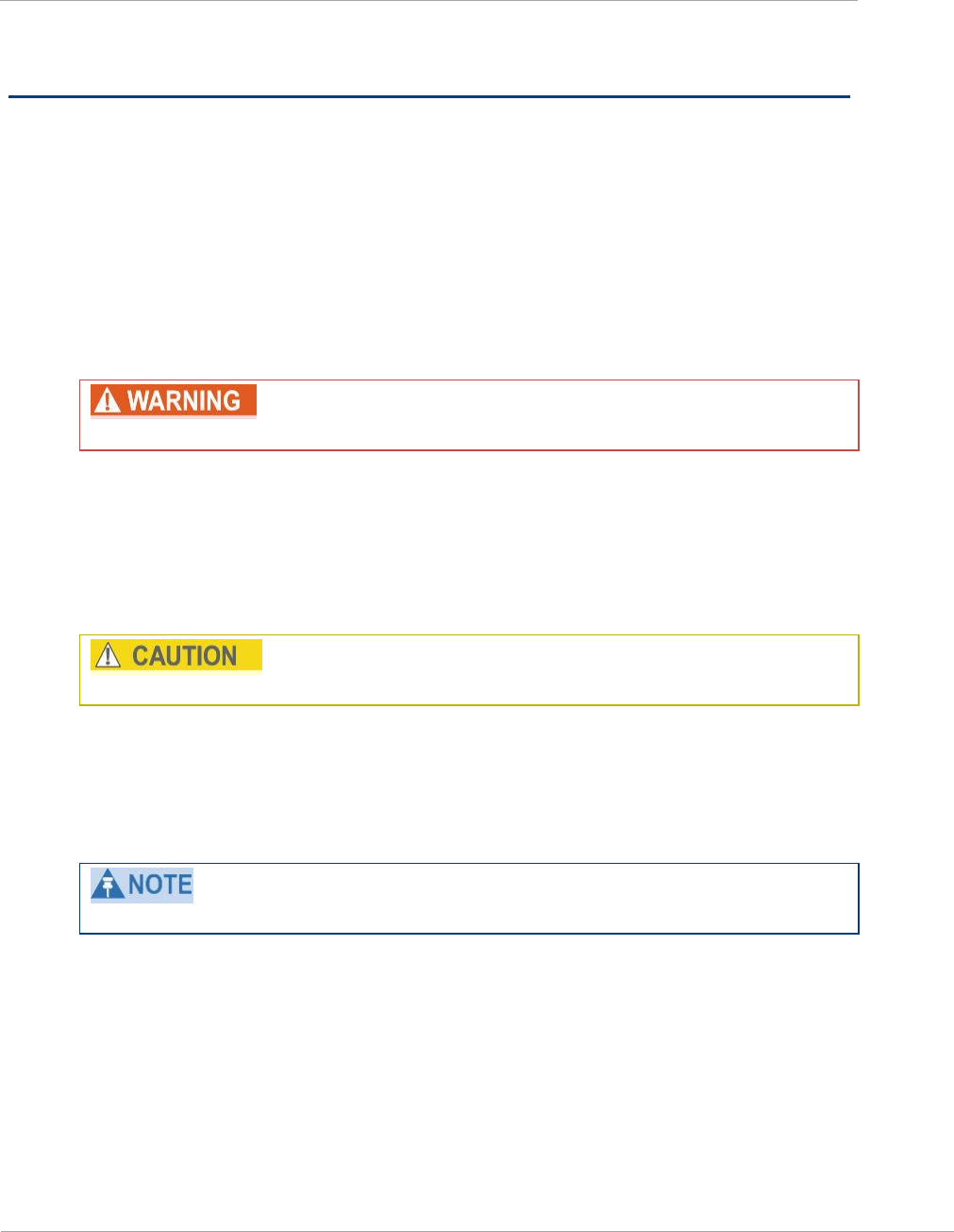
Warnings, cautions, and notes
Chapter 1: Legal information
1-14
pmp-0050 (May 2012)
Warnings, cautions, and notes
The following describes how warnings and cautions are used in this document and in all
documents of the Cambium Networks document set.
Warnings
Warnings precede instructions that contain potentially hazardous situations. Warnings are used
to alert the reader to possible hazards that could cause loss of life or physical injury. A warning
has the following format:
Warning text and consequence for not following the instructions in the warning.
Cautions
Cautions precede instructions and are used when there is a possibility of damage to systems,
software, or individual items of equipment within a system. However, this damage presents no
danger to personnel. A caution has the following format:
Caution text and consequence for not following the instructions in the caution.
Notes
A note means that there is a possibility of an undesirable situation or provides additional
information to help the reader understand a topic or concept. A note has the following format:
Note text.

PMP 450 Configuration and User Guide
Caring for the environment
pmp-0050 (May 2012)
1-15
Caring for the environment
The following information describes national or regional requirements for the disposal of
Cambium Networks supplied equipment and for the approved disposal of surplus packaging.
In EU countries
The following information is provided to enable regulatory compliance with the European Union
(EU) directives identified and any amendments made to these directives when using Cambium
equipment in EU countries.
Disposal of Cambium equipment
European Union (EU) Directive 2002/96/EC Waste Electrical and Electronic Equipment (WEEE)
Do not dispose of Cambium equipment in landfill sites. In the EU, Cambium in conjunction with
a recycling partner ensures that equipment is collected and recycled according to the
requirements of EU environmental law.
Disposal of surplus packaging
Do not dispose of surplus packaging in landfill sites. In the EU, it is the individual recipient‘s
responsibility to ensure that packaging materials are collected and recycled according to the
requirements of EU environmental law.
In non-EU countries
In non-EU countries, dispose of Cambium equipment and all surplus packaging in accordance
with national and regional regulations.

PMP 450 Configuration and User Guide
Caring for the environment
pmp-0050 (May 2012)
1-1
Chapter 1: Legal information
This chapter provides legal notices including software license agreements.
Intentional or unintentional changes or modifications to the equipment must not be made
unless under the express consent of the party responsible for compliance. Any such
modifications could void the user‘s authority to operate the equipment and will void the
manufacturer‘s warranty.
The following topics are described in this chapter:
Cambium Networks end user license agreement on page 1-2
Hardware warranty on page 1-9
Limit of liability on page 1-10

Cambium Networks end user license
agreement
Chapter 1: Legal information
1-2
pmp-0050 (May 2012)
Cambium Networks end user license agreement
Acceptance of this agreement
In connection with Cambium’s delivery of certain proprietary software or products containing
embedded or pre-loaded proprietary software, or both, Cambium is willing to license this certain
proprietary software and the accompanying documentation to you only on the condition that
you accept all the terms in this End User License Agreement (―Agreement‖).
IF YOU DO NOT AGREE TO THE TERMS OF THIS AGREEMENT, DO NOT USE THE
PRODUCT OR INSTALL THE SOFTWARE. INSTEAD, YOU MAY, FOR A FULL
REFUND, RETURN THIS PRODUCT TO THE LOCATION WHERE YOU ACQUIRED IT
OR PROVIDE WRITTEN VERIFICATION OF DELETION OF ALL COPIES OF THE
SOFTWARE. ANY USE OF THE SOFTWARE, INCLUDING BUT NOT LIMITED TO USE
ON THE PRODUCT, WILL CONSTITUTE YOUR ACCEPTANCE TO THE TERMS OF
THIS AGREEMENT.
Definitions
In this Agreement, the word ―Software‖ refers to the set of instructions for computers, in
executable form and in any media, (which may include diskette, CD-ROM, downloadable
internet, hardware, or firmware) licensed to you. The word ―Documentation‖ refers to electronic
or printed manuals and accompanying instructional aids licensed to you. The word ―Product‖
refers to Cambium‘s fixed wireless broadband devices for which the Software and Documentation
is licensed for use.
Grant of license
Cambium Networks Limited (―Cambium‖) grants you (―Licensee‖ or ―you‖) a personal,
nonexclusive, non-transferable license to use the Software and Documentation subject to the
Conditions of Use set forth in ―Conditions of use‖ and the terms and conditions of this
Agreement. Any terms or conditions relating to the Software and Documentation appearing on
the face or reverse side of any purchase order, purchase order acknowledgment or other order
document that are different from, or in addition to, the terms of this Agreement will not be
binding on the parties, even if payment is accepted.

PMP 450 Configuration and User Guide
Cambium Networks end user license
agreement
pmp-0050 (May 2012)
1-3
Conditions of use
Any use of the Software and Documentation outside of the conditions set forth in this Agreement
is strictly prohibited and will be deemed a breach of this Agreement.
1. Only you, your employees or agents may use the Software and Documentation. You will take
all necessary steps to insure that your employees and agents abide by the terms of this
Agreement.
2. You will use the Software and Documentation (i) only for your internal business purposes; (ii)
only as described in the Software and Documentation; and (iii) in strict accordance with this
Agreement.
3. You may use the Software and Documentation, provided that the use is in conformance with
the terms set forth in this Agreement.
4. Portions of the Software and Documentation are protected by United States copyright laws,
international treaty provisions, and other applicable laws. Therefore, you must treat the
Software like any other copyrighted material (for example, a book or musical recording) except
that you may either: (i) make 1 copy of the transportable part of the Software (which typically is
supplied on diskette, CD-ROM, or downloadable internet), solely for back-up purposes; or
(ii) copy the transportable part of the Software to a PC hard disk, provided you keep the original
solely for back-up purposes. If the Documentation is in printed form, it may not be copied. If
the Documentation is in electronic form, you may print out 1 copy, which then may not be
copied. With regard to the copy made for backup or archival purposes, you agree to reproduce
any Cambium copyright notice, and other proprietary legends appearing thereon. Such
copyright notice(s) may appear in any of several forms, including machine-readable form, and
you agree to reproduce such notice in each form in which it appears, to the extent it is physically
possible to do so. Unauthorized duplication of the Software or Documentation constitutes
copyright infringement, and in the United States is punishable in federal court by fine and
imprisonment.
5. You will not transfer, directly or indirectly, any product, technical data or software to any
country for which the United States Government requires an export license or other
governmental approval without first obtaining such license or approval.

Cambium Networks end user license
agreement
Chapter 1: Legal information
1-4
pmp-0050 (May 2012)
Title and restrictions
If you transfer possession of any copy of the Software and Documentation to another party
outside of the terms of this agreement, your license is automatically terminated. Title and
copyrights to the Software and Documentation and any copies made by you remain with
Cambium and its licensors. You will not, and will not permit others to: (i) modify, translate,
decompile, bootleg, reverse engineer, disassemble, or extract the inner workings of the Software
or Documentation, (ii) copy the look-and-feel or functionality of the Software or Documentation;
(iii) remove any proprietary notices, marks, labels, or logos from the Software or Documentation;
(iv) rent or transfer all or some of the Software or Documentation to any other party without
Cambium‘s prior written consent; or (v) utilize any computer software or hardware which is
designed to defeat any copy protection device, should the Software and Documentation be
equipped with such a protection device. If the Software and Documentation is provided on
multiple types of media (such as diskette, CD-ROM, downloadable internet), then you will only
use the medium which best meets your specific needs, and will not loan, rent, lease, or transfer
the other media contained in the package without Cambium‘s written consent. Unauthorized
copying of the Software or Documentation, or failure to comply with any of the provisions of this
Agreement, will result in automatic termination of this license.
Confidentiality
You acknowledge that all Software and Documentation contain valuable proprietary information
and trade secrets and that unauthorized or improper use of the Software and Documentation will
result in irreparable harm to Cambium for which monetary damages would be inadequate and for
which Cambium will be entitled to immediate injunctive relief. If applicable, you will limit
access to the Software and Documentation to those of your employees and agents who need to
use the Software and Documentation for your internal business purposes, and you will take
appropriate action with those employees and agents to preserve the confidentiality of the
Software and Documentation, using the same degree of care to avoid unauthorized or improper
disclosure as you use for the protection of your own proprietary software, but in no event less
than reasonable care.
You have no obligation to preserve the confidentiality of any proprietary information that: (i)
was in the public domain at the time of disclosure; (ii) entered the public domain through no fault
of yours; (iii) was given to you free of any obligation to keep it confidential; (iv) is independently
developed by you; or (v) is disclosed as required by law provided that you notify Cambium prior
to such disclosure and provide Cambium with a reasonable opportunity to respond.

PMP 450 Configuration and User Guide
Cambium Networks end user license
agreement
pmp-0050 (May 2012)
1-5
Right to use Cambium’s name
Except as required in “Conditions of use‖, you will not, during the term of this Agreement or
thereafter, use any trademark of Cambium, or any word or symbol likely to be confused with any
Cambium trademark, either alone or in any combination with another word or words.
Transfer
The Software and Documentation may not be transferred to another party without the express
written consent of Cambium, regardless of whether or not such transfer is accomplished by
physical or electronic means. Cambium‘s consent may be withheld at its discretion and may be
conditioned upon transferee paying all applicable license fees and agreeing to be bound by this
Agreement.
Updates
During the first 12 months after purchase of a Product, or during the term of any executed
Maintenance and Support Agreement for the Product, you are entitled to receive Updates. An
―Update‖ means any code in any form which is a bug fix, patch, error correction, or minor
enhancement, but excludes any major feature added to the Software. Updates are available for
download at the support website.
Major features may be available from time to time for an additional license fee. If Cambium
makes available to you major features and no other end user license agreement is provided, then
the terms of this Agreement will apply.
Maintenance
Except as provided above, Cambium is not responsible for maintenance or field service of the
Software under this Agreement.

Cambium Networks end user license
agreement
Chapter 1: Legal information
1-6
pmp-0050 (May 2012)
Disclaimer
CAMBIUM DISCLAIMS ALL WARRANTIES OF ANY KIND, WHETHER EXPRESS,
IMPLIED, STATUTORY, OR IN ANY COMMUNICATION WITH YOU. CAMBIUM
SPECIFICALLY DISCLAIMS ANY WARRANTY INCLUDING THE IMPLIED
WARRANTIES OF MERCHANTABILTY, NONINFRINGEMENT, OR FITNESS FOR A
PARTICULAR PURPOSE. THE SOFTWARE AND DOCUMENTATION ARE PROVIDED
―AS IS.‖ CAMBIUM DOES NOT WARRANT THAT THE SOFTWARE WILL MEET YOUR
REQUIREMENTS, OR THAT THE OPERATION OF THE SOFTWARE WILL BE
UNINTERRUPTED OR ERROR FREE, OR THAT DEFECTS IN THE SOFTWARE WILL
BE CORRECTED. CAMBIUM MAKES NO WARRANTY WITH RESPECT TO THE
CORRECTNESS, ACCURACY, OR RELIABILITY OF THE SOFTWARE AND
DOCUMENTATION. Some jurisdictions do not allow the exclusion of implied warranties, so the
above exclusion may not apply to you.
Limitation of liability
THE TOTAL LIABILITY OF CAMBIUM UNDER THIS AGREEMENT FOR DAMAGES WILL
NOT EXCEED THE TOTAL AMOUNT PAID BY YOU FOR THE PRODUCT LICENSED
UNDER THIS AGREEMENT. IN NO EVENT WILL CAMBIUM BE LIABLE IN ANY
WAY FOR INCIDENTAL, CONSEQUENTIAL, INDIRECT, SPECIAL OR PUNITIVE
DAMAGES OF ANY NATURE, INCLUDING WITHOUT LIMITATION, LOST BUSINESS
PROFITS, OR LIABILITY OR INJURY TO THIRD PERSONS, WHETHER
FORESEEABLE OR NOT, REGARDLESS OF WHETHER CAMBIUM HAS BEEN
ADVISED OF THE POSSIBLITY OF SUCH DAMAGES. Some jurisdictions do not permit
limitations of liability for incidental or consequential damages, so the above exclusions may not
apply to you.

PMP 450 Configuration and User Guide
Cambium Networks end user license
agreement
pmp-0050 (May 2012)
1-7
U.S. government
If you are acquiring the Product on behalf of any unit or agency of the U.S. Government, the
following applies. Use, duplication, or disclosure of the Software and Documentation is subject
to the restrictions set forth in subparagraphs (c) (1) and (2) of the Commercial Computer
Software – Restricted Rights clause at FAR 52.227-19 (JUNE 1987), if applicable, unless being
provided to the Department of Defense. If being provided to the Department of Defense, use,
duplication, or disclosure of the Products is subject to the restricted rights set forth in
subparagraph (c) (1) (ii) of the Rights in Technical Data and Computer Software clause at
DFARS 252.227-7013 (OCT 1988), if applicable. Software and Documentation may or may not
include a Restricted Rights notice, or other notice referring specifically to the terms and
conditions of this Agreement. The terms and conditions of this Agreement will each continue to
apply, but only to the extent that such terms and conditions are not inconsistent with the rights
provided to you under the aforementioned provisions of the FAR and DFARS, as applicable to
the particular procuring agency and procurement transaction.
Term of license
Your right to use the Software will continue in perpetuity unless terminated as follows. Your right
to use the Software will terminate immediately without notice upon a breach of this Agreement
by you. Within 30 days after termination of this Agreement, you will certify to Cambium in
writing that through your best efforts, and to the best of your knowledge, the original and all
copies, in whole or in part, in any form, of the Software and all related material and
Documentation, have been destroyed, except that, with prior written consent from Cambium,
you may retain one copy for archival or backup purposes. You may not sublicense, assign or
transfer the license or the Product, except as expressly provided in this Agreement. Any attempt
to otherwise sublicense, assign or transfer any of the rights, duties or obligations hereunder is null
and void.
Governing law
This Agreement is governed by the laws of the United States of America to the extent that they
apply and otherwise by the laws of the State of Illinois.
Assignment
This agreement may not be assigned by you without Cambium‘s prior written consent.

Cambium Networks end user license
agreement
Chapter 1: Legal information
1-8
pmp-0050 (May 2012)
Survival of provisions
The parties agree that where the context of any provision indicates an intent that it survives the
term of this Agreement, then it will survive.
Entire agreement
This agreement contains the parties’ entire agreement regarding your use of the Software and may
be amended only in writing signed by both parties, except that Cambium may modify this
Agreement as necessary to comply with applicable laws.

PMP 450 Configuration and User Guide
Hardware warranty
pmp-0050 (May 2012)
1-9
Hardware warranty
Cambium‘s standard hardware warranty is for one (1) year from date of shipment from Cambium
or a Cambium Point-To-Point Distributor. Cambium warrants that hardware will conform to the
relevant published specifications and will be free from material defects in material and
workmanship under normal use and service. Cambium shall within this time, at its own option,
either repair or replace the defective product within thirty (30) days of receipt of the defective
product. Repaired or replaced product will be subject to the original warranty period but not less
than thirty (30) days.

Limit of liability
Chapter 1: Legal information
1-10
pmp-0050 (May 2012)
Limit of liability
IN NO EVENT SHALL CAMBIUM NETWORKS BE LIABLE TO YOU OR ANY OTHER
PARTY FOR ANY DIRECT, INDIRECT, GENERAL, SPECIAL, INCIDENTAL,
CONSEQUENTIAL, EXEMPLARY OR OTHER DAMAGE ARISING OUT OF THE USE
OR INABILITY TO USE THE PRODUCT (INCLUDING, WITHOUT LIMITATION,
DAMAGES FOR LOSS OF BUSINESS PROFITS, BUSINESS INTERRUPTION, LOSS OF
BUSINESS INFORMATION OR ANY OTHER PECUNIARY LOSS, OR FROM ANY
BREACH OF WARRANTY, EVEN IF CAMBIUM HAS BEEN ADVISED OF THE
POSSIBILITY OF SUCH DAMAGES. (Some states do not allow the exclusion or limitation of
incidental or consequential damages, so the above exclusion or limitation may not apply to you.)
IN NO CASE SHALL CAMBIUM‘S LIABILITY EXCEED THE AMOUNT YOU PAID FOR
THE PRODUCT.
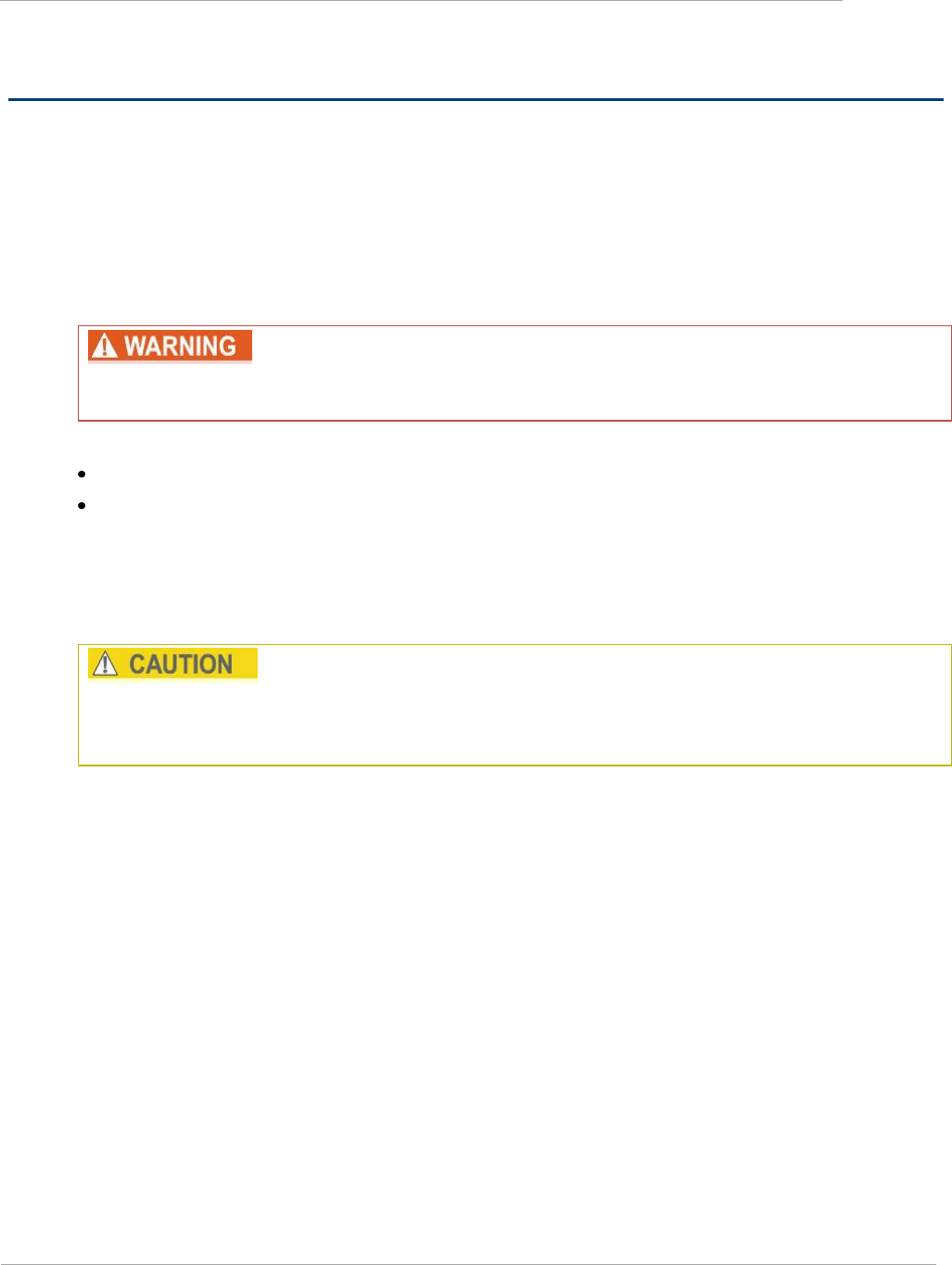
Preparing for configuration and
alignment
Chapter 2: Configuration and alignment
2-2
pmp-0050 (May 2012)
Preparing for configuration and alignment
This section describes the checks to be performed before proceeding with unit configuration and antenna
alignment.
Safety precautions during configuration and alignment
All national and local safety standards must be followed while configuring the units and aligning the antennas.
Ensure that personnel are not exposed to unsafe levels of RF energy. The units start to radiate as soon as they
are powered up.
Observe the following guidelines:
Never work in front of the antenna when the AP or SM is powered.
Always power down the AP or SM before connecting or disconnecting the drop cable from the unit.
Regulatory compliance during configuration and alignment
All applicable radio regulations must be followed while configuring the units and aligning the antennas.
USA only: if the system designer has provided a list of channels to be barred for TDWR radar avoidance, the
affected channels must be barred during staging, before the units are allowed to radiate on site, otherwise FCC
rules will be infringed.
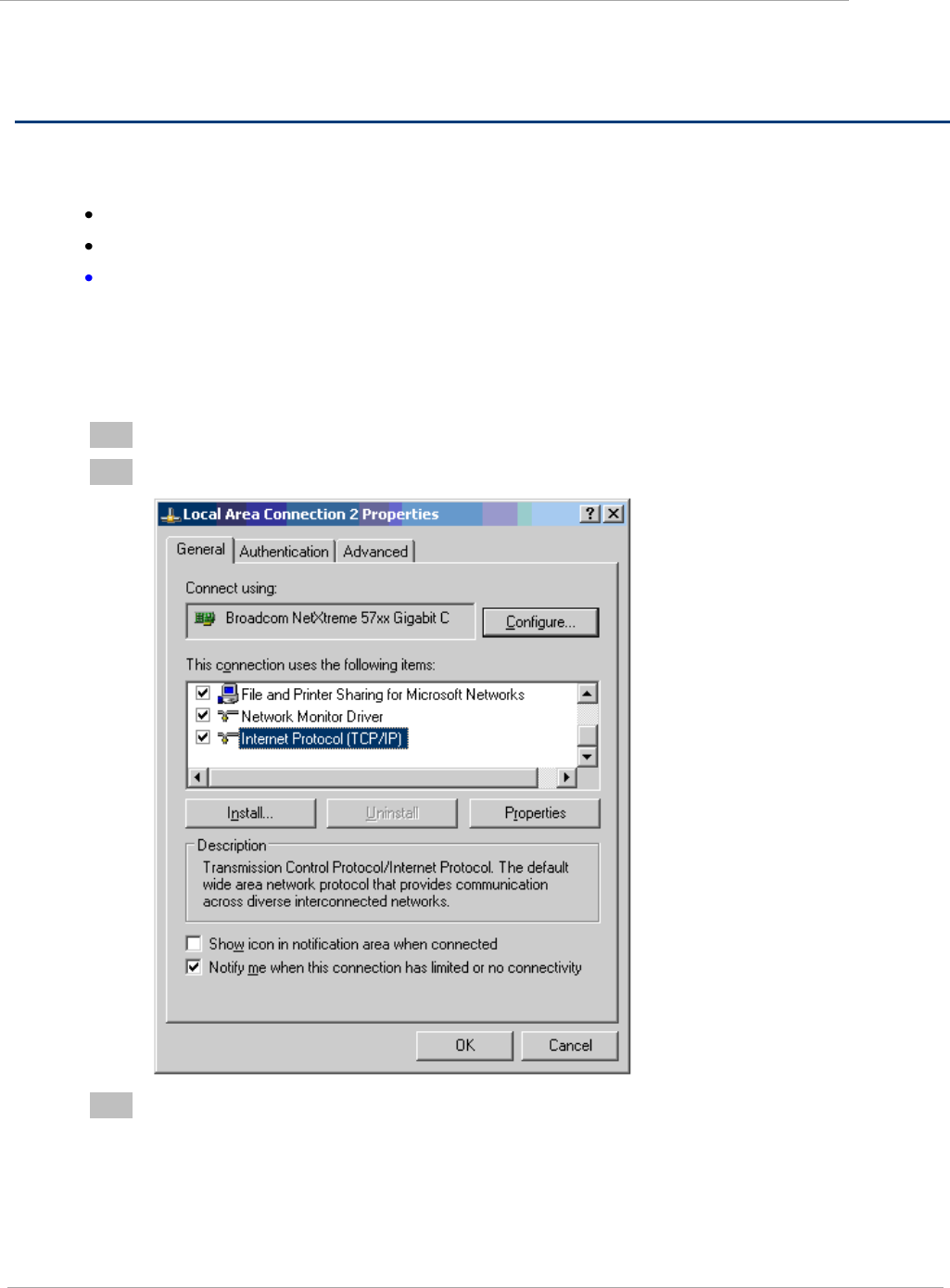
PMP 450 Configuration and User Guide
Task 1: Connecting to the unit
pmp-0050 (May 2012)
2-3
Task 1: Connecting to the unit
This task consists of the following procedures:
Configuring the management PC on page 2-3
Connecting to the PC and powering up on page 2-5
Logging into the web interface on page 2-5
Configuring the management PC
To configure the local management PC to communicate with the PMP 450 AP or SM, proceed as follows:
1
Select Properties for the Ethernet port.
2
Select the Internet Protocol (TCP/IP) item:
3
Click on Properties.
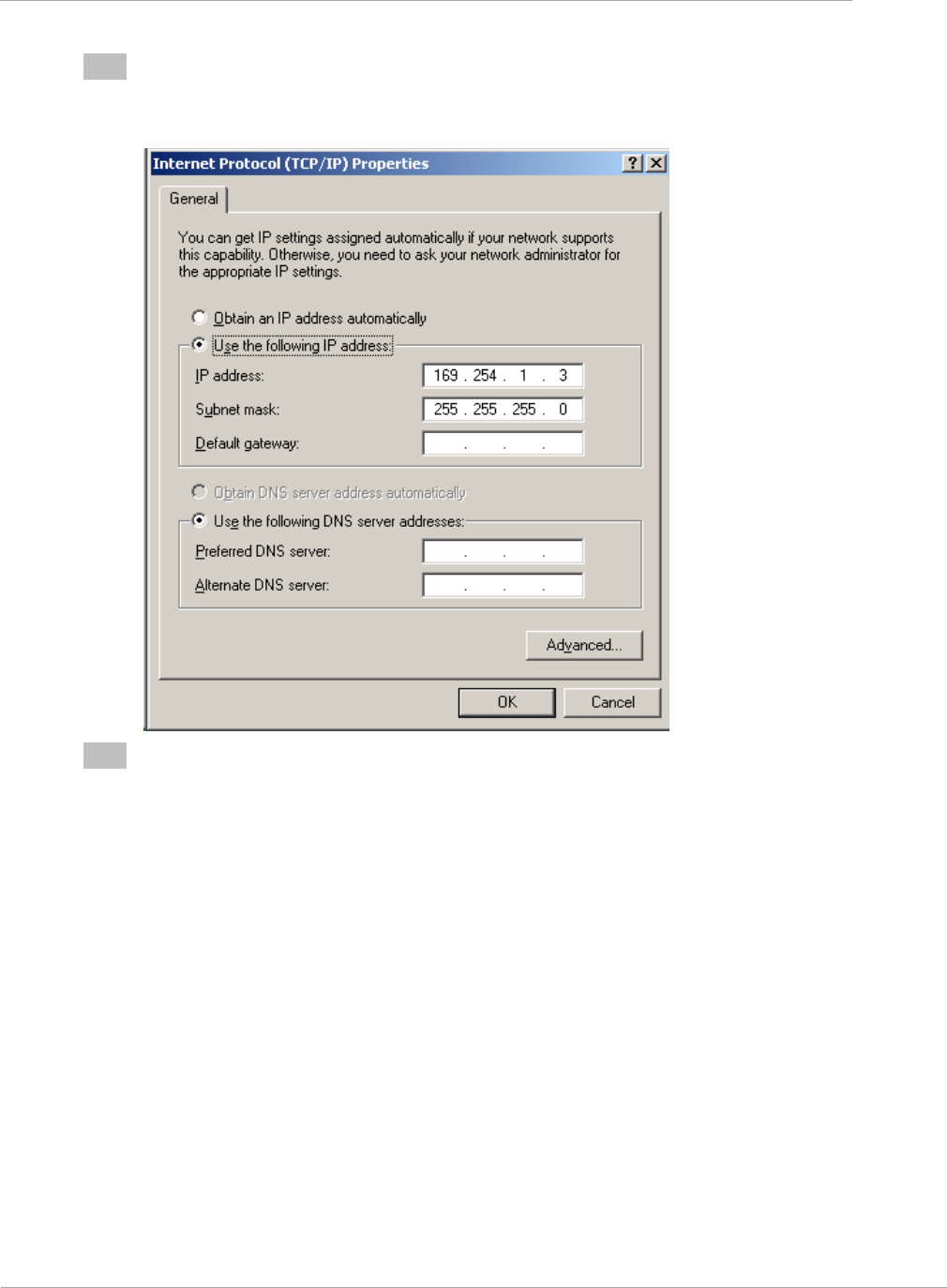
Task 1: Connecting to the unit
Chapter 2: Configuration and alignment
2-4
pmp-0050 (May 2012)
4
Enter an IP address that is valid for the 169.254.X.X network, avoiding:
169.254.0.0 and 169.254.1.1 and 169.254.1.2
A good example is 169.254.1.3:
5
Enter a subnet mask of 255.255.255.0.
Leave the default gateway blank.
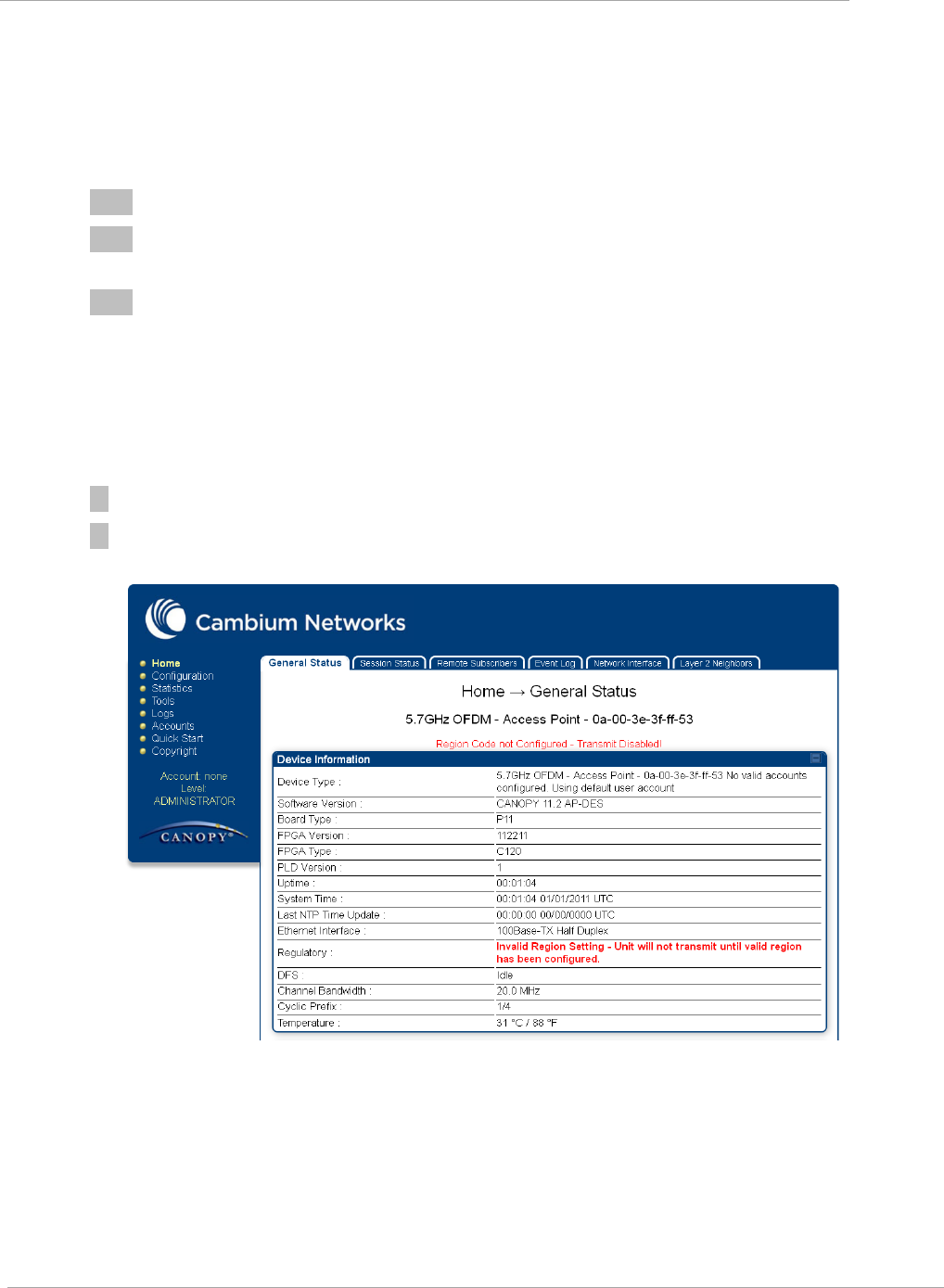
PMP 450 Configuration and User Guide
Task 1: Connecting to the unit
pmp-0050 (May 2012)
2-5
Connecting to the PC and powering up
To connect the PMP 450 AP or SM to the PC and power up the unit, proceed as follows:
1
Check that the AP/SM and the associated power supply are correctly connected.
2
Connect the PC Ethernet port to the LAN port of the power supply using a standard (not crossed)
Ethernet cable.
3
Apply power to the radio power supply. The green Power LED should illuminate continuously.
Logging into the web interface
To log into the web interface as a system administrator, proceed as follows:
1
Start the web browser from the management PC.
2
Type the IP address of the unit into the address bar. The factory default IP address is 169.254.1.1. Press
ENTER. The web interface General Status page is displayed:
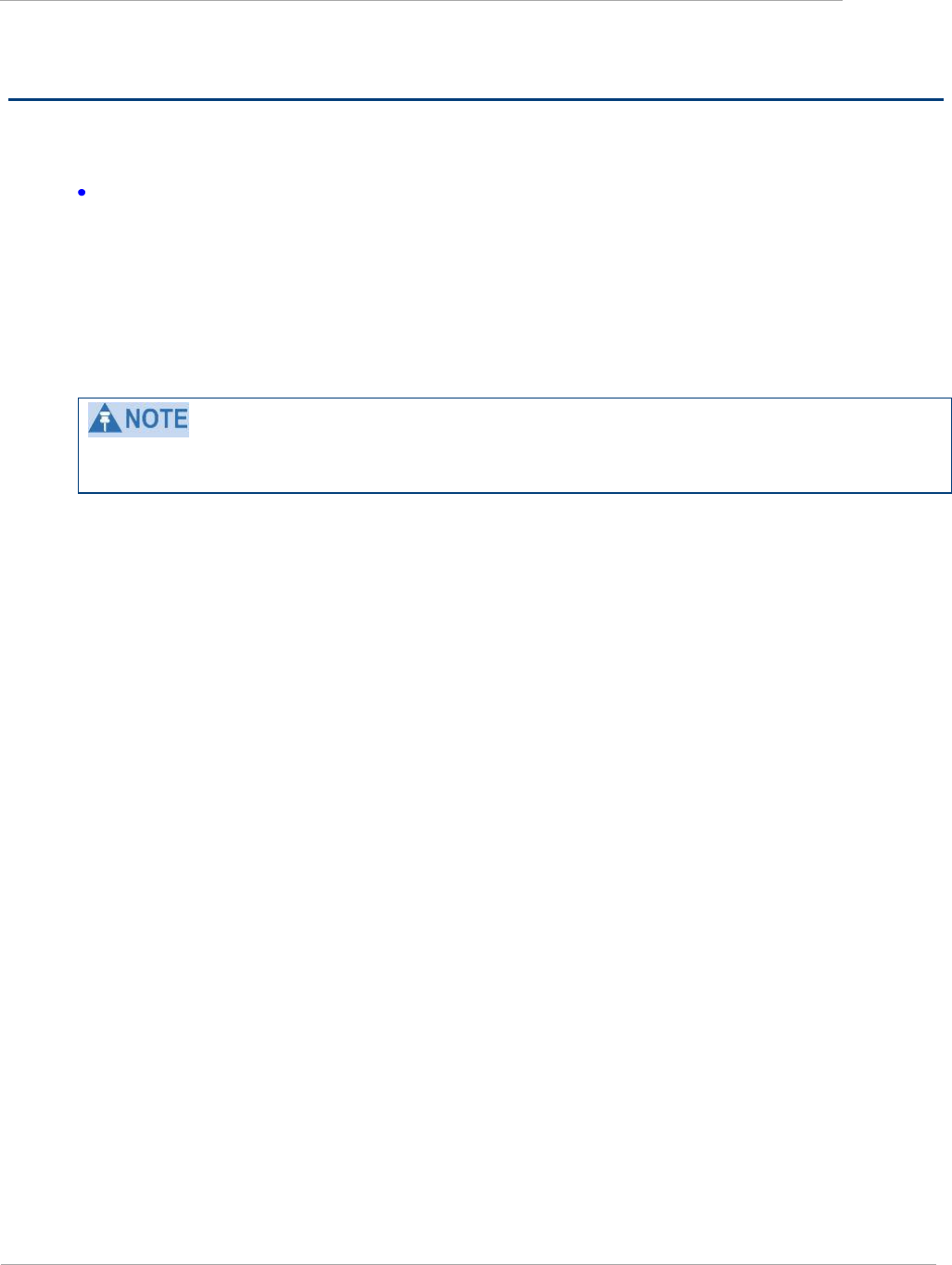
Task 2: Configuring IP and Ethernet
interfaces
Chapter 2: Configuration and alignment
2-6
pmp-0050 (May 2012)
Task 2: Configuring IP and Ethernet interfaces
This task consists of the following procedures:
Configuring the AP IP interface on page 2-6
Configuring the AP IP interface
The IP interface allows users to connect to the PMP 450 web interface, either from a locally connected
computer or from a management network.
To configure the Ethernet link to run at a fixed speed and duplex, leave Ethernet Auto Negotiation set to
‗Enabled‘ and set Auto Neg Advertisement to the required speed.
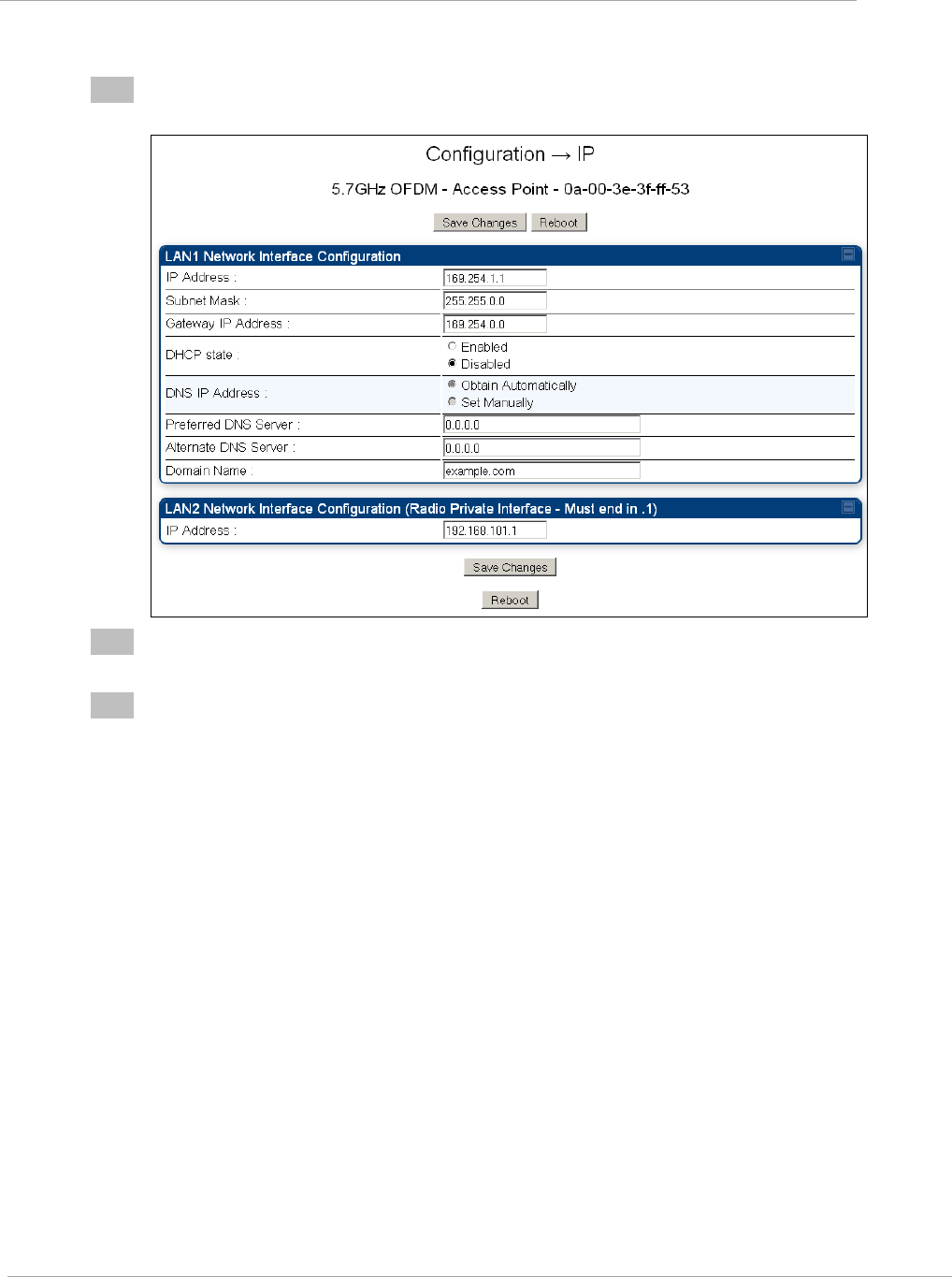
PMP 450 Configuration and User Guide
Task 2: Configuring IP and Ethernet
interfaces
pmp-0050 (May 2012)
2-7
To configure the IP interface, proceed as follows
1
Select menu option System, Configuration, LAN Configuration. The LAN configuration page is
displayed:
2
Update IP Address, Subnet Mask and Gateway IP Address to meet network requirements (as
specified by the network administrator).
3
Review the other IP interface attributes and update them, if required (Table 1).
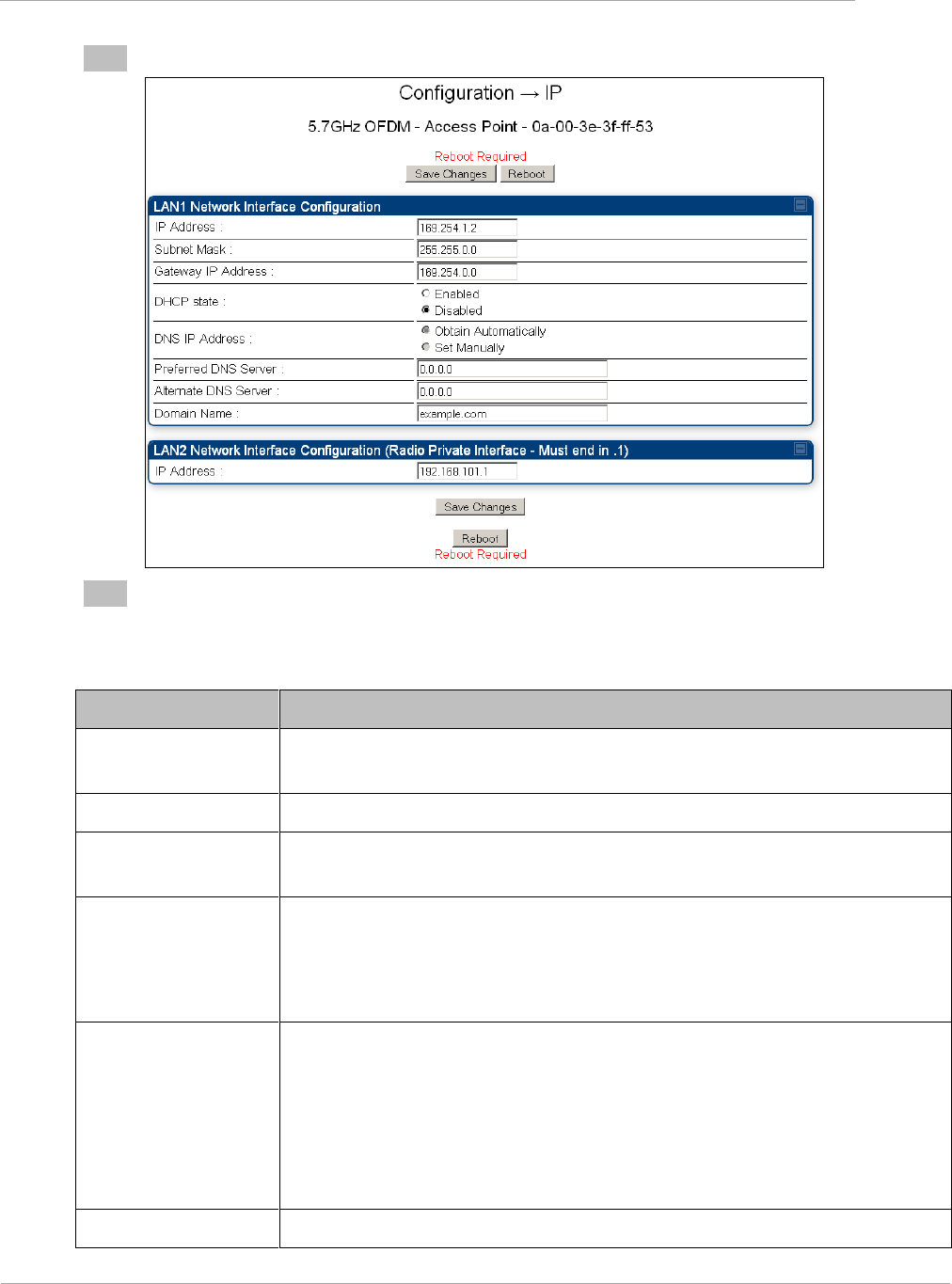
Task 2: Configuring IP and Ethernet
interfaces
Chapter 2: Configuration and alignment
2-8
pmp-0050 (May 2012)
4
Select Save. The ―Reboot Required‖ message is displayed:
5
Select Reboot.
Table 1 IP interface attributes
Attribute
Meaning
IP Address
Internet protocol (IP) address. This address is used by the family of Internet
protocols to uniquely identify this unit on a network.
Subnet Mask
Defines the address range of the connected IP network.
Gateway IP Address
The IP address of a computer on the current network that acts as a gateway. A
gateway acts as an entrance and exit to packets from and to other networks.
DHCP state
If Enabled is selected, the DHCP server automatically assigns the IP configuration
(IP address, subnet mask, and gateway IP address) and the values of those
individual parameters (above) are not used. The setting of this DHCP state
parameter is also viewable, but not settable, in the Network Interface tab of the
Home page.
DNS IP Address
Canopy devices allow for configuration of a preferred and alternate DNS server IP
address either automatically or manually. Devices must set DNS server IP
address manually when DHCP is disabled for the management interface of the
device. DNS servers may be configured automatically from the DHCP response
when DHCP is enabled for the management interface of the device. Optionally
devices may be configured to set the DNS server IP address manually when DHCP
is enabled for the management interface. The default DNS IP addresses are 0.0.0.0
when configured manually.
Preferred DNS Server
The first address used for DNS resolution.

PMP 450 Configuration and User Guide
Task 2: Configuring IP and Ethernet
interfaces
pmp-0050 (May 2012)
2-9
Attribute
Meaning
Alternate DNS Server
Upon failure to reach the Preferred DNS server, the Alternate DNS Server is used.
Domain Name
The operator‘s management domain name may be configured for DNS. The
domain name configuration can be used for configuration of the servers in the
operator‘s network. The default domain name is example.com, and is only used if
configured as such.
LAN2 Network
Interface
Configuration (Radio
Private Interface) – IP
Address
It is recommended to not change this parameter from the default AP private IP
address of 192.168.101.1. A /24 CIDR subnet is used to communicate with each of
the SMs that are registered. The AP uses a combination of the private IP and the
LUID (logical unit ID) of the SM.
For example, if an SM is the first to register in an AP, and another SM registers
later, then the AP whose Private IP address is 192.168.101.1 uses the following
SM Private IP addresses to communicate to each:
SM
LUID
Private IP
First SM registered
2
192.168.101.2
Second SM registered
3
192.168.101.3
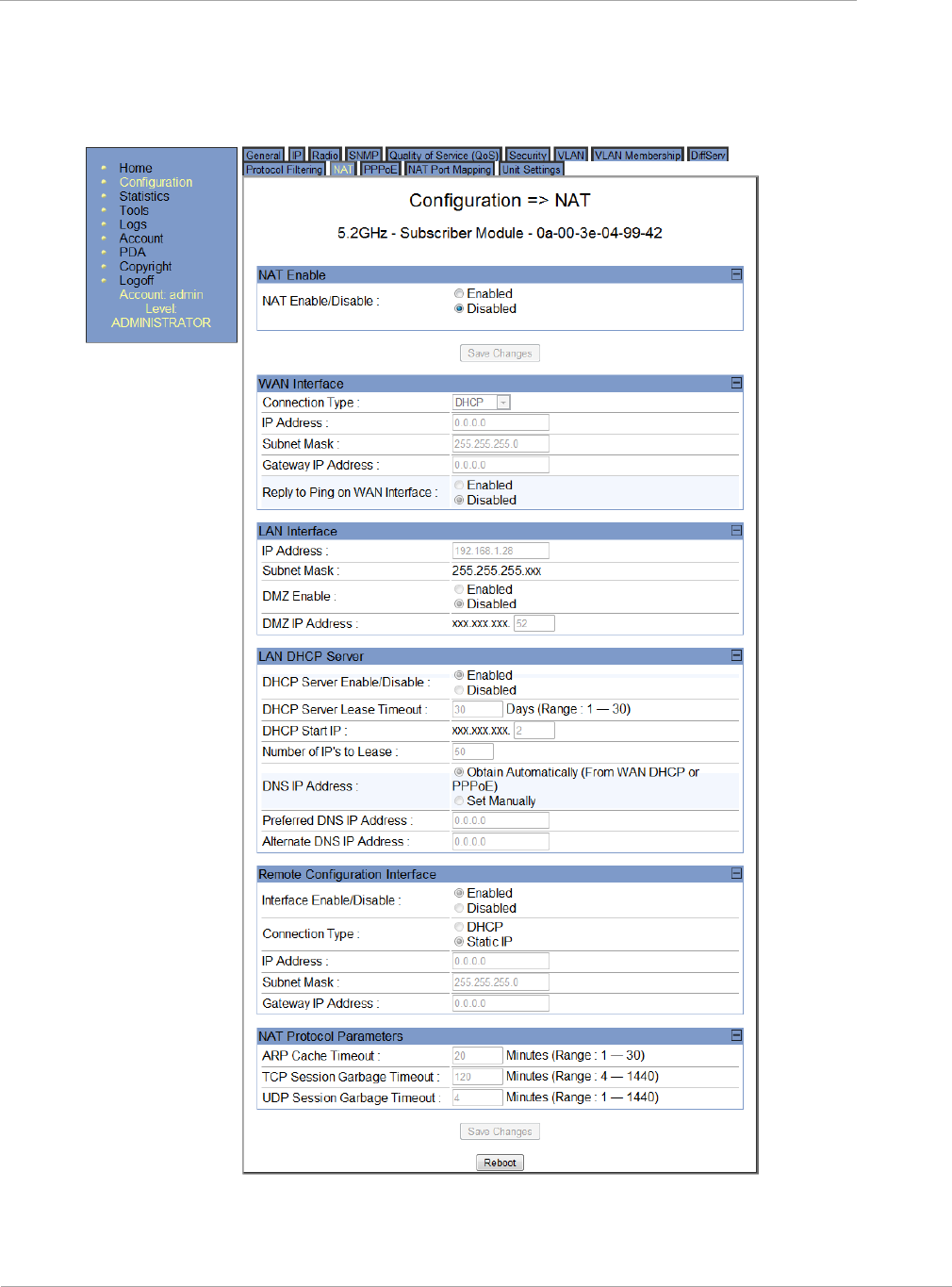
Task 2: Configuring IP and Ethernet
interfaces
Chapter 2: Configuration and alignment
2-10
pmp-0050 (May 2012)
NAT tab of the SM with NAT disabled
Figure 1 NAT tab of the SM with NAT disabled

PMP 450 Configuration and User Guide
Task 2: Configuring IP and Ethernet
interfaces
pmp-0050 (May 2012)
2-11
SM NAT DNS Considerations
SM DNS behavior is different depending on the accessibility of the SM. When NAT is disabled the DNS
configuration that is discussed in this document is tied to LAN1 interface, and only functions if the device is
publicly accessible. When NAT is enabled the DNS configuration that is discussed in this document is tied to
the RF Remote Configuration Interface, which must be enabled to utilize DNS Client functionality. Note that
the WAN DNS settings when NAT is enabled are unchanged with the addition of the management DNS
feature discussed in this document.
Table 2 SM DNS Options with NAT Disabled
NAT
Configuration
Management
Interface
Accessibility
DHCP Status
DNS Status
NAT Disabled
Local
DHCP Disabled
DNS Disabled
DHCP Enabled
DNS Disabled
Public
DHCP Disabled
DNS Static
Configuration
DHCP Enabled
DNS from DHCP or
DNS Static
Configuration
In the NAT tab of an SM with NAT disabled, you may set the following parameters.
Table 3 SM with NAT disabled - NAT attributes
Attribute
Meaning
NAT Enable/Disable
This parameter enables or disabled the Network Address Translation
(NAT) feature for the SM. NAT isolates devices connected to the
Ethernet/wired side of an SM from being seen directly from the wireless side
of the SM. With NAT enabled, the SM has an IP address for transport
traffic separate from its address for management, terminates transport
traffic, and allows you to assign a range of IP addresses to devices that are
connected to the Ethernet/wired side of the SM
When NAT is enabled, VLANs are not supported on the wired side of that
SM. You can enable NAT in SMs within a sector where VLAN is enabled in
the AP, but this may constrain network design
WAN Interface, Connection
Type
This parameter is not configurable when NAT is disabled.
WAN Interface, IP Address
This field displays the IP address for the SM. DHCP Server will not
automatically assign this address when NAT is disabled.

Task 2: Configuring IP and Ethernet
interfaces
Chapter 2: Configuration and alignment
2-12
pmp-0050 (May 2012)
Attribute
Meaning
WAN Interface, Subnet Mask
This field displays the subnet mask for the SM. DHCP Server will not
automatically assign this address when NAT is disabled.
WAN Interface, Gateway IP
Address
This field displays the gateway IP address for the SM. DHCP Server will
not automatically assign this address when NAT is disabled.
WAN Interface, Reply to Ping
on WAN Interface
This parameter is not configurable when NAT is disabled.
LAN Interface, IP Address
This parameter is not configurable when NAT is disabled.
LAN Interface, Subnet Mask
This parameter is not configurable when NAT is disabled.
LAN Interface, DMZ Enable
This parameter is not configurable when NAT is disabled.
LAN Interface, DMZ IP
Address
This parameter is not configurable when NAT is disabled.
LAN DHCP Server, DHCP
Server Enable/Disable
This parameter is not configurable when NAT is disabled.
LAN DHCP Server, DHCP
Server Lease Timeout
This parameter is not configurable when NAT is disabled.
LAN DHCP Server, DHCP
Start IP
This parameter is not configurable when NAT is disabled.
LAN DHCP Server, Number of
IPs to Lease
This parameter is not configurable when NAT is disabled.
LAN DHCP Server, DNS
Server Proxy
This parameter is not configurable when NAT is disabled.
LAN DHCP Server, DNS IP
Address
This parameter is not configurable when NAT is disabled.
LAN DHCP Server, Preferred
DNS IP Address
This parameter is not configurable when NAT is disabled.
LAN DHCP Server, Alternate
DNS IP Address
This parameter is not configurable when NAT is disabled.
Remote Configuration
Interface, Interface
Enable/Disable
This parameter is not configurable when NAT is disabled.
Remote Configuration
Interface, Connection Type
This parameter is not configurable when NAT is disabled.
Remote Configuration
Interface, IP Address
This parameter is not configurable when NAT is disabled.

PMP 450 Configuration and User Guide
Task 2: Configuring IP and Ethernet
interfaces
pmp-0050 (May 2012)
2-13
Attribute
Meaning
Remote Configuration
Interface, Subnet Mask
This parameter is not configurable when NAT is disabled.
Remote Configuration
Interface, Gateway IP Address
This parameter is not configurable when NAT is disabled.
Remote Configuration
Interface, DNS IP Address
This parameter is not configurable when NAT is disabled.
Remote Configuration
Interface, Preferred DNS
Server
This parameter is not configurable when NAT is disabled.
Remote Connection Interface,
Alternate DNS Server
This parameter is not configurable when NAT is disabled.
Remote Connection Interface,
Domain Name
This parameter is not configurable when NAT is disabled.
NAT Protocol Parameters,
ARP Cache Timeout
If a router upstream has an ARP cache of longer duration (as some use 30
minutes), enter a value of longer duration than the router ARP cache. The
default value of this field is 20 minutes.
NAT Protocol Parameters, TCP
Session Garbage Timeout
Where a large network exists behind the SM, you can set this parameter to
lower than the default value of 1440 minutes (24 hours). This action makes
additional resources available for greater traffic than the default value
accommodates.
NAT Protocol Parameters,
UDP Session Garbage Timeout
You may adjust this parameter in the range of 1 to 1440 minutes, based on
network performance. The default value of this parameter is 4 minutes.
.
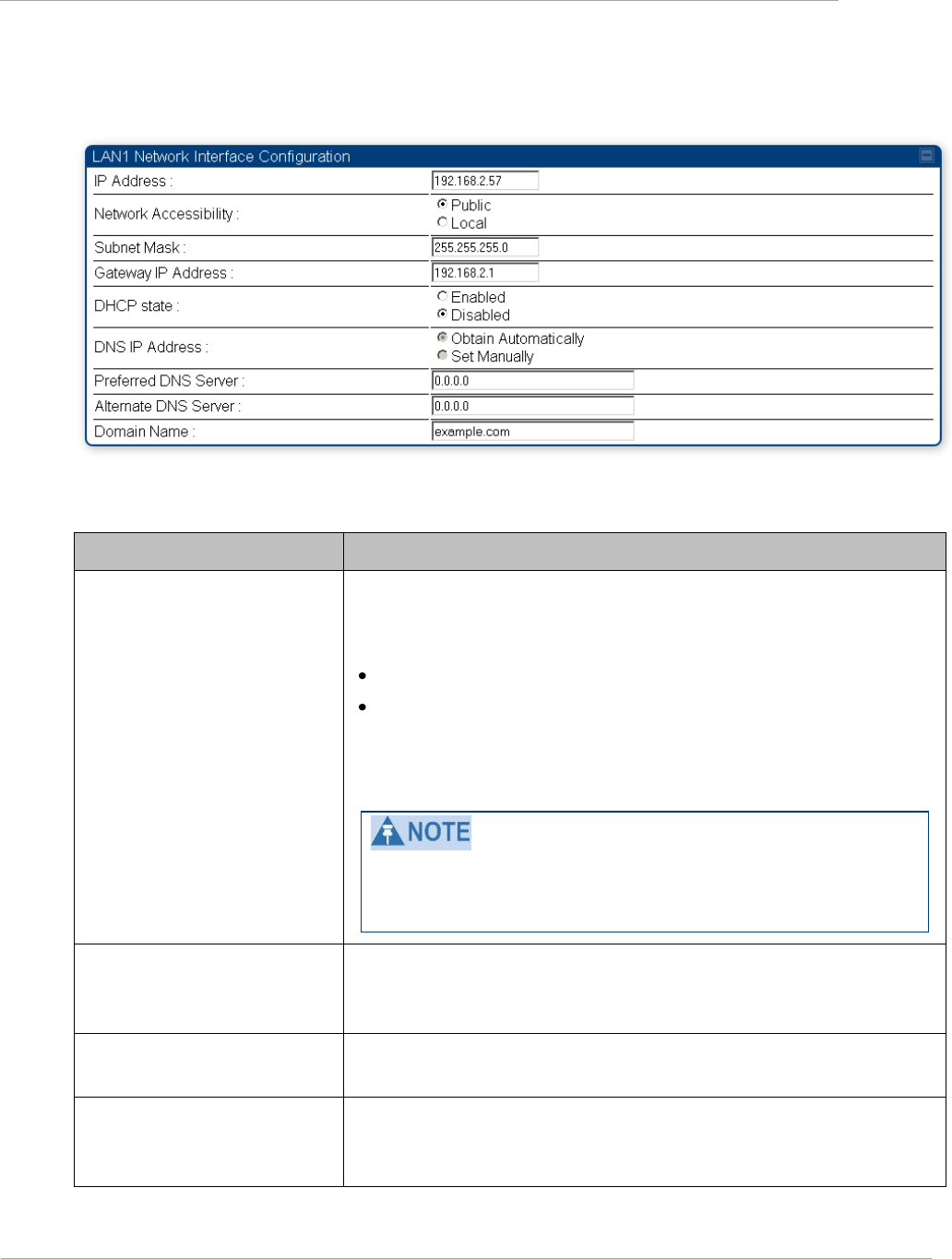
Task 2: Configuring IP and Ethernet
interfaces
Chapter 2: Configuration and alignment
2-14
pmp-0050 (May 2012)
IP tab of the SM with NAT disabled
Figure 2 IP tab of the SM with NAT disabled
In the IP tab of an SM with NAT disabled, you may set the following parameters.
Table 4 SM with NAT disabled - IP attributes
Attribute
Meaning
LAN1 Network Interface
Configuration, IP Address
Enter the non-routable IP address to associate with the Ethernet connection
on this SM. (The default IP address from the factory is 169.254.1.1.) If you
set and then forget this parameter, then you must both
physically access the module.
use an override plug to electronically access the module configuration
parameters at 169.254.1.1. See Overriding Forgotten IP Addresses or
Passwords on AP on Page 2-60.
Note or print the IP settings from this page. Ensure that you can
readily associate these IP settings both with the module and with the
other data that you store about the module.
LAN1 Network Interface
Configuration, Network
Accessibility
Specify whether the IP address of the SM should be visible to only a device
connected to the SM by Ethernet (Local) or should be visible to the AP as
well (Public).
LAN1 Network Interface
Configuration, Subnet Mask
Enter an appropriate subnet mask for the SM to communicate on the
network. The default subnet mask is 255.255.0.0.
LAN1 Network Interface
Configuration, Gateway IP
Address
Enter the appropriate gateway for the SM to communicate with the
network. The default gateway is 169.254.0.0.

PMP 450 Configuration and User Guide
Task 2: Configuring IP and Ethernet
interfaces
pmp-0050 (May 2012)
2-15
Attribute
Meaning
LAN1 Network Interface
Configuration, DHCP state
If you select Enabled, the DHCP server automatically assigns the IP
configuration (IP address, subnet mask, and gateway IP address) and the
values of those individual parameters (above) are not used. The setting of
this DHCP state parameter is also viewable, but not settable, in the
Network Interface tab of the Home page.
In this tab, DHCP State is settable only if the Network Accessibility
parameter in the IP tab is set to Public. This parameter is also settable in
the NAT tab of the Configuration web page, but only when NAT is
enabled.
If the DHCP state parameter is set to Enabled in the Configuration => IP
tab of the SM, do not check the BootpClient option for Packet Filter Types in
its Protocol Filtering tab, because doing so would block the DHCP request.
(Filters apply to all packets that leave the SM via its RF interface,
including those that the SM itself generates.) If you want to keep DHCP
enabled and avoid the blocking scenario, select the Bootp Server option
instead. This will result in responses being appropriately filtered and
discarded.
LAN1 Network Interface
Configuration, DNS IP Address
Canopy devices allow for configuration of a preferred and alternate DNS
server IP address either automatically or manually. Devices must set DNS
server IP address manually when DHCP is disabled for the management
interface of the device. DNS servers may be configured automatically from
the DHCP response when DHCP is enabled for the management interface
of the device. Optionally devices may be configured to set the DNS server
IP address manually when DHCP is enabled for the management interface.
The default DNS IP addresses are 0.0.0.0 when configured manually.
LAN1 Network Interface
Configuration, Preferred DNS
Server
The first DNS server used for DNS resolution.
LAN1 Network Interface
Configuration, Alternate DNS
Server
The second DNS server used for DNS resolution.
LAN1 Network Interface
Configuration, Domain Name
The operator‘s management domain name may be configured for DNS. The
domain name configuration can be used for configuration of the servers in
the operator‘s network. The default domain name is example.com, and is
only used if configured as such.
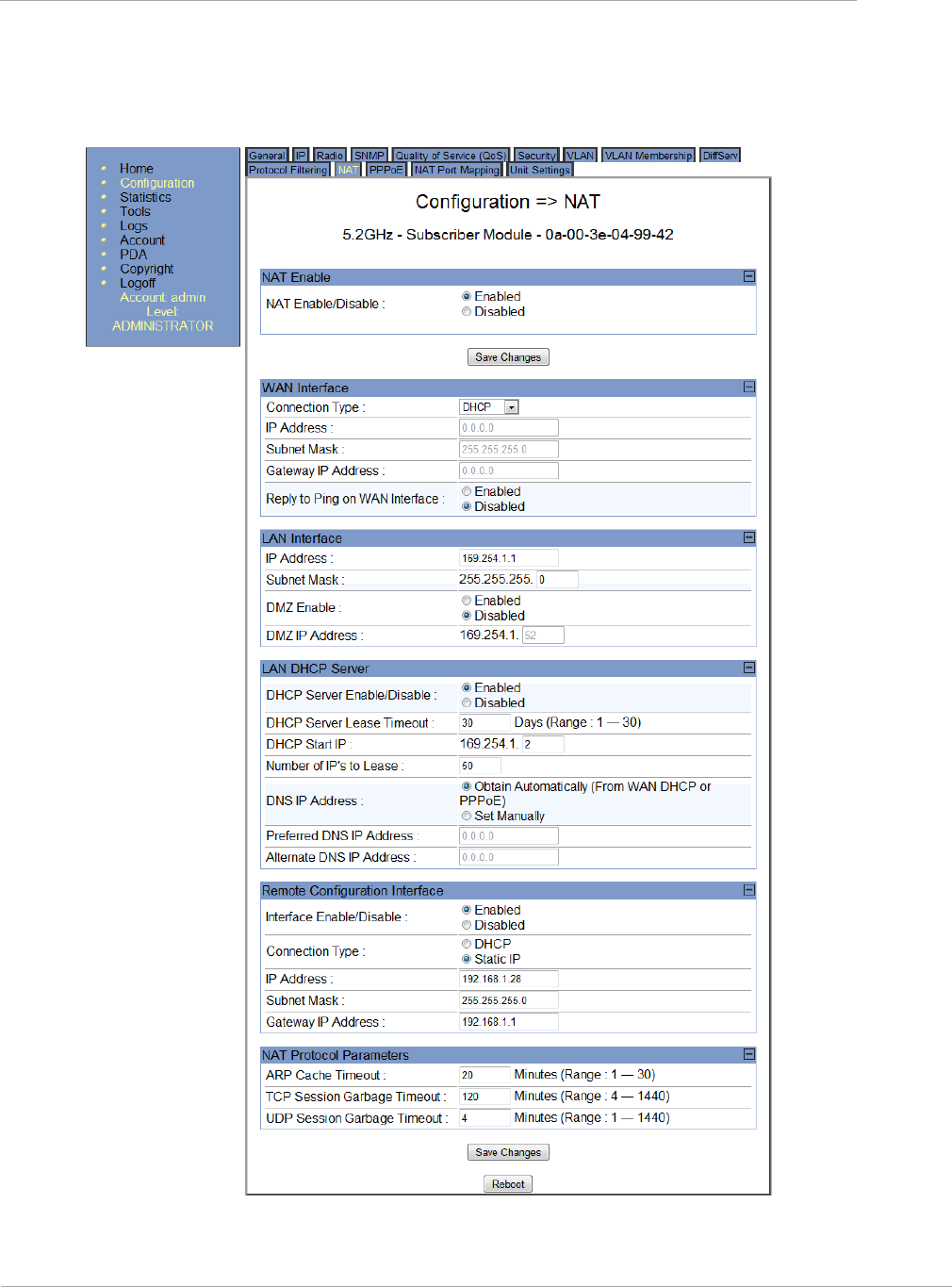
Task 2: Configuring IP and Ethernet
interfaces
Chapter 2: Configuration and alignment
2-16
pmp-0050 (May 2012)
NAT tab of the SM with NAT enabled
Figure 3 NAT tab of the SM with NAT enabled

PMP 450 Configuration and User Guide
Task 2: Configuring IP and Ethernet
interfaces
pmp-0050 (May 2012)
2-17
SM NAT DNS Considerations
SM DNS behavior is different depending on the accessibility of the SM. When NAT is enabled the DNS
configuration that is discussed in this document is tied to the RF Remote Configuration Interface, which must
be enabled to utilize DNS Client functionality. Note that the WAN DNS settings when NAT is enabled are
unchanged with the addition of the management DNS feature discussed in this document.
Table 5 SM DNS Options with NAT Enabled
NAT
Configuration
Management
Interface
Accessibility
DHCP Status
DNS Status
NAT Enabled
RF Remote
Configuration Interface
Disabled
N/A
DNS Disabled
RF Remote
Configuration Interface
Enabled
DHCP Disabled
DNS Static
Configuration
DHCP Enabled
DNS from DHCP or
DNS Static
Configuration
In the NAT tab of an SM with NAT enabled, you may set the following parameters.
Table 6 SM with NAT enabled - NAT attributes
Attribute
Meaning
NAT Enable/Disable
This parameter enables or disabled the Network Address Translation
(NAT) feature for the SM. NAT isolates devices connected to the
Ethernet/wired side of an SM from being seen directly from the wireless side
of the SM. With NAT enabled, the SM has an IP address for transport
traffic separate from its address for management, terminates transport
traffic, and allows you to assign a range of IP addresses to devices that are
connected to the Ethernet/wired side of the SM.
When NAT is enabled, VLANs are not supported on the wired side of that
SM. You can enable NAT in SMs within a sector where VLAN is enabled in
the AP, but this may constrain network design.
WAN Interface
The WAN interface is the RF-side address for transport traffic.

Task 2: Configuring IP and Ethernet
interfaces
Chapter 2: Configuration and alignment
2-18
pmp-0050 (May 2012)
Attribute
Meaning
WAN Interface, Connection
Type
This parameter may be set to
Static IP—when this is the selection, the following three parameters
(IP Address, Subnet Mask, and Gateway IP Address) must all be properly
populated.
DHCP—when this is the selection, the information from the DHCP server
configures the interface.
PPPoE—when this is the selection, the information from the PPPoE server
configures the interface.
WAN Interface, Subnet Mask
If Static IP is set as the Connection Type of the WAN interface, then this
parameter configures the subnet mask of the SM for RF transport traffic.
WAN Interface, Gateway IP
Address
If Static IP is set as the Connection Type of the WAN interface, then this
parameter configures the gateway IP address for the SM for RF transport
traffic.
WAN Interface, Reply to Ping
on WAN Interface
By default, the radio interface does not respond to pings. If you use a
management system (such as Prizm or WM) that will occasionally ping the
SM, set this parameter to Enabled.
LAN Interface
The LAN interface is both the management access through the Ethernet
port and the Ethernet-side address for transport traffic. When NAT is
enabled, this interface is redundantly shown as the NAT Network Interface
Configuration on the IP tab of the Configuration web page in the SM.
LAN Interface, IP Address
Assign an IP address for SM management through Ethernet access to the
SM. This address becomes the base for the range of DHCP-assigned
addresses.
LAN Interface, Subnet Mask
Assign a subnet mask of 255.255.255.0 or a more restrictive subnet mask.
Set only the last byte of this subnet mask. Each of the first three bytes is
permanently set to 255.
LAN Interface, DMZ Enable
Either enable or disable DMZ for this SM.
LAN Interface, DMZ IP
Address
If you enable DMZ in the parameter above, set the last byte of the DMZ
host IP address to use for this SM when DMZ is enabled. Only one such
address is allowed. The first three bytes are identical to those of the NAT
private IP address. Ensure that the device that should receive network
traffic behind this SM is assigned this address. The system provides a
warning if you enter an address within the range that DHCP can assign.
LAN DHCP Server
This is the server (in the SM) that provides an IP address to the device
connected to the Ethernet port of the SM.
WAN Interface, Subnet Mask
If Static IP is set as the Connection Type of the WAN interface, then this
parameter configures the subnet mask of the SM for RF transport traffic.

PMP 450 Configuration and User Guide
Task 2: Configuring IP and Ethernet
interfaces
pmp-0050 (May 2012)
2-19
Attribute
Meaning
LAN DHCP Server, DHCP
Server Enable/Disable
Select either
Enabled to
allow this SM to assign IP addresses, subnet masks, and gateway IP
addresses to attached devices.
assign a start address for DHCP.
designate how many IP addresses may be temporarily used (leased).
Disabled to disallow the SM to assign addresses to attached devices.
LAN DHCP Server, DHCP
Server Lease Timeout
Based on network performance, enter the number of days between when
the DHCP server assigns an IP address and when that address expires. The
range of values for this parameter is 1 to 30 days. The default value is 30
days.
LAN DHCP Server, DHCP
Start IP
If you will be enabling DHCP Server below, set the last byte of the starting
IP address that the DHCP server will assign. The first three bytes are
identical to those of the NAT private IP address.
LAN DHCP Server, Number of
IPs to Lease
Enter how many IP addresses the DHCP server is allowed to assign. The
default value is 50 addresses.
LAN DHCP Server, DNS
Server Proxy
This parameter enables or disables advertisement of the SM as the DNS
server. On initial boot up of an SM with the NAT WAN interface
configured as DHCP or PPPoE, the SM module will not immediately have
DNS information. With DNS Server Proxy disabled, the clients will renew
their lease about every minute until the SM has the DNS information to
give out. At this point the SM will go to the full configured lease time
period which is 30 days by default. With DNS Server Proxy enabled, the
SM will give out full term leases with its NAT LAN IP as the DNS server.
LAN DHCP Server, DNS IP
Address
Select either
Obtain Automatically to allow the system to set the IP address of the DNS
server.
Set Manually to enable yourself to set both a preferred and an alternate
DNS IP address.
LAN DHCP Server, Preferred
DNS IP Address
Enter the preferred DNS IP address to use when the DNS IP Address
parameter is set to Set Manually.
LAN DHCP Server, Alternate
DNS IP Address
Enter the DNS IP address to use when the DNS IP Address parameter is set
to Set Manually and no response is received from the preferred DNS IP
address.
Remote Configuration
Interface, Interface
Enable/Disable
If you want over-the-air management capability for the SM, select
Enabled. If you want to limit management of the SM to its Ethernet
interface, select Disabled.

Task 2: Configuring IP and Ethernet
interfaces
Chapter 2: Configuration and alignment
2-20
pmp-0050 (May 2012)
Attribute
Meaning
Remote Configuration Interface
The Remote Configuration interface is the RF-side address for
management by an EMS or NMS (Prizm or WM, for example).
Remote Configuration
Interface, Interface
Enable/Disable
When this interface is Disabled, the SM is not directly accessible by IP
address, and management access is only through either
the LAN (Ethernet) interface
a link from an AP web page into the WAN (RF-side) interface.
When this interface is Enabled, you can configure management access
through either
a Static IP address
an IP address that DHCP provides for the WAN interface.
Remote Configuration
Interface, Connection Type
This parameter may be set to
Static IP—when this is the selection, the following three parameters
(IP Address, Subnet Mask, and Gateway IP Address) must all be properly
populated.
DHCP—when this is the selection, the information from the DHCP server
configures the interface.
Remote Configuration
Interface, IP Address
If Static IP is set as the Connection Type of the WAN interface, then this
parameter configures the IP address of the SM for RF management traffic.
Remote Configuration
Interface, Subnet Mask
If Static IP is set as the Connection Type of the WAN interface, then this
parameter configures the subnet mask of the SM for RF management
traffic.
Remote Configuration
Interface, Gateway IP Address
If Static IP is set as the Connection Type of the WAN interface, then this
parameter configures the gateway IP address for the SM for RF
management traffic.
Note or print the IP settings from this page. Ensure that you can readily
associate these IP settings both with the module and with the other data
that you store about the module.
NAT Protocol Parameters,
ARP Cache Timeout
If a router upstream has an ARP cache of longer duration (as some use 30
minutes), enter a value of longer duration than the router ARP cache. The
default value of this field is 20 minutes.
NAT Protocol Parameters, TCP
Session Garbage Timeout
Where a large network exists behind the SM, you can set this parameter to
lower than the default value of 1440 minutes (24 hours). This action makes
additional resources available for greater traffic than the default value
accommodates. The default value of this parameter is 120 minutes.
NAT Protocol Parameters,
UDP Session Garbage Timeout
You may adjust this parameter in the range of 1 to 1440 minutes, based on
network performance. The default value of this parameter is 4 minutes.
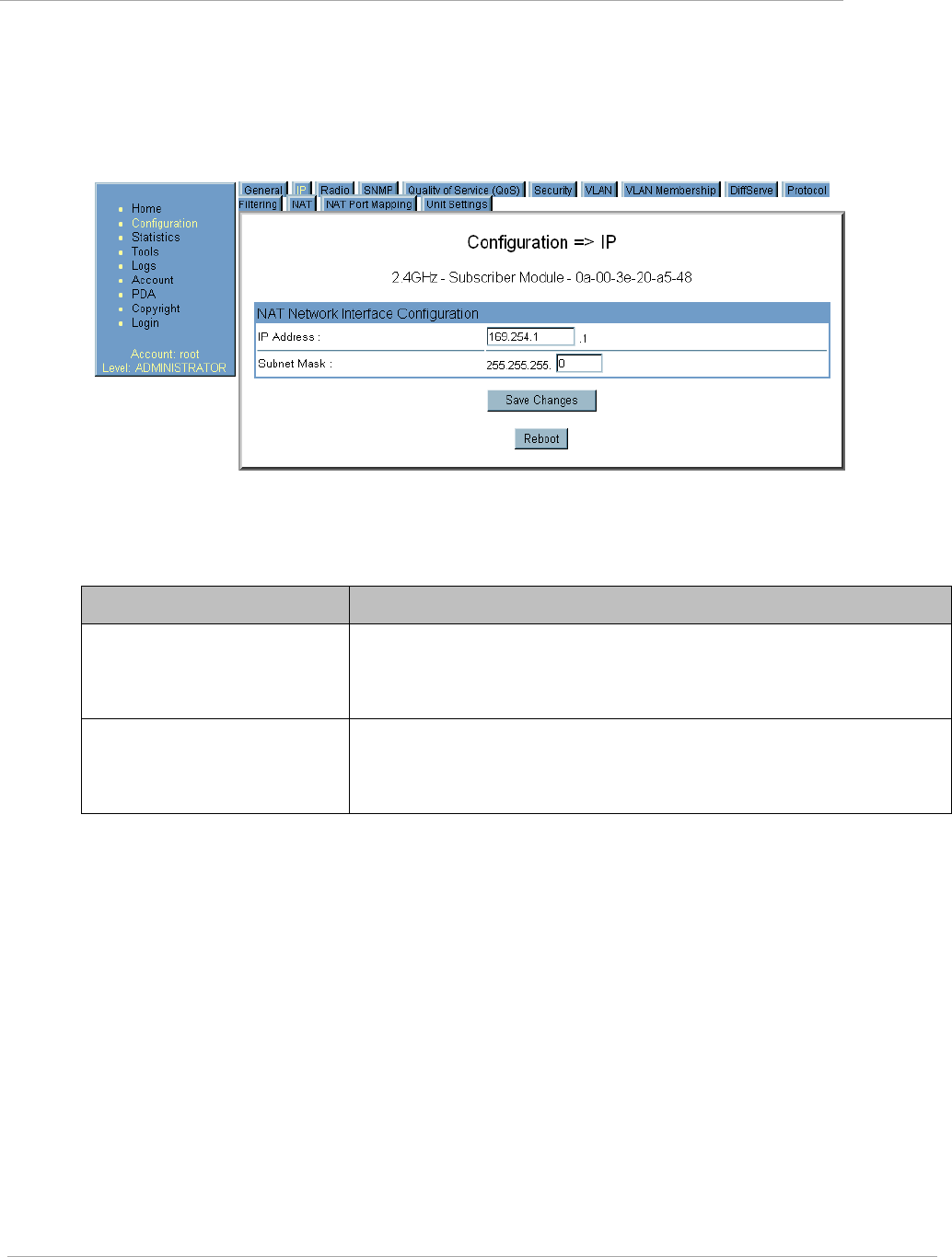
PMP 450 Configuration and User Guide
Task 2: Configuring IP and Ethernet
interfaces
pmp-0050 (May 2012)
2-21
IP tab of the SM with NAT enabled
Figure 4 IP tab of SM with NAT enabled
In the IP tab of an SM with NAT enabled, you may set the following parameters.
Table 7 SM with NAT enabled - IP attributes
Attribute
Meaning
NAT Network Interface
Configuration, IP Address
Assign an IP address for SM management through Ethernet access to the
SM. Set only the first three bytes. The last byte is permanently set to 1.
This address becomes the base for the range of DHCP-assigned addresses.
NAT Network Interface
Configuration, Subnet Mask
Assign a subnet mask of 255.255.255.0 or a more restrictive subnet mask.
Set only the last byte of this subnet mask. Each of the first three bytes is
permanently set to 255.
Reconnecting to the management PC
If the IP Address, Subnet Mask and Gateway IP Address of the unit have been updated to meet network
requirements, then reconfigure the local management PC to use an IP address that is valid for the network.
Refer to Configuring the management PC on page 2-3.
When the unit has rebooted, log in using the new IP address. Refer to Logging into the web interface on page
2-5.
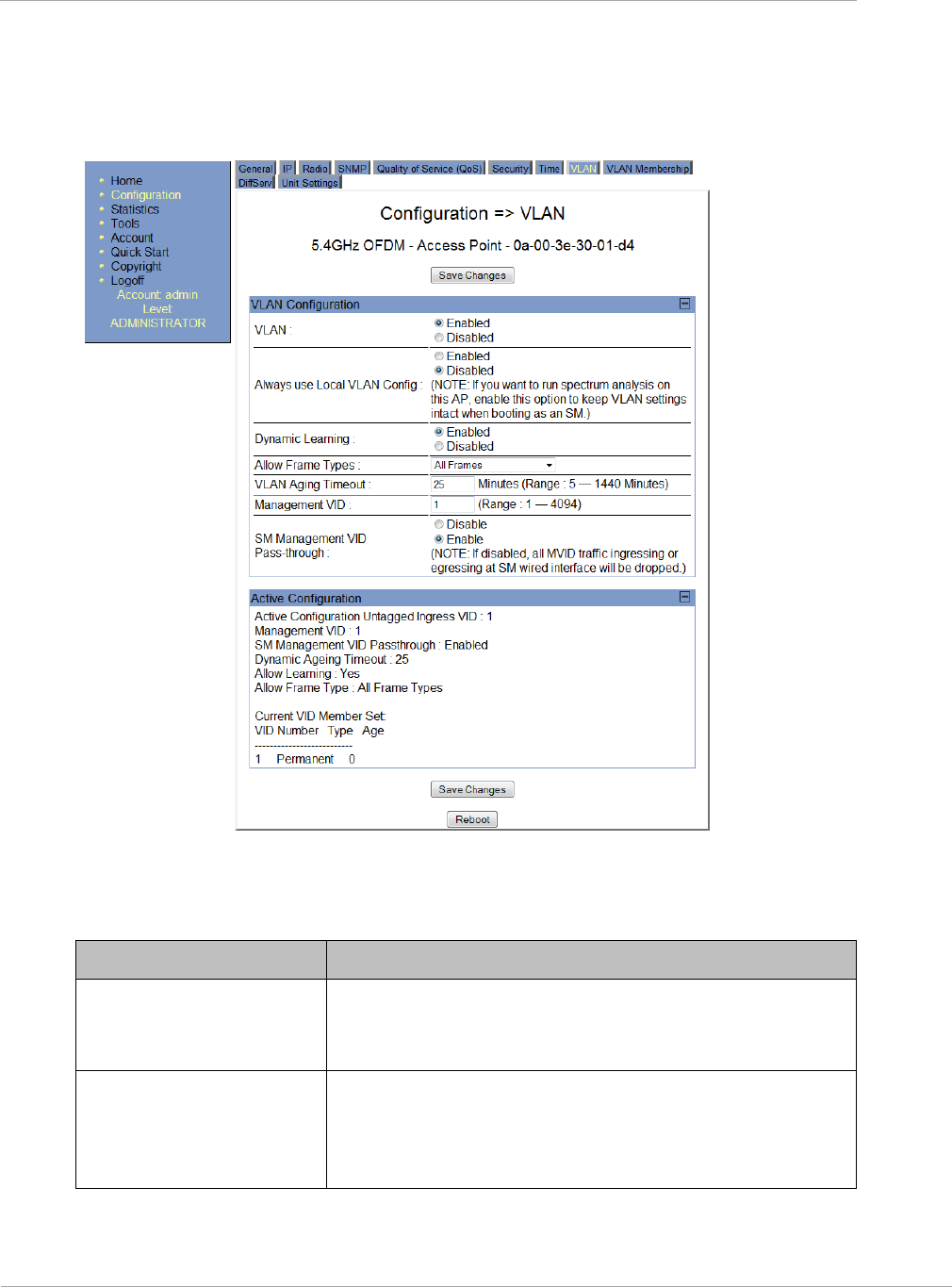
Task 2: Configuring IP and Ethernet
interfaces
Chapter 2: Configuration and alignment
2-22
pmp-0050 (May 2012)
VLAN Tab of the AP
Figure 5 VLAN tab of the AP
In the VLAN tab of the AP, you may set the following parameters.
Table 8 SM with NAT enabled - IP attributes
Attribute
Meaning
VLAN
Specify whether VLAN functionality for the AP and all linked
SMs should (Enabled) or should not (Disabled) be allowed. The
default value is Disabled.
Always use Local VLAN
Config
Enable this option before you reboot this AP as an SM to use it
to perform spectrum analysis. After the spectrum analysis is
completed and before you reboot this module as an AP, disable
this option.

PMP 450 Configuration and User Guide
Task 2: Configuring IP and Ethernet
interfaces
pmp-0050 (May 2012)
2-23
Attribute
Meaning
Dynamic Learning
Specify whether the AP should (Enabled) or should not
(Disabled) add the VLAN IDs (VIDs) of upstream frames to the
VID table. (The AP passes frames with VIDs that are stored in
the table both upstream and downstream.) The default value is
Enabled.
Allow Frame Types
Select the type of arriving frames that the AP should tag, using
the VID that is stored in the Untagged Ingress VID parameter.
The default value is All Frames.
VLAN Aging Timeout
Specify how long the AP should keep dynamically learned VIDs.
The range of values is 5 to 1440 (minutes). The default value is
25 (minutes).
VIDs that you enter for the Management VID and VLAN
Membership parameters do not time out.
Management VID
Enter the VID that the operator wishes to use to communicate
with the module manager. The range of values is 1 to 4095. The
default value is 1.
SM Management VID Pass-
through
Specify whether to allow the SM (Enable) or the AP (Disable) to
control the VLAN settings of the SM. The default value is
Enable.
Do not set this parameter to Enable where both a BAM
release earlier than 2.1 is implemented.
The Configuration Source parameter in the AP is set to
BAM.
This combination causes the SMs to become unmanageable,
until you gain direct access with an override plug and
remove this combination from the AP configuration.
QinQ EtherType
This parameter is the outer S-VLAN Ethertype that may be
configured to interoperate with other networks that use a
different Ethertype than the default.
Active Configuration
When VLAN is enabled in the AP, the Active Configuration
block provides the following details as read-only information in
this tab. In the Motorola fixed wireless broadband IP network,
each device of any type is automatically a permanent member of
VID 1. This facilitates deployment of devices that have VLAN
enabled with those that do not.

Task 2: Configuring IP and Ethernet
interfaces
Chapter 2: Configuration and alignment
2-24
pmp-0050 (May 2012)
Attribute
Meaning
Port VID
This is the VID that the AP will use for tagging frames of the
type specified by Allow Frame Types.
Management VID
This is the value of the parameter of the same name, configured
above.
SM Management VID Pass-
Through
This is the value of the parameter of the same name, configured
above.
Dynamic Ageing Timeout
This is the value of the VLAN Aging Timeout parameter
configured above.
Allow Learning
Yes is displayed if the value of the Dynamic Learning parameter
above is Enabled. No is displayed if the value of Dynamic
Learning is Disabled.
Allow Frame Type
This displays the selection that was made from the drop-down
list at the Allow Frame Types parameter above.
Current VID Member Set,
VID Number
This column lists the ID numbers of the VLANs in which this
module is a member, whether through assignment or through
dynamic learning.
Current VID Member Set,
Type
For each VID number in the first column, the entry in this
column correlates the way in which the module became and
continues to be a member:
Permanent—This indicates that the module was assigned the
VID number through direct configuration by the operator.
Dynamic—This indicates that the module adopted the VID
number through enabled dynamic learning, when a tagged
packet from an SM behind it in the network, or from a customer
equipment that is behind the SM in this case, was read.

PMP 450 Configuration and User Guide
Task 2: Configuring IP and Ethernet
interfaces
pmp-0050 (May 2012)
2-25
Attribute
Meaning
Current VID Member Set,
Age
For each VID number in the first column of the table, the entry
in this column reflects whether or when the VID number will
time out:
for Permanent type—the number will never time out, and
this is indicated by the digit 0.
for Dynamic type—the Age reflects what is configured in
the VLAN Aging Timeout parameter in the Configuration
=> VLAN tab of the AP or reflects a fewer number of
minutes that represents the difference between what was
configured and what has elapsed since the VID was
learned. Each minute, the Age decreases by one until, at
zero, the AP deletes the learned VID, but can it again from
packets sent by elements that are beneath it in the
network.
Values in this Active Configuration block can differ from
attempted values in configurations:
A VLAN profile administered by the BAM subsystem in
Prizm is capable of overriding any configured VLAN value,
if the Configuration Source parameter in the AP is set to
Authentication Server.
The AP itself can override the value that the SM has
configured for SM Management VID Pass-Through.
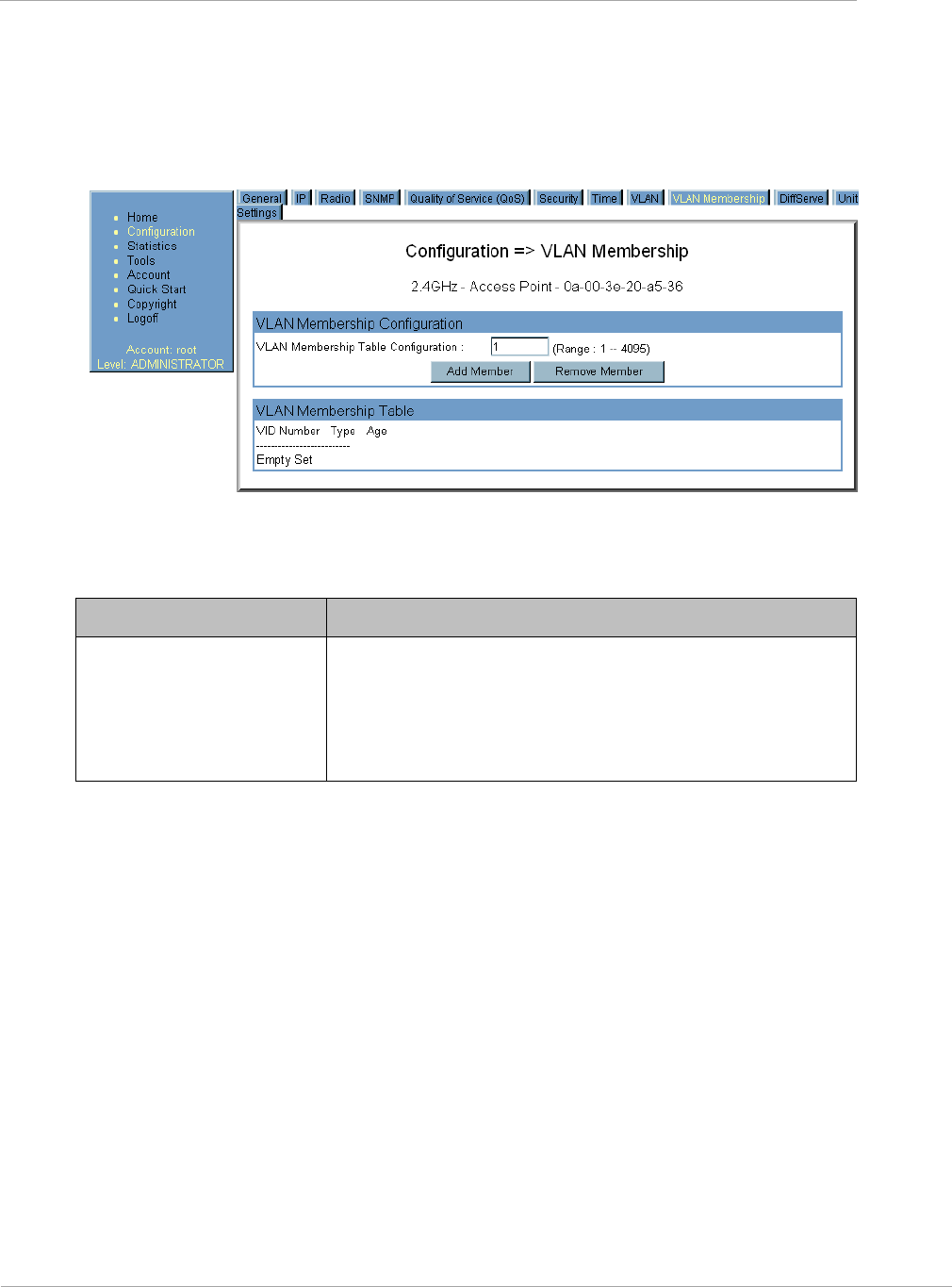
Task 2: Configuring IP and Ethernet
interfaces
Chapter 2: Configuration and alignment
2-26
pmp-0050 (May 2012)
VLAN Membership Tab of the AP
Table 9 VLAN Membership tab of the AP
You may set the VLAN Membership tab parameter as follows.
Table 10 AP VLAN Membership attributes
Attribute
Meaning
VLAN Membership Table
Configuration
For each VLAN in which you want the AP to be a member,
enter the VLAN ID and then click the Add Member button.
Similarly, for any VLAN in which you want the AP to no longer
be a member, enter the VLAN ID and then click the Remove
Member button.
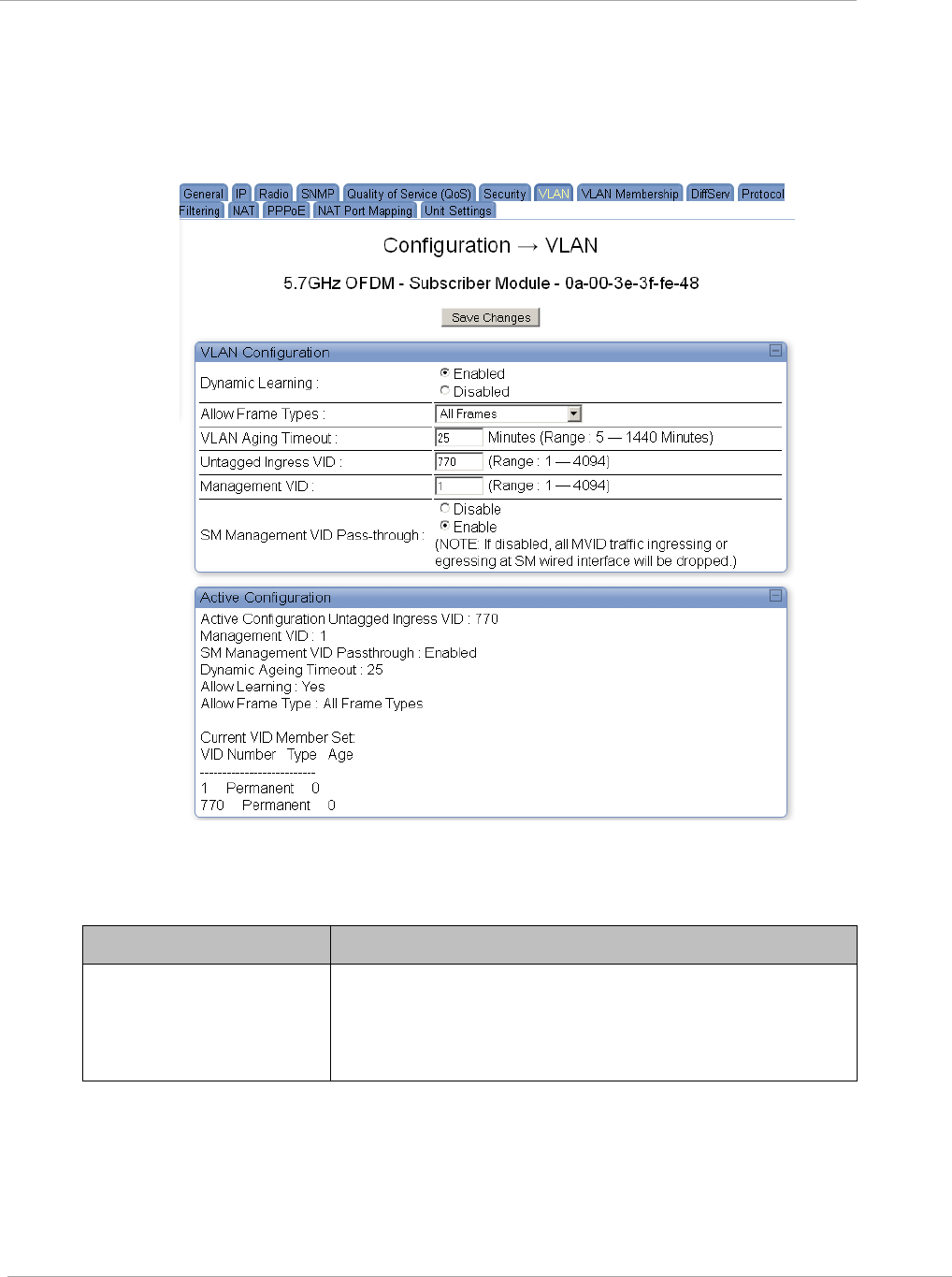
PMP 450 Configuration and User Guide
Task 2: Configuring IP and Ethernet
interfaces
pmp-0050 (May 2012)
2-27
VLAN Tab of the SM
Table 11 VLAN tab of the SM
In the VLAN tab of an SM, you may set the following parameters.
Table 12 SM VLAN attributes
Attribute
Meaning
Always use Local VLAN
Config
Enable this option before you reboot this AP as an SM to use it
to perform spectrum analysis. After the spectrum analysis is
completed and before you reboot this module as an AP, disable
this option.

Task 2: Configuring IP and Ethernet
interfaces
Chapter 2: Configuration and alignment
2-28
pmp-0050 (May 2012)
Attribute
Meaning
VLAN Port Type
By default this will be simply Q, indicating that it is to operate
in the existing manner. The other option is Q-in-Q, which
indicates that it should be adding and removing the S-Tag, and
adding a C-Tag if necessary for untagged packets. The VLAN
Port type corresponds to the Ethernet port of the SM.
Currently, the internal management interfaces will always
operate as Q ports.
Accept QinQ Frames
This option is valid for the Q-in-Q port so that the user may
force blocking of existing 802.1ad Q-in-Q frames. This way, only
untagged or single tagged packets will come in and out of the
Ethernet interface. If a Q-in-Q frame is about ingress or egress
the Ethernet interface and this is disabled, it will be dropped
and a filter entry will show up on the VLAN Statistics page as
DVLAN Egress or DVLAN Ingress.
Dynamic Learning
Specify whether the SM should (Enable) or should not (Disable)
add the VIDs of upstream frames (that enter the SM through
the wired Ethernet interface) to the VID table. The default
value is Enable.
Allow Frame Types
Select the type of arriving frames that the SM should tag, using
the VID that is stored in the Untagged Ingress VID parameter.
The default value is All Frames.
VLAN Aging Timeout
Specify how long the SM should keep dynamically learned
VIDs. The range of values is 5 to 1440 (minutes). The default
value is 25 (minutes).
VIDs that you enter for the Untagged Ingress VID and
Management VID parameters do not time out.
Management VID
Enter the VID that the SM should share with the AP. The range
of values is 1 to 4095. The default value is 1.
SM Management VID Pass-
through
Specify whether to allow the SM (Enable) or the AP (Disable) to
control the VLAN settings of this SM. The default value is
Enable.
When VLAN is enabled in the AP to whom this SM is registered,
the Active Configuration block provides the following details as
read-only information in this tab. In the Motorola fixed wireless
broadband IP network, each device of any type is automatically
a permanent member of VID 1. This facilitates deployment of
devices that have VLAN enabled with those that do not.

PMP 450 Configuration and User Guide
Task 2: Configuring IP and Ethernet
interfaces
pmp-0050 (May 2012)
2-29
Attribute
Meaning
Default Port VID
This is the VID that will be used for untagged frames and will
correspond to the Q-Tag for 802.1Q frames (if VLAN Port Type
is Q), or the C-Tag for 802.1ad frames (if the VLAN Port Type is
Q-in- Q).
Port VID MAC Address
Mapping
These parameters allow operators to place specific devices onto
different VLANs (802.1Q tag or 802.1ad C-tag) based on the
source MAC address of the packet. If the MAC address entry is
00-00-00-00-00-00 then that entry is not used. If a packet
arrives at the SM that is sourced from a device whose MAC
address is in the table, then the corresponding VID will be used
for that frame‘s Q-tag (Q port) or C-tag (Q-in-Q port). If there
is no match, then the Default Port VID will be used. This
table is also used in the downstream direction for removal of
the tag based on the destination MAC address so that an
untagged (for Q port) or Q-Tagged (for Q-in-Q port) frame is
delivered to the end device. You may use wildcards for the
non-OUI (Organizationally Unique Identifier) portion of the
MAC address, which is the last 3 bytes. MAC addresses contain
6 bytes, the first 3 of which are the OUI of the vendor that
manufactured the device and the last 3 are unique to that
vendor OUI. If you want to cover all devices from a known
vendor‘s OUI, you would specify 0xFF for the remaining 3
bytes. So, for example, if you wanted all devices from a specific
vendor with an OUI of 00-95-5b (which is a Netgear OUI) to
be on the same VID of 800, you would specify an entry with
MAC address 00-95-5b-ff-ff-ff. Then, any device underneath of
the SM with MAC addresses starting with 00-95-5b will be put
on VLAN 800.
Provider VID
The provider VID is used for the S-tag. It is only used if the
Port Type is Q-in-Q and will always be used for the S-tag. If an
existing 802.1Q frame arrives, the Provider VID is what will be
used for adding and removing of the outer S-tag. If an
untagged frame arrives to a Q-in-Q port, then the Provider VID
will be the S-tag and the Default Port VID (or Port VID MAC
Address Mapping, if valid) will be used for the C-tag.
Active Configuration,
Default Port VID
This is the value of the parameter of the same name, configured
above.
Active Configuration, MAC
Address VID Map
This is the listing of the MAC address VIDs configured in Port
VID MAC Address Mapping.
Active Configuration,
Management VID
This is the value of the parameter of the same name, configured
above.

Task 2: Configuring IP and Ethernet
interfaces
Chapter 2: Configuration and alignment
2-30
pmp-0050 (May 2012)
Attribute
Meaning
Active Configuration, SM
Management VID Pass-
Through
This is the value of the parameter of the same name, configured
above.
Active Configuration,
Dynamic Ageing Timeout
This is the value of the VLAN Aging Timeout parameter
configured above.
Active Configuration, Allow
Learning
Yes is displayed if the value of the Dynamic Learning parameter
above is Enabled. No is displayed if the value of Dynamic
Learning is Disabled.
Active Configuration, Allow
Frame Type
This displays the selection that was made from the drop-down
list at the Allow Frame Types parameter above.
Active Configuration, QinQ
This is set to Enabled if VLAN Port Type is set to QinQ, and is set
to Disabled if VLAN Port Type is set to Q.
Active Configuration, QinQ
EthType
This is the value of the QinQ EtherType configured in the AP.
Active Configuration, Allow
QinQ Tagged Frames
This is the value of Accept QinQ Frames, configured above.
Active Configuration,
Current VID Member Set,
VID Number
This column lists the ID numbers of the VLANs in which this
module is a member, whether through assignment or through
dynamic learning.
Active Configuration,
Current VID Member Set,
Type
For each VID number in the first column, the entry in this
column correlates the way in which the module became and
continues to be a member:
Permanent—This indicates that the module was assigned the
VID number through direct configuration by the operator.
Dynamic—This indicates that the module adopted the VID
number through enabled dynamic learning, when a tagged
packet from an SM behind it in the network, or from a customer
equipment that is behind the SM in this case, was read.
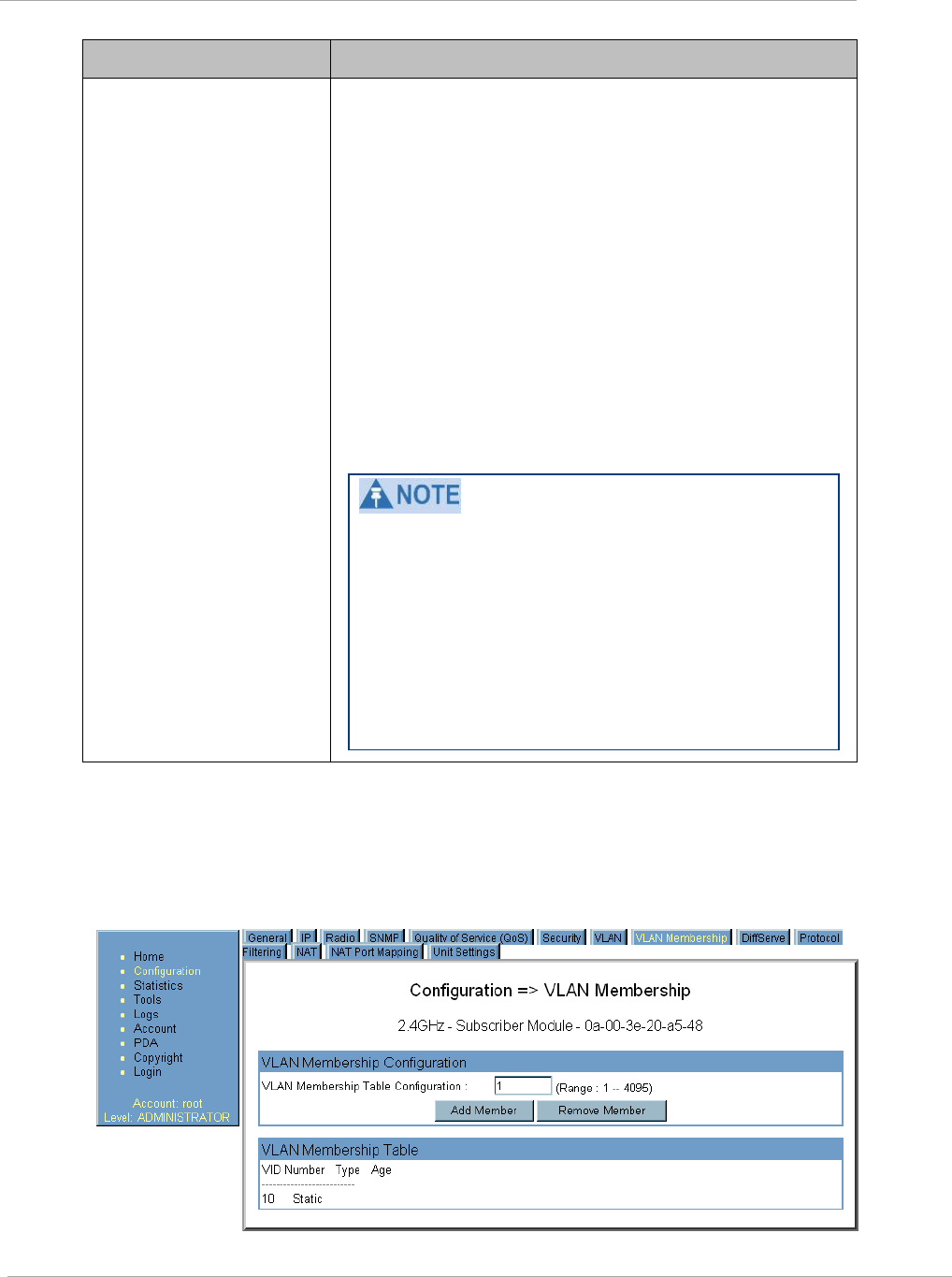
PMP 450 Configuration and User Guide
Task 2: Configuring IP and Ethernet
interfaces
pmp-0050 (May 2012)
2-31
Attribute
Meaning
Active Configuration,
Current VID Member Set,
Age
For each VID number in the first column of the table, the entry
in this column reflects whether or when the VID number will
time out:
for Permanent type—the number will never time out, and this is
indicated by the digit 0.
for Dynamic type—the Age reflects what is configured in the
VLAN Aging Timeout parameter in the Configuration => VLAN
tab of the AP or reflects a fewer number of minutes that
represents the difference between what was configured and what
has elapsed since the VID was learned. Each minute, the Age
decreases by one until, at zero, the AP deletes the learned VID,
but can it again from packets sent by elements that are beneath
it in the network.
Values in this Active Configuration block can differ from
attempted values in configurations:
A VLAN profile administered by the BAM subsystem in
Prizm is capable of overriding any configured VLAN value,
if the Configuration Source parameter in the AP is set to
BAM.
The AP can override the value that the SM has configured
for SM Management VID Pass-Through.
VLAN Membership Tab of the SM
Figure 6 VLAN Membership tab of the SM
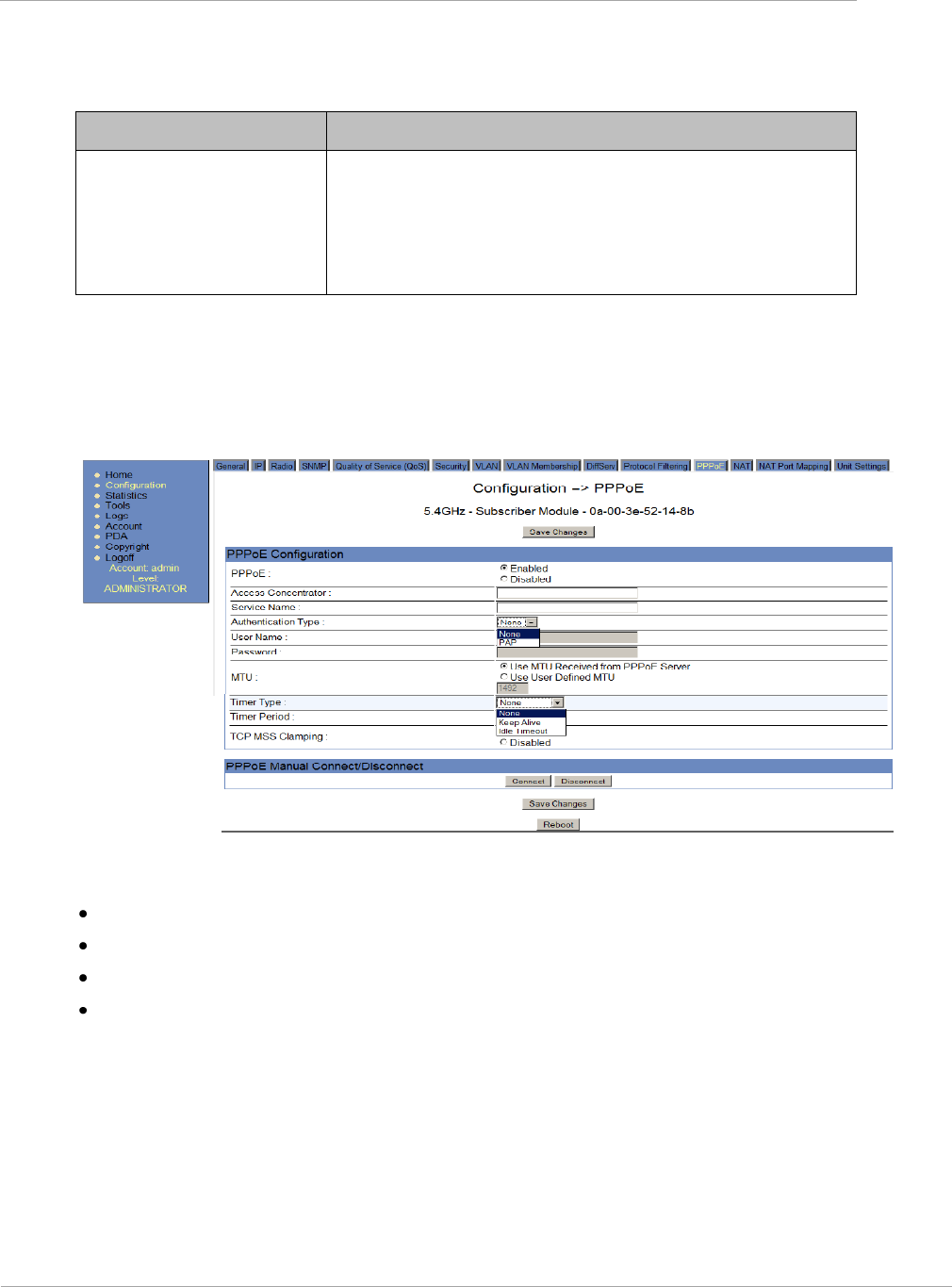
Task 2: Configuring IP and Ethernet
interfaces
Chapter 2: Configuration and alignment
2-32
pmp-0050 (May 2012)
In the VLAN Membership tab, you may set the following parameter.
Table 13 SM VLAN Membership attributes
Attribute
Meaning
VLAN Membership Table
Configuration
For each VLAN in which you want the AP to be a member,
enter the VLAN ID and then click the Add Member button.
Similarly, for any VLAN in which you want the AP to no longer
be a member, enter the VLAN ID and then click the Remove
Member button.
PPPoE Tab of the SM
Table 14 PPPoE tab of the SM
Point-to-Point Protocol over Ethernet (PPPoE) is a protocol that encapsulates PPP frames inside Ethernet
frames (at Ethernet speeds). Benefits to the network operator may include
Access control
Service monitoring
Generation of statistics about activities of the customer
Re-use of infrastructure and operational practices by operators who already use PPP for other networks
PPPoE options are configurable for the SM only, and the AP indicates whether or not PPPoE is enabled for a
specific subscriber.

PMP 450 Configuration and User Guide
Task 2: Configuring IP and Ethernet
interfaces
pmp-0050 (May 2012)
2-33
When PPPoE is enabled, once the RF session comes up between the SM and the AP, the SM will immediately
attempt to connect to the PPPoE Server. You can monitor the status of this by viewing the PPPoE Session
Log in the Logs section (Administrator only). Every time the RF session comes up, the SM will check the
status of the link and if it is down, the SM will attempt to redial the link if necessary depending on the Timer
Type. Also, on the Configuration page, the user may Connect or Disconnect the session manually. This can be
used to override the session to force a manual disconnect and/or reconnect if there is a problem with the session.
In order to enable PPPoE, NAT MUST be enabled on the SM, and Translation Bridging MUST be disabled on
the AP. These items will be strictly enforced for you when you are trying to enable PPPoE. A message will
indicate any prerequisites not being met. Also, the NAT Public IP DHCP client cannot be enabled This is
because the NAT Public IP will be received through the IPCP process of the PPPoE discovery stages.
The pre-requisites required are:
NAT MUST be enabled on the SM
o NAT DHCP Client will be disabled automatically. The NAT public IP will be received from the
PPPoE Server.
o NAT Public Network Interface Configuration will not be used and should be left to defaults. Also
NAT Public IP DHCP will be disabled if it is enabled.
Translation Bridging MUST be DISABLED on the AP
o This will only be determined if the SM is in session since the SM won‘t know the AP configuration
otherwise. If the SM is not in session, PPPoE can be enabled but if the SM goes into session to a
Translation Bridge-enabled AP, then PPPoE will not be enabled.
The following PPPoE configuration parameters are available:
Table 15 SM PPPoE attributes
Attribute
Meaning
Access Concentrator
An optional entry to set a specific access concentrator to
connect to for the PPPoE session. If this is blank, the SM will
accept the first access concentrator which matches the service
name (if specified). This is limited to 32 characters.
Service Name
An optional entry to set a specific service name to connect to
for the PPPoE session. If this is left blank the SM will accept
the first service option that comes back from the access
concentrator specified above, if any. This is limited to 32
characters.
Authentication Type
None means that no PPPoE authentication will be
implemented
CHAP/PAP means that CHAP authentication will be
attempted first, then PAP authentication. The same
password is used for both types.
User Name
This is the CHAP/PAP user name that will be used if
CHAP/PAP authentication is selected. If None is selected for
authentication then this field is unused. This is limited to 32
characters.

Task 2: Configuring IP and Ethernet
interfaces
Chapter 2: Configuration and alignment
2-34
pmp-0050 (May 2012)
Attribute
Meaning
Password
This is the CHAP/PAP password that will be used if PAP
authentication is selected. If None is selected for
authentication then this field is unused. This is limited to 32
characters.
MTU
Use MTU Received from PPPoE Server causes the SM to use
the MRU of the PPPoE server received in LCP as the MTU
for the PPPoE link.
Use User Defined MTU allows the operator to specify an MTU
value to use to override any MTU that may be determined in
the LCP phase of PPPoE session setup. If this is selected, the
user will be able to enter an MTU value up to 1492. However,
if the MTU determined in LCP negotiations is less than this
user-specified value, the SM will use the smaller value as its
MTU for the PPPoE link.
Timer Type
Keep Alive is the default timer type. This timer will enable a
keepalive that will check the status of the link periodically.
The user can set a keepalive period. If no data is seen from
the PPPoE server for that period, the link will be taken down
and a reconnection attempt will be started. For marginal
links, the keep alive timer can be useful so that the session
will stay alive over periodic dropouts. The keepalive timer
should be set such that the session can outlast any session
drop. Some PPPoE servers will have a session check timer of
their own so that the timeouts of the server and the SM
should be in sync so that one side does not drop the session
prematurely.
Idle Timeout enables an idle timer that will check the usage of
the link from the customer side. If there is no data seen from
the customer for the idle timeout period, the PPPoE session
will be dropped. Once data starts flowing from the customer
again, the session will be started up again. This timer is useful
for users who may not be using the connection frequently. If
the session is idle for long periods of time, this timer will allow
the resources used by the session to be returned to the server.
Once the connection is used again by the customer, the link
will be reestablished automatically.

PMP 450 Configuration and User Guide
Task 2: Configuring IP and Ethernet
interfaces
pmp-0050 (May 2012)
2-35
Attribute
Meaning
TCP MSS Clamping
If this is enabled, then the SM will alter TCP SYN and SYN-
ACK packets by changing the Maximum Segment Size to be
compatible with the current MTU of the PPPoE link. This
way, the user does not have to worry about MTU on the client
side for TCP packets. The MSS will be set to the current
MTU – 40 (20 bytes for IP headers and 20 bytes for TCP
headers). This will cause the application on the client side to
not send any TCP packets larger than the MTU. If the
network is exhibiting large packet loss, try enabling this
option. This may not be an option on the PPPoE server
itself. The SM will NOT reassemble IP fragments, so if the
MTUs are incorrect on the end stations, then MSS clamping
will solve the problem for TCP connections.
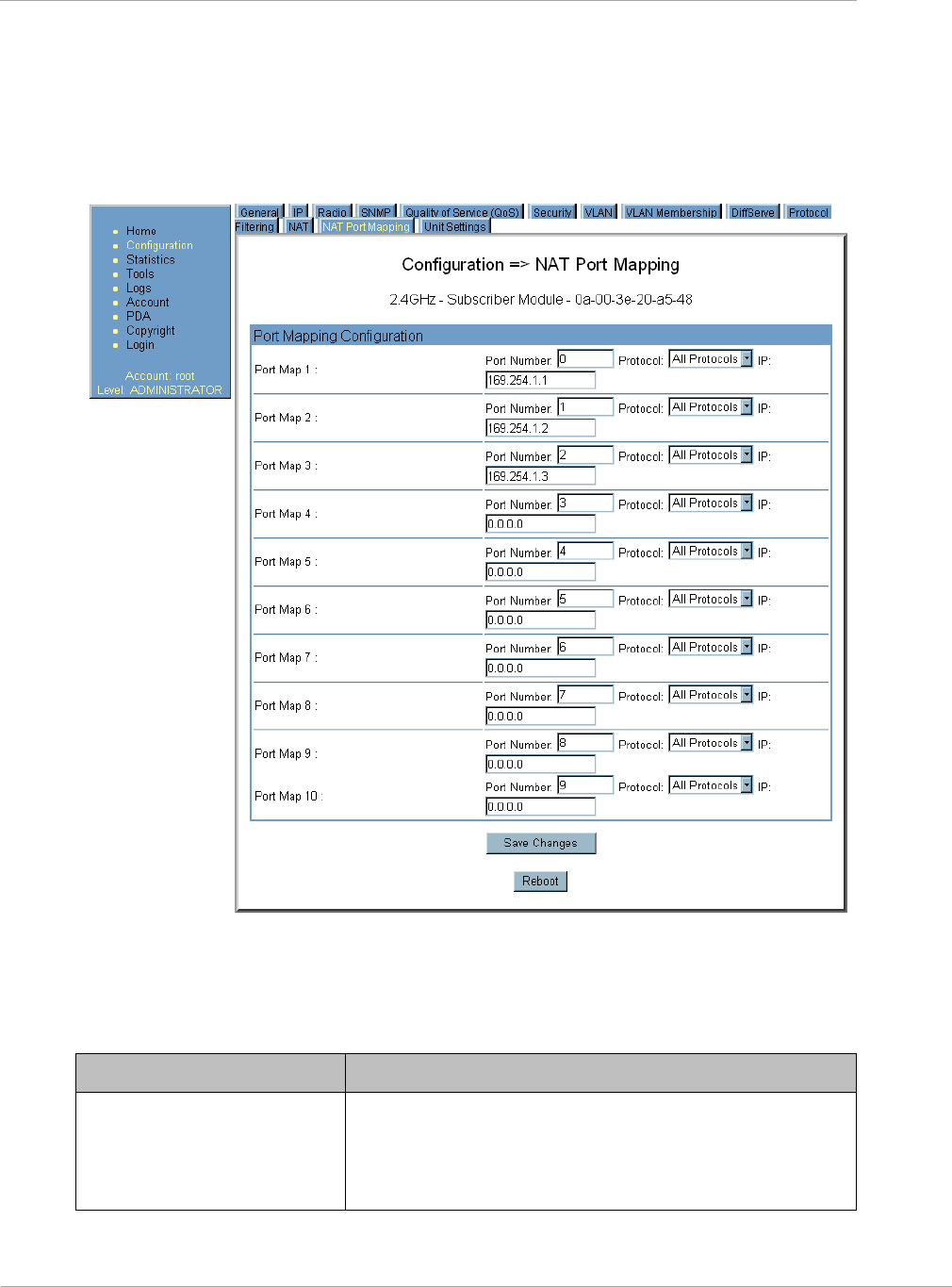
Task 2: Configuring IP and Ethernet
interfaces
Chapter 2: Configuration and alignment
2-36
pmp-0050 (May 2012)
NAT Port Mapping Tab of the SM
An example of the NAT Port Mapping tab in an SM is displayed in Error! Reference source not found..
Table 16 NAT Port Mapping tab of the SM
In the NAT Port Mapping tab of the SM, you may set the following parameters.
Table 17 SM PPPoE attributes
Attribute
Meaning
Port Map 1 to 10
Separate parameters allow you to distinguish NAT ports from
each other by assigning a unique combination of port number,
protocol for traffic through the port, and IP address for access
to the port
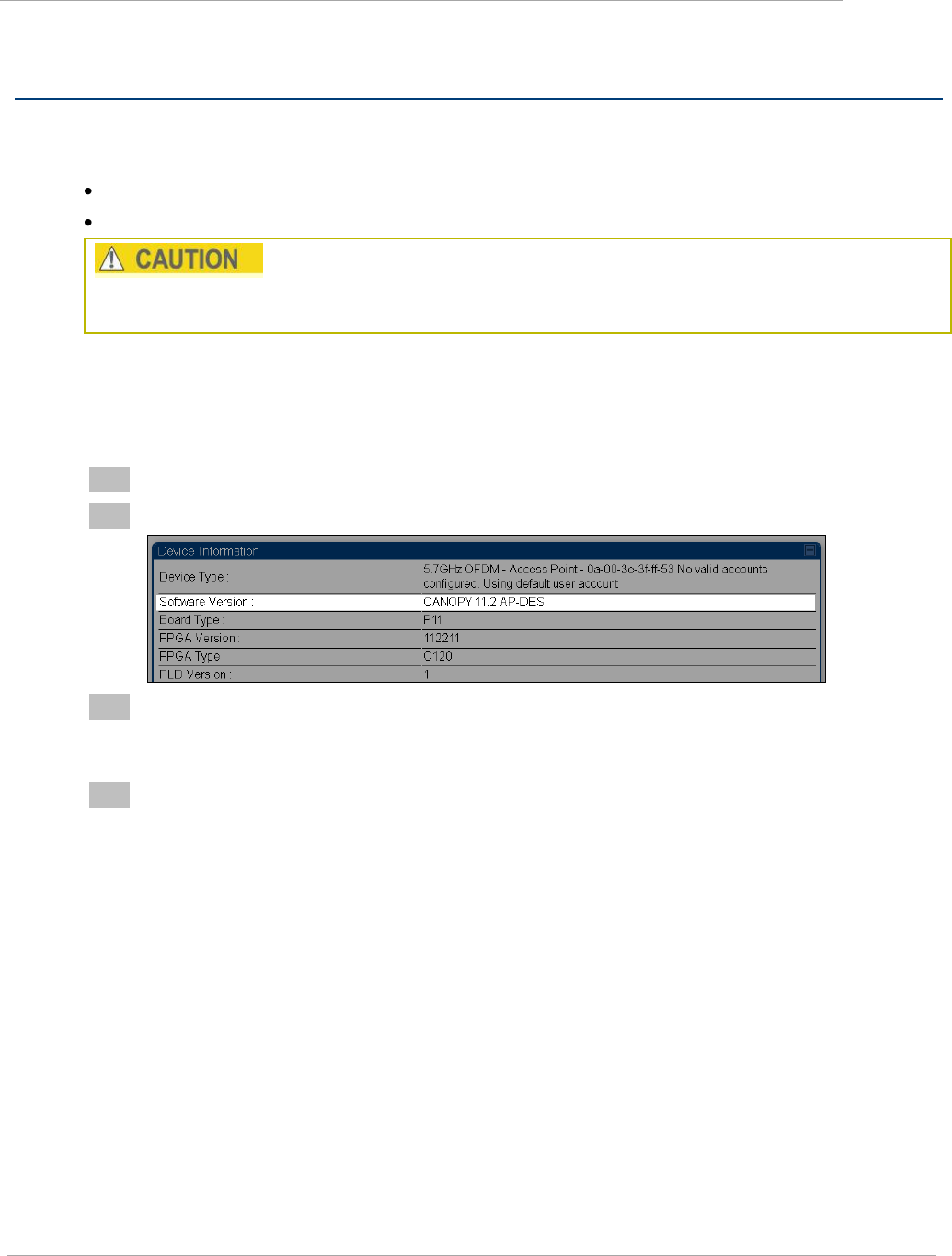
PMP 450 Configuration and User Guide
Task 3: Upgrading the software
version and using CNUT
pmp-0050 (May 2012)
2-37
Task 3: Upgrading the software version and using CNUT
This task consists of the following procedures:
Checking the installed software version on page 2-37
Upgrading to a new software version on page 2-37
If the link is operational, ensure that the remote end of the link is upgraded first using the wireless
connection, and then the local end can be upgraded. Otherwise, the remote end may not be accessible.
Checking the installed software version
To check the installed software version, proceed as follows:
1
Select Home menu tab General.
2
Note the installed Software Version (near the top of the page):
3
Go to the support website (see Contacting Cambium Networks on page 1-9) and find Point-to-
Multipoint software updates. Check that the latest PMP 450 software version (for example 13.0) is
the same as the installed Software Version.
4
If the software needs to be upgraded to the latest version, perform Upgrading to a new software
version on page 2-37.
Upgrading to a new software version
PMP 450 modules are upgraded using the Canopy Network Updater Tool (CNUT). The Canopy Network
Updater Tool (CNUT) manages and automates the software and firmware upgrade process for a Canopy radio,
CMMmicro, or CMM4 (but not its 14-port switch) across the network. This eliminates the need for an
administrator to visit each radio in the network (or each AP while using the Autoupdate feature) to upgrade
the modules.
This section includes an example of updating a single unit before deployment. System-wide upgrading
procedures may be found in the CNUT Online Help manual, which can be found on the Cambium support
website (see Contacting Cambium Networks on page 1-9).

Task 3: Upgrading the software
version and using CNUT
Chapter 2: Configuration and alignment
2-38
pmp-0050 (May 2012)
CNUT functions
The Canopy Network Updater Tool
automatically discovers all network elements
o executes a UDP command that initiates and terminates the Autoupdate mode within APs. This
command is both secure and convenient:
o For security, the AP accepts this command from only the IP address that you specify in the
Configuration page of the AP.
o For convenience, Network Updater automatically sets this Configuration parameter in the APs to the
IP address of the Network Updater server when the server performs any of the update commands.
allows you to choose among updating
o your entire network.
o only elements that you select.
o only network branches that you select.
provides a Script Engine that you can use with any script that
o you define.
o Motorola supplies.
Network element groups
With the Canopy Network Updater Tool, you can identify element groups composed of network elements that
you select. Identifying these element groups
organizes the display of elements (for example, by region or by AP cluster).
allows you to
o perform an operation on all elements in the group simultaneously.
o set group-level defaults for telnet or ftp password access and SNMP Community String (defaults that
can be overridden in an individual element when necessary).
Network layers
A typical network contains multiple layers of elements, with each layer farther from the Point of Presence. For
example, SMs are behind an AP and thus, in this context, at a lower layer than the AP. Correctly portraying
these layers in Network Updater is essential so that Network Updater can perform radio and AP cluster
upgrades in an appropriate order.
Correct layer information ensures that Network Updater does not command an AP that is behind another
AP/SM pair (such as in a remote AP installation) to perform an upgrade at the same time as the SM that is
feeding the AP. If this occurs, then the remote AP loses network connection during the upgrade (when the
SM in front of the AP completes its upgrade and reboots).
Script engine
Script Engine is the capability in Network Updater that executes any user-defined script against any network
element or element group. This capability is useful for network management, especially for scripts that you
repetitively execute across your network.

PMP 450 Configuration and User Guide
Task 3: Upgrading the software
version and using CNUT
pmp-0050 (May 2012)
2-39
The Autodiscovery capability in Network Updater finds all of your network elements. This comprehensive
discovery
ensures that, when you intend to execute a script against all elements, the script is indeed executed against
all elements.
maintains master lists of elements (element groups) against which you selectively execute scripts.
The following scripts are included with CNUT:
Gather Customer Support Information
Set Access Point Authentication Mode
Set Autoupdate Address on APs
Set SNMP Accessibility
Reset Unit
Software dependencies for CNUT
CNUT functionality requires
one of the following operating systems
o Windows® 2000
o Windows Server 2003
o Windows XP
o Red Hat Enterprise Linux Version 4
Java™ Runtime Version 2.0 or later (installed by the CNUT installation tool)
CNUT download
CNUT can be downloaded from the Cambium support website (see Contacting Cambium Networks on page 1-
9).
Upgrading a module prior to deployment
To upgrade to a new software version, proceed as follows:
1
Go to the support website (see Contacting Cambium Networks on page 1-9) and find Point-to-
Multipoint software updates. Download and save the required software image (for example
CANOPY130BUILDOFFICIAL_DES.pkg3).
2
Start CNUT
3
If you don‘t start up with a blank new network file in CNUT, then open a new network file with the
New Network Archive operation (located at File, New Network).
4
Enter a new network element to the empty network tree using the Add Elements to Network Root
operation (located at Edit, Add Elements to Network Root).
5
In the Add Elements dialogue, select a type of Access Point or Subscriber Module and enter the IP
address of 169.254.1.1.

Task 3: Upgrading the software
version and using CNUT
Chapter 2: Configuration and alignment
2-40
pmp-0050 (May 2012)
6
Make sure that the proper Installation Package is active with the Package Manager dialogue (located
at Update, Manage Packages).
7
To verify connectivity with the radio, perform a Refresh, Discover Entire Network operation (located
at View, Refresh/Discover Entire Network). You should see the details columns for the new element
filled in with ESN and software version information.
8
Initiate the upgrade of the radio using Update Entire Network Root operation (located at Update,
Update Entire Network Root). When this operation finishes, the radio is done being upgraded.
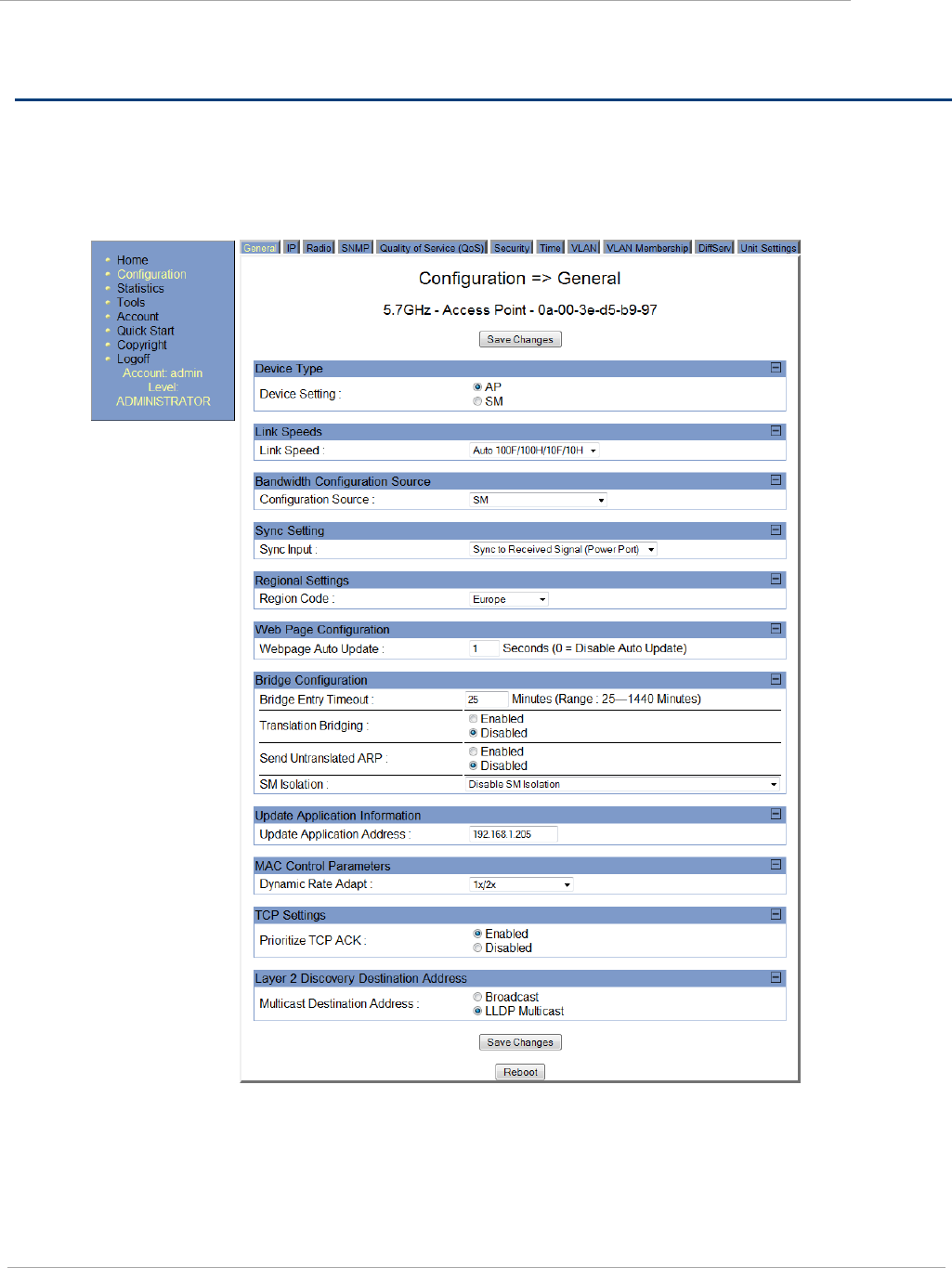
PMP 450 Configuration and User Guide
Task 4: Configuring General and Unit
settings
pmp-0050 (May 2012)
2-41
Task 4: Configuring General and Unit settings
General Tab of the AP
Table 18 General tab of the AP
The General tab of the AP contains many of the configurable parameters that define how the AP and the SMs
in the sector operate.

Task 4: Configuring General and Unit
settings
Chapter 2: Configuration and alignment
2-42
pmp-0050 (May 2012)
Table 19 SM PPPoE attributes
Attribute
Meaning
Device Setting
You can temporarily transform an AP into an SM and thereby use
the spectrum analyzer functionality. Otherwise, the selection for this
parameter is AP.
Link Speeds
From the drop-down list of options, select the type of link speed for
the Ethernet connection. The default for this parameter is that all
speeds are selected: Auto 100F/100H/10F/10H. In this setting, the
two ends of the link automatically negotiate with each other whether
the speed that they will use is 10 Mbps or 100 Mbps and whether the
Ethernet traffic will be full duplex or half duplex. However,
Ethernet links work best when either
both ends are set to the same forced selection
both ends are set to auto-negotiate and both have capability in least
one common speed and traffic type combination.
Configuration Source
See Setting the Configuration Source
Sync Input
Specify the type of synchronization for this AP to use:
Select Sync to Received Signal (Power Port) to set this AP to receive
sync from a connected CMMmicro or CMM4.
Select Sync to Received Signal (Timing Port) to set this AP to receive
sync from a connected CMM2, an AP in the cluster, or an SM.
Select Generate Sync Signal where the AP does not receive sync, and
no other AP is active within the link range.

PMP 450 Configuration and User Guide
Task 4: Configuring General and Unit
settings
pmp-0050 (May 2012)
2-43
Attribute
Meaning
Region Code
From the drop-down list, select the region in which the radio is
operating. Selectable regions are:
Australia
Brazil
Canada
Europe
India
Indonesia
Russia
Spain
Unites States
Other
When the appropriate region is selected in this parameter, the radio
automatically implements the applicable required Dynamic
Frequency Selection (DFS) standard.
Unlike selections in other parameters, your Region Code selection
requires a Save Changes and a Reboot cycle before it will force the
context-sensitive GUI to display related options (for example,
Alternate Frequency Carrier 1 and 2 in the Configuration => Radio
tab). Thus, a proper configuration exercise in environments that are
subject to DFS requirements has two imperative Save Changes and
Reboot cycles: one after the Region Code is set, and a second after
related options are set.
Webpage Auto Update
Enter the frequency (in seconds) for the web browser to
automatically refresh the web-based interface. The default setting is
0. The 0 setting causes the web-based interface to never be
automatically refreshed.
Bridge Entry Timeout
Specify the appropriate bridge timeout for correct network operation
with the existing network infrastructure. The Bridge Entry Timeout
should be a longer period than the ARP (Address Resolution
Protocol) cache timeout of the router that feeds the network.
An inappropriately low Bridge Entry Timeout setting may lead
to temporary loss of communication with some end users.
Translation Bridging
If you want the Translation Bridging feature, select Enabled. This
has numerous implications.

Task 4: Configuring General and Unit
settings
Chapter 2: Configuration and alignment
2-44
pmp-0050 (May 2012)
Attribute
Meaning
Send Untranslated ARP
If the Translation Bridging parameter is set to Enabled, then the
Send Untranslated ARP parameter can be
disabled, so that the AP will overwrite the MAC address in Address
Resolution Protocol (ARP) packets before forwarding them.
enabled, so that the AP will forward ARP packets regardless of
whether it has overwritten the MAC address.
If the Translation Bridging parameter is set to Disabled, then the
Send Untranslated ARP parameter has no effect.
SM Isolation
Prevent or allow SM-to-SM communication by selecting from the
following drop-down menu items:
Disable SM Isolation (the default selection). This allows full
communication between SMs.
Block SM Packets from being forwarded. This prevents both
multicast/broadcast and unicast SM-to-SM communication.
Block and Forward SM Packets to Backbone. This not only prevents
multicast/broadcast and unicast SM-to-SM communication but also
sends the packets, which otherwise would have been handled SM to
SM, through the Ethernet port of the AP.
Update Application
Address
Enter the address of the server to access for software updates on this
AP and registered SMs.
2X Rate
This parameter is present in only PMP 100 Series APs. You should
generally keep this parameter set to Enabled to allow the module to
automatically the operation rate. For troubleshooting, you may lock
the rate down (Disabled), but be aware that this locks down the
operation rate for all uplinks and downlinks across the sector.
Dynamic Rate Adapt
This parameter is present in only PMP 400 Series APs. You should
generally keep this parameter set to Enabled to allow the module to
automatically the operation rate. For troubleshooting, you may lock
the rate down (Disabled), but be aware that this locks down the
operation rate for all uplinks and downlinks across the sector.
Prioritize TCP ACK
To reduce the likelihood of TCP acknowledgement packets being
dropped, set this parameter to Enabled. This can improve
throughput that the end user perceives during transient periods of
congestion on the link that is carrying acknowledgements.

PMP 450 Configuration and User Guide
Task 4: Configuring General and Unit
settings
pmp-0050 (May 2012)
2-45
Attribute
Meaning
Multicast Destination
Address
Using Link Layer Discovery Protocol (LLDP), a module exchanges
multicast addresses with the device to which it is wired on the
Ethernet interface. Although some switches (CMMmicro, for
example) do not pass LLDP addresses upward in the network, a
radio can pass it as the value of the Multicast Destination Address
parameter value in the connected device that has it populated.
In this way, an SM can report to Prizm, for example, the multicast
address of a connected remote AP, and thus allow Prizm to discover
that AP. To allow this, set the message mode in the remote AP to
LLDP Multicast. The SM will pass this address in broadcast mode,
and the CMMmicro will pass the address upward in the network,
since it does not discard addresses that it receives in broadcast mode.
Where the AP is not behind another device, the Broadcast mode will
allow discovery of the AP.
DHCP Relay Agent
The AP may act as a DHCP relay for SMs and CPEs underneath it.
The AP will make use of the DHCP Option 82 (DHCP Relay Agent
Information) from RFC 3046 when performing relay functions. The
AP offers two types of DHCP relay functionality:
Full Relay Information. Configuring the DHCP Full Relay
Operation will take broadcast DHCP packets and send them to a
Unicast server in unicast mode. This way the DHCP requests and
replies can be routed like any other UDP packet.
Only Insert Option 82. This option leaves the DHCP request on its
broadcast domain as opposed to DHCP Full Relay Operation which
will turn it into a unicast packet.
In order to accommodate setting up pools or classes for different
VLANs, the Option 82 field will include information to tell the server
what VLAN the client is on.
DHCP Server (Name or
IP Address)
The DHCP relay server may be either a DNS name or a static IP
address in dotted decimal notation. Additionally the management
DNS domain name may be toggled such that the name of the DHCP
relay server only needs to be specified and the DNS domain name is
automatically appended to that name. The default DHCP relay
server addresses is 255.255.255.255 with the appending of the DNS
domain name disabled.
Coordinates
Physical radio location data may be configured via the Latitude,
Longitude, and Height fields.
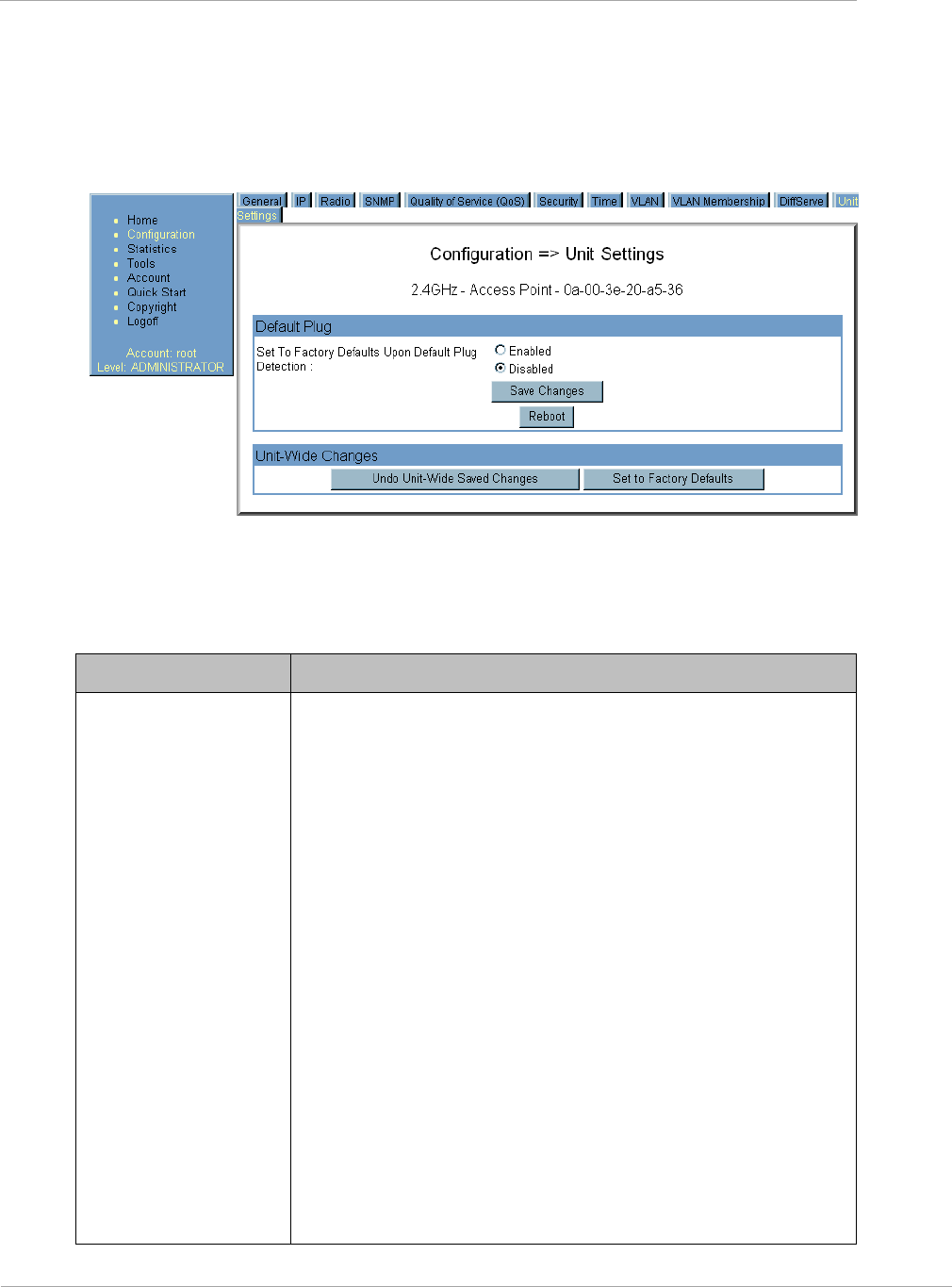
Task 4: Configuring General and Unit
settings
Chapter 2: Configuration and alignment
2-46
pmp-0050 (May 2012)
Unit Settings Tab of the AP
Table 20 Unit Settings tab of the AP
The Unit Settings tab of the AP contains an option for how the AP should react when it detects a connected
override plug. You may set this option as follows.
Table 21 AP Unit Settings attributes
Attribute
Meaning
Set to Factory Defaults
Upon Default Plug
Detection
If Enabled is checked, then an override/default plug functions as a
default plug. When the module is rebooted with the plug inserted, it
can be accessed at the IP address 169.254.1.1 and no password, and
all parameter values are reset to defaults. A subscriber, technician, or
other person who gains physical access to the module and uses an
override/default plug cannot see or learn the settings that were
previously configured in it. When the module is later rebooted with
no plug inserted, the module uses the new values for any parameters
that were changed and the default values for any that were not.
If Disabled is checked, then an override/default plug functions as an
override plug. When the module is rebooted with the plug inserted, it
can be accessed at the IP address 169.254.1.1 and no password, and
all previously configured parameter values remain and are displayed.
A subscriber, technician, or other person who gains physical access
to the module and uses an override/default plug can see and learn the
settings. When the module is later rebooted with no plug inserted,
the module uses the new values for any parameters that were
changed and the previous values for any that were not.
See Overriding Forgotten IP Addresses or Passwords on AP on Page
2-60.
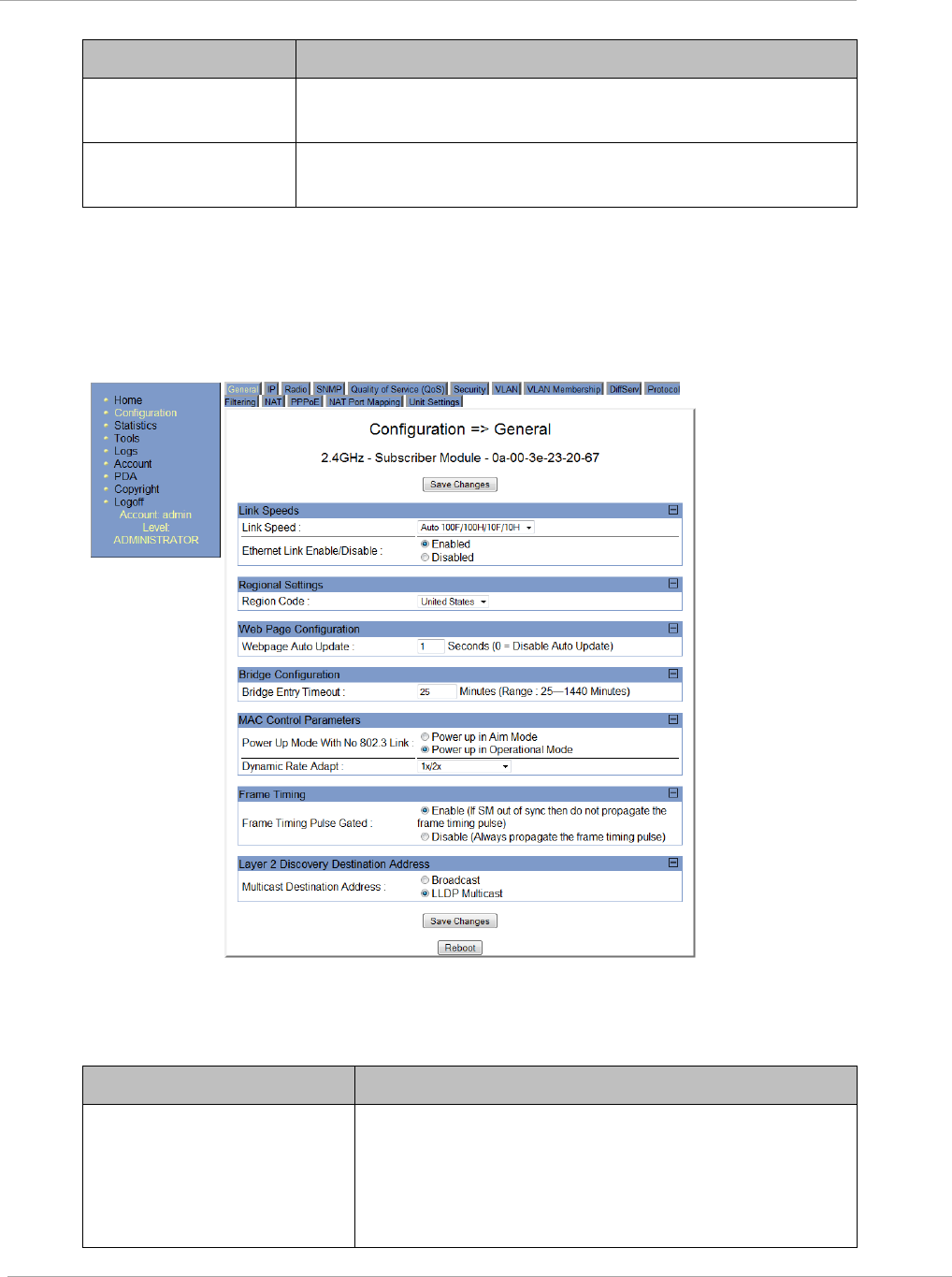
PMP 450 Configuration and User Guide
Task 4: Configuring General and Unit
settings
pmp-0050 (May 2012)
2-47
Attribute
Meaning
Undo Unit-Wide Saved
Changes
When you click this button, any changes that you made in any tab
but did not commit by a reboot of the module are undone.
Set to Factory Defaults
When you click this button, all configurable parameters on all tabs are
reset to the factory settings.
General Tab of the SM
Table 22 General tab of the SM
In the General tab of the SM, you may set the following parameters.
Table 23 AP Unit Settings attributes
Attribute
Meaning
Link Speeds
From the drop-down list of options, select the type of link
speed for the Ethernet connection. The default for this
parameter is that all speeds are selected. The recommended
setting is a single speed selection for all APs and SMs in the
operator network.

Task 4: Configuring General and Unit
settings
Chapter 2: Configuration and alignment
2-48
pmp-0050 (May 2012)
Attribute
Meaning
Ethernet Link Enable/Disable
Specify whether to enable or disable Ethernet/802.3
connectivity on the wired port of the SM. This parameter has
no effect on the wireless link. When you select Enable, this
feature allows traffic on the Ethernet/802.3 port. This is the
factory default state of the port. When you select Disable,
this feature prevents traffic on the port. Typical cases
of when you may want to select Disable include:
The subscriber is delinquent with payment(s).
You suspect that the subscriber is sending or flooding
undesired broadcast packets into the network, such as when
a virus is present in the subscriber's computing device.
the subscriber's home router is improperly configured.
Region Code
This parameter allows you to set the region in which the
radio will operate. When the appropriate region has been set,
the radio automatically implements the applicable required
Dynamic Frequency Selection (DFS) standard.
The slave radio automatically inherits the DFS type of the
master. This behavior ignores the value of the Region Code
parameter in the slave, even when the value is None.
Nevertheless, since future system software releases may read
the value in order to configure some other region-sensitive
feature(s), this parameter should always be set to the value
that corresponds to the local region.
Webpage Auto Update
Enter the frequency (in seconds) for the web browser to
automatically refresh the web-based interface. The default
setting is 0. The 0 setting causes the web-based interface to
never be automatically refreshed.

PMP 450 Configuration and User Guide
Task 4: Configuring General and Unit
settings
pmp-0050 (May 2012)
2-49
Attribute
Meaning
Bridge Entry Timeout
Specify the appropriate bridge timeout for correct network
operation with the existing network infrastructure. Timeout
occurs when the AP encounters no activity with the SM
(whose MAC address is the bridge entry) within the interval
that this parameter specifies. The Bridge Entry Timeout
should be a longer period than the ARP (Address Resolution
Protocol) cache timeout of the router that feeds the network.
This parameter governs the timeout interval, even if a
router in the system has a longer timeout interval. The
default value of this field is 25 minutes.
An inappropriately low Bridge Entry Timeout setting
may lead to temporary loss of communication with some
end users.
SM Power Up Mode With No
802.3 Link
This parameter is present in only PMP 100 Series SMs.
Specify the default mode in which this SM will power up
when the SM senses no Ethernet link. Select either
Power Up in Aim Mode—the SM boots in an aiming mode.
When the SM senses an Ethernet link, this parameter is
automatically reset to Power Up in Operational Mode. When
the module senses no Ethernet link within 15 minutes after
power up, the SM carrier shuts off.
Power Up in Operational Mode—the SM boots in Operational
mode. The module attempts registration. This is the default
selection.
2X Rate
This parameter is present in only PMP 100 Series (FSK) SMs.
Whatever value that you set in this parameter is overridden
by a lock-down to 1X operation, if that is configured in the
AP. In some cases, disabling this parameter facilitates
aiming. Be aware that a lock-down to 1X in the AP locks
down the uplink and downlink between the AP and all SMs
in its sector, and thus would affect traffic and performance
across the entire sector. Hence, a temporary lock-down for
aiming is better done in the individual SM.

Task 4: Configuring General and Unit
settings
Chapter 2: Configuration and alignment
2-50
pmp-0050 (May 2012)
Attribute
Meaning
Dynamic Rate Adapt
This parameter is present in only PMP 400 Series (OFDM)
SMs. Whatever value that you set in this parameter is
overridden by a lock-down to 1X or 2X operation, if that is
configured in the AP. As with the 2X Rate parameter in a
PMP 100 Series SM, a temporary lock-down to facilitate
aiming may be helpful. Be aware that a lock-down to 1X or
2X in the AP locks down the uplink and downlink between
the AP and all SMs in its sector, and thus would affect traffic
and performance across the entire sector. Hence, a temporary
lock-down for aiming is better done in the individual SM.
Frame Timing Pulse Gated
If this SM extends the sync pulse to a BH master or an AP,
select either
Enable—If this SM loses sync from the AP, then do not
propagate a sync pulse to the BH timing master or other AP.
This setting prevents interference in the event that the SM
loses sync.
Disable—If this SM loses sync from the AP, then propagate
the sync pulse to the BH timing master or other AP.
Multicast Destination Address
Using Link Layer Discovery Protocol (LLDP), a module
exchanges multicast addresses with the device to which it is
wired on the Ethernet interface. Although some switches
(CMMmicro, for example) do not pass LLDP addresses
upward in the network, a radio can pass it as the value of the
Multicast Destination Address parameter value in the
connected device that has it populated.
In this way, an SM can report to Prizm, for example, the
multicast address of a connected remote AP, and thus allow
Prizm to discover that AP. To allow this, set the message
mode in the remote AP to LLDP Multicast. Set this
parameter in the SM to Broadcast. The SM will pass this
address in broadcast mode, and the CMMmicro will pass the
address upward in the network, since it does not discard
addresses that it receives in broadcast mode.
Where the AP is not behind another device, the Broadcast
mode will allow discovery of the AP.
Coordinates
Physical radio location data may be configured via the
Latitude, Longitude, and Height fields.
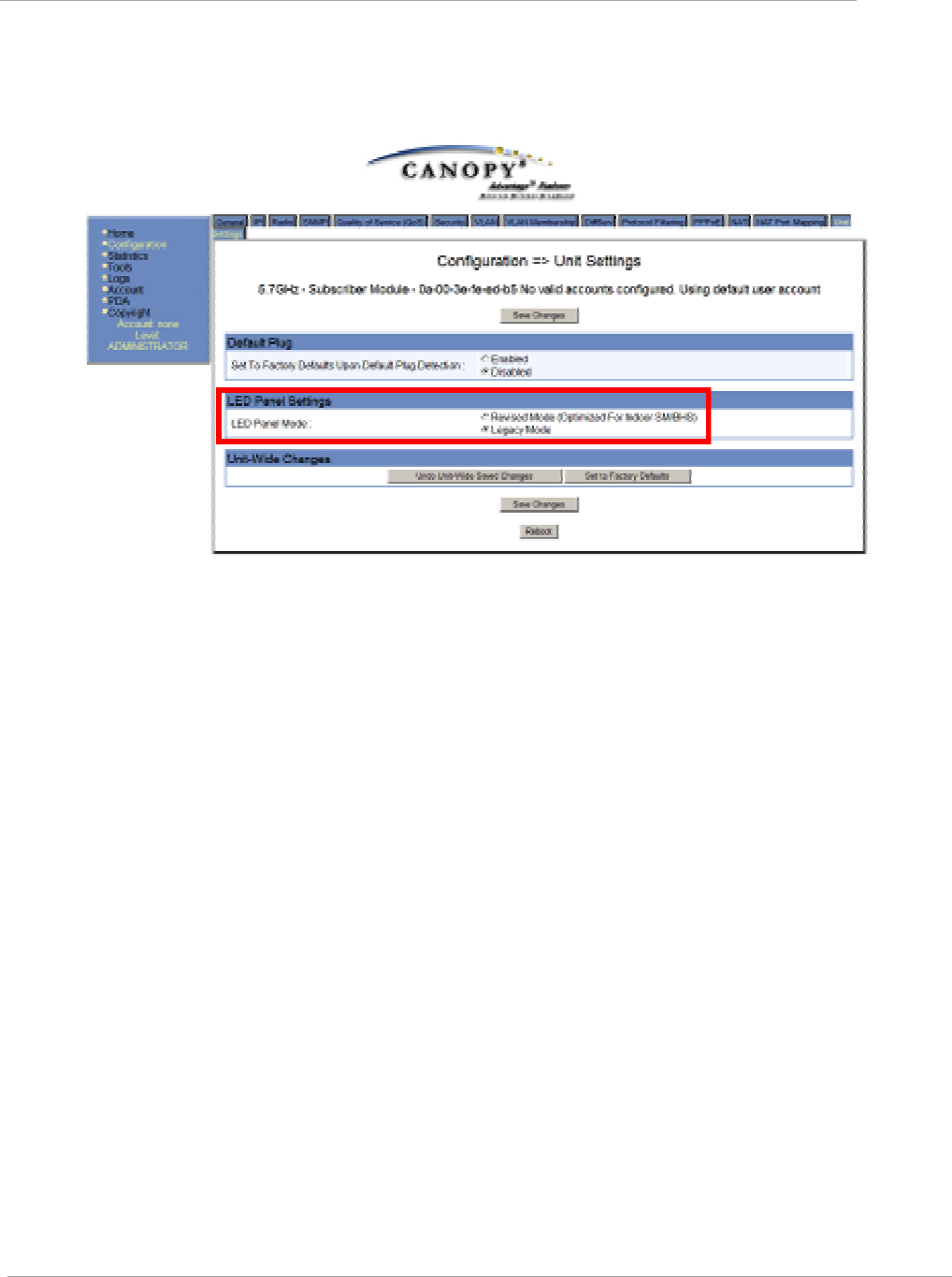
PMP 450 Configuration and User Guide
Task 4: Configuring General and Unit
settings
pmp-0050 (May 2012)
2-51
Unit Settings Tab of the SM
Table 24 Unit Settings tab of the SM
The Unit Settings tab of the SM contains an option for how the SM should react when it detects a connected
override plug. You may set this option as follows.

Task 4: Configuring General and Unit
settings
Chapter 2: Configuration and alignment
2-52
pmp-0050 (May 2012)
Table 25 SM Unit Settings attributes
Attribute
Meaning
Set to Factory Defaults Upon
Default Plug Detection
If Enabled is checked, then an override/default plug functions
as a default plug. When the module is rebooted with the plug
inserted, it can be accessed at the IP address 169.254.1.1 and
no password, and all parameter values are reset to defaults.
A subscriber, technician, or other person who gains physical
access to the module and uses an override/default plug cannot
see or learn the settings that were previously configured in it.
When the module is later rebooted with no plug inserted, the
module uses the new values for any parameters that were
changed and the default values for any that were not.
If Disabled is checked, then an override/default plug
functions as an override plug. When the module is rebooted
with the plug inserted, it can be accessed at the IP address
169.254.1.1 and no password, and all previously configured
parameter values remain and are displayed. A subscriber,
technician, or other person who gains physical access to the
module and uses an override/default plug can see and learn
the settings. When the module is later rebooted with no plug
inserted, the module uses the new values for any parameters
that were changed and the previous values for any that were
not.
See Overriding Forgotten IP Addresses or Passwords on AP
on Page 2-60.
Undo Unit-Wide Saved
Changes
When you click this button, any changes that you made in
any tab but did not commit by a reboot of the module are
undone.
Set to Factory Defaults
When you click this button, all configurable parameters on all
tabs are reset to the factory settings.
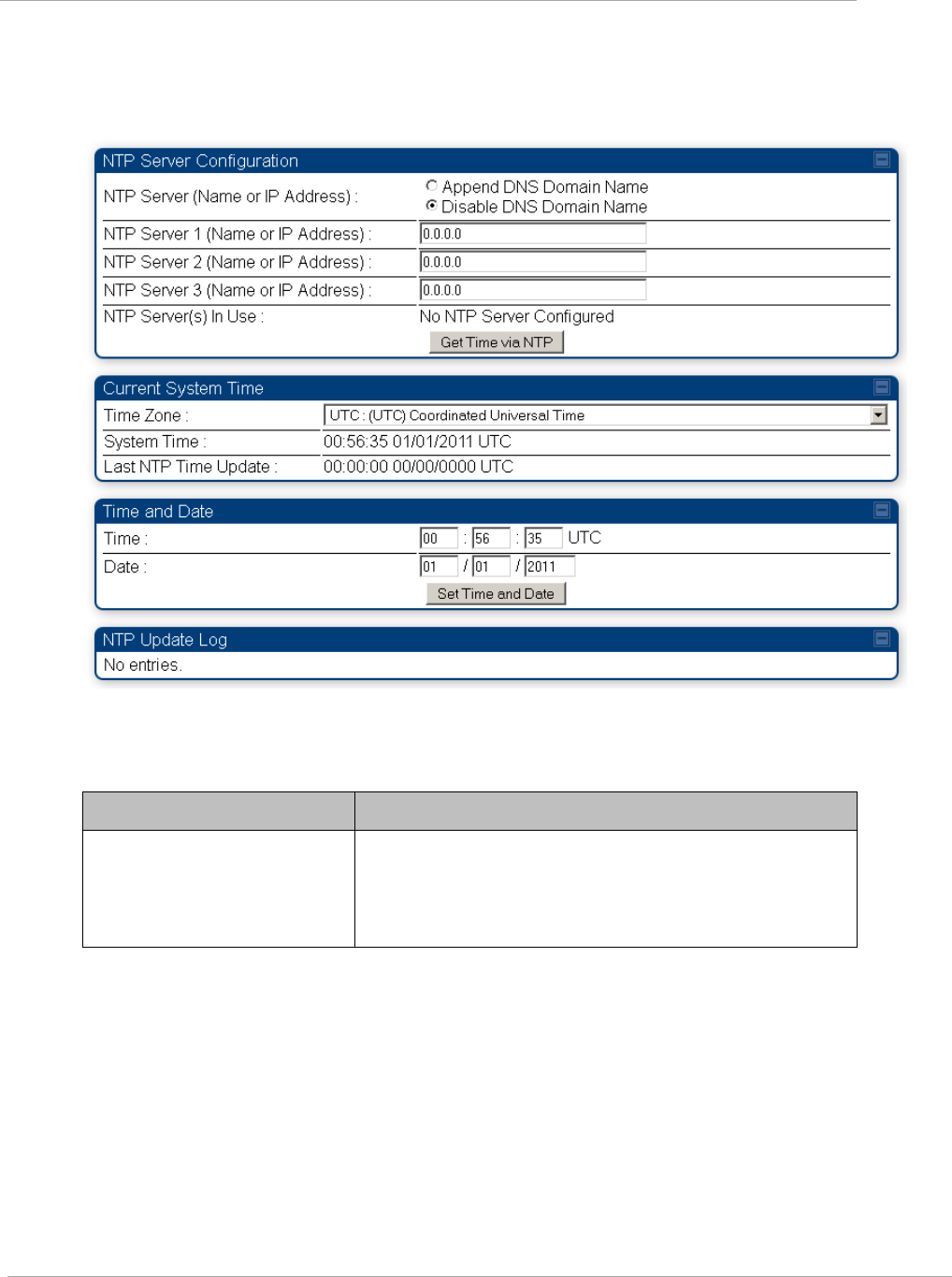
PMP 450 Configuration and User Guide
Task 4: Configuring General and Unit
settings
pmp-0050 (May 2012)
2-53
Time tab of the AP
Table 26 Unit Settings tab of the SM
You may set the time parameters as follows:
Table 27 AP Time attributes
Attribute
Meaning
NTP Server (Name or IP
Address)
The management DNS domain name may be toggled such
that the name of the NTP server only needs to be specified
and the DNS domain name is automatically appended to
that name.

Task 4: Configuring General and Unit
settings
Chapter 2: Configuration and alignment
2-54
pmp-0050 (May 2012)
Attribute
Meaning
NTP Server 1 (Name or IP
Address)
NTP Server 2 (Name or IP
Address)
NTP Server 3 (Name or IP
Address)
To have each log in the AP correlated to a meaningful time
and date, either a reliable network element must pass time
and date to the AP or you must set the time and date
whenever a power cycle of the AP has occurred. A network
element passes time and date in any of the following
scenarios:
A connected CMM2 or CMM4 passes time and date (GPS
time and date, if received).
A connected CMMmicro passes the time and date (GPS
time and date, if received), but only if both the
CMMmicro is operating on CMMmicro Release 2.1 or
later release. (These releases include NTP server
functionality.)
A separate NTP server is addressable from the AP.
If the AP should obtain time and date from a CMMmicro,
CMM4, or a separate NTP server, enter the IP address or
DNS name of the CMM or NTP server on this tab. To force
the AP to obtain time and date before the first (or next) 15-
minute interval query of the NTP server, click Get Time
through NTP.
The polling of the NTP servers is done in a sequential
fashion, and the polling status of each server is displayed in
the NTP Update Log section of the Time Configuration page.
An entry of 0.0.0.0 in any of the NTP Server fields indicates
an unused server configuration.
NTP Server(s) in Use
Lists the IP addresses of servers used for NTP retrieval.
Time Zone
The Time Zone option may be used to offset the received
NTP time to match the operator‘s local time zone. When set
on the AP, the offset will be set for the entire sector (SMs will
be notified of the current Time Zone upon initial
registration). If a Time Zone change is applied, the SMs will
be notified of the change in a best effort fashion, meaning
some SMs may not pick up the change until the next re-
registration. Time Zone changes are noted in the Event Log
of the AP and SM.
System Time
The current time used by the system.
Last NTP Time Update
The last time that the system time was set via NTP.
Time
This field may be used to manually set the system time of the
radio.

PMP 450 Configuration and User Guide
Task 4: Configuring General and Unit
settings
pmp-0050 (May 2012)
2-55
Attribute
Meaning
Date
This field may be used to manually set the system date of the
radio.

Task 5: Configuring security
Chapter 2: Configuration and alignment
2-56
pmp-0050 (May 2012)
Task 5: Configuring security
Perform this task to configure the PMP 450 system in accordance with the network operator‘s security policy.
Choose from the following procedures:
Isolating APs from the internet on page 2-56: to ensure that APs are properly secured from external
networks
Encrypting radio transmissions on page 2-57: to configure the unit to operate with AES or DES wireless
link security
Managing module access by passwords on page 2-58: to set up the AP to require SMs to authenticate via
the AP, Prizm, or RADIUS server
Filtering protocols and ports on page 2-62: to filter (block) specified protocols and ports from leaving the
system
Requiring SM Authentication on page 2-61: to configure the network to only allow registration to
authenticated SMs
Encrypting downlink broadcasts on page 2-64: to encrypt downlink broadcast transmissions such as ARP
and NetBIOS
Isolating SMs on page 2-64: to prevent SMs in the same sector from directly communicating with each
other
Filtering management through Ethernet on page 2-65: to prevent management access to the SM via the
radio‘s Ethernet port
Allowing management only from specified IP addresses on page 2-65: to only allow radio management
interface access from specified IP addresses
Configuring management IP by DHCP on page 2-65: to allow the radio‘s management IP address to be
assigned by a network DHCP server
Isolating APs from the internet
Ensure that the IP addresses of the APs in your network
are not routable over the Internet.
do not share the subnet of the IP address of your user.
RFC 1918, Address Allocation for Private Subnets, reserves for private IP networks three blocks of IP
addresses that are not routable over the Internet:
/8 subnets have one reserved network, 10.0.0.0 to 10.255.255.255.
/16 subnets have 16 reserved networks, 172.16.0.0 to 172.31.255.255.
/24 subnets have 256 reserved networks, 192.168.0.0 to 192.168.255.255.

PMP 450 Configuration and User Guide
Task 5: Configuring security
pmp-0050 (May 2012)
2-57
Encrypting radio transmissions
Motorola fixed wireless broadband IP systems employ the following forms of encryption for security of the
wireless link:
DES–Data Encryption Standard, an over-the-air link option that uses secret
56-bit keys and 8 parity bits.
AES–Advanced Encryption Standard, an extra-cost over-the-air link option that provides extremely
secure wireless connections. AES uses 128-bit secret keys as directed by the government of the U.S.A. AES
is not exportable and requires a special AP to process the large keys.
DES Encryption
Standard modules provide DES encryption. DES performs a series of bit permutations, substitutions, and
recombination operations on blocks of data. DES Encryption does not affect the performance or throughput of
the system.
AES Encryption
Motorola also offers fixed wireless broadband IP network products that provide AES encryption. AES uses the
Rijndael algorithm and 128-bit keys to establish a higher level of security than DES. Because of this higher
level of security, the government of the U.S.A. controls the export of communications products that use AES
(among which the AES feature activation key is one) to ensure that these products are available in only certain
regions and by special permit.
The distributor or reseller can advise service providers about current regional availability. AES products are
certified as compliant with the Federal Information Processing Standards (FIPS) in the U.S.A. The National
Institute of Standards and Technology (NIST) in the U.S.A. has specified AES for significantly greater security
than that which DES provides. NIST selected the AES algorithm for providing the best combination of
security, performance, efficiency, implementation, and flexibility. NIST collaborates with industry to develop
and apply technology, measurements, and standards.
AES-DES Operability Comparisons
This section describes the similarities and differences between DES and AES products, and the extent to which
they may interoperate.
Feature Availability
AES products run the same software as DES products. Thus feature availability and functionality are and will
continue to be the same, regardless of whether AES encryption is enabled. All interface screens are identical.
However, when encryption is enabled on the Configuration screen
the AES product provides AES encryption.
the DES product provides DES encryption.
AES and DES products use different FPGA (field-programmable gate array) loads. However, the AES FPGA
will be upgraded as needed to provide new features or services similar to those available for DES products.
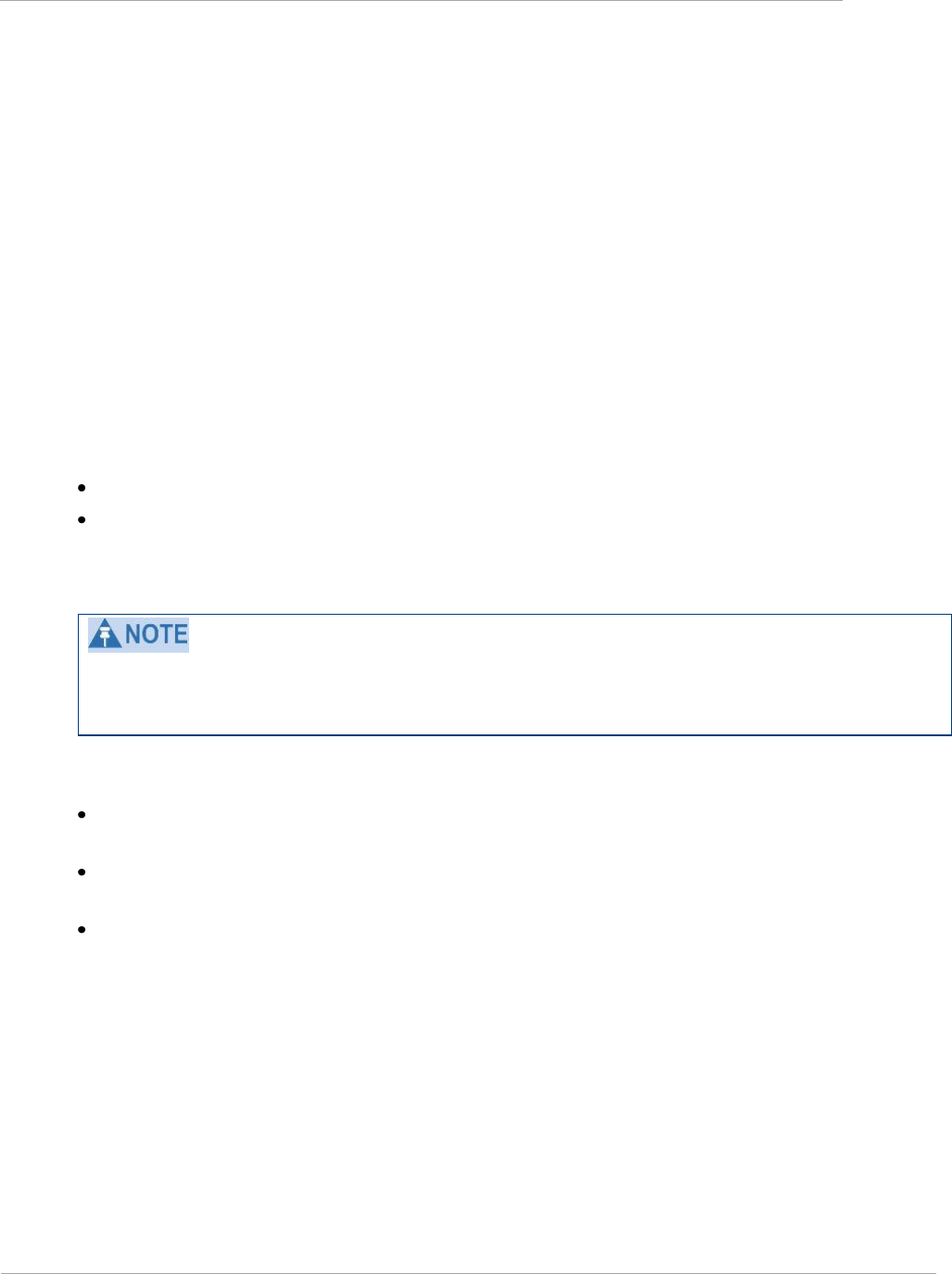
Task 5: Configuring security
Chapter 2: Configuration and alignment
2-58
pmp-0050 (May 2012)
Canopy DES products cannot be upgraded to AES. To have the option of AES encryption, the operator must
purchase AES products.
Interoperability
AES and DES products do not interoperate when enabled for encryption. For example, An AES AP with
encryption enabled cannot communicate with DES SMs. Similarly, an AES Backhaul timing master module
with encryption enabled cannot communicate with a DES Backhaul timing slave module.
However, if encryption is disabled, AES modules can communicate with DES modules.
Managing module access by passwords
Adding a User for Access to a Module
From the factory, each module has a preconfigured administrator-level account in the name root, which
initially requires no associated password. This is the same root account that you may have used for access to
the module by telnet or ftp. When you upgrade a module:
an account is created in the name admin.
both admin and root inherit the password that was previously used for access to the module:
o the Full Access password, if one was set.
o the Display-Only Access password, if one was set and no Full Access password was set.
If you use Prizm, do not delete the root account from any module. If you use an NMS that communicates with modules
through SNMP, do not delete the root account from any module unless you first can confirm that the NMS does not rely
on the root account for access to the modules.
Each module supports four or fewer user accounts, regardless of account levels. The available levels are
ADMINISTRATOR, who has full read and write permissions. This is the level of the root and admin
users, as well as any other administrator accounts that one of them creates.
INSTALLER, who has permissions identical to those of ADMINISTRATOR except that the installer
cannot add or delete users or change the password of any other user.
GUEST, who has no write permissions and only a limited view of General Status tab, and can log in as a
user.
From the factory default state, configure passwords for both the root and admin account at the
ADMINISTRATOR permission level, using the Account, Change Users Password tab. (If you configure only
one of these, then the other will still require no password for access into it and thus remain a security risk.) If
you are intent on configuring only one of them, delete the admin account. The root account is the only
account that CNUT uses to update and Prizm uses to manage the module.
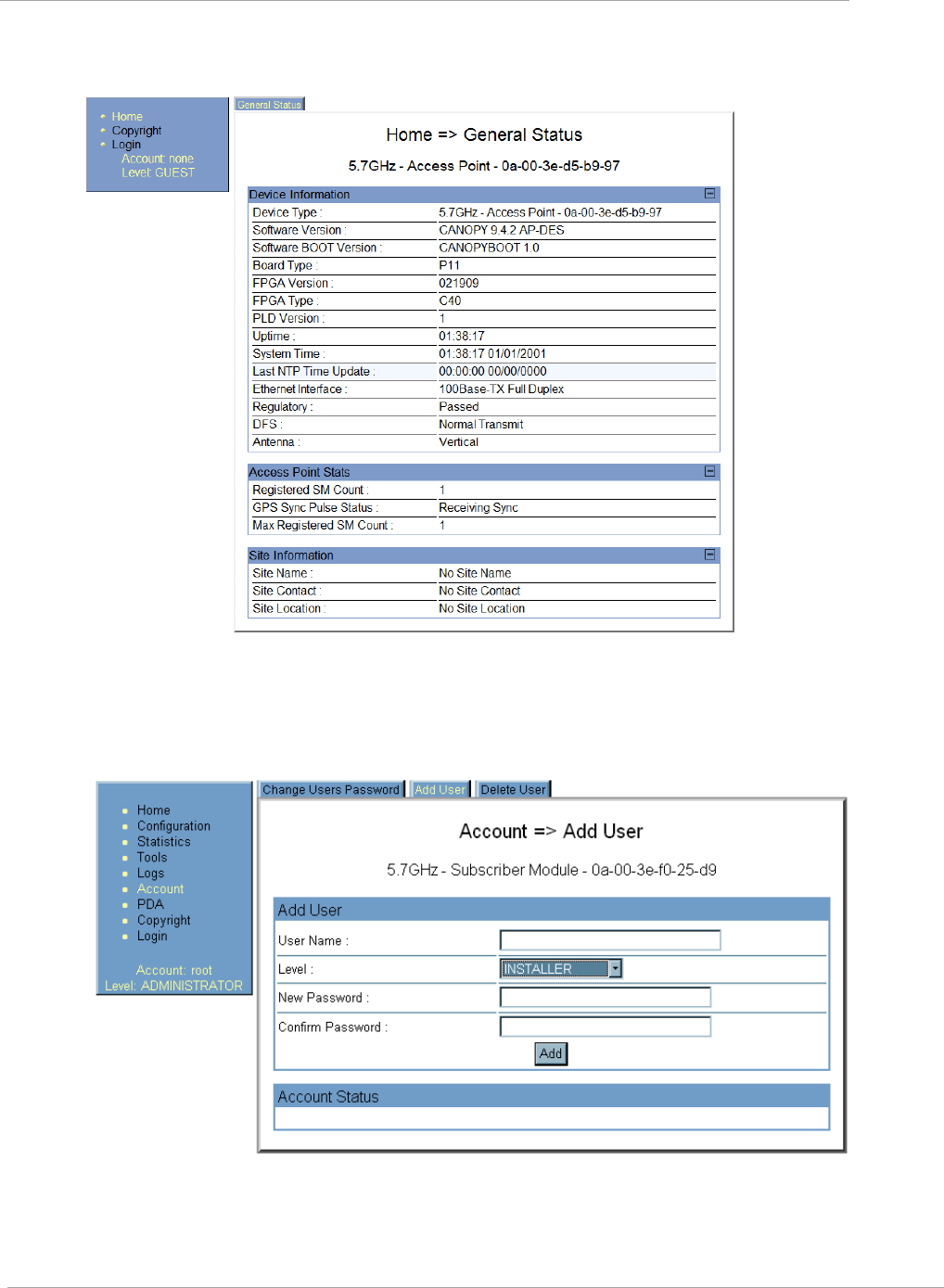
PMP 450 Configuration and User Guide
Task 5: Configuring security
pmp-0050 (May 2012)
2-59
Figure 7 General Status tab view for GUEST-level account
Figure 8 SM Add User tab
After a password has been set for any ADMINISTRATOR-level account, initial access to the module GUI
opens the view of GUEST level.
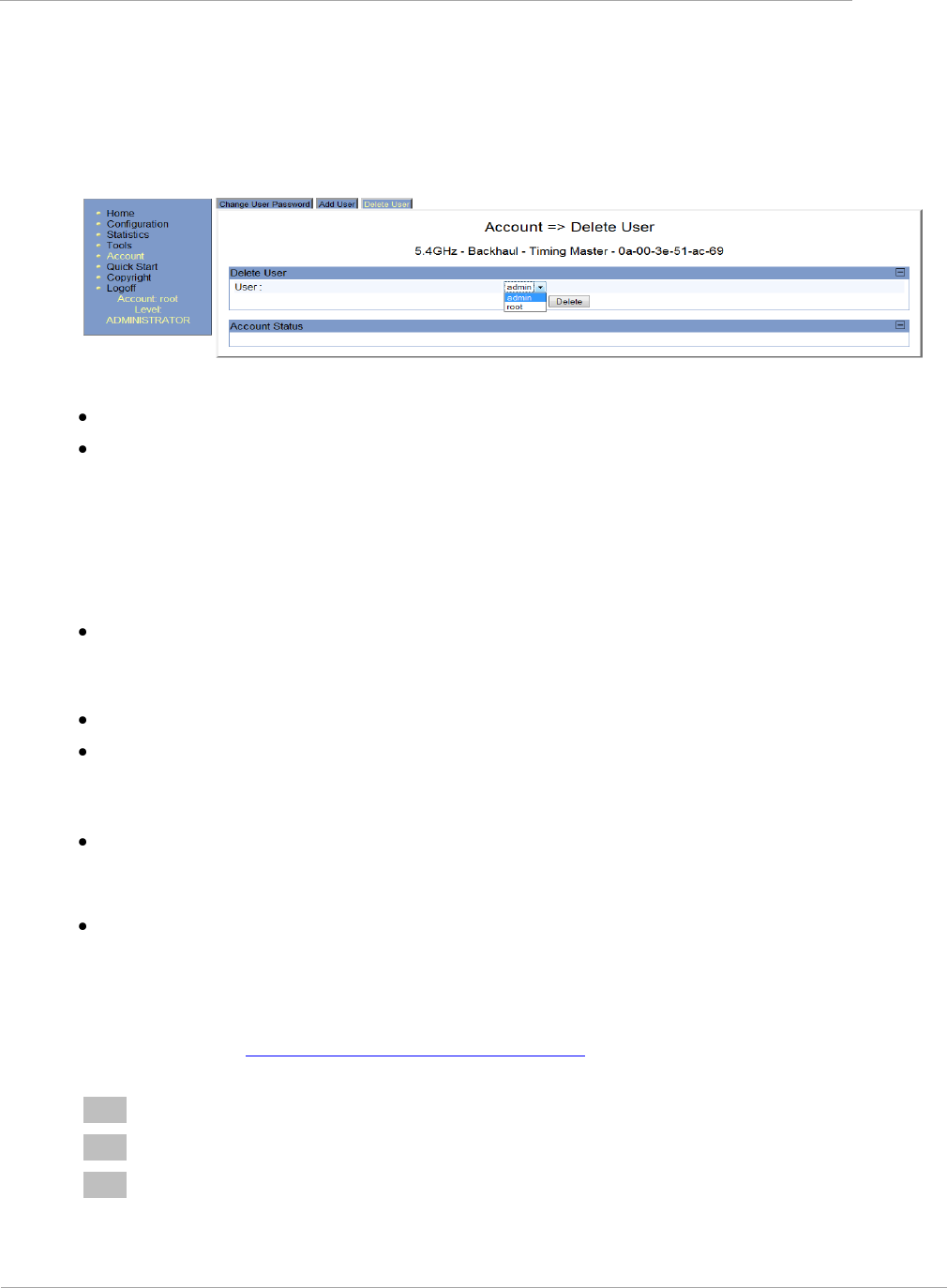
Task 5: Configuring security
Chapter 2: Configuration and alignment
2-60
pmp-0050 (May 2012)
Deleting a User from Access to a Module
The Account => Delete User tab provides a drop-down list of configured users from which to select the user
you want to delete.
Figure 9 Delete User tab of the SM
Accounts that cannot be deleted are
the current user's own account.
the last remaining account of ADMINISTRATOR level.
Overriding Forgotten IP Addresses or Passwords on AP and SM
A small adjunctive product allows you to temporarily override some AP/SM settings and thereby regain control
of the module. This override plug is needed for access to the module in any of the following cases:
You have forgotten either
o the IP address assigned to the module.
o the password that provides access to the module.
The module has been locked by the No Remote Access feature.
You want local access to a module that has had the 802.3 link disabled in the Configuration page.
You can configure the module such that, when it senses the override plug, it responds by either
resetting the LAN1 IP address to 169.254.1.1, allowing access through the default configuration without
changing the configuration, whereupon you will be able to view and reset any non-default values as you
wish.
resetting all configurable parameters to their factory default values.
Acquiring the Override Plug
You can either purchase or fabricate an override plug as follows. To purchase an override plug for a nominal
fee, order the plug at http://www.best-tronics.com/motorola.htm. To fabricate an override plug, perform the
following steps.
1
Install an RJ-11 6-pin connector onto a 6-inch length of CAT 5 cable
2
Pin out all 6-pins.
3
Short (solder together) Pins 4 and 6 on the other end. Do not connect any other wires to anything.
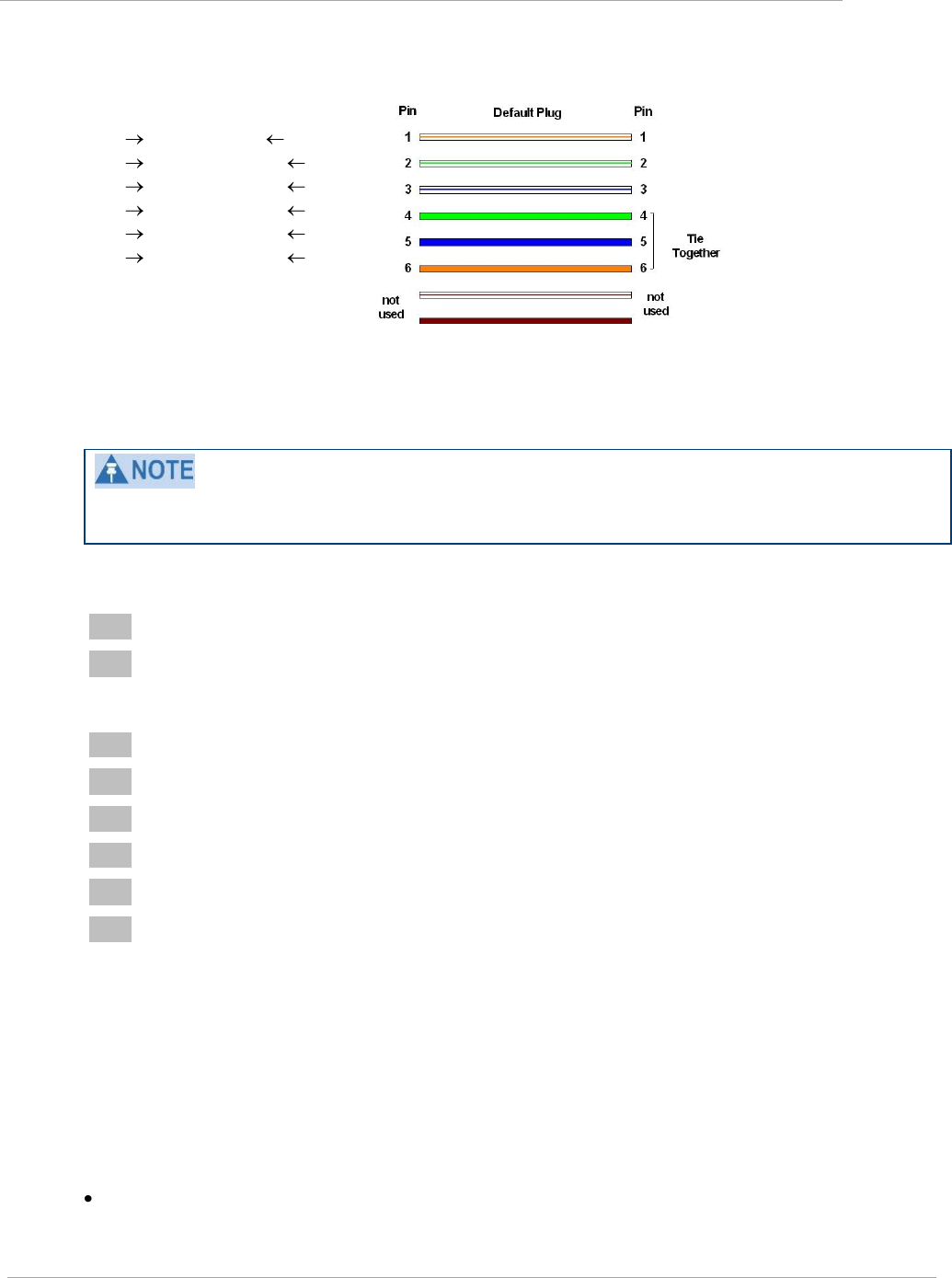
PMP 450 Configuration and User Guide
Task 5: Configuring security
pmp-0050 (May 2012)
2-61
Figure 10 RJ-11 pinout for the override plug
Pin 1 white / orange Pin 1
Pin 2 white / green Pin 2
Pin 3 white / blue Pin 3
Pin 4 green Pin 6
Pin 5 blue Pin 5
Pin 6 orange Pin 4
Using the Override Plug
While the override plug is connected to a module, the module can neither register nor allow registration of
another module.
To regain access to the module, perform the following steps.
1
Insert the override plug into the RJ-11 GPS utility port of the module.
2
Power cycle by removing, then re-inserting, the Ethernet cable.
RESULT: The module boots with the default IP address of 169.254.1.1, password fields blank, and
all other configuration values as previously set.
3
Wait approximately 30 seconds for the boot to complete.
4
Remove the override plug.
5
Set passwords and IP address as desired.
6
Change configuration values if desired.
7
Click the Save Changes button.
8
Click the Reboot button.
Requiring SM Authentication
Through the use of Prizm, a shared AP key, a BAM (Bandwidth and Authentication Manager) server, or an
external RADIUS (Remote Authentication Dial In User Service) server, you can enhance network security by
requiring SMs to authenticate when they register. Three keys and a random number are involved in
authentication as follows:
factory-set key in each SM. Neither the subscriber nor the network operator can view or change this key.

Task 5: Configuring security
Chapter 2: Configuration and alignment
2-62
pmp-0050 (May 2012)
authentication key, also known as authorization key and skey. This key matches in the SM and AP as the
Authentication Key parameter, and in the Prizm database.
random number, generated by Prizm or BAM and used in each attempt by an SM to register and
authenticate. The network operator can view this number.
session key, calculated separately by the SM and Prizm or BAM, based on both the authentication key (or,
by default, the factory-set key) and the random number. Prizm or BAM sends the session key to the AP.
The network operator cannot view this key.
None of the above keys is ever sent in an over-the-air link during an SM registration attempt. However, with
the assumed security risk, the operator can create and configure the Authentication Key parameter. See
Authentication Key on Page 2-73.
Filtering protocols and ports
You can filter (block) specified protocols and ports from leaving the SM and entering the network. This
protects the network from both intended and inadvertent packet loading or probing by network users. By
keeping the specified protocols or ports off the network, this feature also provides a level of protection to users
from each other.
Protocol and port filtering is set per SM. Except for filtering of SNMP ports, filtering occurs as packets leave
the SM. If an SM is configured to filter SNMP, then SNMP packets are blocked from entering the SM and,
thereby, from interacting with the SNMP portion of the protocol stack on the SM.
Port Filtering with NAT Enabled
Where NAT is enabled, you can filter only the three user-defined ports. The following are example situations in
which you can configure port filtering where NAT is enabled.
To block a subscriber from using FTP, you can filter Ports 20 and 21 (the FTP ports) for both the TCP and
UDP protocols.
To block a subscriber from access to SNMP, you can filter Ports 161 and 162 (the SNMP ports) for both
the TCP and UDP protocols.
In only the SNMP case, filtering occurs before the packet interacts with the protocol stack.
Protocol and Port Filtering with NAT Disabled
Where NAT is disabled, you can filter both protocols and the three user-defined ports. Using the check boxes
on the interface, you can either
allow all protocols except those that you wish to block.
block all protocols except those that you wish to allow.
You can allow or block any of the following protocols:
PPPoE (Point to Point Protocol over Ethernet)

PMP 450 Configuration and User Guide
Task 5: Configuring security
pmp-0050 (May 2012)
2-63
Any or all of the following IPv4 (Internet Protocol version 4) protocols:
o SMB (Network Neighborhood)
o SNMP
o Up to 3 user-defined ports
o All other IPv4 traffic
Uplink Broadcast
ARP (Address Resolution Protocol)
All others
Figure 11 Categorical protocol filtering
PPPoE ARP
All Other IPv4
User
Defined
Port 1
IPv4
Multicast
BootP
Server
BootP
Client
SNMP
SMB
User
Defined
Port 3
User
Defined
Port 2
All Others
The following are example situations in which you can configure protocol filtering where NAT is disabled:
If you block a subscriber from only PPoE and SNMP, then the subscriber retains access to all other
protocols and all ports.
If you block PPoE, IPv4, and Uplink Broadcast, and you also check the
All others selection, then only Address Resolution Protocol is not filtered.
. Further information is provided under Protocol Filtering Tab of the SM on Page 2-76.
Figure 12 Ports filtered per protocol selection
Protocol
Selected
Port Filtered (Blocked)
SMB
Destination Ports 137 TCP and UDP, 138 UDP, 139 TCP, 445 TCP

Task 5: Configuring security
Chapter 2: Configuration and alignment
2-64
pmp-0050 (May 2012)
Protocol
Selected
Port Filtered (Blocked)
SNMP
Destination Ports 161 TCP and UDP, 162 TCP and UDP
Bootp Client
Source Port 68 UDP
Bootp Server
Source Port 67 UDP
Encrypting downlink broadcasts
An AP can be enabled to encrypt downlink broadcast packets such as the following:
ARP
NetBIOS
broadcast packets containing video data on UDP.
The encryption used is DES for a DES module, and AES for an AES module. Before the Encrypt Downlink
Broadcast feature is enabled on the AP, air link security should be enabled on the AP.
Isolating SMs
In an AP, you can prevent SMs in the sector from directly communicating with each other. In CMMmicro
Release 2.2 or later and the CMM4, you can prevent connected APs from directly communicating with each
other, which prevents SMs that are in different sectors of a cluster from communicating with each other.
In the AP, the SM Isolation parameter is available in the General tab of the Configuration web page. In the
drop-down menu for that parameter, you can configure the SM Isolation feature by any of the following
selections:
Disable SM Isolation (the default selection). This allows full communication between SMs.
Block SM Packets from being forwarded. This prevents both multicast/broadcast and unicast SM-to-SM
communication.
Block and Forward SM Packets to Backbone. This not only prevents multicast/broadcast and unicast SM-
to-SM communication but also sends the packets, which otherwise would have been handled SM to SM,
through the Ethernet port of the AP.
In the CMMmicro and the CMM4, SM isolation treatment is the result of how you choose to manage the port-
based VLAN feature of the embedded switch, where you can switch all traffic from any AP to an uplink port
that you specify. However, this is not packet level switching. It is not based on VLAN IDs. See the VLAN Port
Configuration parameter in the dedicated user guide that supports the CMM product that you are deploying.

PMP 450 Configuration and User Guide
Task 5: Configuring security
pmp-0050 (May 2012)
2-65
Filtering management through Ethernet
You can configure the SM to disallow any device that is connected to its Ethernet port from accessing the IP
address of the SM. If you set the Ethernet Access Control parameter to Enabled, then
no attempt to access the SM management interface (by http, SNMP, telnet, ftp, or tftp) through Ethernet
can succeed.
any attempt to access the SM management interface over the air (by IP address, presuming that LAN1
Network Interface Configuration, Network Accessibility is set to Public, or by link from the Session Status
or Remote Subscribers tab in the AP) is unaffected.
Allowing management only from specified IP addresses
The Security tab of the Configuration web page in the AP and SM includes the IP Access Control parameter.
You can specify one, two, or three IP addresses that should be allowed to access the management interface (by
http, SNMP, telnet, ftp, or tftp).
If you select
IP Access Filtering Disabled, then management access is allowed from any IP address, even if the Allowed
Source IP 1 to 3 parameters are populated.
IP Access Filtering Enabled, and specify at least one address in the Allowed Source IP 1 to 3 parameter,
then management access is limited to the specified address(es). If you intend to use Prizm to manage the
element, then you must ensure that the IP address of the Prizm server is listed here.
Configuring management IP by DHCP
The IP tab in the Configuration web page of every radio contains a LAN1 Network Interface Configuration,
DHCP State parameter that, if enabled, causes the IP configuration (IP address, subnet mask, and gateway IP
address) to be obtained through DHCP instead of the values of those individual parameters. The setting of this
DHCP state parameter is also viewable, but is not settable, in the Network Interface tab of the Home page.
In the SM, this parameter is settable
in the NAT tab of the Configuration web page, but only if NAT is enabled.
in the IP tab of the Configuration web page, but only if the Network Accessibility parameter in the IP tab
is set to Public.
Denying All Remote Access
Wherever the No Remote Access feature is enabled by the following procedure, physical access to the module is
required for
any change in the configuration of the module.
any software upgrade in the module.

Task 5: Configuring security
Chapter 2: Configuration and alignment
2-66
pmp-0050 (May 2012)
Where additional security is more important than ease of network administration, you can disable all remote
access to a module as follows. After this procedure, no access to the module is possible through HTTP, SNMP,
FTP, or telnet over an RF link.
To deny remote access to the module, perform the following steps:
1
Insert the override plug into the RJ-11 GPS utility port of the module
2
Power up or power cycle the module
3
Access the web page http://169.254.1.1/lockconfig.html
4
Click the checkbox
5
Save the changes
6
Remove the override plug
7
Reboot the module
Reinstating Remote Access Capability
Where ease of network administration is more important than the additional security that the No Remote
Access feature provides, this feature can be disabled as follows. After this procedure, access to the module is
possible through HTTP, SNMP, FTP, or telnet over an RF link.
To reinstate all remote access to the module, perform the following steps:
1
Insert the override plug into the RJ-11 GPS utility port of the module
2
Power up or power cycle the module
3
Access the web page http://169.254.1.1/lockconfig.html
4
Click the check box to uncheck the field
5
Save the changes
6
Remove the override plug
7
Reboot the module
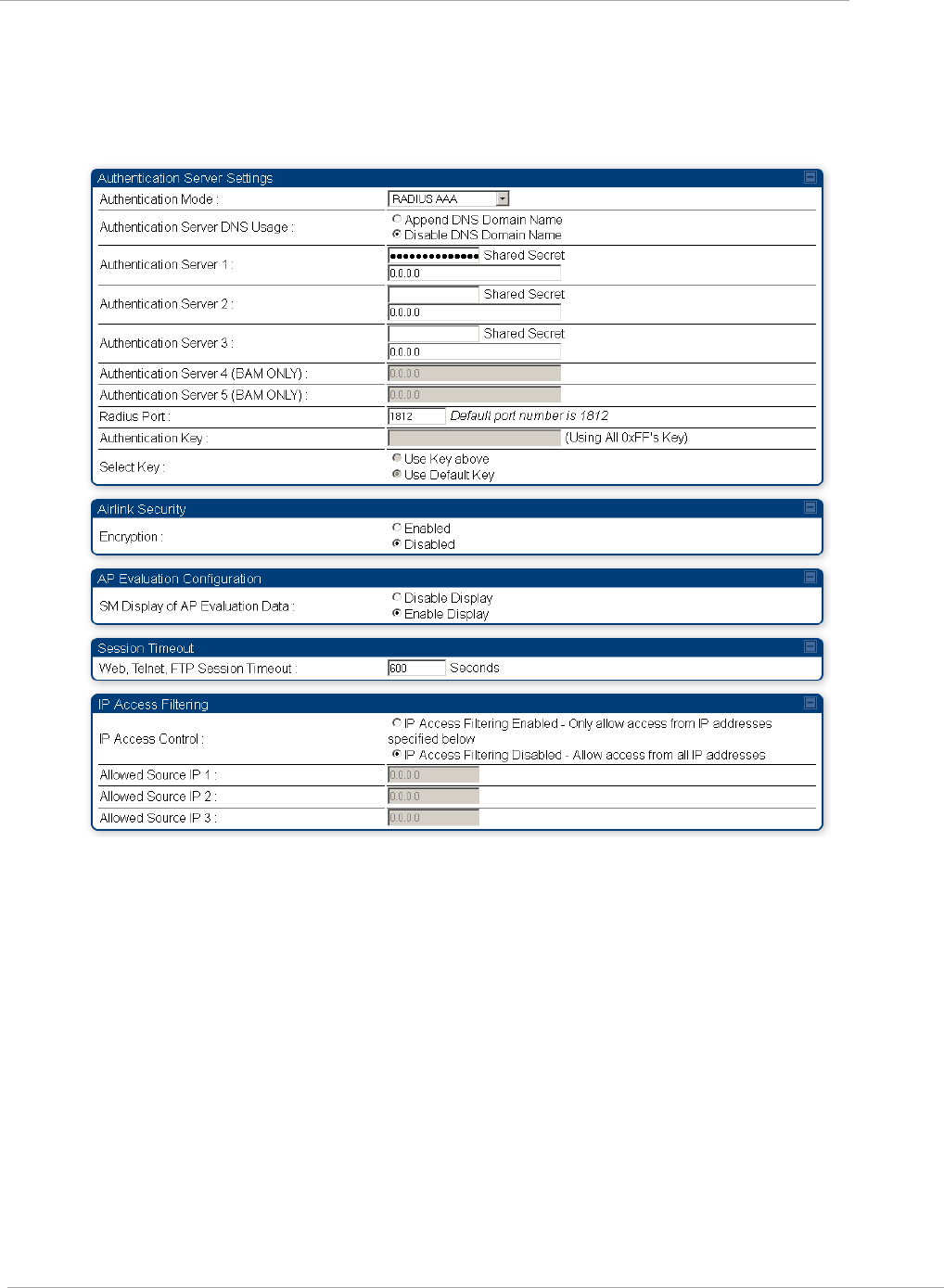
PMP 450 Configuration and User Guide
Task 5: Configuring security
pmp-0050 (May 2012)
2-67
Security Tab of the AP
Figure 13 Security tab of the AP
In the Security tab of the AP, you may set the following parameters.

Task 5: Configuring security
Chapter 2: Configuration and alignment
2-68
pmp-0050 (May 2012)
Table 28 AP Security attributes
Attribute
Meaning
Authentication Mode
If the AP has authentication capability, then you can use this field to
select from among the following authentication modes:
Disabled—the AP requires no SMs to authenticate.
Authentication Server —the AP requires any SM that attempts
registration to be authenticated in BAM or Prizm before registration.
AP PreShared Key - The AP acts as the authentication server to its SMs
and will make use of a user-configurable pre-shared authentication key.
The operator enters this key on both the AP and all SMs desired to
register to that AP. There is also an option of leaving the AP and SMs at
their default setting of using the ―Default Key‖. Due to the nature of the
authentication operation, if you want to set a specific authentication key,
then you MUST configure the key on all of the SMs and reboot them
BEFORE enabling the key and option on the AP. Otherwise, if you
configure the AP first, none of the SMs will be able to register.
RADIUS AAA - When RADIUS AAA is selected, up to 3 Authentication
Server (RADIUS Server) IP addresses and Shared Secrets can be
configured. The IP address(es) configured here must match the IP
address(es) of the RADIUS server(s). The shared secret(s) configured
here must match the shared secret(s) configured in the RADIUS
server(s). Servers 2 and 3 are meant for backup and reliability, not for
splitting the database. If Server 1 doesn‘t respond, Server 2 is tried, and
then server 3. If Server 1 rejects authentication, the SM is denied entry
to the network, and does not progress trying the other servers.
Authentication Server DNS
Usage
The management DNS domain name may be toggled such that the name
of the authentication server only needs to be specified and the DNS
domain name is automatically appended to that name.
Authentication Server 1 to 5
Enter the IP address of the authentication server (RADIUS, Prizm, or
BAM) and the Shared Secret configured in the authentication server.
When Authentication Mode RADIUS AAA is selected, the default value of
Shared Secret is ―CanopySharedSecret‖. The Shared Secret may consist of
up to 32 ASCII characters.
Radius Port
This field allows the operator to configure a custom port for RADIUS
server communication. The default value is 1812.
Authentication Key
The authentication key is a 32-character hexadecimal string used when
Authentication Mode is set to AP PreShared Key. By default, this key is
set to 0xFFFFFFFFFFFFFFFFFFFFFFFFFFFFFFFF.

PMP 450 Configuration and User Guide
Task 5: Configuring security
pmp-0050 (May 2012)
2-69
Attribute
Meaning
Select Key
This option allows operators to choose which authentication key is used:
Use Key above means that the key specified in Authentication Key is used
for authentication
Use Default Key means that a default key (based off of the SM‘s MAC
address) will be used for authentication
Encryption
Specify the type of airlink security to apply to this AP:
Encryption Disabled provides no encryption on the air link. This is the
default mode.
Encryption Enabled provides encryption, using a factory-programmed
secret key that is unique for each module.
Encrypt Downlink Broadcast
When Encryption Enabled is selected in the Airlink Security parameter
(described above) and Enable is selected in the Encrypt Downlink
Broadcast parameter, the AP encrypts downlink broadcast packets as
DES where the AP is DES capable.
AES where the AP is AES capable.
SM Display of AP Evaluation
Data
You can use this field to suppress the display of data about this AP on the
AP Evaluation tab of the Tools page in all SMs that register.
Web, Telnet, FTP Session
Timeout
Enter the expiry in seconds for remote management sessions via HTTP,
telnet, or ftp access to the AP.
IP Access Control
You can permit access to the AP from any IP address (IP Access Filtering
Disabled) or limit it to access from only one, two, or three IP addresses
that you specify (IP Access Filtering Enabled). If you select IP Access
Filtering Enabled, then you must populate at least one of the three
Allowed Source IP parameters or have no access permitted from any IP
address, including access and management by Prizm.
Allowed Source IP 1 to 3
If you selected IP Access Filtering Enabled for the IP Access Control
parameter, then you must populate at least one of the three Allowed
Source IP parameters or have no access permitted to the AP from any IP
address. You may populate as many as all three.
If you selected IP Access Filtering Disabled for the IP Access Control
parameter, then no entries in this parameter are read, and access from all
IP addresses is permitted.
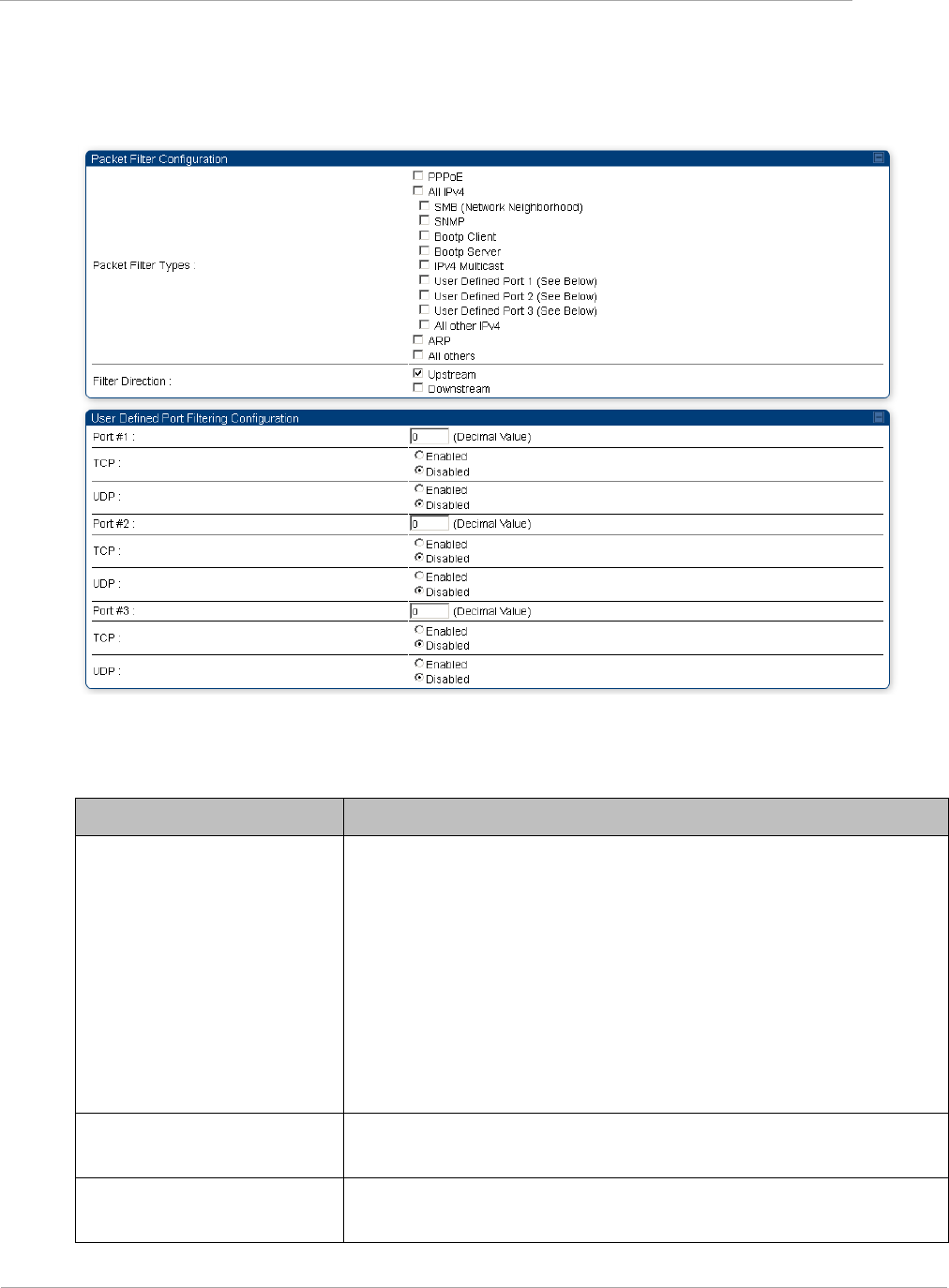
Task 5: Configuring security
Chapter 2: Configuration and alignment
2-70
pmp-0050 (May 2012)
Protocol Filtering tab of the AP
Table 29 Protocol Filtering tab of the AP
In the Protocol Filtering tab of the AP, you may set the following parameters.
Table 30 AP Protocol Filtering attributes
Attribute
Meaning
Packet Filter Types
For any box selected, the Protocol and Port Filtering feature blocks the
associated protocol type.
To filter packets in any of the user-defined ports, you must do all of the
following:
Check the box for User Defined Port n (See Below) in the Packet Filter
Types section of this tab.
In the User Defined Port Filtering Configuration section of this tab, both
provide a port number at Port #n.
check TCP, UDP, or both.
Filter Direction
Operators may choose to filter upstream (uplink) RF packets or
downstream (downlink) RF packets.
User Defined Port Filtering
Configuration
You can specify ports for which to block subscriber access, regardless of
whether NAT is enabled.
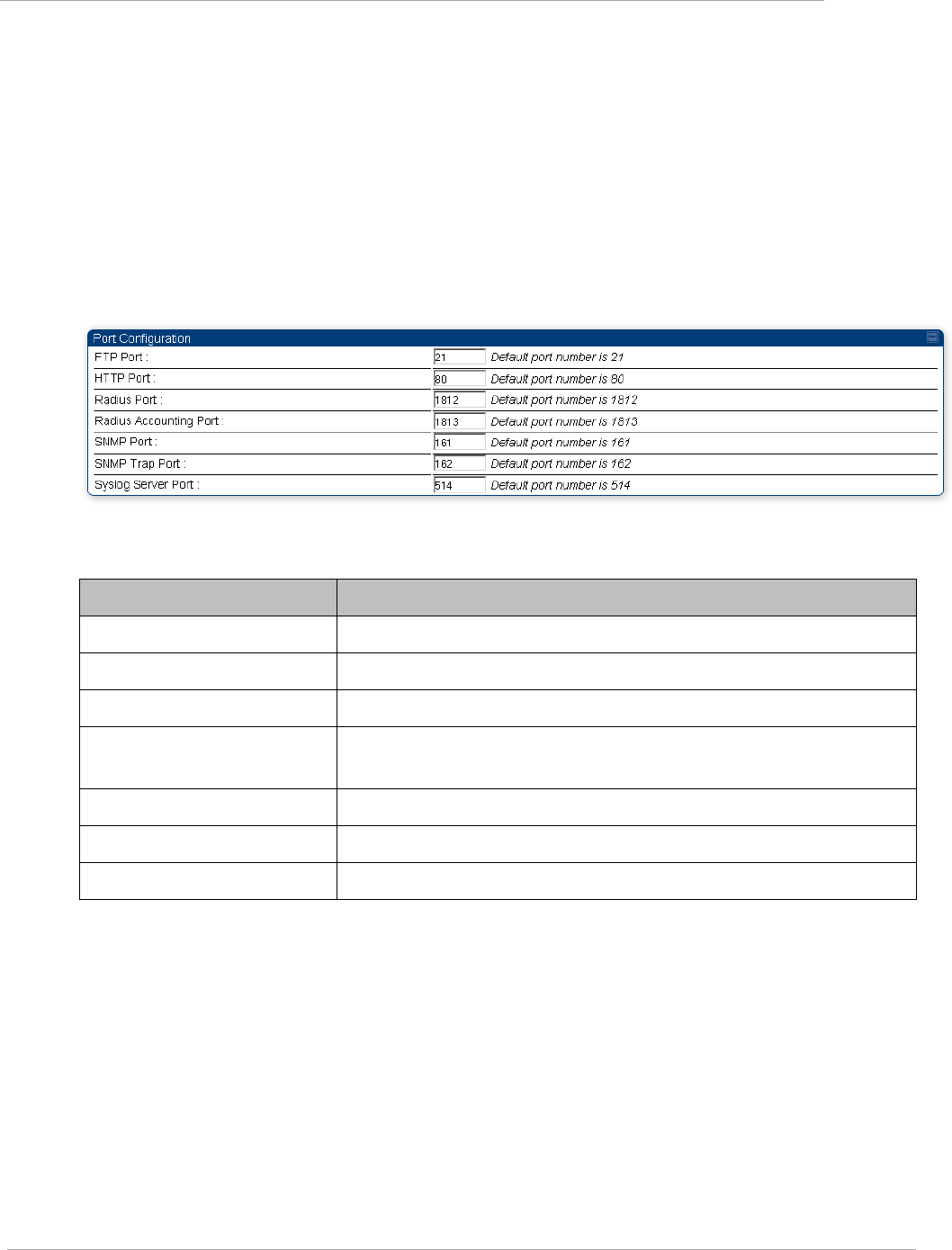
PMP 450 Configuration and User Guide
Task 5: Configuring security
pmp-0050 (May 2012)
2-71
Port configuration tab of the AP
PMP 450 devices support access to various communication protocols and only the ports required for these
protocols are available for access by external entities. Operators may change the port numbers for these
protocols via the radio GUI or SNMP.
Table 31 Port configuration tab of the AP
In the Port Configuration tab of the AP, you may set the following parameters.
Table 32 AP Port Configuration attributes
Attribute
Meaning
FTP Port
The listen port on the device used for FTP communication.
HTTP Port
The listen port on the device used for HTTP communication.
Radius Port
The destination port used by the device for RADIUS communication.
Radius Accounting Port
The destination port used by the device for RADIUS accounting
communication.
SNMP Port
The listen port on the device used for SNMP communication.
SNMP Trap Port
The destination port used by the device to which SNMP traps are sent.
Syslog Server Port
The destination port used by the device to which Syslog messaging is sent.
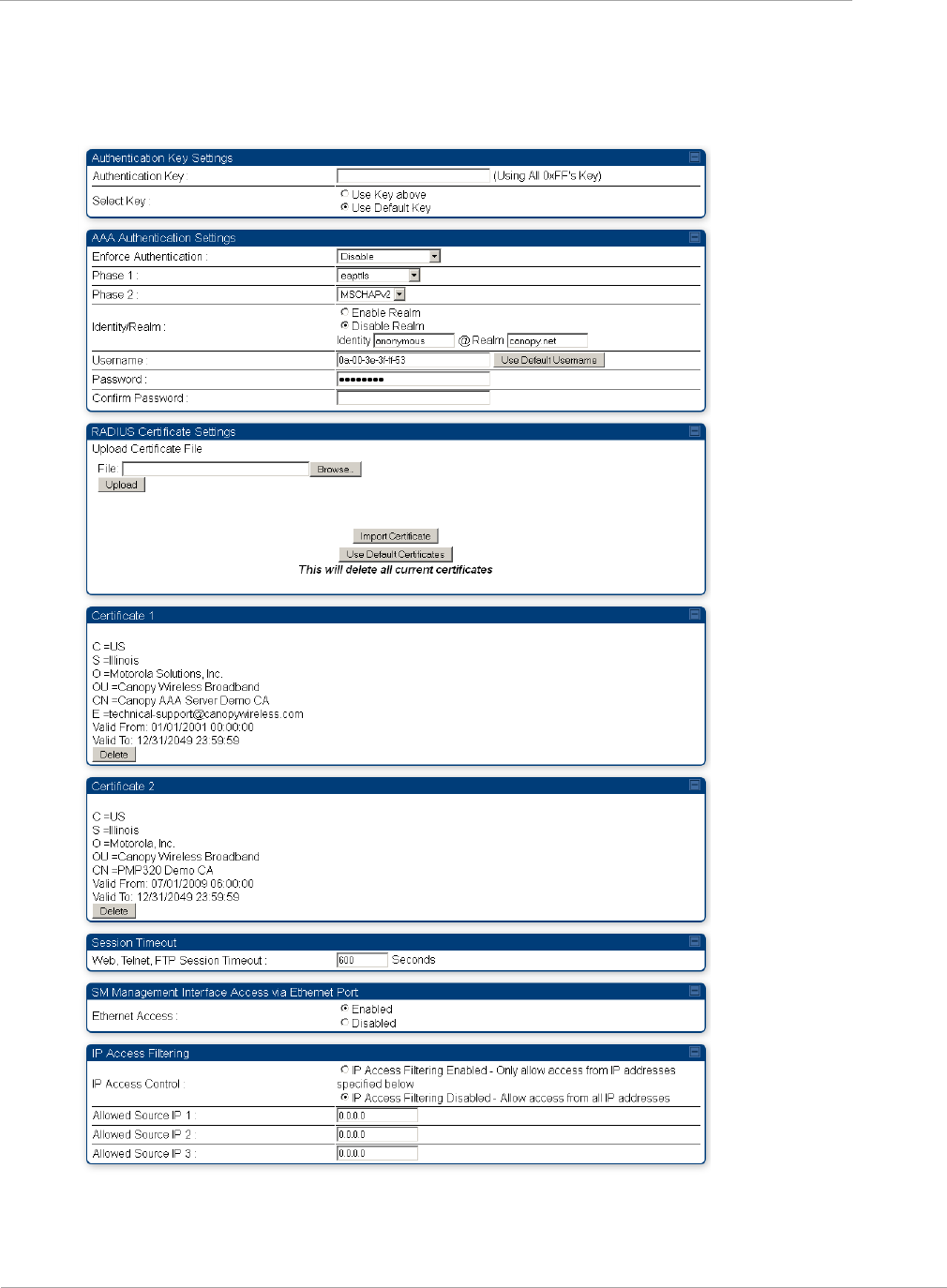
Task 5: Configuring security
Chapter 2: Configuration and alignment
2-72
pmp-0050 (May 2012)
Security Tab of the SM
Table 33 Security tab of the SM
In the Security tab of the SM, you may set the following parameters.

PMP 450 Configuration and User Guide
Task 5: Configuring security
pmp-0050 (May 2012)
2-73
Table 34 AP Security attributes
Attribute
Meaning
Authentication Key
Only if the AP to which this SM will register requires authentication,
specify the key that the SM should use when authenticating. For alpha
characters in this hex key, use only upper case.
Select Key
The Use Default Key selection specifies the predetermined key for
authentication in BAM or Prizm.
The Use Key above selection specifies the 32-digit hexadecimal key that is
permanently stored on both the SM and the BAM or Prizm database.
The SM and BAM or Prizm pad the key of any length by the addition
of leading zeroes, and if the entered keys match, authentication
attempts succeed. However, Motorola recommends that you enter 32
characters to achieve the maximal security from this feature.
Enforce Authentication
The SM may enforce authentication types of AAA and
BAM/PreSharedKey. The SM will not finish the registration process if the
AP is not using the configured authentication method (and the SM will
lockout the AP for 15 minutes).
Phase 1
The protocols supported for the Phase 1 (Outside Identity) phase of
authentication are
EAPTTLS (Extensible Authentication Protocol
Tunneled Transport Layer
Security) or MSCHAPv2 (Microsoft
Challenge-Handshake Authentication Protocol version 2).
Phase 2
Select the desired Phase 2 (Inside Identity) authentication protocol from
the Phase 2 options of PAP (Password Authentication Protocol), CHAP
(Challenge Handshake
Authentication
Protocol), and MSCHAP
(Microsoft‘s version of CHAP, version 2 is used). The protocol
must
be
consistent with the authentication protocol configured on the RADIUS
server.

Task 5: Configuring security
Chapter 2: Configuration and alignment
2-74
pmp-0050 (May 2012)
Attribute
Meaning
Identity/Realm
If Realms are being used, select Enable Realm and configure an outer
identity in the
Identity
field and a Realm in the Realm field. These must
match the Phase 1/Outer Identity and
Realm
configured in the
RADIUS server. The default Identity is ―anonymous‖. The Identity can
be
up
to
128 non-special (no diacritical markings) alphanumeric
characters. The default Realm
is
―canopy.net‖. The Realm can also be
up to 128 non-special alphanumeric
characters.
Configure an outer Identity in the Username field. This must match the
Phase
1/Outer
Identity username configured in the RADIUS server. The
default Phase 1/Outer
Identity
Username is ―anonymous‖. The
Username can be up to 128 non-special (no
diacritical
markings)
alphanumeric
characters.
Username
Enter a Username for the SM. This must match the username configured
for the SM on
the
RADIUS server. The default Username is the SM‘s
MAC address. The Username can be up
to
128 non-special (no diacritical
markings) alphanumeric
characters.
Password
Enter the desired password for the SM in the Password and Confirm
Password fields..
The
Password must match the password configured for
the SM on the RADIUS server.
The
default Password is ―password‖. The
Password can be up to 128 non-special (no
diacritical
markings)
alphanumeric
characters
Upload Certificate File
To upload a certificate manually to an SM, first load it in a known place
on your PC
or
network
drive, then click on a Delete button on one of the
Certificate description blocks to delete a certificate to provide space for
your certificate. Click on Choose File, browse to
the
location of the
certificate, and click the Import Certificate button, and then reboot the
radio to use the new certificate.
When a certificate is in use, after the SM successfully registers to an AP,
an indication of In
Use
will appear in the description block of the
certificate being
used.
The public certificates installed on the SMs are used with the private
certificate on the
RADIUS
server to provide a public/private key
encryption
system.
Up to 2 certificates can be resident on an SM. An installed certificate can
be deleted
by
clicking the Delete button in the certificate‘s description
block on the Configuration >
Security
tab. To restore fhe 2 default
certificates, click the Use Default Certificates button in
the
RADIUS
Certificate Settings parameter block and reboot the
radio.
Web, Telnet, FTP Session
Timeout
Enter the expiry in seconds for remote management sessions via HTTP,
telnet, or FTP access to the SM.
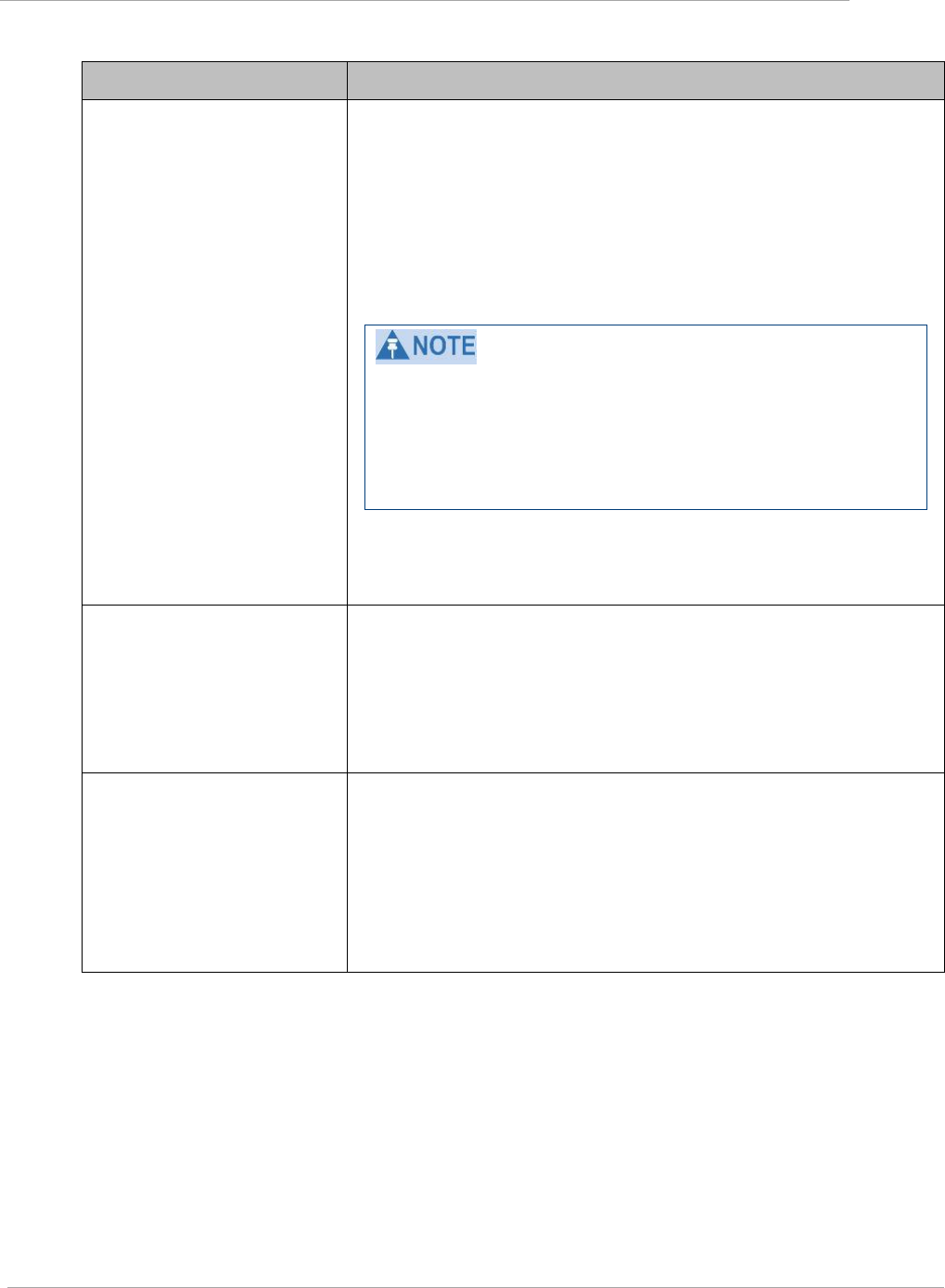
PMP 450 Configuration and User Guide
Task 5: Configuring security
pmp-0050 (May 2012)
2-75
Attribute
Meaning
Ethernet Access Control
If you want to prevent any device that is connected to the Ethernet port
of the SM from accessing the management interface of the SM, select
Ethernet Access Disabled. This selection disables access through this port
to via http (the GUI), SNMP, telnet, ftp, and tftp. With this selection,
management access is available through only the RF interface via either
an IP address (if Network Accessibility is set to Public on the SM) or the
Session Status or Remote Subscribers tab of the AP.
This setting does not prevent a device connected to the Ethernet port
from accessing the management interface of other SMs in the
network. To prevent this, use the IP Access Filtering Enabled
selection in the IP Access Control parameter of the SMs in the
network. See IP Access Control below.
If you want to allow management access through the Ethernet port, select
Ethernet Access Enabled. This is the factory default setting for this
parameter.
IP Access Control
You can permit access to the SM from any IP address (IP Access Filtering
Disabled) or limit it to access from only one, two, or three IP addresses
that you specify (IP Access Filtering Enabled). If you select IP Access
Filtering Enabled, then you must populate at least one of the three
Allowed Source IP parameters or have no access permitted from any IP
address, including access and management by Prizm.
Allowed Source IP 1 to 3
If you selected IP Access Filtering Enabled for the IP Access Control
parameter, then you must populate at least one of the three Allowed
Source IP parameters or have no access permitted to the SM from any IP
address. You may populate as many as all three.
If you selected IP Access Filtering Disabled for the IP Access Control
parameter, then no entries in this parameter are read, and access from all
IP addresses is permitted.
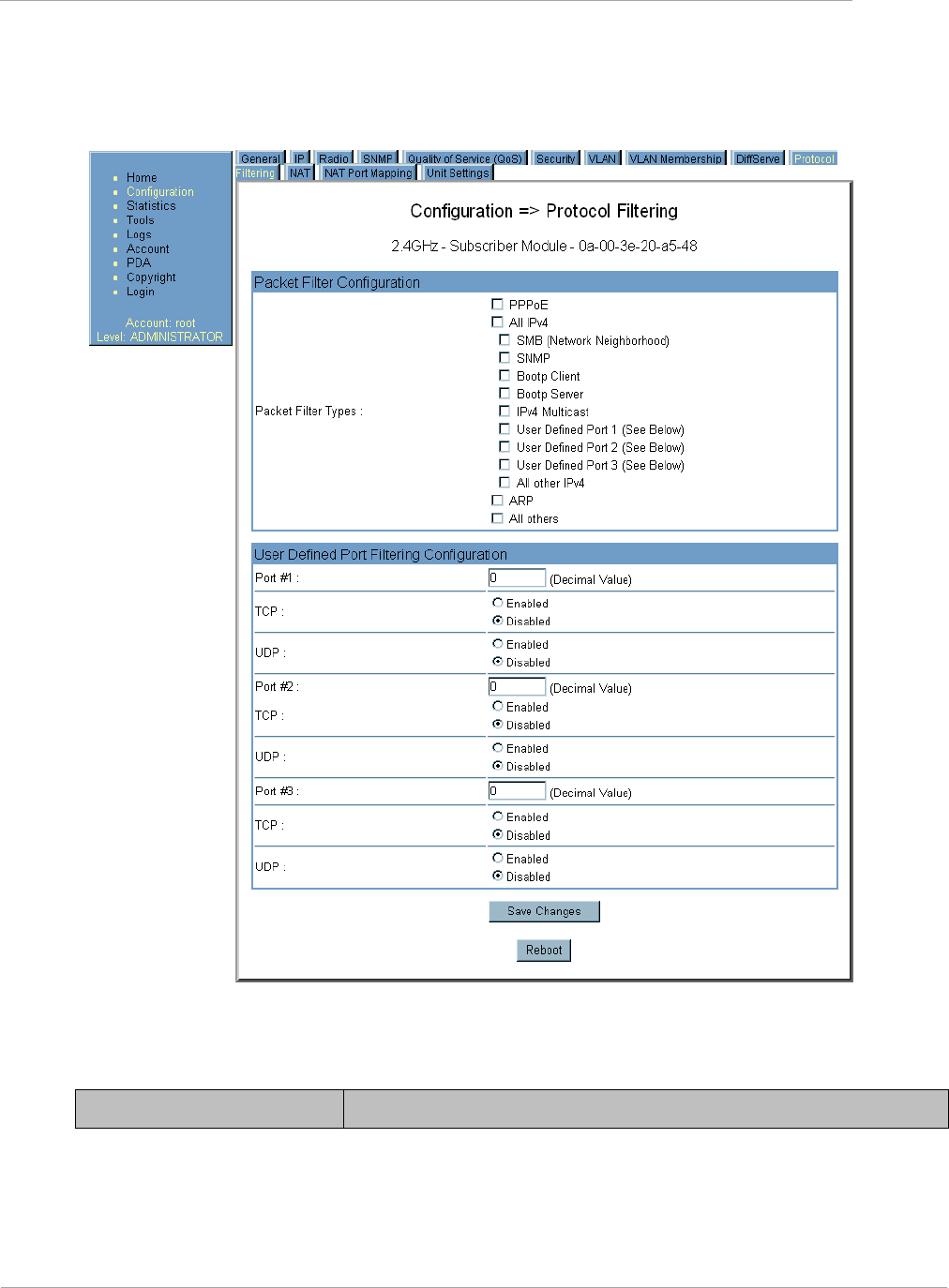
Task 5: Configuring security
Chapter 2: Configuration and alignment
2-76
pmp-0050 (May 2012)
Protocol Filtering Tab of the SM
Table 35 Protocol Filtering tab of the SM
In the Protocol Filtering tab of the SM, you may set the following parameters.
Table 36 AP Protocol Filtering attributes
Attribute
Meaning

PMP 450 Configuration and User Guide
Task 5: Configuring security
pmp-0050 (May 2012)
2-77
Attribute
Meaning
Packet Filter Types
For any box selected, the Protocol and Port Filtering feature blocks the
associated protocol type.
To filter packets in any of the user-defined ports, you must do all of the
following:
Check the box for User Defined Port n (See Below) in the Packet Filter
Types section of this tab.
In the User Defined Port Filtering Configuration section of this tab, both
provide a port number at Port #n.
check TCP, UDP, or both.
If the DHCP state parameter is set to Enabled in the Configuration => IP
tab of the SM, do not check the Bootp Client option for Packet Filter Types
in its Protocol Filtering tab, because doing so would block the DHCP
request. (Filters apply to all packets that leave the SM via its RF
interface, including those that the SM itself generates.) If you want to
keep DHCP enabled and avoid the blocking scenario, select the Bootp
Server option instead. This will result in responses being appropriately
filtered and discarded.
User Defined Port Filtering
Configuration
You can specify ports for which to block subscriber access, regardless of
whether NAT is enabled.
Port configuration tab of the SM
PMP 450 devices support access to various communication protocols and only the ports required for these
protocols are available for access by external entities. Operators may change the port numbers for these
protocols via the radio GUI or SNMP.
.
Figure 14 Port Configuration tab of the SM
In the Port Configuration tab of the SM, you may set the following parameters.

Task 5: Configuring security
Chapter 2: Configuration and alignment
2-78
pmp-0050 (May 2012)
Table 37 SM Port Configuration attributes
Attribute
Meaning
FTP Port
The listen port on the device used for FTP communication.
HTTP Port
The listen port on the device used for HTTP communication.
SNMP Port
The listen port on the device used for SNMP communication.
SNMP Trap Port
The destination port used on the device to which SNMP traps are sent.
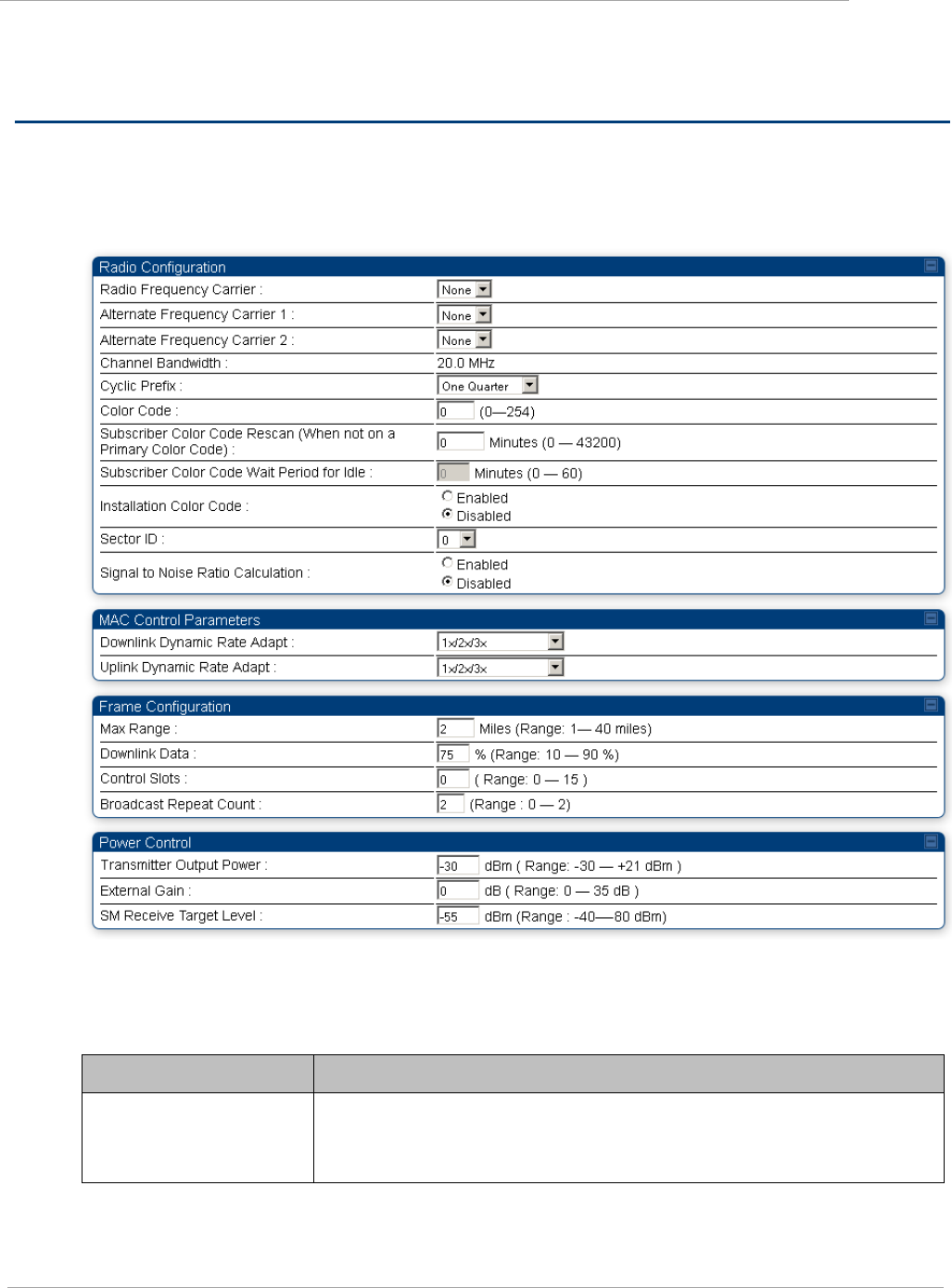
PMP 450 Configuration and User Guide
Task 6: Configuring radio parameters
pmp-0050 (May 2012)
2-79
Task 6: Configuring radio parameters
Radio tab of the AP
Figure 15 Radio tab of the AP
The Radio tab of the AP contains some of the configurable parameters that define how the AP operates.
Table 38 AP Radio attributes
Attribute
Meaning
Radio Frequency Carrier
Specify the frequency for the module to transmit. The default for this
parameter is None. For a list of channels in the band, see the drop-down list
on the radio GUI.

Task 6: Configuring radio parameters
Chapter 2: Configuration and alignment
2-80
pmp-0050 (May 2012)
Attribute
Meaning
Alternate Frequency
Carrier 1
If your network operates in a region in which DFS shutdown capability is
required, and you do not see this parameter, perform the following steps:
1. Click the General tab.
2. Set the Region Code parameter from its drop-down list.
3. Click the Save Changes button.
4. Click the Reboot button.
5. Click the Radio tab.
From the drop-down list, select the frequency that the AP should switch to if
it detects a radar signature on the frequency configured in the Radio
Frequency Carrier parameter.
Alternate Frequency
Carrier 2
From the drop-down list, select the frequency that the AP should switch to if
it detects a radar signature on the frequency configured in the Alternate
Frequency Carrier 1 parameter.

PMP 450 Configuration and User Guide
Task 6: Configuring radio parameters
pmp-0050 (May 2012)
2-81
Attribute
Meaning
Cyclic Prefix
OFDM technology uses a cyclic prefix, where a portion of the end of a symbol
(slot) is repeated at the beginning of the symbol to allow multi-pathing to
settle before receiving the desired data. A 1/4 cyclic prefix means that for
every 4 bits of throughput data transmitted, an additional bit is used. A 1/8
cyclic prefix means that for every 8 bits of throughput data transmitted, an
additional bit is used, and a 1/16 cyclic prefix means that for every 16 bits of
throughput data transmitted, an additional bit is used.
PMP 450 radios use a default cyclic prefix of 1/4 that is configurable by the
operator to 1/8 or 1/16. The cyclic prefix is set on the Configuration > Radio
page of the AP. Changing the default from 1/4 to 1/8 can increase throughput
by ~12% (assuming a 75% duty cycle ) in installations with low multipath
conditions. Moving from a 1/8 cyclic prefix to a 1/16 cyclic prefix can increase
throughput by another ~12%. It is recommended to test 1/8 or 1/16 cyclic
prefix configurations to determine actual performance based on RF
conditions. Deploying networks using 1/8 or 1/16 cyclic prefixes is feasible in
all but the worst multi-path environments (urban areas with buildings causing
many reflections).
During installation use Link Tests to confirm link quality per standard
installation and alignment procedures. If a Link Test shows low throughput
or low efficiency, consider changing the Cyclic Prefix to 1/4 on both the AP and
SM along with other standard installation troubleshooting procedures such as
re-aiming, off-axis aiming, changing location, raising or lowing the height of
the radio, adjusting the Transmission Power up or down, or identifying and
mitigating sources of interference.
The cyclic prefix must be set the same on both the AP and the SM. If
they don‘t match, the SM will not register to the AP.
Color Code
Specify a value from 0 to 254. For registration to occur, the color code of the
SM and the AP must match. Color code is not a security feature. Instead, color
code is a management feature, typically for assigning each sector a different
color code.
Color code allows you to force an SM to register to only a specific AP, even
where the SM can communicate with multiple APs. The default setting for the
color code value is 0. This value matches only the color code of 0 (not all 255
color codes).

Task 6: Configuring radio parameters
Chapter 2: Configuration and alignment
2-82
pmp-0050 (May 2012)
Attribute
Meaning
Subscriber Color Code
Rescan (When not on a
Primary Color Code)
This timer may be utilized to initiate SM rescans in order to register to an AP
configured with the SM‘s primary color code.
The time (in minutes) for a subscriber to rescan (if this AP is not configured
with the SM‘s primary color code). This timer will only fire once – if the
Subscriber Color Code Wait Period for Idle timer is configured with a nonzero
value and the Subscriber Color Code Rescan expires, the Subscriber Color Code
Wait Period for Idle will be started. If the Subscriber Color Code Wait Period
for Idle timer is configured with a zero value and the Subscriber Color Code
Rescan timer expires, the SM will immediately go into rescan mode
Subscriber Color Code
Wait Period for Idle
The time (in minutes) for a subscriber to rescan while idle (if this AP is not
configured with the SM‘s primary color code). This timer will fire periodic
events. The fired event determines if any RF unicast traffic (either inbound or
outbound) has occurred since the last event. If the results of the event
determine that no RF unicast traffic has occurred (SM is idle), then the
subscriber will rescan.
Installation Color Code
With this feature enabled on the AP and SM, operators may install and
remotely configure SMs without having to configure matching color codes
between the modules. While the SM is accessible for configuration from above
the AP (for remote provisioning) and below the SM (for local site
provisioning), no user data is passed over the radio link. SMs with Installation
Color Code enabled will first try any configured Color Code values first, then
will use the Installation Color Code feature as a last result to connect to the
AP. The status of the Installation Color Code can be viewed on the AP Eval
web GUI page, and when the SM is registered using the Installation Color
Code the message ―SM is registered via ICC – Bridging Disabled!‖ is displayed
in red on every SM GUI page. The Installation Color Code parameter is
configurable without a radio reboot for both the AP and SM. If an SM is
registered via Installation Color Code and the feature is then disabled,
operators will need to reboot the SM or force it to reregister (i.e. using the
Rescan APs functionality on the AP Eval page).
Power Save Mode
Select either
Enabled (the default), to reduce module power consumption by approximately
10% without affecting the transmitter output power. This is the recommended
setting.
Disabled, to continue normal power consumption, but do so only under
guidance from technical support.
Sector ID
Specify a number in the range 1 to 6 to associate with this AP. The Sector ID
setting does not affect the operation of the AP. On the AP Evaluation tab of
the Tools page in the SM, the Sector ID field identifies the AP that the SM
sees. The following steps may be useful:
1. Assign a unique Sector ID to each sector in an AP cluster.
2. Repeat the assignment pattern throughout the entire system.

PMP 450 Configuration and User Guide
Task 6: Configuring radio parameters
pmp-0050 (May 2012)
2-83
Attribute
Meaning
Signal to Noise Ratio
Calculation
Enabling this parameter allows operators to use Signal-to-Noise calculations
to monitor link quality.
The Signal-to-Noise Ratio may be monitored on the AP‘s Session Status page,
Link Capacity Test page, and Link Status page.
See the table below for required Signal-to-Noise Ratios required for each
modulation state:
Modulation
Downlink
Uplink
1X
7 dB
9 dB
2X
15 dB
16 dB
3X
23 dB
24 dB
Note that locking a radio a lower modulation may result in a lower SNR ratio
reading that a higher modulation. For example an AP/SM pair that is getting
a SNR of 23/29 dB for downlink/uplink when modulation is set to 1X/2X/3X
gets 22/27 dB for a setting of 1X/2X. And when set to 1X (No rate adapt) the
SNR reads 12/18 dB. For highest SNR calculation the rate adapt must be set
to its highest rate adapt modulation.
Max Range
Enter a number of miles (or kilometers divided by 1.61, then rounded to an
integer) for the furthest distance from which an SM is allowed to register to
this AP. Do not set the distance to any greater number of miles. A greater
distance
does not increase the power of transmission from the AP.
can reduce aggregate throughput.
Regardless of this distance, the SM must meet the minimum requirements for
an acceptable link. If the AP is in cluster, then you must set this parameter on
all other APs in the cluster exactly the same, except as described in the NOTE
admonition below. The default value of this parameter is 2 miles (3.2 km).
For the PMP 450 Series AP, the typical maximum range achievable depends
on the operation mode as follows:
5 miles (8 km) in 1X operation
2.5 miles (4 km) in 2X operation
1.25 miles (2 km) in 3X operation
A value of 15 for this parameter decreases the number of available data slots
by 1. With a higher value, the number is further decreased as the AP
compensates for the expected additional air delay.

Task 6: Configuring radio parameters
Chapter 2: Configuration and alignment
2-84
pmp-0050 (May 2012)
Attribute
Meaning
Downlink Data
Specify the percentage of the aggregate throughput for the downlink (frames
transmitted from the AP to the subscriber). For example, if the aggregate
(uplink and downlink total) throughput on the AP is 6 Mb, then 75% specified
for this parameter allocates 4.5 Mb for the downlink and 1.5 Mb for the uplink.
The default for this parameter is 75%.
You must set this parameter exactly the same for all APs in a cluster.
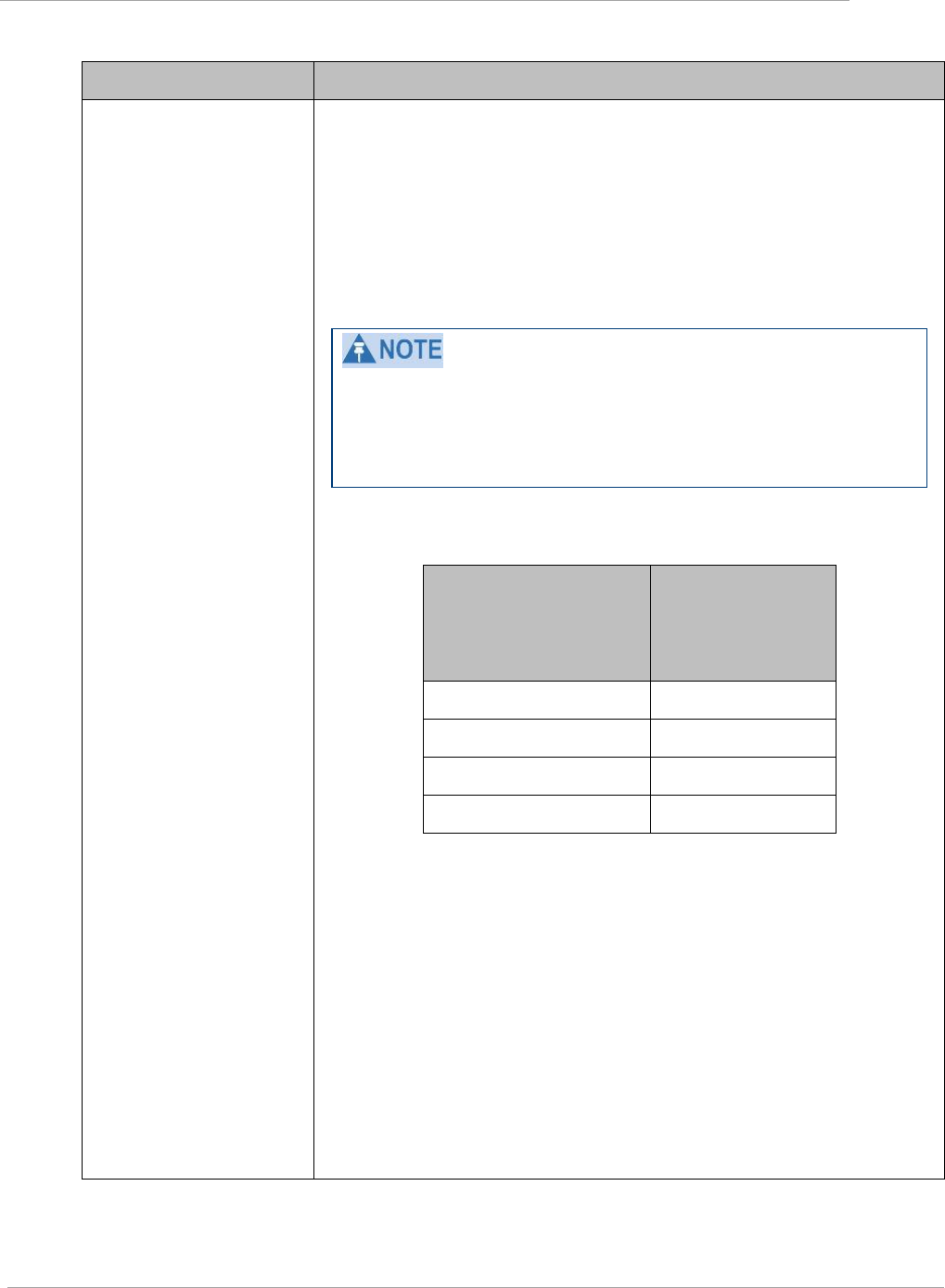
PMP 450 Configuration and User Guide
Task 6: Configuring radio parameters
pmp-0050 (May 2012)
2-85
Attribute
Meaning
Control Slots
Field results have indicated that, in general, systems perform better with a
slightly higher number of control slots than previously recommended. If you
are experiencing latency or SM-servicing issues, increasing the number of
control slots may increase system performance, depending on traffic mix over
time.
Use care when changing the control slot configuration of only some APs,
because changes affect the uplink/downlink ratio and can cause collocation
issues.
Change control slot configuration in an operating, stable system
cautiously and with a back-out plan. After changing a control slot
configuration, monitor the system closely for problems as well as
improvements in system performance..
Table 39: Control slot settings for all OFDM APs in cluster
Number of SMs that
Register to the AP
Number of
Control
Slots
Recommended
1 to 10
2
11 to 50
4
51 to 150
6
151 to 200
8
This field indicates the number of (reserved) control slots configured by the
operator. Control slots are half the size of data slots. The SM uses reserved
control slots and unused data slots for bandwidth requests.
If too few reserved control slots are specified, then latency increases in high
traffic periods. If too many are specified, then the maximum capacity is
unnecessarily reduced.
In a typical cluster, each AP should be set to the same number of control slots
to assure proper timing in the send and receive cycles. However, where high
incidence of small packets exists, as in a sector that serves several VoIP
streams, additional control slots may provide better results. For APs in a
cluster of mismatched control slots settings, or where OFDM and FSK APs of
the same frequency band are collocated, use the frame calculator.

Task 6: Configuring radio parameters
Chapter 2: Configuration and alignment
2-86
pmp-0050 (May 2012)
Attribute
Meaning
Broadcast Repeat Count
The default is 2 repeats (in addition to the original broadcast packet, for a
total of 3 packets sent for every one needed), and is settable to 1 or 0 repeats (2
or 1 packets for every broadcast).
ARQ (Automatic Repeat reQuest) is not present in downlink broadcast
packets, since it would cause unnecessary uplink traffic from every SM for
each broadcast packet. For successful transport without ARQ, the AP repeats
downlink broadcast packets. The SMs filter out all repeated broadcast packets
and, thus, do not transport further.
The default of 2 repeats is optimum for typical uses of the network as an
internet access system. In applications with heavy download broadcast such as
video distribution, overall throughput is significantly improved by setting the
repeat count to 1 or 0. This avoids flooding the downlink with repeat
broadcast packets.
Transmitter Output Power
Nations and regions may regulate transmitter output power. For example
5.7-GHz modules are available as connectorized radios, which require the
operator to adjust power to ensure regulatory compliance.
The professional installer of the equipment has the responsibility to
maintain awareness of applicable regulations.
calculate the permissible transmitter output power for the module.
confirm that the initial power setting is compliant with national or
regional regulations.
confirm that the power setting is compliant following any reset of the
module to factory defaults.
External Gain
This value represents the amount of gain introduced by an external antenna.
If your network operates in a region in which DFS shutdown capability is
required, and you do not see this parameter, perform the following steps:
1. Click the General tab.
2. Set the Region Code parameter from its drop-down list.
3. Click the Save Changes button.
4. Click the Reboot button.
5. Click the Radio tab.
Module Type
Recommended
Setting
OFDM connectorized with antenna
that was purchased with it
17

PMP 450 Configuration and User Guide
Task 6: Configuring radio parameters
pmp-0050 (May 2012)
2-87
Attribute
Meaning
SM Receive Target Level
Each SM‘s Transmitter Output Power is automatically set by the AP. The AP
monitors the received power from each SM, and adjusts each SM‘s Transmitter
Output Power so that the received power at the AP from that SM is not
greater what is set in this field.
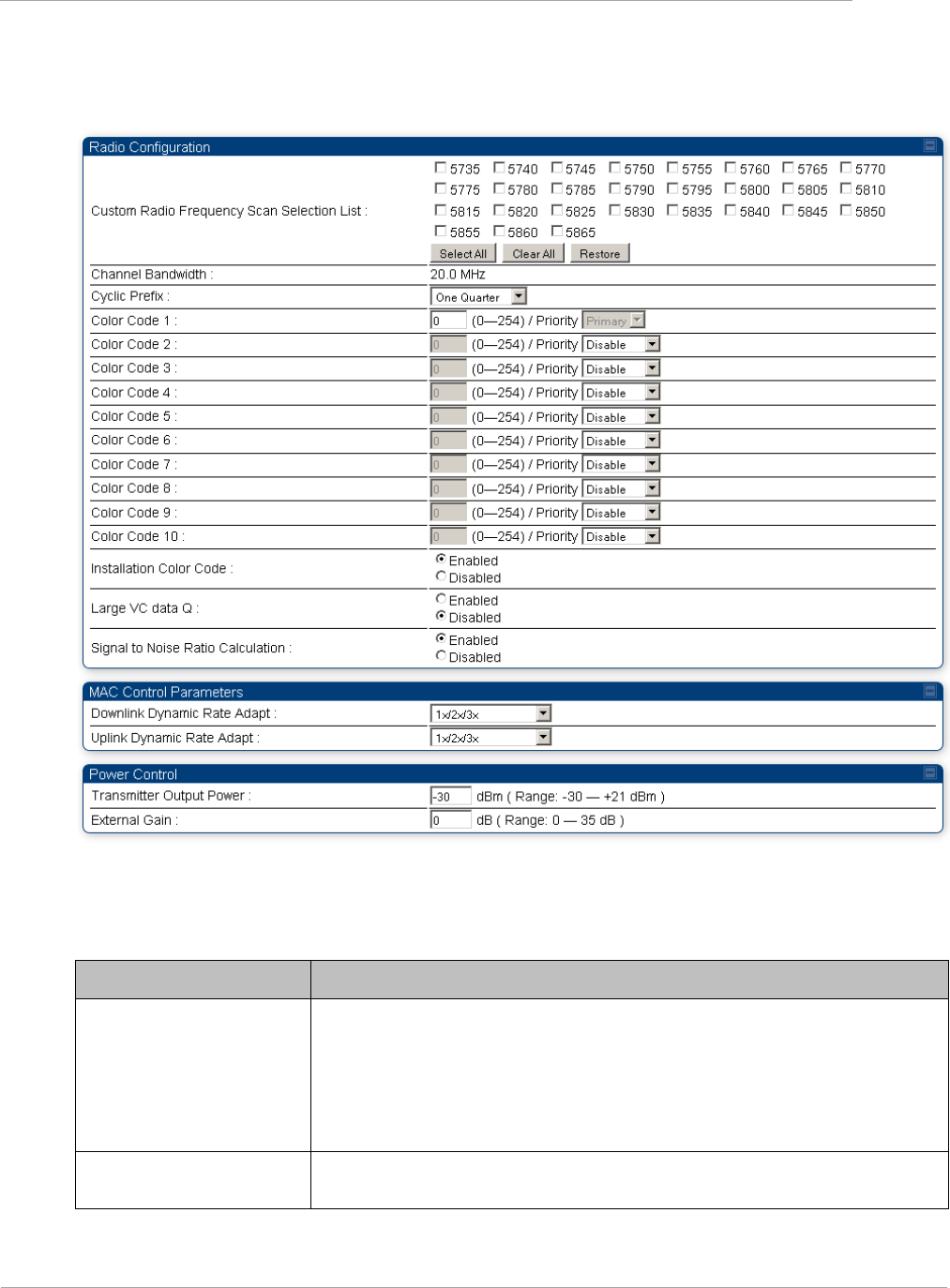
Task 6: Configuring radio parameters
Chapter 2: Configuration and alignment
2-88
pmp-0050 (May 2012)
Radio tab of the SM
Table 40 Radio tab of SM
In the Radio tab of the SM, you may set the following parameters.
Table 41 SM Radio attributes
Attribute
Meaning
Custom Radio Frequency
Scan Selection List
Check any frequency that you want the SM to scan for AP transmissions. The
frequency band of the SM affects what channels you should select.
In a 5.7-GHz SM, this parameter displays both ISM and U-NII frequencies. If
you select all frequencies that are listed in this field (default selections), then
the SM scans for a signal on any channel. If you select only one, then the SM
limits the scan to that channel.
Channel Bandwidth
The channel size used by the radio for RF transmission. This parameter is
dictated by the AP‘s settings.

PMP 450 Configuration and User Guide
Task 6: Configuring radio parameters
pmp-0050 (May 2012)
2-89
Attribute
Meaning
Color Code 1 to 10
Color code allows you to force the SM to register to only a specific AP, even
where the SM can communicate with multiple APs. For registration to occur,
the color code of the SM and the AP must match. Specify a value from 0 to
254.
Color code is not a security feature. Instead, color code is a management
feature, typically for assigning each sector a different color code. The default
setting for the color code value is 0. This value matches only the color code
of 0 (not all 255 color codes).
SMs may be configured with up to 10 color codes. These color codes can be
tagged as Primary, Secondary, or Tertiary, or Disable. When the SM is
scanning for APs, it will first attempt to register to an AP that matches one of
the SM‘s primary color codes. Failing that, the SM will continue scanning and
attempt to register to an AP that matches one of the SM‘s secondary color
codes. Failing that, the SM will continue scanning and attempt to register to
an AP that matches one of the SM‘s tertiary color codes. This is all done in
the scanning mode of the SM and will repeat until a registration has occurred.
Color codes in the same priority group are treated equally. For example, all
APs matching one of the SM‘s primary color codes are analyzed equally.
Likewise, this evaluation is done for the secondary and tertiary groups in
order. The analysis for selecting an AP within a priority group is based on
various inputs, including signal strength and number of SMs already registered
to each AP.
The first color code in the configuration is the pre-Release 9.5 color code.
Thus, it is always a primary color code for legacy reasons.
The color codes can be disabled, with the exception of the first color code.
Installation Color Code
With this feature enabled on the AP and SM, operators may install and
remotely configure SMs without having to configure matching color codes
between the modules. While the SM is accessible for configuration from above
the AP (for remote provisioning) and below the SM (for local site
provisioning), no user data is passed over the radio link. SMs with Installation
Color Code enabled will first try any configured Color Code values first, then
will use the Installation Color Code feature as a last result to connect to the
AP. The status of the Installation Color Code can be viewed on the AP Eval
web GUI page, and when the SM is registered using the Installation Color
Code the message ―SM is registered via ICC – Bridging Disabled!‖ is displayed
in red on every SM GUI page. The Installation Color Code parameter is
configurable without a radio reboot for both the AP and SM. If an SM is
registered via Installation Color Code and the feature is then disabled,
operators will need to reboot the SM or force it to reregister (i.e. using the
Rescan APs functionality on the AP Eval page).

Task 6: Configuring radio parameters
Chapter 2: Configuration and alignment
2-90
pmp-0050 (May 2012)
Attribute
Meaning
Large VC data Q
Certain applications such as video Surveillance cameras operate by sending
bursts of IP traffic upstream. Some systems will send short bursts of packets
at over 50 Mbps and then be idle for some period of time and then send
another burst of data.
In order for the RF interface of a radio to accommodate these bursts of traffic,
there is a configurable parameter on SM radios to operate with a large input
queue at the radio‘s data VC. This large queue allows packets which arrive at a
rate greater than the radio link capacity to be stored in this deep queue until
the radio is ready to transmit them. The queue size has been optimized to
allow large packets to be stored just long enough so that there is always data
available to be transmitted, but not large enough to cause packets to sit in a
queue for a second or more.
Configuration of this parameter is shown on the Configuration => Radio web
page on the SM..
If an operator is experiencing packet loss in the uplink due to bursting IP
traffic and the overall traffic rate is less than or equal to the uplink capacity of
the radio system, then the large VC data Q should be enabled.
Signal to Noise Ratio
Calculation
Enabling this parameter allows operators to use Signal-to-Noise calculations
to monitor link quality.
The Signal-to-Noise Ratio may be monitored on the SM‘s Home page, Link
Capacity Test page, and Link Status page.
See the table below for required Signal-to-Noise Ratios required for each
modulation state:
Modulation
Downlink
Uplink
1X
7 dB
9 dB
2X
15 dB
16 dB
3X
23 dB
24 dB
Note that locking a radio a lower modulation may result in a lower SNR ratio
reading that a higher modulation. For example an AP/SM pair that is getting
a SNR of 23/29 dB for downlink/uplink when modulation is set to 1X/2X/3X
gets 22/27 dB for a setting of 1X/2X. And when set to 1X (No rate adapt) the
SNR reads 12/18 dB. For highest SNR calculation the rate adapt must be set
to its highest rate adapt modulation.

PMP 450 Configuration and User Guide
Task 6: Configuring radio parameters
pmp-0050 (May 2012)
2-91
Attribute
Meaning
Transmitter Output Power
The professional installer of the equipment has the responsibility to
maintain awareness of applicable regulations.
calculate the permissible transmitter output power for the module.
confirm that the initial power setting is compliant with national or
regional regulations.
confirm that the power setting is compliant following any reset of the
module to factory defaults.

Task 7: Setting up SNMP agent
Chapter 2: Configuration and alignment
2-92
pmp-0050 (May 2012)
Task 7: Setting up SNMP agent
Operators may use SNMP commands to set configuration parameters and retrieve data from the AP and SM
modules. Also, if enabled, when an event occurs, the SNMP agent on the PMP 450 sends a trap to whatever
SNMP trap receivers have been configured.
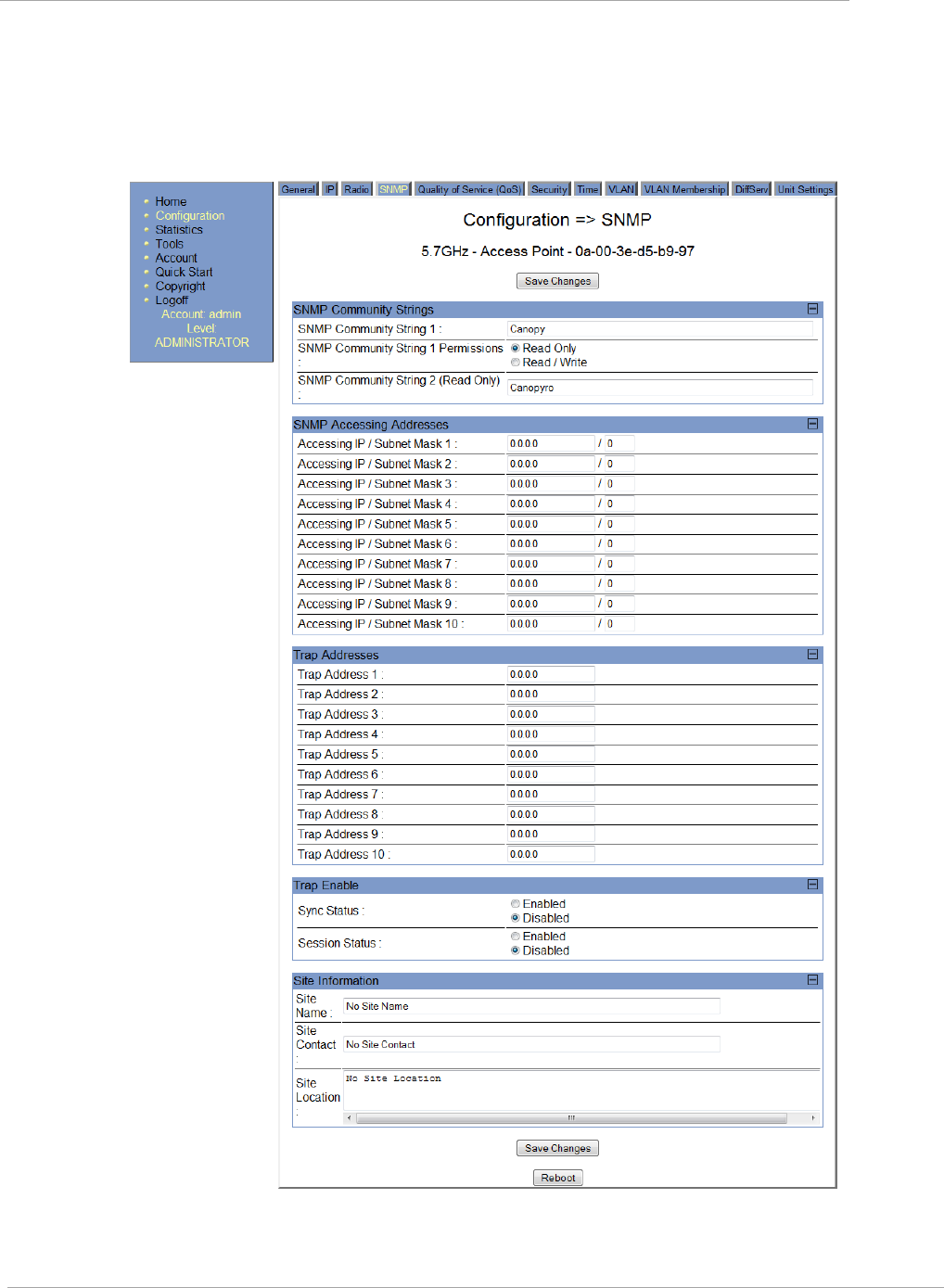
PMP 450 Configuration and User Guide
Task 7: Setting up SNMP agent
pmp-0050 (May 2012)
2-93
SNMP Tab of the AP
Table 42 SNMP tab of the AP
You may set the SNMP tab parameters as follows.

Task 7: Setting up SNMP agent
Chapter 2: Configuration and alignment
2-94
pmp-0050 (May 2012)
Table 43 AP SNMP attributes
Attribute
Meaning
SNMP Community String
1
Specify a control string that can allow an Network Management Station
(NMS) to access SNMP information. No spaces are allowed in this string. The
default string is Canopy.
SNMP Community String
1 Permissions
You can designate the SNMP Community String 1 to be the password for
Prizm, for example, to have read/write access to the module via SNMP, or for
all SNMP access to the module to be read only.
SNMP Community String
2 (Read Only)
Specify an additional control string that can allow an Network Management
Station (NMS) to read SNMP information. No spaces are allowed in this
string. The default string is Canopyro. This password will never authenticate a
user or an NMS to read/write access.
The Community String value is clear text and is readable by a packet monitor.
Additional security derives from the configuration of the Accessing Subnet,
Trap Address, and Permission parameters.
Accessing IP / Subnet Mask
1 to 10
Specify the addresses that are allowed to send SNMP requests to this AP. The
NMS has an address that is among these addresses (this subnet). You must
enter both
The network IP address in the form xxx.xxx.xxx.xxx
The CIDR (Classless Interdomain Routing) prefix length in the form /xx
For example
the /16 in 198.32.0.0/16 specifies a subnet mask of 255.255.0.0 (the first 16 bits
in the address range are identical among all members of the subnet).
192.168.102.0 specifies that any device whose IP address is in the range
192.168.102.0 to 192.168.102.254 can send SNMP requests to the AP,
presuming that the device supplies the correct Community String value.
The default treatment is to allow all networks access. For more information
on CIDR, execute an Internet search on ―Classless Interdomain Routing.‖
You are allowed to specify as many as 10 different accessing IP address,
subnet mask combinations.
SNMP Trap Server DNS
Usage
The management DNS domain name may be toggled such that the name of
the trap server only needs to be specified and the DNS domain name is
automatically appended to that name. The default SNMP trap server
addresses for all 10 available servers is 0.0.0.0 with the appending of the DNS
domain name disabled.

PMP 450 Configuration and User Guide
Task 7: Setting up SNMP agent
pmp-0050 (May 2012)
2-95
Attribute
Meaning
Trap Address 1 to 10
Specify ten or fewer IP addresses (xxx.xxx.xxx.xxx) or DNS names to which
SNMP traps should be sent. Traps inform Prizm or an NMS that something
has occurred. For example, trap information is sent
after a reboot of the module.
when an NMS attempts to access agent information but either
supplied an inappropriate community string or SNMP version number.
is associated with a subnet to which access is disallowed.
Trap Enable, Sync Status
If you want sync status traps (sync lost and sync regained) sent to Prizm or
an NMS, select Enabled. If you want these traps suppressed, select Disabled.
Trap Enable, Session
Status
If you want session status traps sent to Prizm or an NMS, select Enabled.
Site Information Viewable
to Guest Users
Operators can enable or disable site information from appearing when a user is
in GUEST account mode.
Site Name
Specify a string to associate with the physical module. This parameter is
written into the sysName SNMP MIB-II object and can be polled by
PrizmEMS or an NMS. The buffer size for this field is 128 characters.
Site Contact
Enter contact information for the module administrator. This parameter is
written into the sysContact SNMP MIB-II object and can be polled by
PrizmEMS or an NMS. The buffer size for this field is 128 characters.
Site Location
Enter information about the physical location of the module. This parameter
is written into the sysLocation SNMP MIB-II object and can be polled by
PrizmEMS or an NMS. The buffer size for this field is 128 characters.
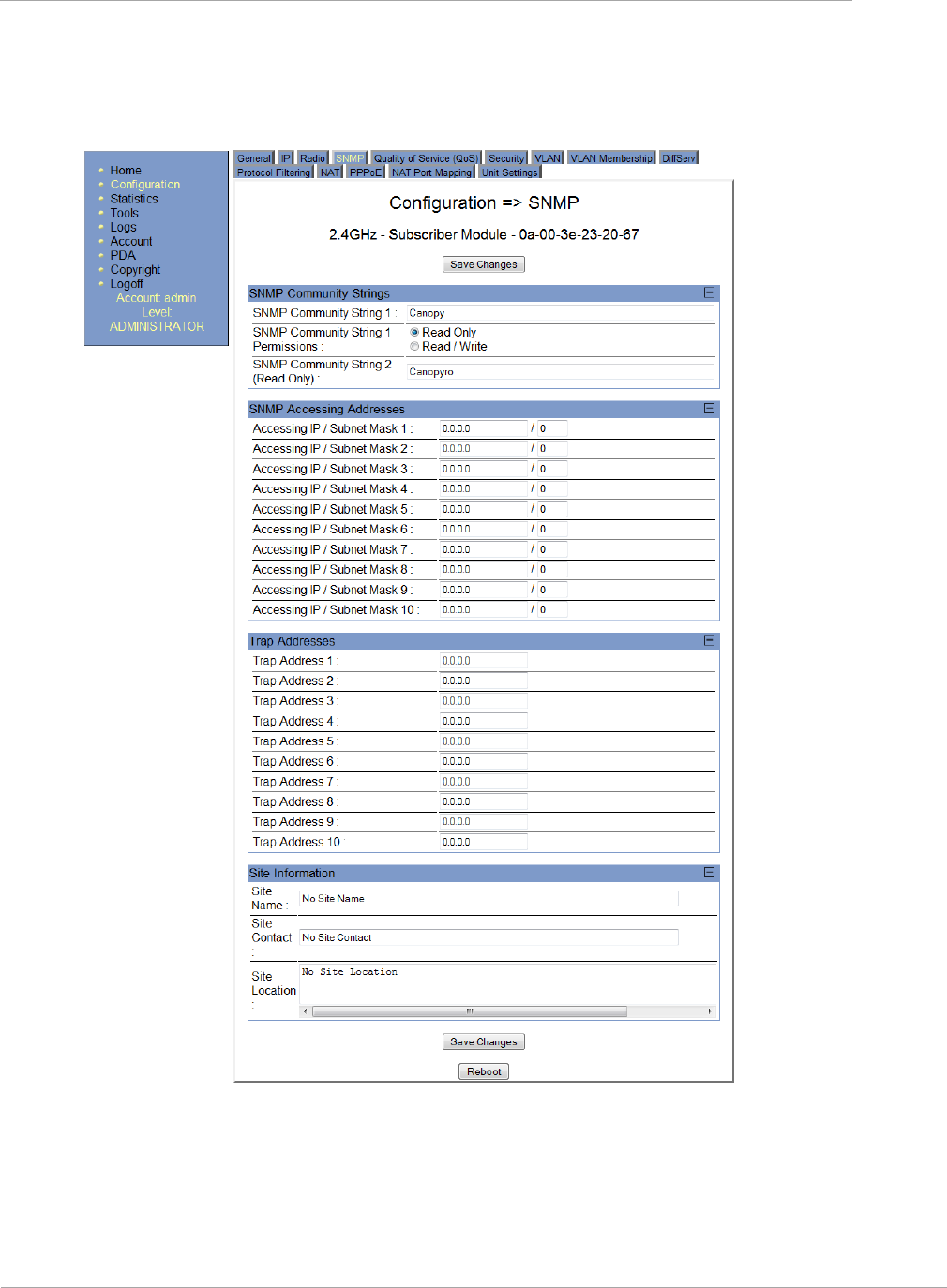
Task 7: Setting up SNMP agent
Chapter 2: Configuration and alignment
2-96
pmp-0050 (May 2012)
SNMP Tab of the SM
Table 44 SNMP tab of SM

PMP 450 Configuration and User Guide
Task 7: Setting up SNMP agent
pmp-0050 (May 2012)
2-97
In the SNMP tab of the SM, you may set the following parameters.
Table 45 SM SNMP attributes
Attribute
Meaning
SNMP Community String
1
Specify a control string that can allow an Network Management Station
(NMS) to access SNMP information. No spaces are allowed in this string. The
default string is Canopy.
SNMP Community String
1 Permissions
You can designate the SNMP Community String 1 to be the password for
Prizm, for example, to have read/write access to the module via SNMP, or for
all SNMP access to the module to be read only.
SNMP Community String
2 (Read Only)
Specify an additional control string that can allow an Network Management
Station (NMS) to read SNMP information. No spaces are allowed in this
string. The default string is Canopy2. This password will never authenticate a
user or an NMS to read/write access.
The Community String value is clear text and is readable by a packet monitor.
Additional security derives from the configuration of the Accessing Subnet,
Trap Address, and Permission parameters.
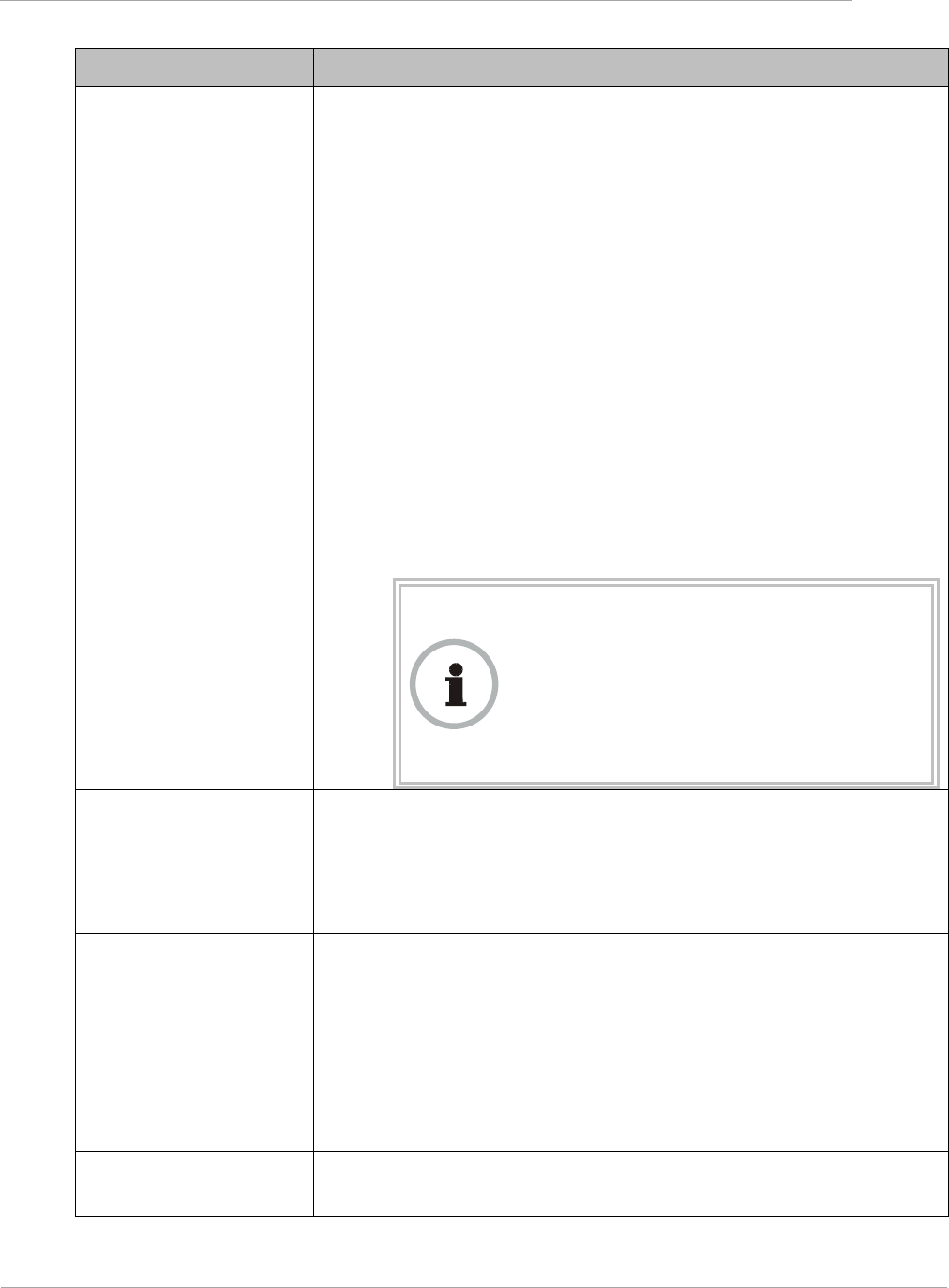
Task 7: Setting up SNMP agent
Chapter 2: Configuration and alignment
2-98
pmp-0050 (May 2012)
Attribute
Meaning
Accessing IP / Subnet Mask
1 to 10
Specify the addresses that are allowed to send SNMP requests to this SM.
Prizm or the NMS has an address that is among these addresses (this subnet).
You must enter both
The network IP address in the form xxx.xxx.xxx.xxx
The CIDR (Classless Interdomain Routing) prefix length in the form /xx
For example
the /16 in 198.32.0.0/16 specifies a subnet mask of 255.255.0.0 (the first 16 bits
in the address range are identical among all members of the subnet).
192.168.102.0 specifies that any device whose IP address is in the range
192.168.102.0 to 192.168.102.254 can send SNMP requests to the SM,
presuming that the device supplies the correct Community String value.
The default treatment is to allow all networks access (set to 0). For more
information on CIDR, execute an Internet search on ―Classless Interdomain
Routing.‖ You are allowed to specify as many as 10 different accessing IP
address, subnet mask combinations.
RECOMMENDATION:
The subscriber can access the SM by changing the
subscriber device to the accessing subnet. This hazard
exists because the Community String and Accessing
Subnet are both visible parameters. To avoid this hazard,
configure the SM to filter (block) SNMP requests.
SNMP Trap Server DNS
Usage
The management DNS domain name may be toggled such that the name of
the trap server only needs to be specified and the DNS domain name is
automatically appended to that name. The default SNMP trap server
addresses for all 10 available servers is 0.0.0.0 with the appending of the DNS
domain name disabled.
Trap Address 1 to 10
Specify ten or fewer IP addresses (xxx.xxx.xxx.xxx) to which trap
information should be sent. Trap information informs Prizm or an NMS that
something has occurred. For example, trap information is sent
after a reboot of the module.
when Prizm or an NMS attempts to access agent information but either
supplied an inappropriate community string or SNMP version number.
is associated with a subnet to which access is disallowed.
Read Permissions
Select Read Only if you wish to disallow Prizm or NMS SNMP access to
configurable parameters and read-only fields of the SM.

PMP 450 Configuration and User Guide
Task 7: Setting up SNMP agent
pmp-0050 (May 2012)
2-99
Attribute
Meaning
Site Information Viewable
to Guest Users
Operators can enable or disable site information from appearing when a user is
in GUEST account mode.
Site Name
Specify a string to associate with the physical module. This parameter is
written into the sysName SNMP MIB-II object and can be polled by Prizm or
an NMS. The buffer size for this field is 128 characters.
Site Contact
Enter contact information for the module administrator. This parameter is
written into the sysContact SNMP MIB-II object and can be polled by Prizm
or an NMS. The buffer size for this field is 128 characters.
Site Location
Enter information about the physical location of the module. This parameter
is written into the sysLocation SNMP MIB-II object and can be polled by
Prizm or an NMS. The buffer size for this field is 128 characters.
The SNMP tab also provides the following buttons.
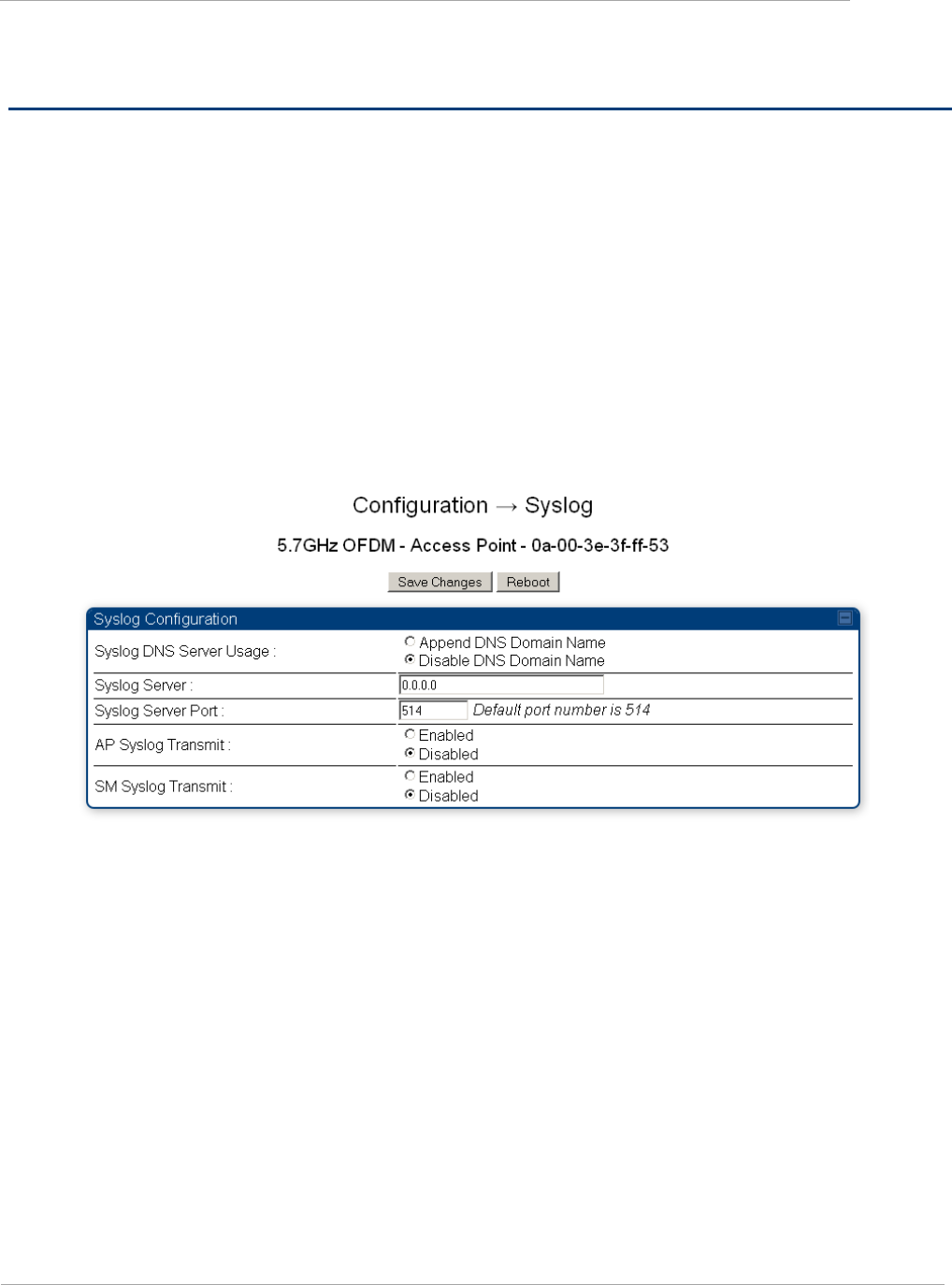
Task 8: Configuring syslog
Chapter 2: Configuration and alignment
2-100
pmp-0050 (May 2012)
Task 8: Configuring syslog
This task is only performed when system logging is required. Both the AP and the SM may be configured to
send system messages to a syslog server. An example of a syslog message that would be sent from a radio is as
follows:
<6>1 2011-05-13T12:28:31Z 169.245.1.1 - - - - BOM******System Startup******
By default syslog is disabled on all devices.
Configuring AP system logging (syslog)
To configure system logging, select menu option Configuration, Syslog. The Syslog Configuration page is
displayed (Figure 16).
Figure 16 AP Syslog Configuration page
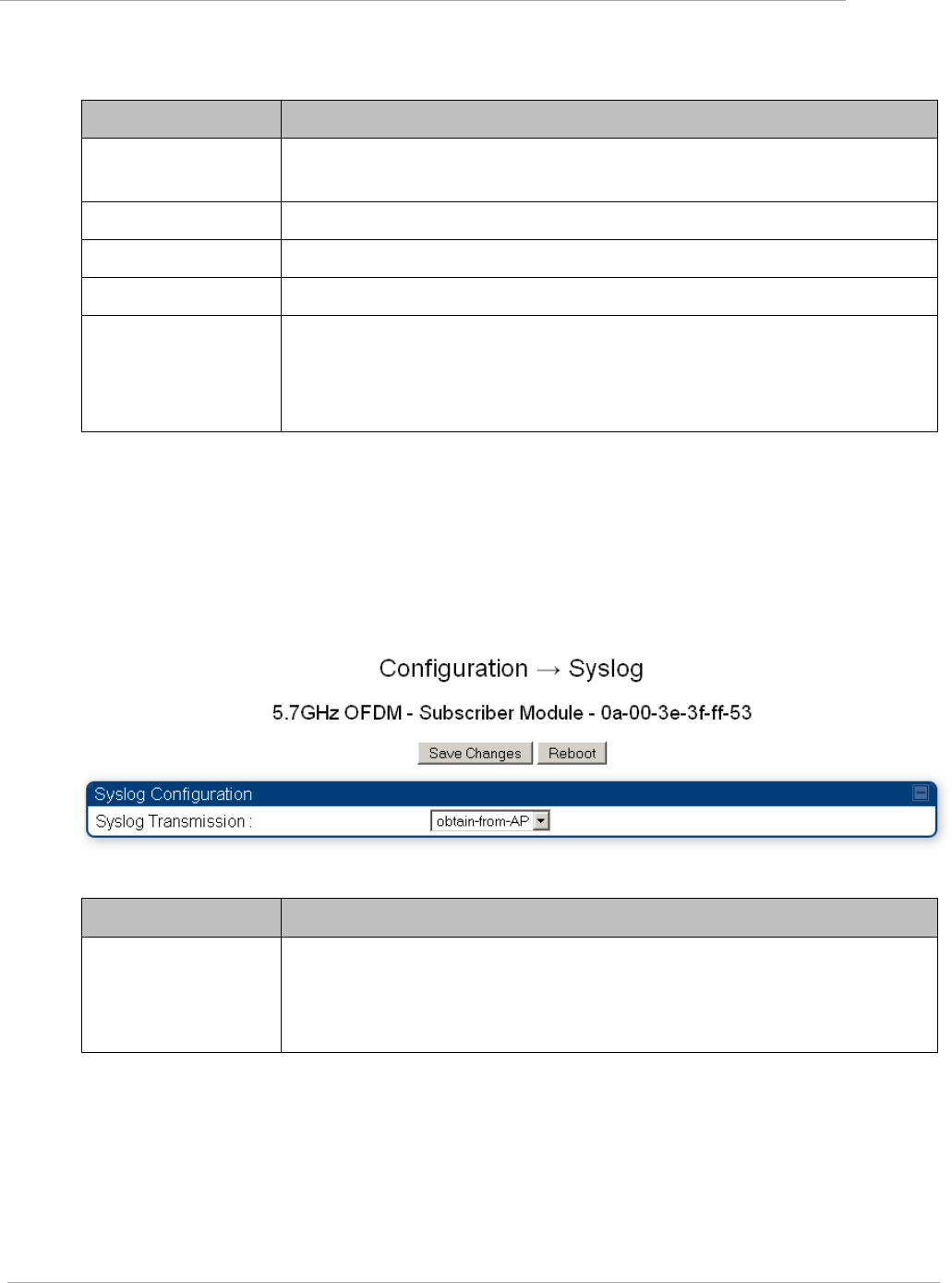
PMP 450 Configuration and User Guide
Task 8: Configuring syslog
pmp-0050 (May 2012)
2-101
Table 46 Syslog Configuration attributes
Attribute
Meaning
Syslog DNS Server
Usage
To configure the AP to append or not append the DNS server name to the syslog
server name.
Syslog Server
The dotted decimal or DNS name of the syslog server address.
Syslog Server Port
The syslog server port (default 514) to which syslog messaging is sent.
AP Syslog Transmit
When enabled, syslog messages will be sent from the AP.
SM Syslog Transmit
When enabled, allows all SMs in a sector to learn the enabling or disabling syslog
messages transmission setting at registration. In order for the SM to use this
information from the AP, the SM must be configured to learn syslog settings from
the AP.
Configuring SM system logging (syslog)
To configure system logging, select menu option Configuration, Syslog. The Syslog Configuration page is
displayed (Figure 16).
Figure 17 SM Syslog Configuration page
Table 47 Syslog Configuration attributes
Attribute
Meaning
Syslog Transmission
The SM can choose to either learn its syslog configuration from the AP or to
override the AP‘s sector settings with its own settings. The ability to override the
AP settings lets an operator enable or disable syslog settings for individual SMs in
a sector.
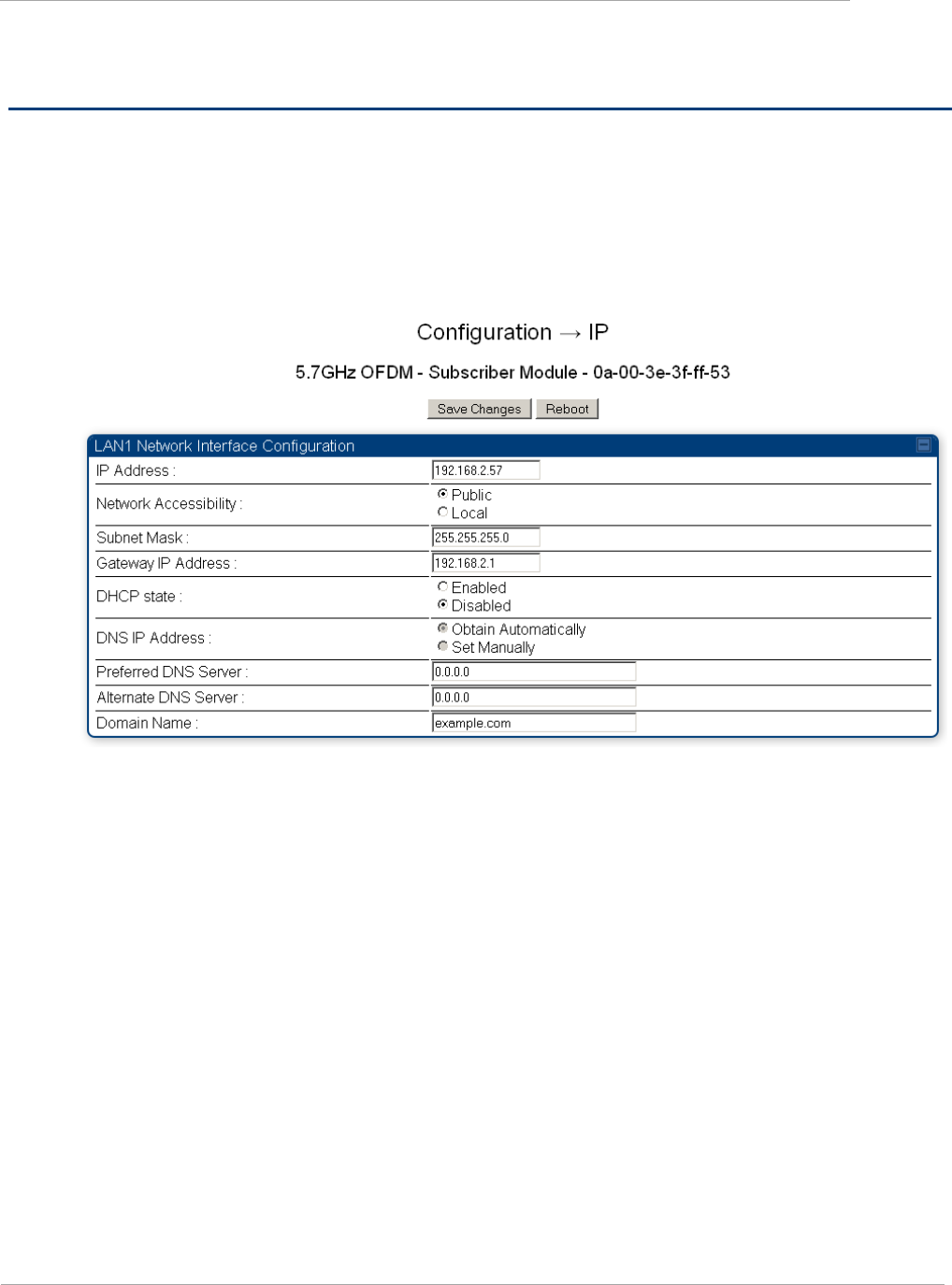
Task 9: Configuring remote access
Chapter 2: Configuration and alignment
2-102
pmp-0050 (May 2012)
Task 9: Configuring remote access
Configuring SM IP over-the-air access
To access the SM management interface from a device situated above the AP, the SM‘s Network Accessibility
parameter (located in the web GUI at Configuration, IP) may be set to Public.
Figure 18 SM IP Configuration page
Accessing SM over-the-air by LUID
The SM may be accessed via the AP management GUI by navigating to either Home, Session Status or Home,
Remote Subscribers and clicking on the SM‘s hyperlink.
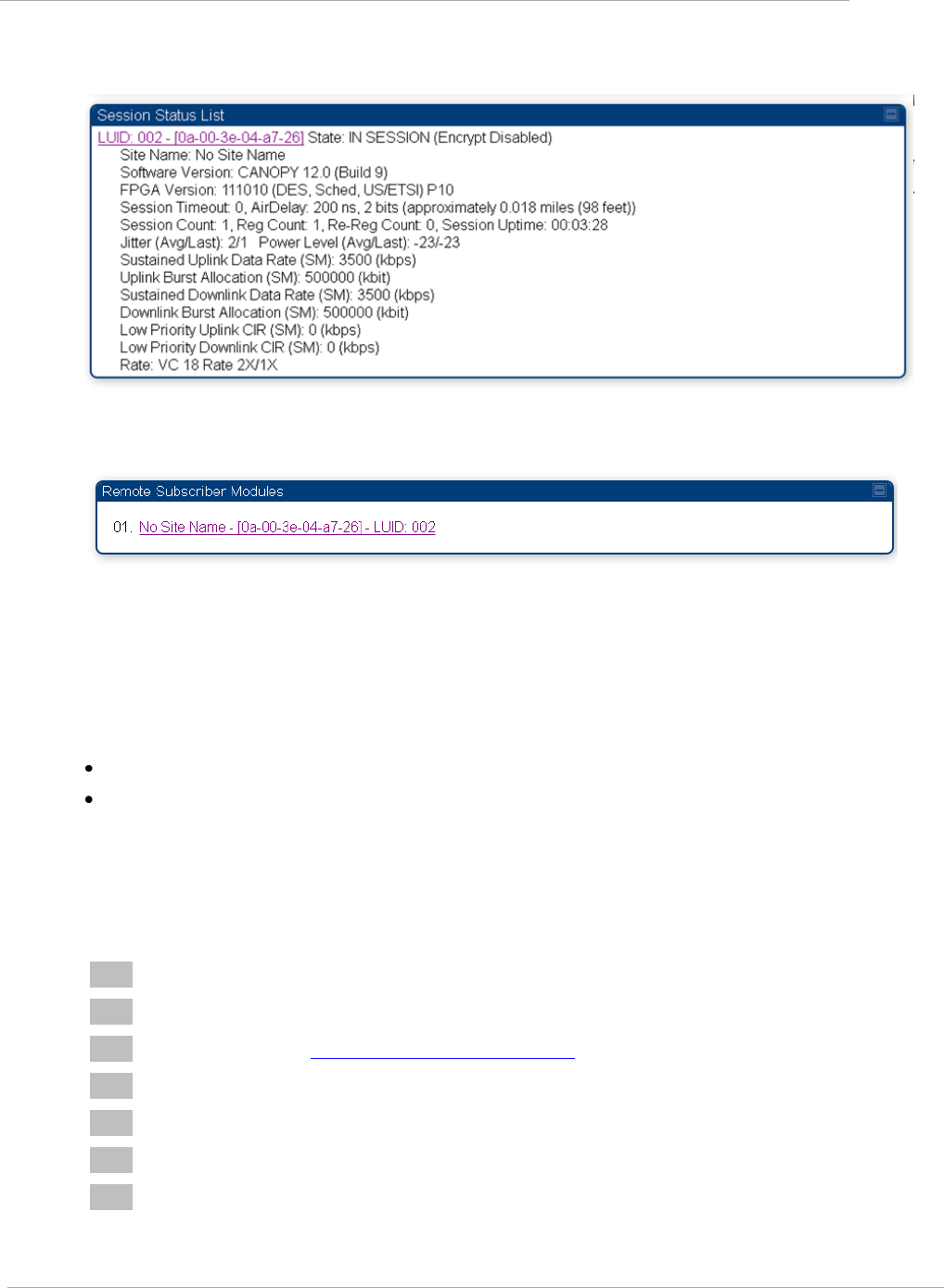
PMP 450 Configuration and User Guide
Task 9: Configuring remote access
pmp-0050 (May 2012)
2-103
Figure 19 AP Session Status page
Figure 20 AP Remote Subscribers page
Denying All Remote Access
Wherever the No Remote Access feature is enabled by the following procedure, physical access to the module is
required for
any change in the configuration of the module.
any software upgrade in the module.
Where additional security is more important than ease of network administration, you can disable all remote
access to a module as follows. After this procedure, no access to the module is possible through HTTP, SNMP,
FTP, or telnet over an RF link.
To deny remote access to the module, perform the following steps:
1
Insert the override plug into the RJ-11 GPS utility port of the module
2
Power up or power cycle the module
3
Access the web page http://169.254.1.1/lockconfig.html
4
Click the checkbox
5
Save the changes
6
Remove the override plug
7
Reboot the module

Task 9: Configuring remote access
Chapter 2: Configuration and alignment
2-104
pmp-0050 (May 2012)
Reinstating Remote Access Capability
Where ease of network administration is more important than the additional security that the No Remote
Access feature provides, this feature can be disabled as follows. After this procedure, access to the module is
possible through HTTP, SNMP, FTP, or telnet over an RF link.
To reinstate all remote access to the module, perform the following steps:
1
Insert the override plug into the RJ-11 GPS utility port of the module
2
Power up or power cycle the module
3
Access the web page http://169.254.1.1/lockconfig.html
4
Click the check box to uncheck the field
5
Save the changes
6
Remove the override plug
7
Reboot the module
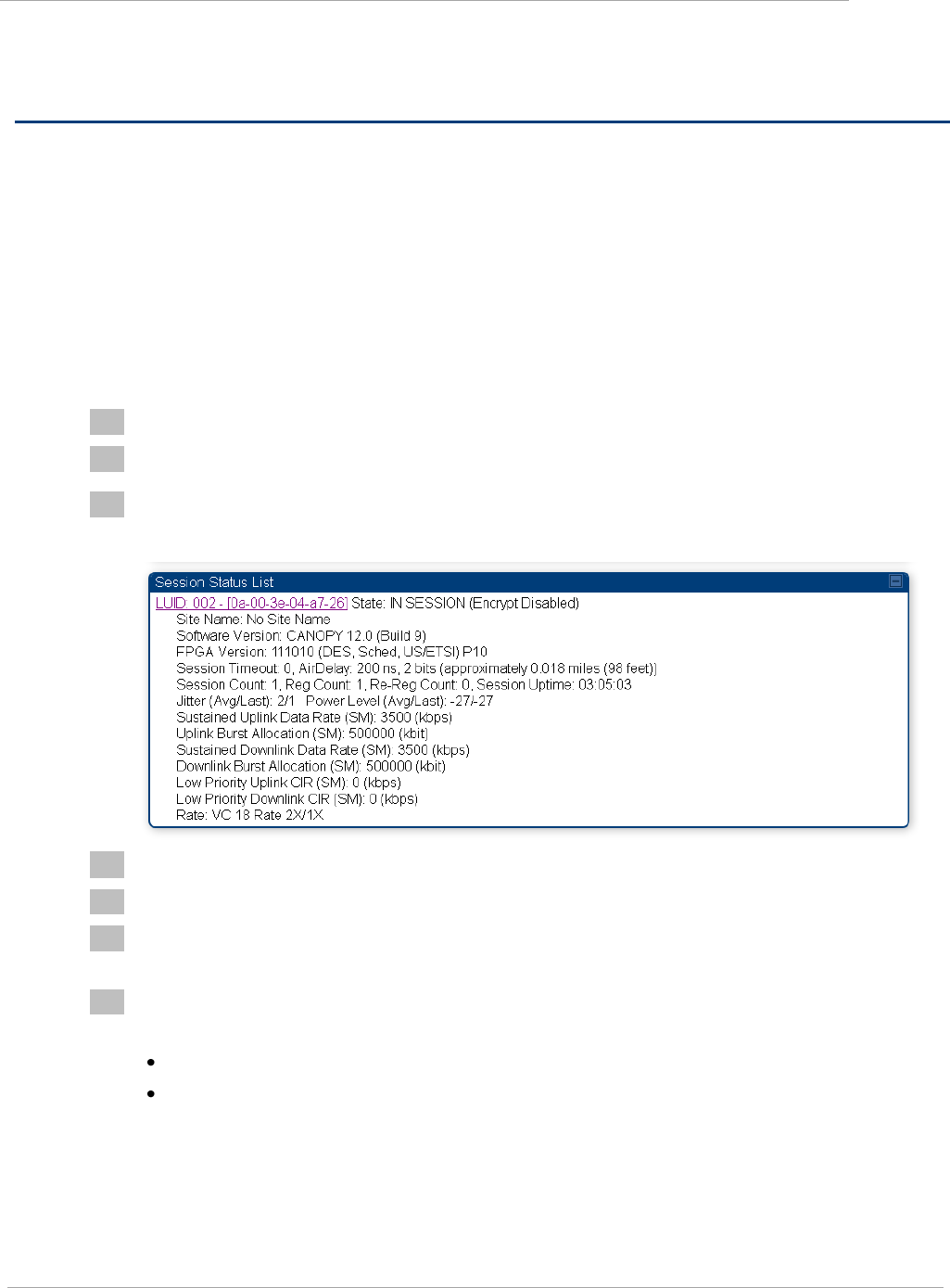
PMP 450 Configuration and User Guide
Task 10: Monitoring the AP-SM Link
pmp-0050 (May 2012)
2-105
Task 10: Monitoring the AP-SM Link
Monitoring the AP-SM Link
After the SM installer has configured the link, either an operator in the network office or the SM installer in the
field (if read access to the AP is available to the installer) should perform the following procedure. Who is
authorized and able to do this may depend on local operator password policy, management VLAN setup, and
operational practices.
To monitor the AP-SM link for performance, proceed as follows:
1
Access the web interface of the AP
2
In the left-side menu of the AP interface, select Home.
3
Click the Session Status tab.
Figure 21 AP Session Status page
4
Find the Session Count line under the MAC address of the SM.
5
Check and note the values for Session Count, Reg Count, and Re-Reg Count.
6
Briefly monitor these values, occasionally refreshing this page by clicking another tab and then the
Session Status tab again.
7
If these values are low (for example, 1, 1, and 0, respectively, meaning that the SM registered and
started a stable session once) and are not changing
consider the installation successful.
monitor these values from the network office over the next several hours and days.
If these values are greater than 1, 1, and 0, or they increase while you are monitoring them,
troubleshoot the link. (For example, Use Receive Power Level for aiming and then use Link Tests to
confirm alignment).

Task 11: Configuring quality of
service
Chapter 2: Configuration and alignment
2-106
pmp-0050 (May 2012)
Task 11: Configuring quality of service
Maximum Information Rate (MIR) Parameters
Point-to-multipoint links use the following four MIR parameters for bandwidth management:
Sustained Uplink Data Rate (kbps)
Uplink Burst Allocation (kb)
Sustained Downlink Data Rate (kbps)
Downlink Burst Allocation (kb)
You can independently set each of these parameters per AP or per SM.
Token Bucket Algorithm
The software uses a token bucket algorithm that
stores credits (tokens) for the SM to spend on bandwidth for reception or transmission.
drains tokens during reception or transmission.
refills with tokens at the sustained rate set by the network operator.
For each token, the SM can send toward the network in the uplink (or the AP can send toward the SM in the
downlink) an equivalent number of kilobits. Two buckets determine the permitted throughput: one in the SM
for uplink and one in the AP for downlink.
The applicable set of Uplink Burst Allocation and Downlink Burst Allocation parameters determine the number
of tokens that can fill each bucket. When the SM transmits (or the AP transmits) a packet, the equivalent
number of tokens is removed from the uplink (or downlink) bucket.
Except when full, the bucket is continuously being refilled with tokens at rates that the applicable set of
Sustained Uplink Data Rate and Sustained Downlink Data Rate parameters specify. The bucket often drains at
a rate that is much faster than the sustained data rate but can refill at only the sustained data rate. Thus, the
effects of the allocation and rate parameters on packet delay are as follows:
the burst allocation affects how many kilobits are processed before packet delay is imposed.
the sustained data rate affects the packet delay that is imposed.
Which set of these MIR parameters are applicable depends on the interactions of other parameter values. Also,
where the Configuration Source parameter setting in the AP specifies that BAM values should be used, they are
used only if Prizm is configured to send the values that it stores for the MIR parameters.

PMP 450 Configuration and User Guide
Task 11: Configuring quality of service
pmp-0050 (May 2012)
2-107
MIR Data Entry Checking
Uplink and downlink MIR is enforced as shown in Figure 22.
In these figures, entry refers to the setting in the data rate parameter, not the burst allocation parameter.
Figure 22 Uplink and downlink rate caps adjusted to apply aggregate cap
uplink cap enforced = uplink entry x aggregate cap for the SM
uplink entry + downlink entry
downlink cap enforced = downlink entry x aggregate cap for the SM
uplink entry + downlink entry
For example, in the SM, if you set the Sustained Uplink Data Rate parameter to 2,000 kbps and the Sustained
Downlink Data Rate parameter to 10,000 kbps, then the uplink and downlink MIR that will be enforced for the
SM can be calculated as shown in Figure 23.
Figure 23 Uplink and downlink rate cap adjustment example
uplink cap enforced = 2,000 kbps x 7,000 kbps
2,000 kbps + 10,000 kbps = 1,167 kbps
downlink cap enforced = 10,000 kbps x 7,000 kbps
2,000 kbps + 10,000 kbps = 5,833 kbps
In this example case, the derived 1,167-kbps uplink and 5,833-kbps downlink MIR sum to the fixed 7,000-kbps
aggregate cap of the SM.
Committed Information Rate
The Committed Information Rate (CIR) capability feature enables the service provider to guarantee to any
subscriber that bandwidth will never decrease to below a specified minimum, unless CIR is oversubscribed.
Bandwidth can be, and typically will be, higher than the minimum, but this guarantee helps the WISP to
attract and retain subscribers.
In BAM Release 2.1 and in Prizm Release 2.0, CIR configuration is supported as follows:
The GUI allows you to view and change CIR configuration parameters per SM.

Task 11: Configuring quality of
service
Chapter 2: Configuration and alignment
2-108
pmp-0050 (May 2012)
When an SM successfully registers and authenticates, if BAM or Prizm has CIR configuration data for the
SM, then messages make the CIR configuration available to the SM, depending on the Configuration
Source setting.
The operator can disable the CIR feature in the SM without deleting the CIR configuration data.
Bandwidth from the SM Perspective
In the SM, normal web browsing, e-mail, small file transfers, and short streaming video are rarely rate limited
with practical bandwidth management (QoS) settings. When the SM processes large downloads such as
software upgrades and long streaming video or a series of medium-size downloads, the bucket rapidly drains,
the burst limit is reached, and some packets are delayed. The subscriber experience is more affected in cases
where the traffic is more latency sensitive.
Interaction of Burst Allocation and Sustained Data Rate Settings
If the Burst Allocation is set to 1200 kb and the Sustained Data Rate is set to 128 kbps, a data burst of 1000 kb
is transmitted at full speed because the Burst Allocation is set high enough. After the burst, the bucket
experiences a significant refill at the Sustained Data Rate. This configuration uses the advantage of the
settable Burst Allocation.
If both the Burst Allocation and the Sustained Data Rate are set to 128 kb, a burst is limited to the Burst
Allocation value. This configuration does not take advantage of the settable Burst Allocation.
If the Burst Allocation is set to 128 kb and the Sustained Data Rate is set to 256 kbps, the actual rate will be
the burst allocation (but in kbps). As above, this configuration does not take advantage of the settable Burst
Allocation.
High-priority Bandwidth
To support low-latency traffic such as VoIP (Voice over IP) or video, the system implements a high-priority
channel. This channel does not affect the inherent latencies in the system but allows high-priority traffic to be
immediately served. The high-priority pipe separates low-latency traffic from traffic that is latency tolerant,
such as standard web traffic and file downloads.
The number of channels available to the AP is reduced by the number of SMs configured for the high-priority
channel. With this feature enabled on all SMs, an AP can support 100 SMs (instead of 200).
A module prioritizes traffic by
reading the Low Latency bit (Bit 3) in the IPv4 Type of Service (ToS) byte in a received packet. Bit 3 is
set by a device outside the system.
reading the 802.1p field of the 802.1Q header in a received packet, where VLAN is enabled on the module.
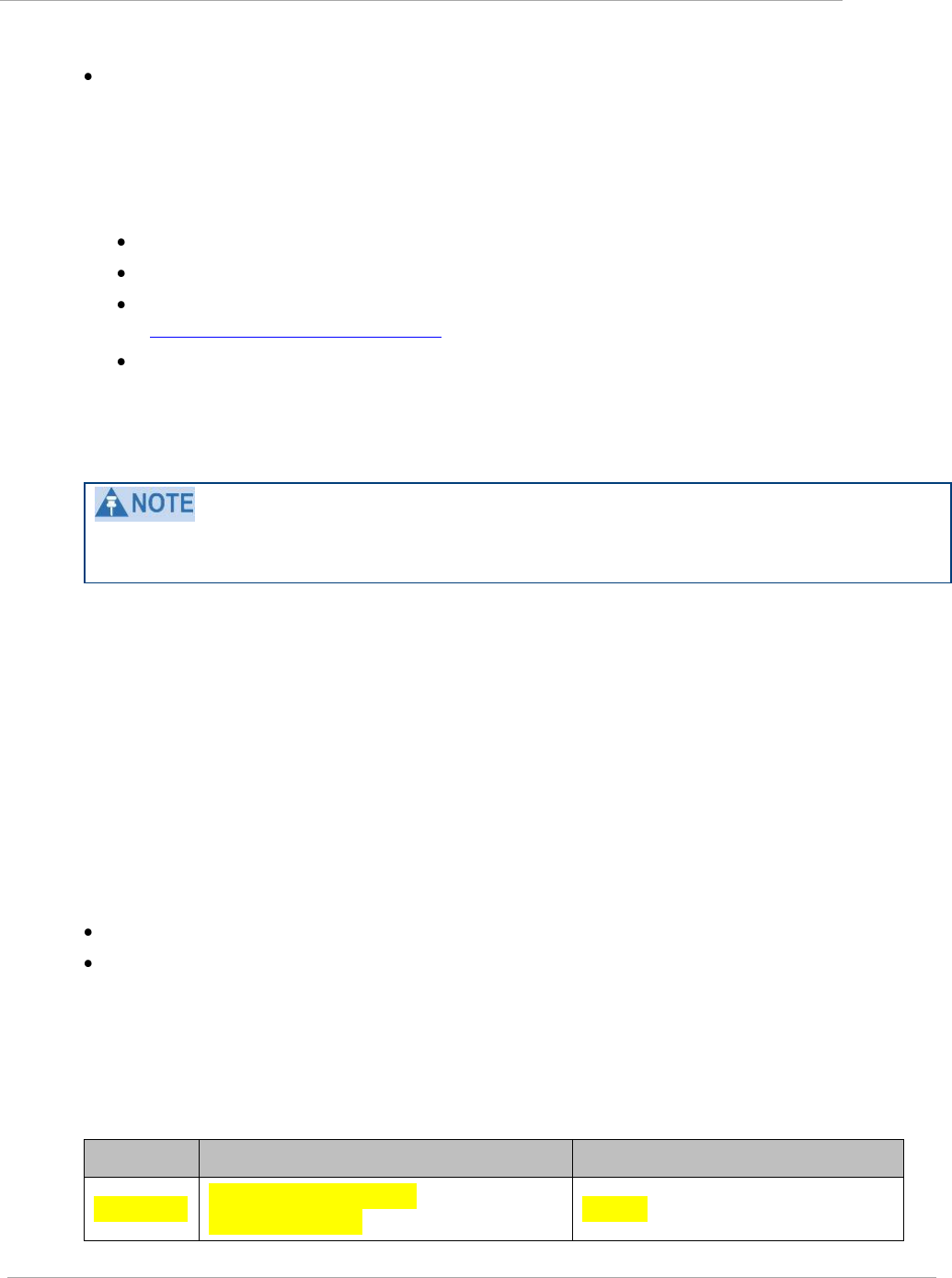
PMP 450 Configuration and User Guide
Task 11: Configuring quality of service
pmp-0050 (May 2012)
2-109
comparing the 6-bit Differentiated Services Code Point (DSCP) field in the ToS byte of a received packet
to a corresponding value in the Diffserv tab of the Configuration page of the module. A packet contains no
flag that indicates whether the encoding is for the Low Latency bit or the DSCP field. For this reason, you
must ensure that all elements in your trusted domain, including routers and endpoints, set and read the
ToS byte with the same scheme.
Modules monitor ToS bytes with DSCP fields, but with the following differences:
The 6-bit length of the field allows it to specify one of 64 service differentiations.
These correlate to 64 individual (CodePoint) parameters in the Diffserv tab of the Configuration page.
Per RFC 2474, 3 of these 64 are preset and cannot be changed. (See
http://www.faqs.org/rfcs/rfc1902.html.)
For any or all of the remaining 61 CodePoint parameters, you can specify a value of
o 0 through 3 for low-priority handling.
o 4 through 7 for high-priority handling.
Ensure that your Differentiated Services domain boundary nodes mark any entering packet, as needed, so
that it specifies the appropriate Code Point for that traffic and domain. This prevents theft of service level.
An example of the Diffserv tab in the Configuration page and parameter descriptions are provided under
DiffServ Tab of the AP on Page 2-116. This tab and its rules are identical from module type to module type.
However, any of the 61 configurable Code Points can be set to a different value from module to module, thus
defining unique per-hop behavior for some traffic.
This tab in the AP sets the priorities for the various packets in the downstream (sent from the public network).
This tab in the SM sets the priorities for the various packets in the upstream (sent to the public network).
Typically, some SMs attach to older devices that use the ToS byte as originally formatted, and others to newer
devices that use the DSCP field. The default values in the Diffserv tab allow your modules to prioritize traffic
from the older devices roughly the same as they traditionally have. However, these default values may result in
more high-priority traffic as DSCP fields from the newer devices are read and handled. So, after making any
changes in the Diffserv tab, carefully monitor the high-priority channel for high packet rates
in SMs that you have identified as those to initially set and watch.
across your network when you have broadly implemented Code Point values, such as via SNMP.
Traffic Scheduling
The characteristics of traffic scheduling in a sector are summarized in Table 48.
Table 48 Characteristics of traffic scheduling
Category
Factor
Treatment
Throughput
Aggregate throughput, less
additional overhead
14 Mbps
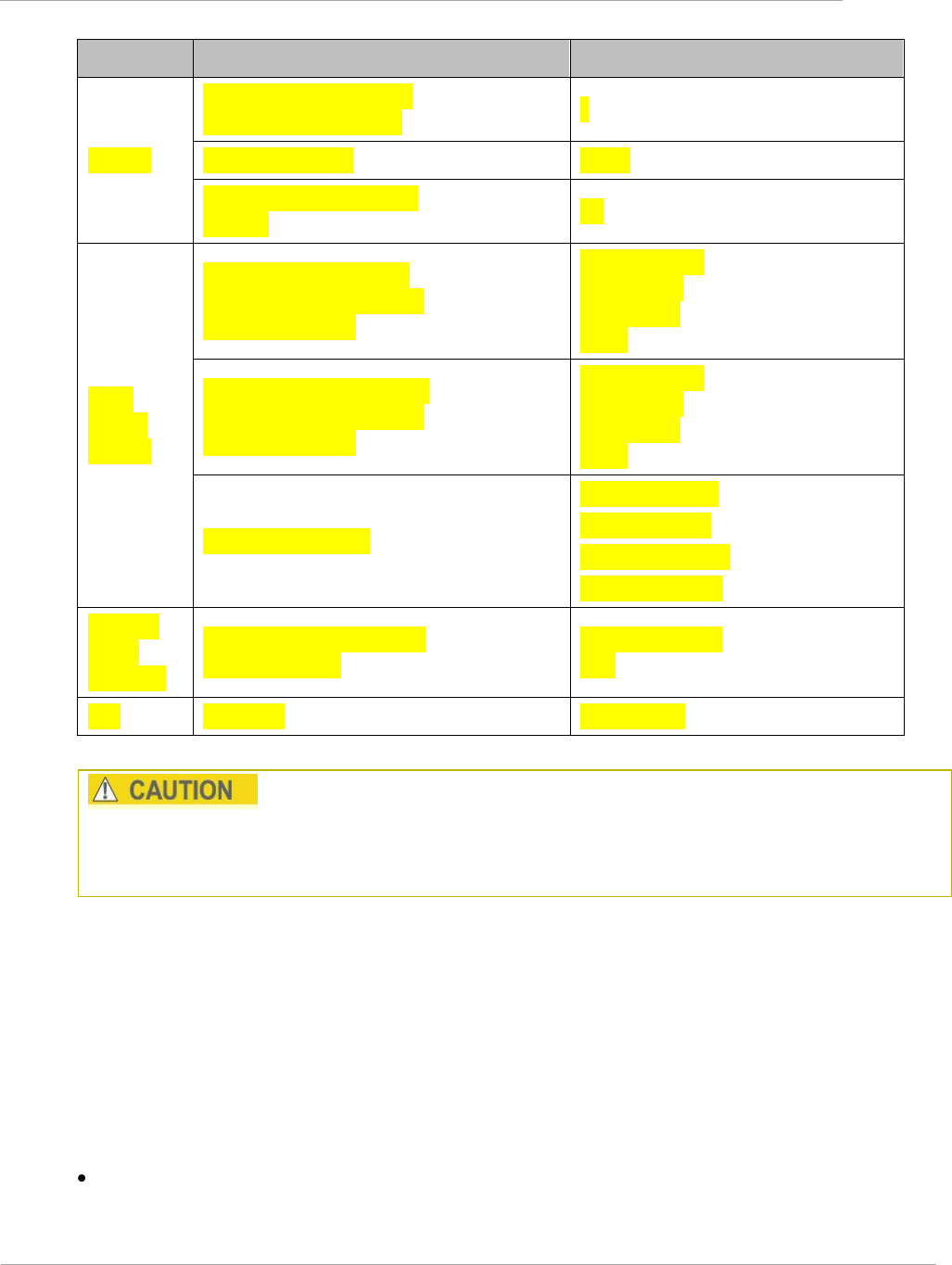
Task 11: Configuring quality of
service
Chapter 2: Configuration and alignment
2-110
pmp-0050 (May 2012)
Category
Factor
Treatment
Latency
Number of frames required
for the scheduling process
1
Round-trip latency
≈ 6 ms
AP broadcast the download
schedule
No
High-
priority
Channel
Allocation for uplink high-
priority traffic on amount of
high-priority traffic
Dynamic, based
on amount of
high-priority
traffic
Allocation for downlink high-
priority traffic on amount of
high-priority traffic
Dynamic, based
on amount of
high-priority
traffic
Order of transmission
CIR high-priority
CIR low-priority
Other high-priority
Other low-priority
Transmit
Frame
Spreading
Support for Transmit Frame
Spreading feature
In Release 7.0 and
later
CIR
Capability
In all releases
Power requirements affect the recommended maximums for power cord length feeding the CMMmicro or
CMM4. See the dedicated user guide that supports the CMM that you are deploying. However, the
requirements do not affect the maximums for the CMM2.
Packets that have a priority of 4 to 7 in either the DSCP or a VLAN 802.1p tag are automatically sent on the
high-priority channel, but only where the high-priority channel is enabled.
Setting the Configuration Source
The AP includes a Configuration Source parameter, which sets where SMs that register to the AP are controlled
for MIR, VLAN, the high-priority channel, and CIR as follows. The Configuration Source parameter affects the
source of:
all MIR settings:
o Sustained Uplink Data Rate

PMP 450 Configuration and User Guide
Task 11: Configuring quality of service
pmp-0050 (May 2012)
2-111
o Uplink Burst Allocation
o Sustained Downlink Data Rate
o Downlink Burst Allocation
all SM VLAN settings
o Dynamic Learning
o Allow Only Tagged Frames
o VLAN Aging Timeout
o Untagged Ingress VID
o Management VID
o VLAN Membership
the Hi Priority Channel setting
all CIR settings
o Low Priority Uplink CIR
o Low Priority Downlink CIR
o Hi Priority Uplink CIR
o Hi Priority Downlink CIR
Table 49 Recommended combined settings for typical operations
Most operators
who use…
should set
this
parameter…
in this web
page/tab…
in the AP to…
no authentication
server
Authentication
Mode
Configuration/
Security
Authentication Disabled
Configuration
Source
Configuration/
General
SM
Prizm with
authentication
server
Authentication
Mode
Configuration/
Security
Authentication Required
Configuration
Source
Configuration/
General
Authentication Server

Task 11: Configuring quality of
service
Chapter 2: Configuration and alignment
2-112
pmp-0050 (May 2012)
Table 50 Where feature values are obtained for an SM with authentication required
Configuration
Source Setting
in the AP
Values are obtained from
MIR Values
VLAN Values
High Priority Channel
State
CIR Values
Authentication
Server
Authentication
Server
Authentication
Server
Authentication Server
Authentication Server
SM
SM
SM
SM
SM
Authentication
Server+SM
Authentication
Server
Authentication
Server, then
SM
Authentication Server, then SM
Authentication Server,
then SM
NOTES:
HPC represents the Hi Priority Channel (enable or disable).
Where Authentication Server, then SM is the indication, parameters for which Authentication Server does not send
values are obtained from the SM. This is the case where the Authentication Server server is operating on a
Authentication Server release that did not support the feature. This is also the case where the feature
enable/disable flag in Authentication Server is set to disabled. The values are those previously set or, if none ever
were, then the default values.
Where Authentication Server is the indication, values in the SM are disregarded.
Where SM is the indication, values that Authentication Server sends for the SM are disregarded.
The high-priority channel is unavailable to Series P7 and P8 SMs.
For any SM whose Authentication Mode parameter is not set to Authentication Required, the listed settings are
derived as shown:
Table 51 Where feature values are obtained for an SM with authentication disabled
Configuration
Source
Setting
in the AP
Values are obtained from
MIR
Values
VLAN
Values
High Priority
Channel State
CIR Values
Authentication
Server
AP
AP
AP
AP
SM
SM
SM
SM
SM
Authentication
Server+SM
SM
SM
SM
SM
For the case where the Configuration Source parameter in the AP is set to Authentication Server, the SM stores a
value for the Dynamic Learning VLAN parameter that differs from its factory default. When Prizm does not
send VLAN values (because VLAN Enable is set to No in Prizm), the SM
uses this stored Disable value for Dynamic Learning.
shows the following in the VLAN Configuration web page:
o either Enable or Disable as the value of the Dynamic Learning parameter.
o Allow Learning : No under Active Configuration.
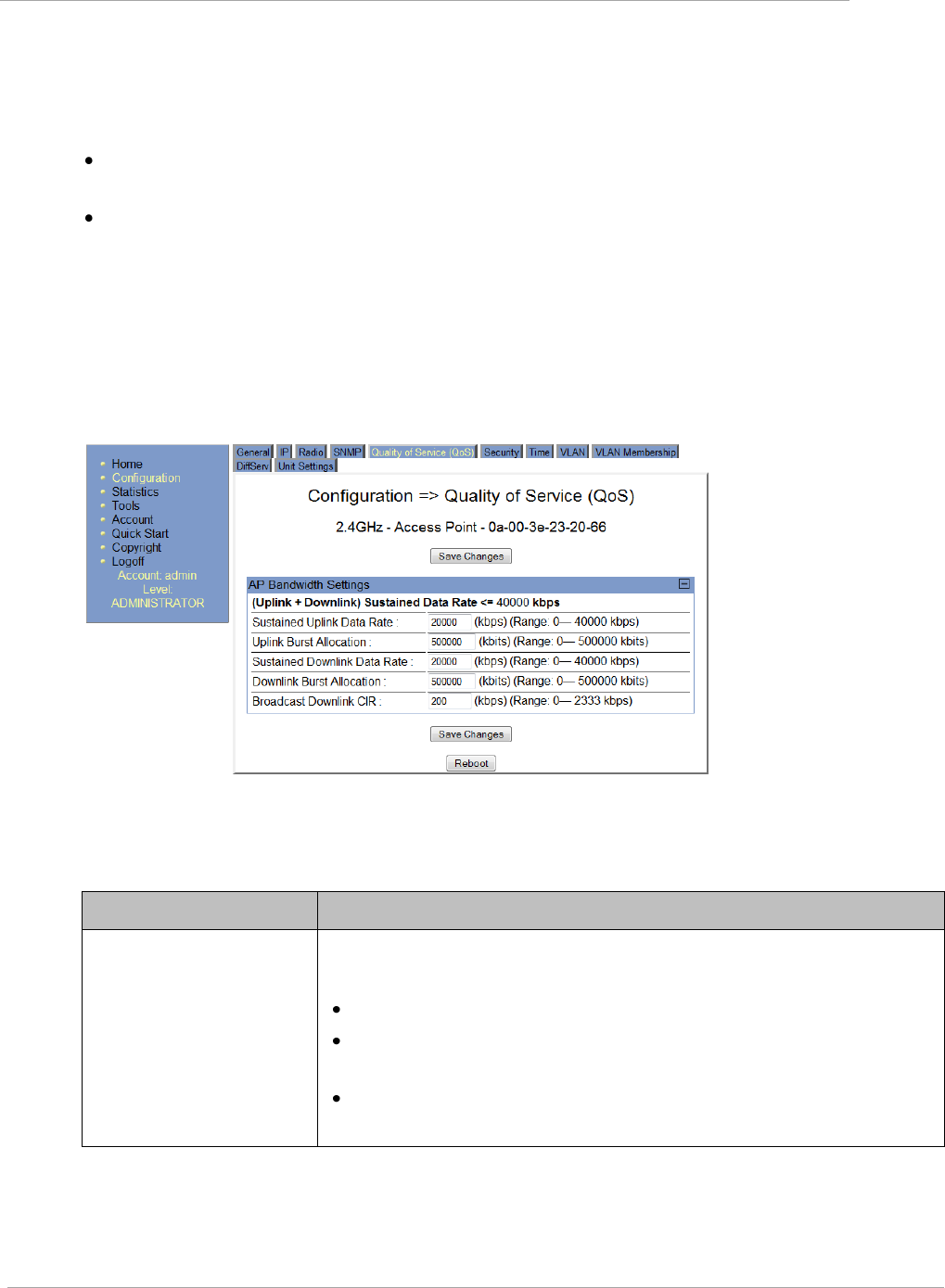
PMP 450 Configuration and User Guide
Task 11: Configuring quality of service
pmp-0050 (May 2012)
2-113
For the case where the Configuration Source parameter in the AP is set to Authentication Server+SM, and Prizm
does not send VLAN values, the SM
uses the configured value in the SM for Dynamic Learning. If the SM is set to factory defaults, then this
value is Enable.
shows under Active Configuration the result of the configured value in the SM. For example, if the SM is set
to factory defaults, then the VLAN Configuration page shows Allow Learning : Yes.
This selection (Authentication Server+SM) is not recommended where Prizm manages the VLAN feature in SMs.
Quality of Service (QoS) Tab of the AP
Figure 24 Quality of Service (QoS) tab of the AP
In the Quality of Service (QoS) tab, you may set AP bandwidth parameters as follows.
Table 52 AP QoS attributes
Attribute
Meaning
Sustained Uplink Data
Rate
Specify the rate that each SM registered to this AP is replenished with credits
for transmission. This default imposes no restriction on the uplink. See
Maximum Information Rate (MIR) Parameters on page 2-106
Interaction of Burst Allocation and Sustained Data Rate Settings on
page 2-108
Configuration Source on page 2-42

Task 11: Configuring quality of
service
Chapter 2: Configuration and alignment
2-114
pmp-0050 (May 2012)
Attribute
Meaning
Uplink Burst Allocation
Specify the maximum amount of data to allow each SM to transmit before
being recharged at the Sustained Uplink Data Rate with credits to transmit
more. See
Maximum Information Rate (MIR) Parameters on page 2-106
Interaction of Burst Allocation and Sustained Data Rate Settings on
page 2-108
Configuration Source on page 2-42
Sustained Downlink Data
Rate
Specify the rate at which the AP should be replenished with credits (tokens)
for transmission to each of the SMs in its sector. This default imposes no
restriction on the uplink. See
Maximum Information Rate (MIR) Parameters on page 2-106
Interaction of Burst Allocation and Sustained Data Rate Settings on
page 2-108
Configuration Source on page 2-42
Downlink Burst Allocation
Specify the maximum amount of data to allow the AP to transmit to any
registered SM before the AP is replenished with transmission credits at the
Sustained Downlink Data Rate. See
Maximum Information Rate (MIR) Parameters on page 2-106
Interaction of Burst Allocation and Sustained Data Rate Settings on
page 2-108
Configuration Source on page 2-42

PMP 450 Configuration and User Guide
Task 11: Configuring quality of service
pmp-0050 (May 2012)
2-115
Attribute
Meaning
Broadcast Downlink CIR
Broadcast Downlink CIR (Committed Information Rate, a minimum) supports
some system designs where downlink broadcast is desired to have higher
priority than other traffic. For many other system designs, especially typical
internet access networks, leave the Broadcast Downlink CIR at the default.
Broadcast Downlink CIR is closely related to the Broadcast Repeat Count
parameter, which is settable in the Radio tab of the Configuration page in the
AP: when the Broadcast Repeat Count is changed, the total of available
bandwidth is also changed, since packets are being sent one, two, or three
times, according to the setting in the Broadcast Repeat Count parameter. (See
Broadcast Repeat Count on Page 2-86.)
Table 53 Broadcast Downlink CIR achievable per Broadcast
Repeat Count
Broadcast
Repeat
Count
Number of
times each
packet is sent
Highest
Achievable
Value for
Broadcast
Downlink CIR
0
1
7000 kbps
1
2
3500 kbps
2
3
2333 kbps
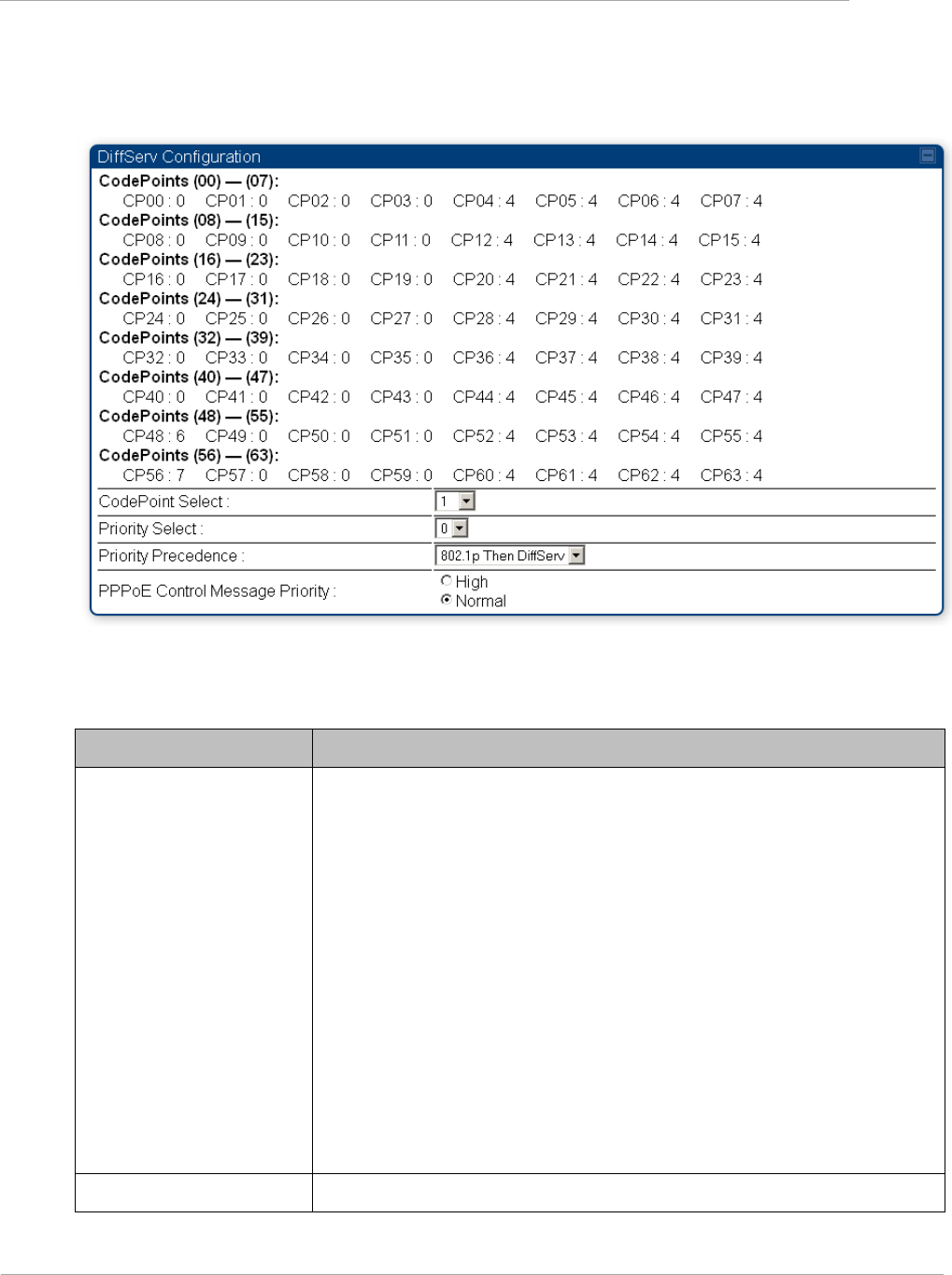
Task 11: Configuring quality of
service
Chapter 2: Configuration and alignment
2-116
pmp-0050 (May 2012)
DiffServ Tab of the AP
Figure 25 Diffserv tab of the AP
You may set the following Diffserv tab parameters.
Table 54 AP Diffserv attributes
Attribute
Meaning
CodePoint 1
through
CodePoint 47
CodePoint 49
through
CodePoint 55
CodePoint 57
through
CodePoint 63
Priorities of 0 through 3 map to the low-priority channel; 4 through 7 to the
high-priority channel. The mappings are the same as 802.1p VLAN priorities.
Consistent with RFC 2474
CodePoint 0 is predefined to a fixed priority value of 0
(low-priority channel).
CodePoint 48 is predefined to a fixed priority value of 6 (high-priority
channel).
CodePoint 56 is predefined to a fixed priority value of 7 (high-priority
channel).
You cannot change any of these three fixed priority values. Among the
settable parameters, the priority values (and therefore the handling of packets
in the high- or low-priority channel) are set in the AP for all downlinks within
the sector and in the SM for each uplink. See Error! Reference source not
found. on Page Error! Bookmark not defined..
CodePoint Select
This represents the CodePoint Selection to be modified via Priority Select

PMP 450 Configuration and User Guide
Task 11: Configuring quality of service
pmp-0050 (May 2012)
2-117
Attribute
Meaning
Priority Select
The priority setting input for the CodePoint selected in CodePoint Select
Priority Precedence
Allows operator to decide if 802.1p or DiffServ priority bits should be used
first when making priority decisions.
PPPoE Control Message
Priority
Operators may configure the SM to utilize the high priority channel for
PPPoE control messages. Configuring the SM in this fashion can benefit the
continuity of PPPoE connections when there are issues with PPPoE sessions
being dropped in the network. This prioritization may be configured in the
DiffServ tab in the Configuration menu of the SM.
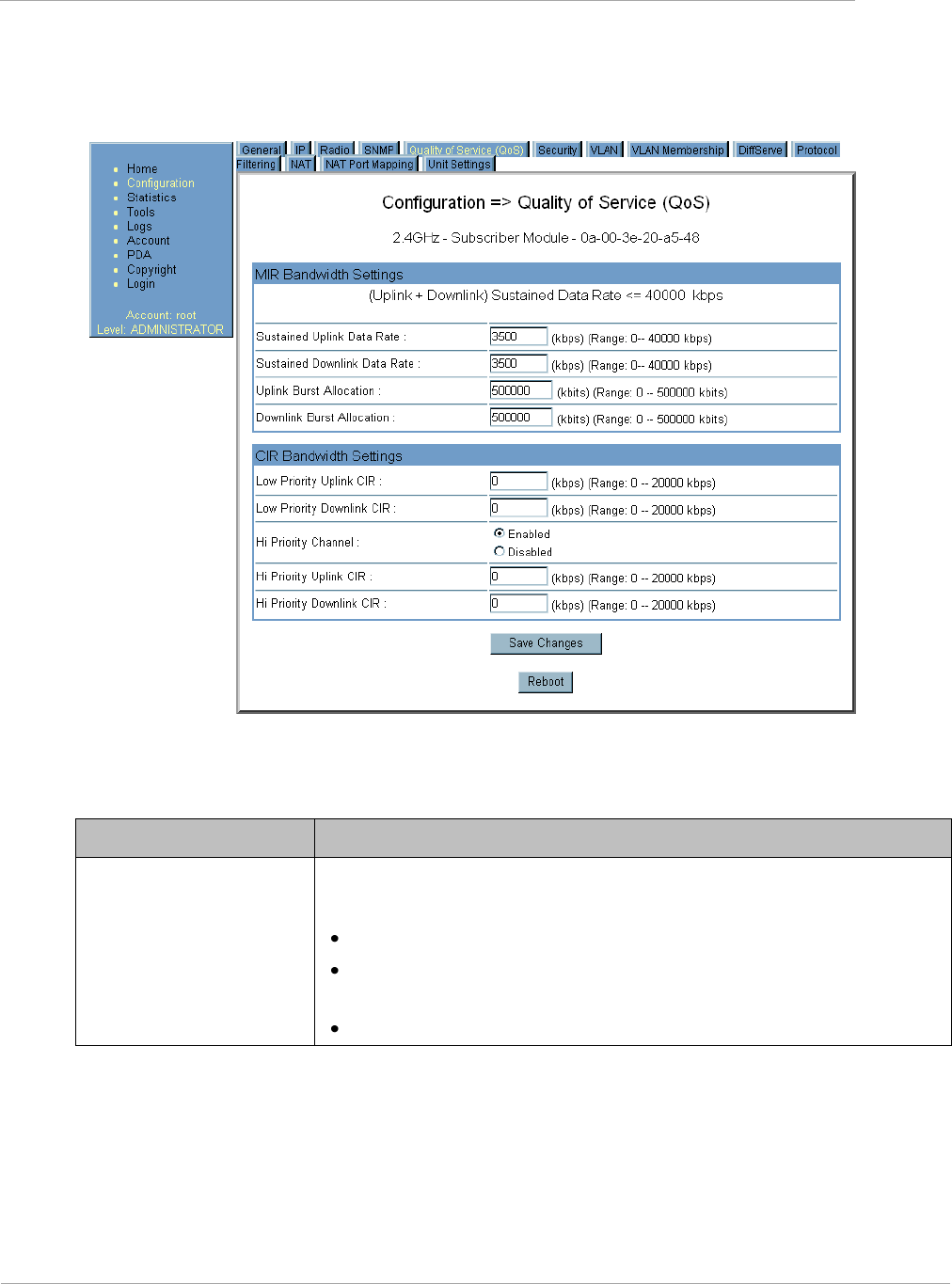
Task 11: Configuring quality of
service
Chapter 2: Configuration and alignment
2-118
pmp-0050 (May 2012)
Quality of Service (QoS) Tab of the SM
Figure 26 Quality of Service (QoS) tab of the SM
In the Quality of Service (QoS) tab of the SM, you may set the following parameters.
Table 55 AP Quality of Service attributes
Attribute
Meaning
Sustained Uplink Data
Rate
Specify the rate that this SM is replenished with credits for transmission. This
default imposes no restriction on the uplink. See
Maximum Information Rate (MIR) Parameters on page 2-106
Interaction of Burst Allocation and Sustained Data Rate Settings on
page 2-108
Configuration Source on page 2-42

PMP 450 Configuration and User Guide
Task 11: Configuring quality of service
pmp-0050 (May 2012)
2-119
Attribute
Meaning
Sustained Downlink Data
Rate
Specify the rate at which the AP should be replenished with credits (tokens)
for transmission to this SM. This default imposes no restriction on the uplink.
See
Maximum Information Rate (MIR) Parameters on Page 2-106
Interaction of Burst Allocation and Sustained Data Rate Settings on
page 2-108
Configuration Source on page 2-42
Uplink Burst Allocation
Specify the maximum amount of data to allow this SM to transmit before
being recharged at the Sustained Uplink Data Rate with credits to transmit
more. See
Maximum Information Rate (MIR) Parameters on page 2-106
Interaction of Burst Allocation and Sustained Data Rate Settings on
page 2-108
Configuration Source on page 2-42
Downlink Burst Allocation
Specify the maximum amount of data to allow the AP to transmit to this SM
before the AP is replenished at the Sustained Downlink Data Rate with
transmission credits. See
Maximum Information Rate (MIR) Parameters on page 2-106
Interaction of Burst Allocation and Sustained Data Rate Settings on
page 2-108
Configuration Source on page 2-42
Low Priority Uplink CIR
See
Committed Information Rate on page 2-107
Configuration Source on page 2-42
Low Priority Downlink
CIR
See
Committed Information Rate on page 2-107
Configuration Source on page 2-42
Hi Priority Channel
See
High-priority Bandwidth on page 2-108
Configuration Source on page 2-42
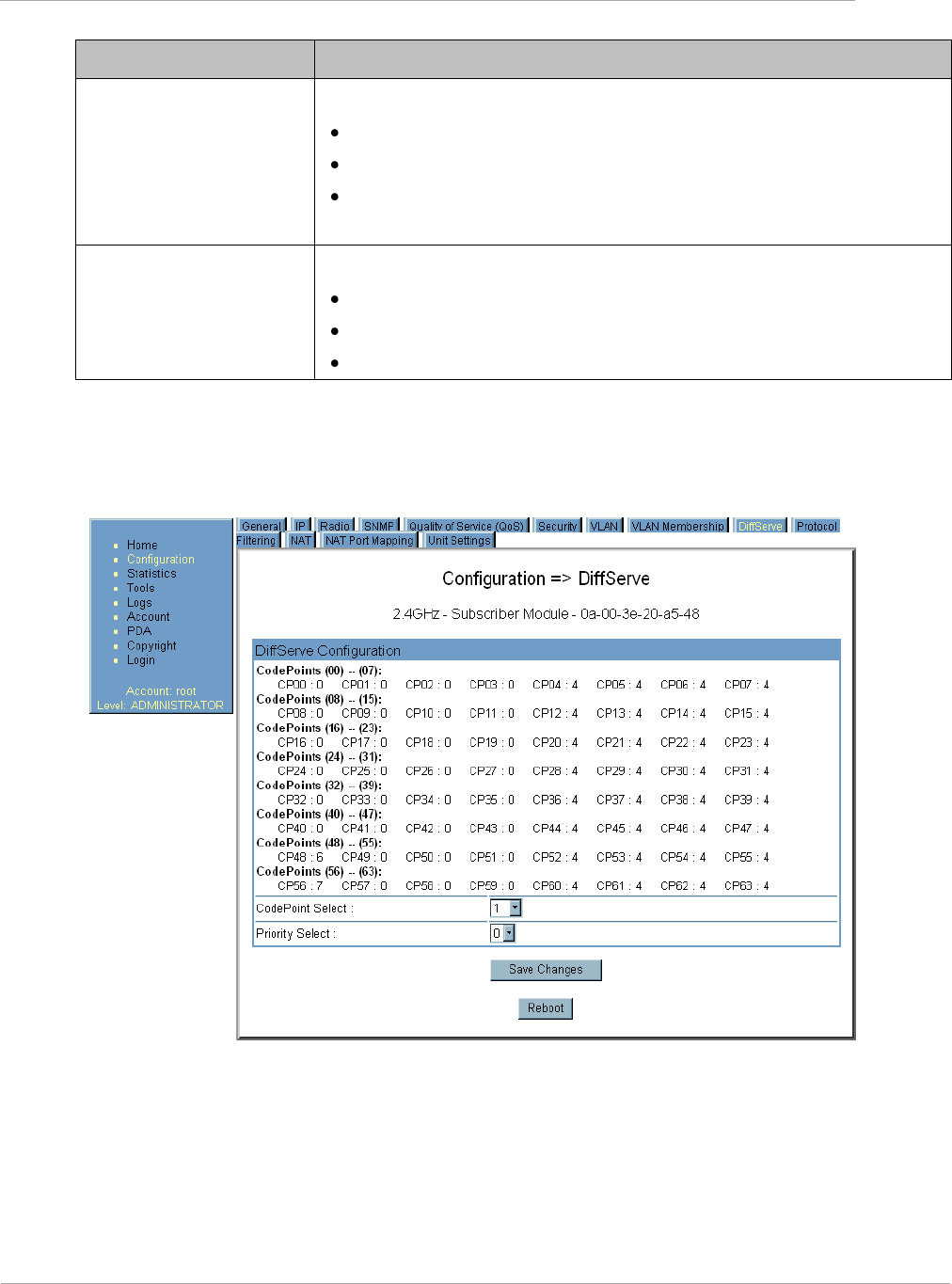
Task 11: Configuring quality of
service
Chapter 2: Configuration and alignment
2-120
pmp-0050 (May 2012)
Attribute
Meaning
Hi Priority Uplink CIR
See
High-priority Bandwidth on page 2-108
Committed Information Rate on page 2-107
Configuration Source on page 2-42.
Hi Priority Downlink CIR
See
High-priority Bandwidth on page 2-108
Committed Information Rate on Page 2-107
Configuration Source on page 2-42.
DiffServ Tab of the SM
Figure 27 Diffserv tab of the SM

PMP 450 Configuration and User Guide
Task 11: Configuring quality of service
pmp-0050 (May 2012)
2-121
In the Diffserv tab of the SM, you may set the following parameters.
Table 56 SM Diffserv attributes
Attribute
Meaning
CodePoint 1
through
CodePoint 47
CodePoint 49
through
CodePoint 55
CodePoint 57
through
CodePoint 63
Priorities of 0 through 3 map to the low-priority channel; 4 through 7 to the
high-priority channel. The mappings are the same as 802.1p VLAN priorities.
Consistent with RFC 2474
CodePoint 0 is predefined to a fixed priority value of 0
(low-priority channel).
CodePoint 48 is predefined to a fixed priority value of 6 (high-priority
channel).
CodePoint 56 is predefined to a fixed priority value of 7 (high-priority
channel).
You cannot change any of these three fixed priority values. Among the
settable parameters, the priority values (and therefore the handling of packets
in the high- or low-priority channel) are set in the AP for all downlinks within
the sector and in the SM for each uplink. See Error! Reference source not
found. on Page Error! Bookmark not defined..

Task 12: Configuring a RADIUS
server
Chapter 2: Configuration and alignment
2-122
pmp-0050 (May 2012)
Task 12: Configuring a RADIUS server
Configuring a RADIUS AAA (Authentication, Authorization, and Accounting) server in a PMP 450 network is
optional, but can provide added security, increase ease of network management and provide usage-based billing
data.
Understanding RADIUS for
PMP 450
PMP 450 modules include support for the RADIUS (Remote Authentication Dial In User
Service)
protocol
supporting Authentication, Authorization, and Accounting (AAA).
RADIUS
Functions
RADIUS protocol support provides the
following
functions:
SM Authentication allows only known SMs onto the network (blocking
―rogue‖
SMs), and can be
configured to ensure SMs are connecting to a known
network
(preventing SMs from connecting to
―rogue‖ APs). RADIUS authentication is
used
for SMs,
but
is not used for APs.
SM Authorization configures authenticated SMs with MIR
(Maximum
Information Rate), CIR
(Committed Information Rate), High Priority, and
VLAN
(Virtual LAN) parameters from the RADIUS
server when an SM registers to
an
AP.
SM Accounting provides support for RADIUS accounting messages for usage-based billing. This
accounting includes indications for subscriber session establishment, subscriber session disconnection, and
bandwidth usage per session for each SM that connects to the AP.
Centralized AP and SM user name and password management allows AP
and
SM usernames and access
levels (Administrator, Installer, Technician) to
be
centrally
administered in the RADIUS server instead
of on each radio and tracks
access
events (logon/logoff) for each username on the RADIUS server. This
accounting does not track and
report
specific configuration actions performed on radios or pull statistics
such as
bit
counts from the radios. Such functions require an Element Management
System
(EMS) such
as Cambium Networks Wireless Manager. This accounting is not the ability to perform accounting
functions on the subscriber/end
user/customer
account.
Framed IP
allows o
perators to use a RADIUS server to assign management IP addressing to SM modules
(framed IP address).
Tested RADIUS Servers
The Canopy RADIUS implementation has been tested and is supported
on
FreeRADIUS, Version
2.1.8
Aradial RADIUS, Version
5.1.12

PMP 450 Configuration and User Guide
Task 12: Configuring a RADIUS server
pmp-0050 (May 2012)
2-123
Note, Aradial 5.3 has a bug that prevents ―remote device login‖, so
doesn‘t
support the user name and
password management
feature.
Choosing Authentication Mode and Configuring for
Authentication
Servers - AP
On the AP‘s Configuration > Security tab, select the RADIUS AAA Authentication Mode. The following
describes the
other
Authentication Mode options for reference, and then the RADIUS AAA
option.
Disabled
: Requires no authentication. Any SM (except an SM that itself has been configured to require
RADIUS authentication by enabling Enforce Authentication as described below) will be allowed to
register
to the
AP.
Authentication Server: Authentication Server in this instance refers to BAM or Prizm. Authentication
will be
required
for an SM to register to the AP. Only SMs listed by MAC address in the BAM or Prizm
database will
be
allowed to register to the
AP.
AP Pre-Shared
Key
: Canopy offers a pre-shared key authentication option. In this case, an identical key
must
be entered in the Authentication Key field on the AP‘s Configuration > Security tab and in the
Authentication Key field on each desired SM‘s Configuration > Security
tab.
RADIUS
AAA
: To support RADIUS authentication of SMs, on the AP‘s Configuration > Security tab
select
RADIUS AAA. Only properly configured SMs with a valid certificate will be allowed to
register
to
the
AP.
When RADIUS AAA is selected, up to 3 Authentication Server (RADIUS Server)
IP
addresses
and Shared
Secrets can be configured. The IP address(es) configured here
must
match the IP address(es) of the RADIUS
server(s). The shared secret(s) configured here
must
match the shared secret(s) configured in the RADIUS
server(s). Servers 2 and 3 are meant
for
backup and reliability, not splitting the database. If Server 1 doesn‘t
respond, Server 2 is
tried,
and then
server
3. If Server 1 rejects authentication, the SM is denied entry to the
network, and does
not
progress trying the other
servers.
The default IP address is 0.0.0.0.
The
default Shared Secret is ―CanopySharedSecret‖. The Shared Secret can
be up to 32
ASCII
characters (no diacritical marks or ligatures, for
example).
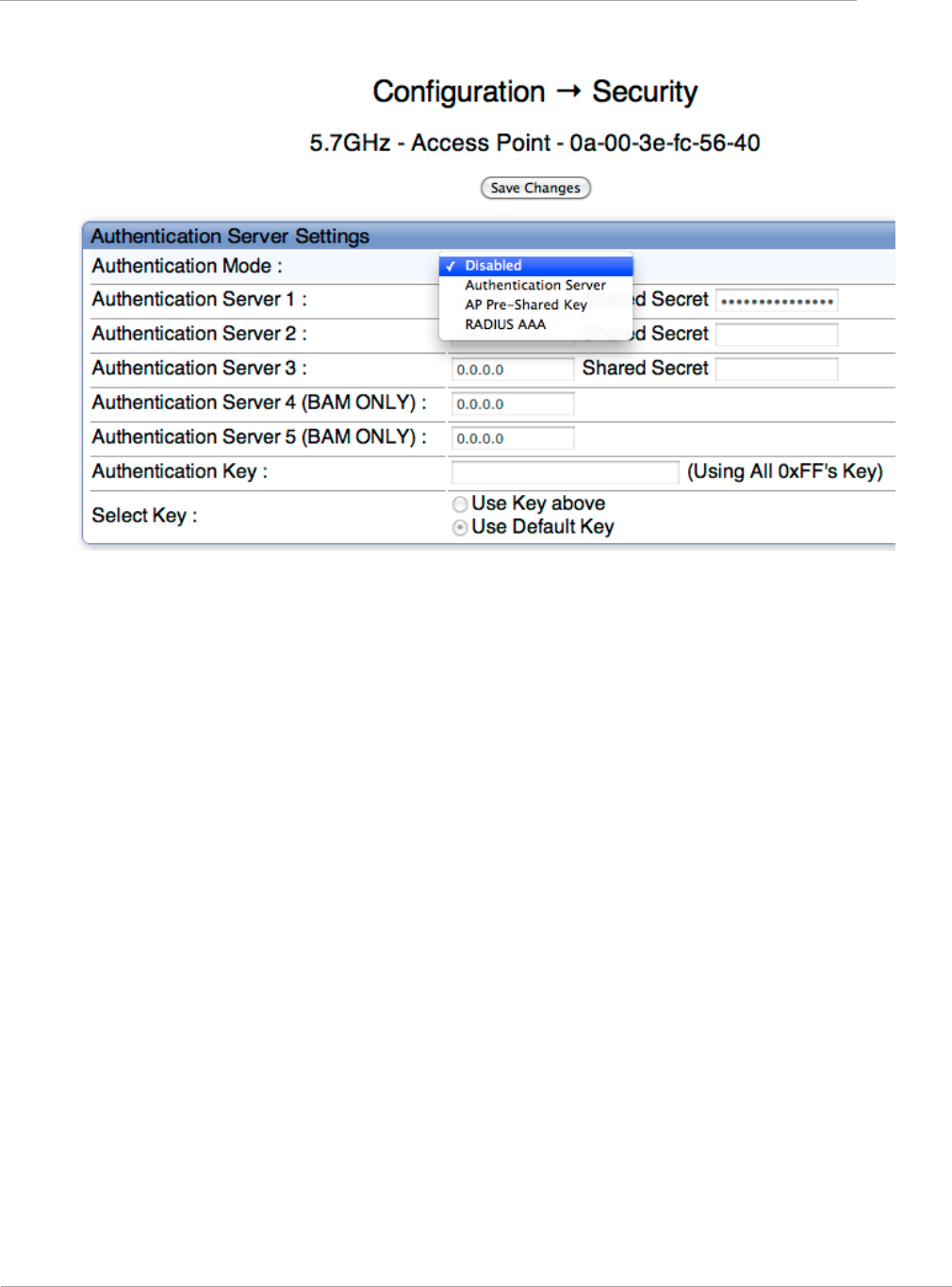
Task 12: Configuring a RADIUS
server
Chapter 2: Configuration and alignment
2-124
pmp-0050 (May 2012)
Figure 28 Security tab of the AP
SM Authentication Mode – Require RADIUS or Follow
AP
If it is desired that an SM will only authenticate to an AP that is using RADIUS, on the
SM‘s
Configuration
Security tab set Enforce Authentication to AAA. With this enabled, an SM
will
not register to an AP that
has any Authentication Mode other than RADIUS AAA
selected
.
If it is desired that an SM use the authentication method configured on the AP it is
registering
to, set
Enforce Authentication to Disabled. With Enforce Authentication disabled, an SM will attempt to register
using
whichever Authentication Mode is configured on the AP it is attempting to register
to.
Note, requiring SMs to use RADIUS by enabling Enforce Authentication avoids the security issue of SMs
possibly registering to ―rogue‖ APs which have authentication
disabled.
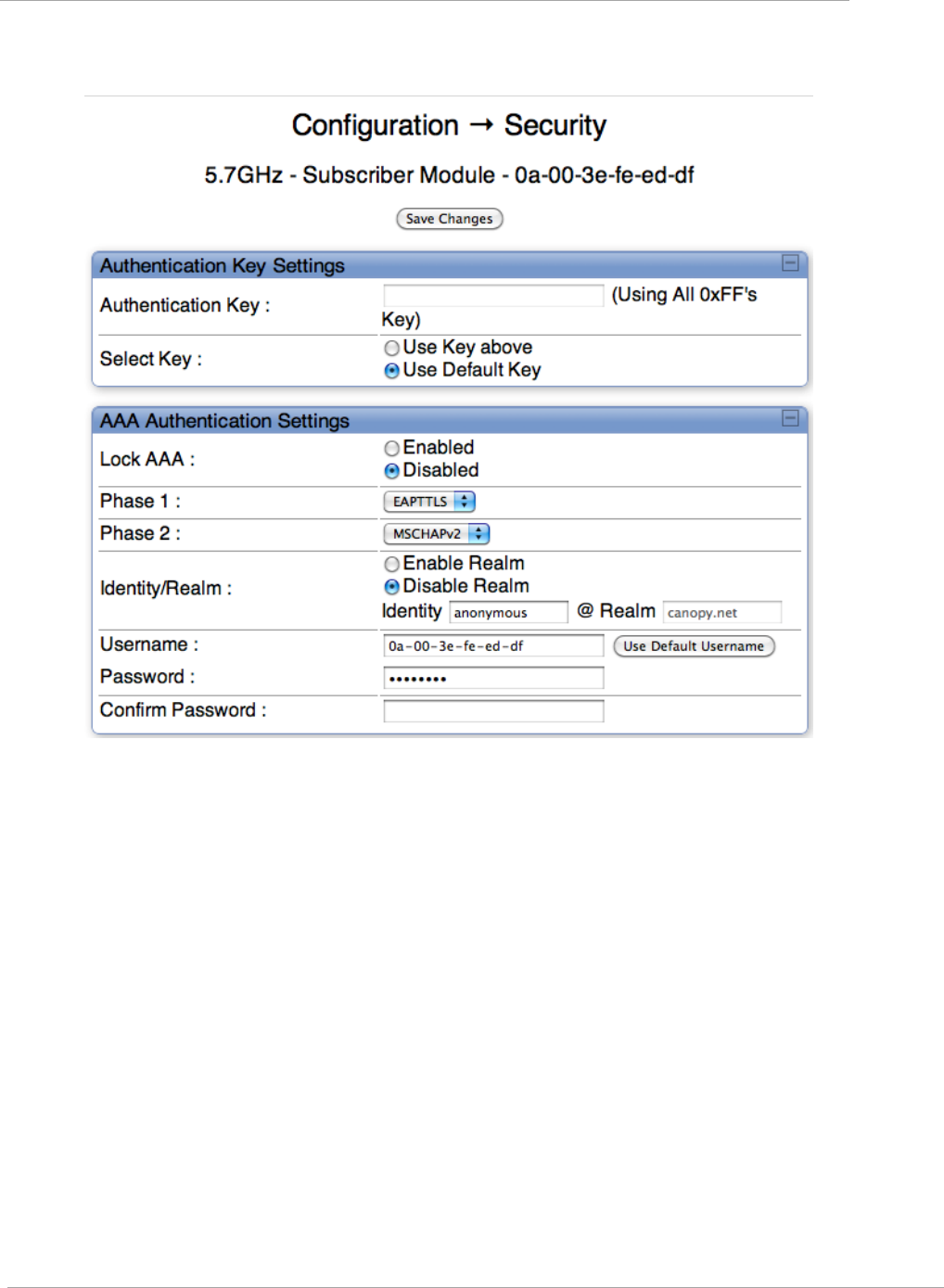
PMP 450 Configuration and User Guide
Task 12: Configuring a RADIUS server
pmp-0050 (May 2012)
2-125
Figure 29 Security tab of the SM
SM - Phase 1 (Outside Identity) parameters and
settings
The protocols supported for the Phase 1 (Outside Identity) phase of authentication
are
eapttls (Extensible Authentication Protocol Tunneled Transport Layer
Security) and
eapMSChapV2
(Extensible Authentication Protocol – Microsoft Challenge-Handshake Authentication Protocol).
Configure an outer Identity in the Username field. This must match the Phase
1/Outer
Identity username
configured in the RADIUS server. The default Phase 1/Outer
Identity
Username is ―anonymous‖. The
Username can be up to 128 non-special (no
diacritical
markings) alphanumeric
characters.
If Realms are
being used in the RADIUS system (eapttls only), select Enable Realm and configure an outer identity in the
Identity field and a Realm in the Realm field. These must match the Phase 1/Outer Identity and Realm
configured in the RADIUS server. The default Identity is ―anonymous‖. The Identity can be up to 128 non-special
(no diacritical markings) alphanumeric characters. The default Realm is ―canopy.net‖. The Realm can also be up
to 128 non-special alphanumeric characters.

Task 12: Configuring a RADIUS
server
Chapter 2: Configuration and alignment
2-126
pmp-0050 (May 2012)
SM - Phase 2 (Inside Identity) parameters and
settings
If using eapttls for Phase 1 authentication, select the desired Phase 2 (Inside Identity) authentication
protocol from the Phase 2 options of PAP (Password Authentication Protocol), CHAP (Challenge Handshake
Authentication
Protocol), and MSCHAPv2 (Microsoft‘s version of CHAP). The protocol
must
be
consistent
with the authentication protocol configured on the RADIUS
server.
Enter a Username for the SM. This
must match the username configured for the SM on
the
RADIUS server. The default Username is the SM‘s
MAC address. The Username can be up
to
128 non-special (no diacritical markings) alphanumeric
characters.
Enter the desired password for the SM in the Password and Confirm Password fields..
The
Password must
match the password configured for the SM on the RADIUS server.
The
default Password is ―password‖. The
Password can be up to 128 non-special (no
diacritical
markings) alphanumeric
characters.
Handling Certificates
Managing SM Certificates via the SM GUI
The default public Canopy certificates are loaded into SMs upon factory software installation. The default
certificates are not secure and are intended for
use
during lab and field trials as part of gaining experience
with the RADIUS functionalities or as
an
option during debug. For secure operation, an operator will want
to create or procure their
own
certificates.
Up to 2 certificates can be resident on an SM. An installed certificate can be deleted
by
clicking the Delete
button in the certificate‘s description block on the Configuration >
Security
tab. To restore fhe 2 default
certificates, click the Use Default Certificates button in
the
RADIUS Certificate Settings parameter block and
reboot the
radio.
To upload a certificate manually to an SM, first load it in a known place on your PC
or
network
drive, then
click on a Delete button on one of the Certificate description blocks to delete a certificate to provide space for
your certificate. Click on Choose File, browse to
the
location of the certificate, and click the Import Certificate
button, and then reboot the radio to use the new certificate.
When a certificate is in use, after the SM successfully registers to an AP, an indication of In
Use
will appear
in the description block of the certificate being
used.
The public certificates installed on the SMs are used with the private certificate on the
RADIUS
server to
provide a public/private key encryption
system.
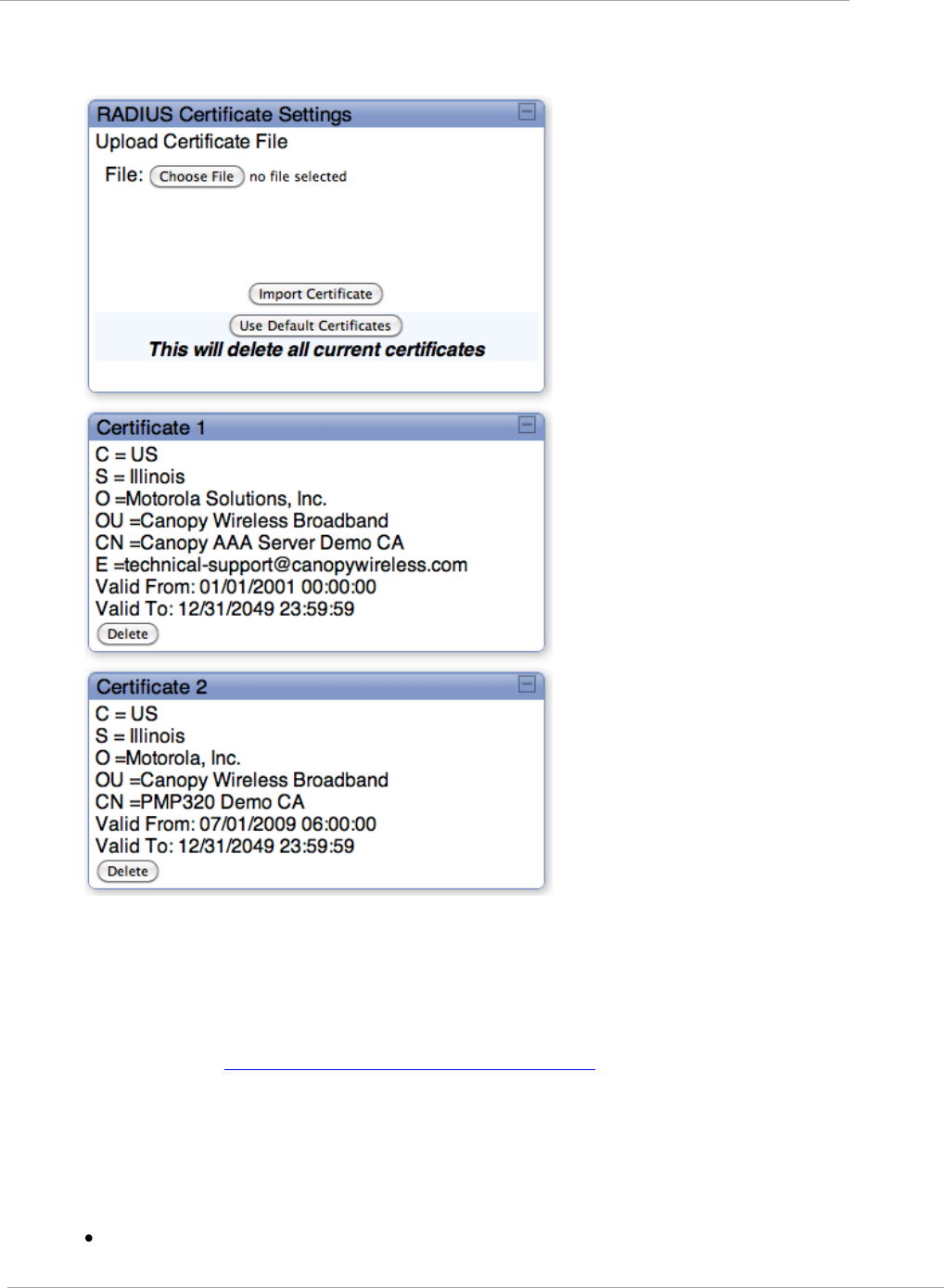
PMP 450 Configuration and User Guide
Task 12: Configuring a RADIUS server
pmp-0050 (May 2012)
2-127
Figure 30 SM Certificate Management
Using CNUT to distribute certificates to
SMs
CNUT Release 4.0 supports distribution of certificates to SMs. Please see the
CNUT
documentation for additional
information (the CNUT documentation may be found on the Cambium
support website http://www.cambiumnetworks.com/support).
Configuring your RADIUS servers for SM authentication
Your RADIUS server will need to be configured to use the
following:
EAPTTLS or MSCHAPv2 as the Phase 1/Outer Identity
protocol.
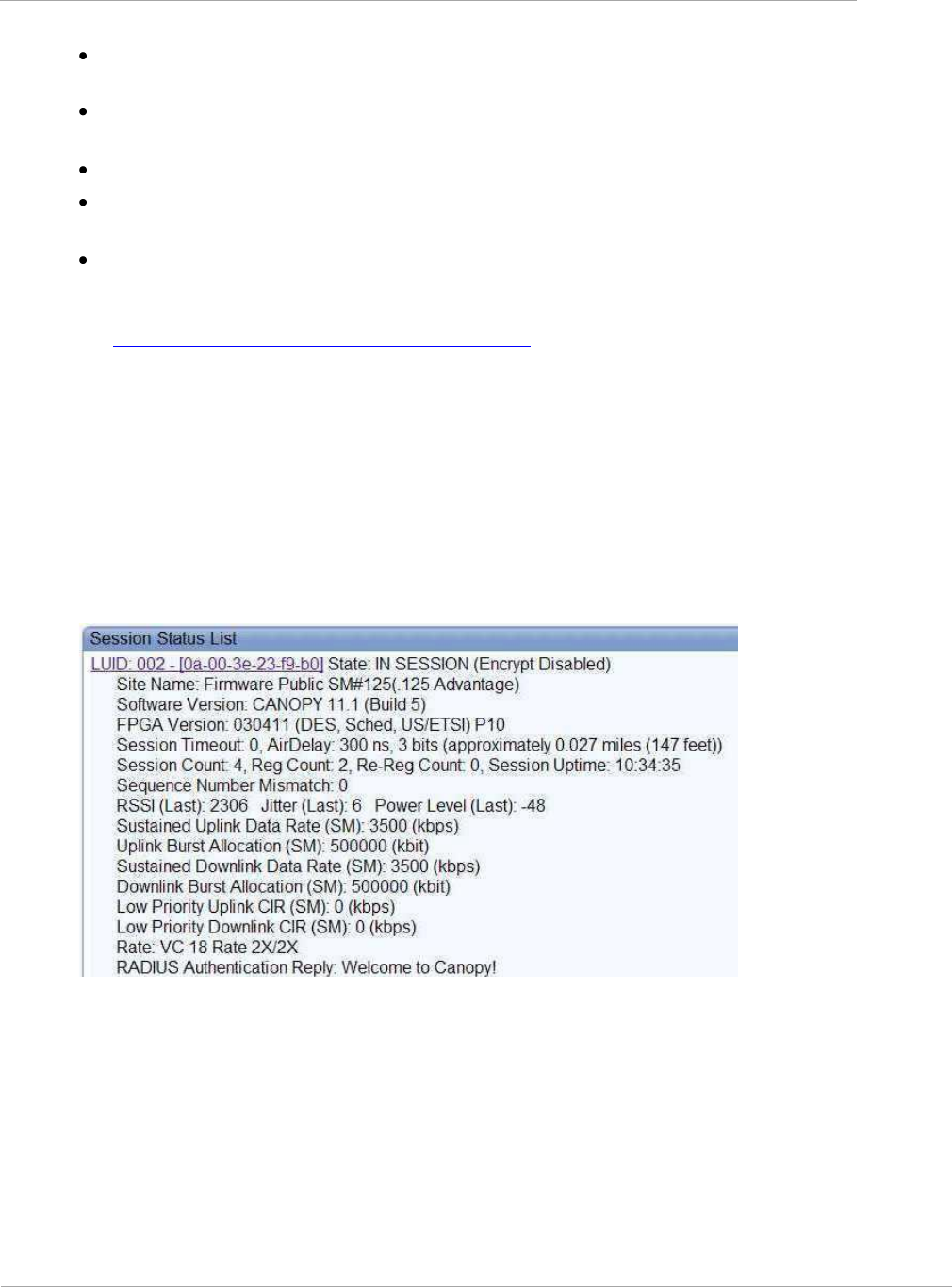
Task 12: Configuring a RADIUS
server
Chapter 2: Configuration and alignment
2-128
pmp-0050 (May 2012)
If Enable Realm is selected on the SM‘s Configuration > Security tab, then the
same
Realm as appears there (or access to it).
The same Phase 2 (Inner Identity) protocol as configured on the SM‘s
Configuration
> Security tab under
Phase 2 options.
The username and password for each SM configured on each SM‘s
Configuration
> Security
tab.
An IP address and NAS shared secret that is the same as the IP address and Shared Secret configured on
the AP‘s Configuration > Security tab for
that
RADIUS server.
A server private certificate, server key, and CA certificate that complement
the
public certificates
distributed to the SMs, as well as the Canopy dictionary file
that
defines Vendor Specific Attributes
(VSAa). Default certificate files and
the
dictionary
file are available from the software
site:
www.cambiumnetworks.com/support/pmp/software/ after entering your
name,
email address, and either
Customer Contract Number or the MAC address of
a
module covered under the 12 month
warranty.
Optionally, operators may configure the RADIUS server response messages (Accept or Reject) so that the user
has information as to why they have been rejected. The AP displays the RADIUS Authentication Reply
message strings in the Session Status list as part of each SM‘s information. The SM will show this string (listed
as Authentication Response on the SM GUI )on the main Status page in the Subscriber Module Stats section.
(Note: Aradial AAA servers only support operator-configurable Authentication Accept responses, not
Authentication Reject responses).
Figure 31 AP display of RADIUS accept for SM
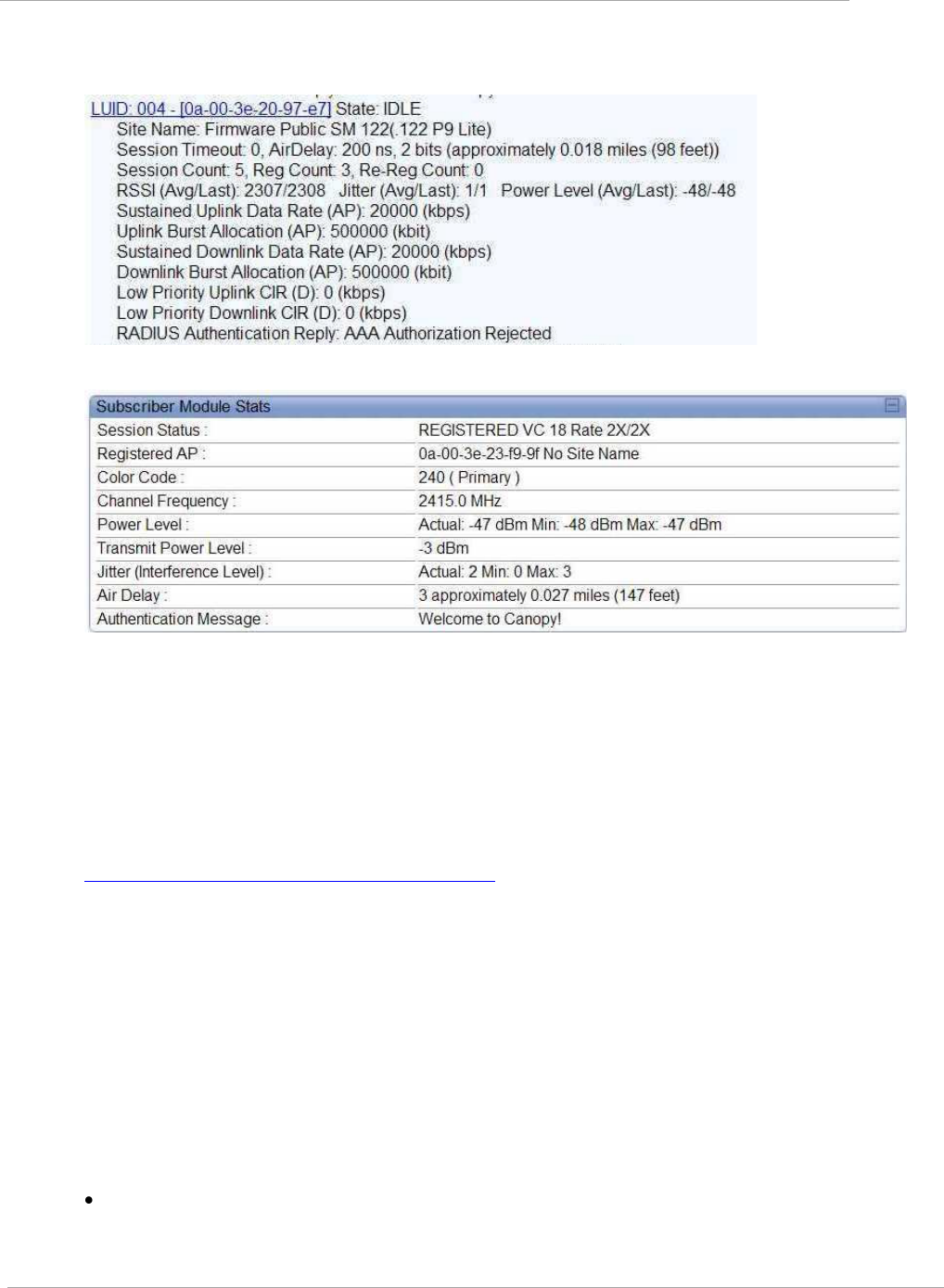
PMP 450 Configuration and User Guide
Task 12: Configuring a RADIUS server
pmp-0050 (May 2012)
2-129
Figure 32 AP display of RADIUS rejected SM
Figure 33 SM display of RADIUS accpet
Configuring your RADIUS server for SM configuration
Table 57 lists Canopy Vendor Specific Attributes (VSAs) along with VSA numbers and
other
details. The
associated SM GUI page, tab, and parameter is listed to aid
cross-referencing
and understanding of the
VSAs.
A RADIUS dictionary file is available from the software
site:
www.cambiumnetworks.com/support/pmp/software/
The RADIUS dictionary file
defines
the VSAs and their values and is usually imported into the RADIUS
server as part of
server
and database
setup.
Assigning SM management IP addressing via RADIUS
Operators may use a RADIUS AAA server to assign management IP addressing to SM modules (framed IP
address). SMs now interpret attributes Framed-IP-Address, Framed-IP-Netmask, and Motorola-Canopy-
Gateway from RADIUS. The RADIUS dictionary file has been updated to include the Motorola-Canopy-
Gateway attribute and is available on the Motorola Software Support website.
In order for these attributes to be assigned and used by the SM, the following must be true:
The Canopy system is configured for AAA authentication

Task 12: Configuring a RADIUS
server
Chapter 2: Configuration and alignment
2-130
pmp-0050 (May 2012)
The SM is not configured for DHCP on its management interface. If DHCP is enabled and these attributes
are configured in the RADIUS server, the attributes will be ignored by the SM.
The SM management interface must be configured to be publically accessible. If the SM is configured to
have local accessibility, the management interface will still be assigned the framed addressing, and the SM
will become publicly accessible via the assigned framed IP addressing.
When using these attributes, for the addressing to be implemented by the SM operators must configure
Framed-IP-Address in RADIUS. If Framed-IP-Address is not configured but Framed-IP-Netmask and/or
Motorola-Canopy-Gateway is configured, the attributes will be ignored. In the case where only the
Framed-IP-Address is configured, Framed-IP-Netmask defaults to 255.255.0.0 (NAT disabled) /
255.255.255.0 (NAT enabled) and Motorola-Canopy-Gateway defaults to 0.0.0.0.
Table 57 RADIUS Vendor Specific Attributes (VSAs)
Name
Number
Type
Req’d
Value
SM GUI Page > Tab >
Parameter
Default
Size
MS-MPPE-Send-Key
26.311.16
-
Y
-
-
-
-
MS-MPPE-Recv-Key
26.311.17
-
Y
-
-
-
-
Motorola-Canopy-LPULCIR
26.161.1
integer
N
0-20000
kbps
Configuration > Quality of Service > Low Priority Uplink
CIR
0
kbps
32
bits
Motorola-Canopy-LPDLCIR
26.161.2
integer
N
0-20000
kbps
Configuration > Quality of Service > Low Priority Downlink
CIR
0
kbps
32
bits
Motorola-Canopy-HPULCIR
26.161.3
integer
N
0-20000
kbps
Configuration > Quality of Service > Hi Priority Uplink
CIR
0
kbps
32
bits
Motorola-Canopy-HPDLCIR
26.161.4
integer
N
0-20000
kbps
Configuration > Quality of Service > Hi Priority Uplink
CIR
0
kbps
32
bits
Motorola-Canopy-HPENABLE
26.161.5
integer
N
0-disable,
1-enable
Configuration > Quality of Service > Hi Priority
Channel
Enable/Disable
0
32
bits
Motorola-Canopy-ULBR
26.161.6
integer
N
0-50000+
kbps
Configuration > Quality of Service > Sustained Uplink
Data
Rate
dependent
on
radio feature
set
32
bits
Motorola-Canopy-ULBL
26.161.7
integer
N
0-50000+
kbps
Configuration > Quality of Service > Uplink Burst
Allocation
dependent
on
radio feature
set
32
bits
Motorola-Canopy-DLBR
26.161.8
integer
N
0-50000+
kbps
Configuration > Quality of Service > Sustained Downlink
Data
Rate
dependent
on
radio feature
set
32
bits
Motorola-Canopy-DLBL
26.161.9
integer
N
0-50000+
kbps
Configuration > Quality of Service > Downlink Burst
Allocation
dependent
on
radio feature
set
32
bits

PMP 450 Configuration and User Guide
Task 12: Configuring a RADIUS server
pmp-0050 (May 2012)
2-131
Motorola-Canopy-
VLLEARNNEN
26.161.14
integer
N
0-disable,
1-enable
Configuration > VLAN > Dynamic
Learning
1
32
bits
Motorola-Canopy-VLFRAMES
26.161.15
integer
N
0-all, 1-tagged,
2-untagged
Configuration > VLAN > Allow Frame
Types
0
32
bits
Motorola-Canopy-VLIDSET
26.161.16
integer
N
VLAN Membership
(1-4094)
Configuration > VLAN
Membership
0
32
bits
Motorola-Canopy-VLAGETO
26.161.20
integer
N
5 - 1440
minutes
Configuration > VLAN > VLAN Aging
Timeout
25
mins
32
bits
Motorola-Canopy-VLIGVID
26.161.21
integer
N
1 –
4094
Configuration > VLAN > Default Port
VID
1
32
bits
Motorola-Canopy-VLMGVID
26.161.22
integer
N
1 –
4094
Configuration > VLAN > Management
VID
1
32
bits
Motorola-Canopy-VLSMMGPASS
26.161.23
integer
N
0-disable,
1-enable
Configuration > VLAN > SM Management VID
Pass-through
1
32
bits
Motorola-Canopy-BCASTMIR
26.161.24
integer
N
0-50000+ kbps,
0=disabled
Configuration > Quality of Service > Broadcast/Multicast
Uplink
Data
Rate
dependent
on
radio feature
set
32
bits
Motorola-Canopy-Gateway
26.161.25
ipaddr
N
-
Configuration > IP > Gateway IP Address
0.0.0.0
-
Motorola-Canopy-UserLevel
26.161.50
integer
N
1-Technician,
2-Installer,
3-Administrator
Account > Add User >
Level
0
32
bits
Note about VSA
numbering:
26 connotes Vendor Specific Attribute, per RFC
2865
26.311 is Microsoft Vendor Code, per
IANA
26.161 is Motorola Vendor Code, per
IANA
Using RADIUS for centralized AP and SM user name and password
management
AP – Technician/Installer/Administrator
Authentication
To control technician, installer, and administrator access to the AP from a centralized
RADIUS server:
1
Set Authentication Mode on the AP‘s Configuration > Security tab to RADIUS AAA
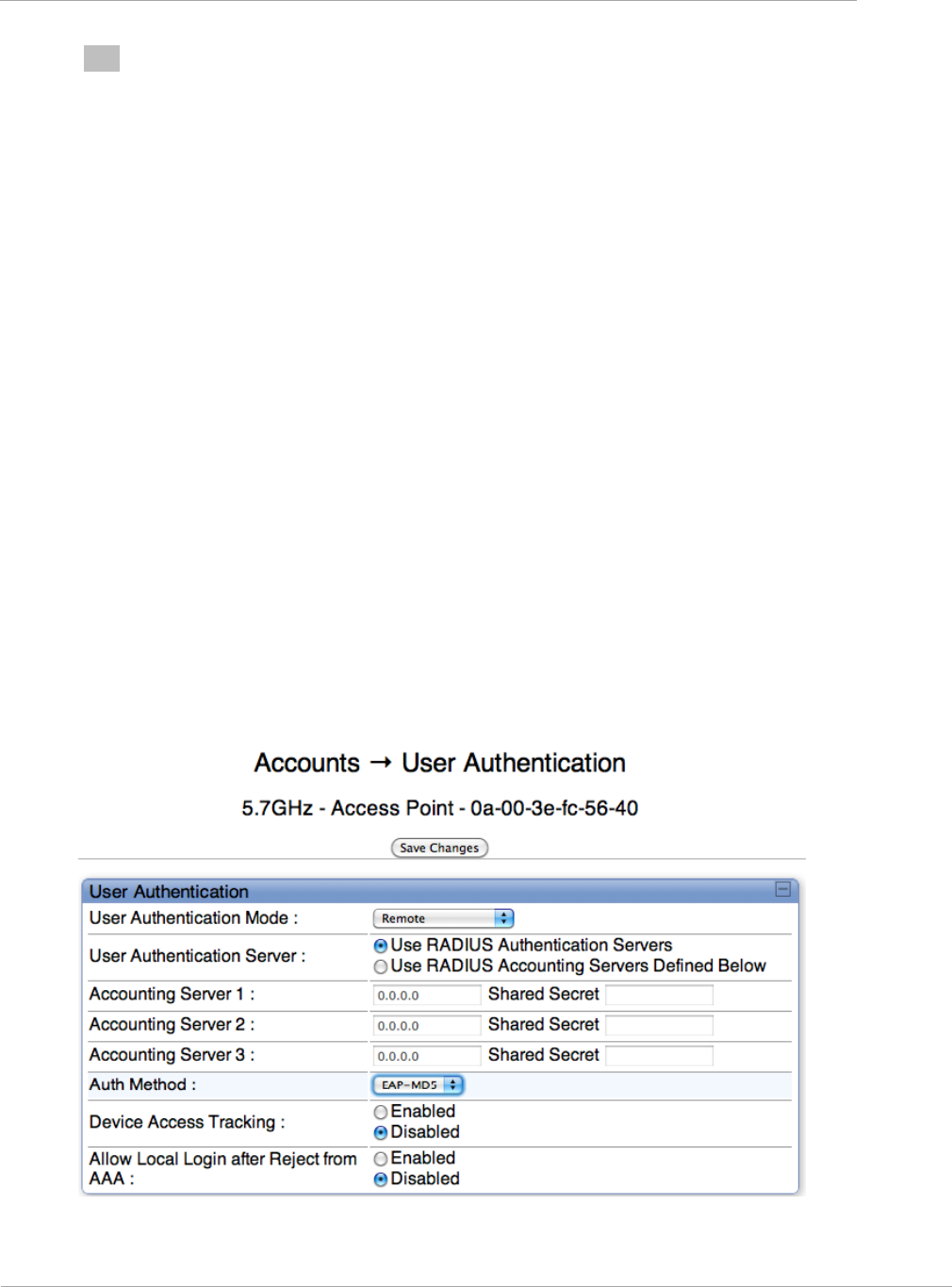
Task 12: Configuring a RADIUS
server
Chapter 2: Configuration and alignment
2-132
pmp-0050 (May 2012)
2
Set User Authentication Mode on the AP‘s Account > User Authentication
tab
(the tab only
appears after the AP is set to RADIUS authentication) to
Remote
or Remote then
Local
.
•
Local: The local SM is checked for accounts. No centralized
RADIUS
accounting (access control)
is
performed.
•
Remote: Authentication by the centralized RADIUS server
is
required to gain access to
the SM if the SM is registered to an
AP
that has RADIUS AAA Authentication Mode
selected. For up to
2
minutes a test pattern will be displayed until the server responds
or
times
out.
•
Remote then Local: Authentication using the centralized
RADIUS
server is attempted. If
the server sends a reject message, then
the
setting of Allow Local Login after Reject from
AAA determines
if
the local user database is checked or not. If the configured
servers
do
not
respond within 2 minutes, then the local user database
is
used. The successful login method is
displayed in the
navigation
column of the SM.
Either the same RADIUS server used for SM authentication and authorization can be
used
for user
authentication and accounting (access control), or a separate RADIUS
accounting
server can be used.
Indicate your network design under User Authentication
Server
.
If separate accounting server(s) are used, configure the IP address(es) and Shared
Secret
(s)
in the Accounting
Server fields. The default Shared Secret is ―CanopyAcctSecret‖. Up to
3
servers can be used for redundancy.
Servers 2 and 3 are meant for backup and reliability,
not
splitting the database. If Server 1 doesn‘t respond, Server 2 is tried, and then server 3.
If
Server
1 rejects
authentication, Server 2 is not
tried.
Figure 34 User Authentication tab of the AP

PMP 450 Configuration and User Guide
Task 12: Configuring a RADIUS server
pmp-0050 (May 2012)
2-133
SM – Technician/Installer/Administrator
Authentication
To control technician, installer, and administrator access to the SM from a centralized
RADIUS
server:
1
Set Authentication Mode on the AP‘s Configuration > Security tab to
AAA
(RADIUS)
2
Set User Authentication Mode on the AP‘s Account > User
Authentication
and
Accounting tab
(the tab only appears after the AP is set to AAA authentication) to Remote or Remote then
Local
.
3
Set User Authentication Mode on the SM‘s Account > User
Authentication
and Accounting tab to
Remote or Remote then Local.
•
Local: The local SM is checked for accounts. No centralized
RADIUS
accounting (access control)
is
performed.
•
Remote: Authentication by the centralized RADIUS server
is
required to gain access to
the SM if the SM is registered to an
AP
that has RADIUS AAA Authentication Mode
selected. For up to
2
minutes a test pattern will be displayed until the server responds
or
times
out.
•
Remote then Local: Authentication using the centralized
RADIUS
server is attempted. If
the server sends a reject message, then
the
setting of Allow Local Login after Reject from
AAA determines
if
the local user database is checked or not. If the configured
servers
do
not
respond within 2 minutes, then the local user database
is
used. The successful login method is
displayed in the
navigation
column of the SM.
Note, remote access control is enabled only after the SM registers to an AP that
has
Authentication Mode set
to RADIUS AAA. Local access control will always be
used
before registration and will be used after
registration if the AP is not configured
for
RADIUS.
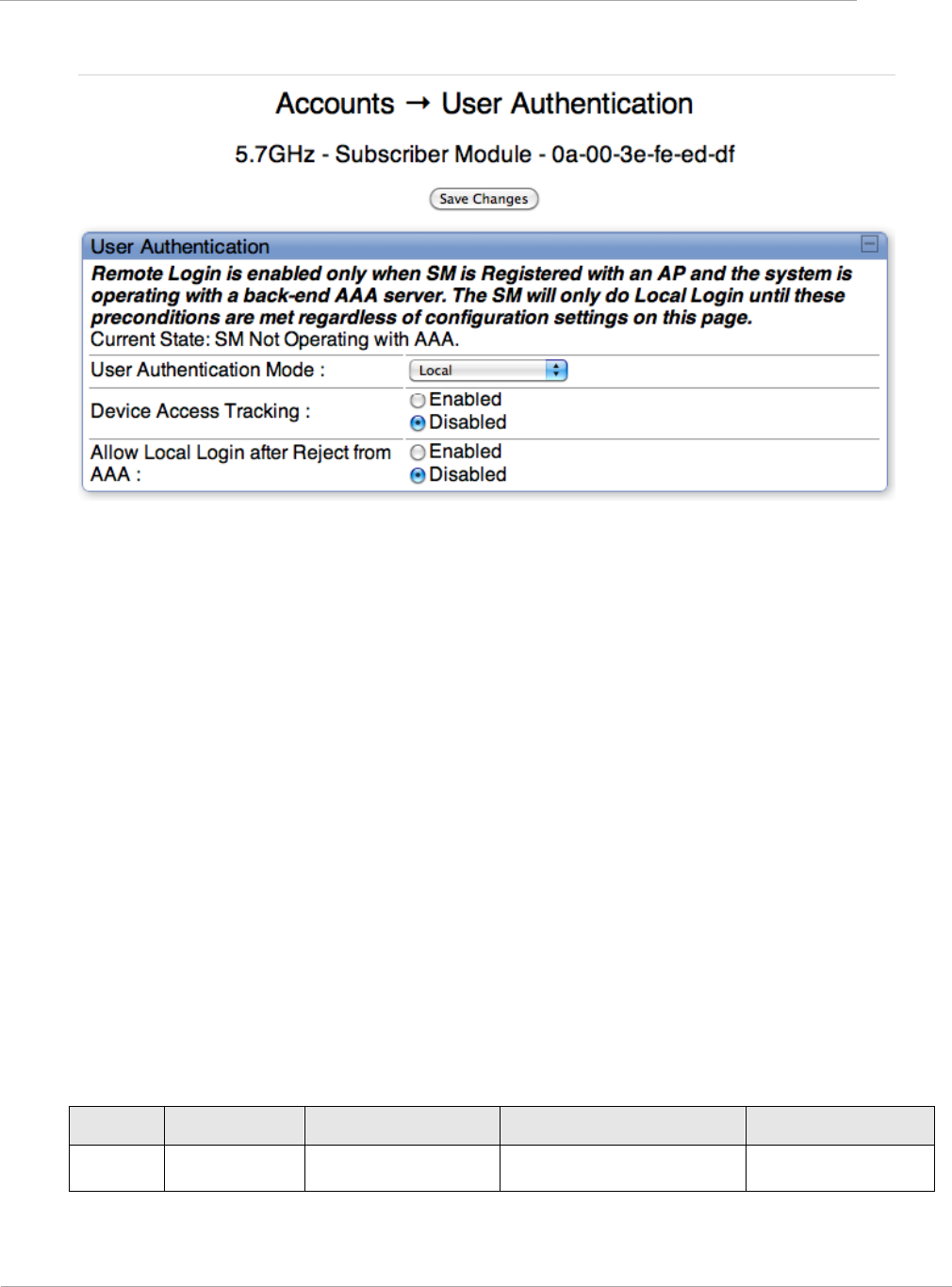
Task 12: Configuring a RADIUS
server
Chapter 2: Configuration and alignment
2-134
pmp-0050 (May 2012)
Figure 35 User Authentication tab of the SM
Access
Tracking
To track logon and logoff times on individual radios by technicians, installers, and administrators, on the AP
or SM‘s Account > User Authentication and Accounting tab
under
Accounting (Access Tracking) choose
Enabled.
Device Access Tracking is enabled separately from User Authentication Mode. A given AP
or
SM can be configured for both, either, or
neither.
RADIUS Device Data Accounting
PMP 450 systems include support for RADIUS accounting messages for usage-based billing. This accounting
includes indications for subscriber session establishment, subscriber session disconnection, and bandwidth
usage per session for each SM that connects to the AP. The attributes included in the RADIUS accounting
messages are shown in the table below.
Table 58 Device data accounting RADIUS attributes
Sender
Message
Attribute
Value
Description
AP
Accounting-
Acct-Status-Type
1 - Start
This message is sent

PMP 450 Configuration and User Guide
Task 12: Configuring a RADIUS server
pmp-0050 (May 2012)
2-135
Sender
Message
Attribute
Value
Description
Request
Acct-Session-Id
Unique per AP session.
Initial value is SM MAC,
and increments after every
start message sent of an in
session SM.
every time an SM
registers with an AP,
and after the SM
stats are cleared.
Event-Timestamp
UTC time the event
occurred on the AP
AP
Accounting-
Request
Acct-Status-Type
2 - Stop
This message is sent
every time an SM
becomes unregistered
with an AP, and
when the SM stats
are cleared.
Acct-Session-Id
Unique per AP session.
Initial value is SM MAC,
and increments after every
start message sent of an in
session SM.
Acct-Input-Octets
Sum of the input octets
received at the SM over
regular data VC and the
high priority data VC (if
enabled). Will not include
broadcast.
Acct-Output-Octets
Sum of the output octets
sent from the SM over
regular data VC and the
high priority data VC (if
enabled).
Acct-Input-
Gigawords
Number of times the Acct-
Input-Octets counter has
wrapped around 2^32 over
the course of the session
Acct-Output-
Gigawords
Number of times the Acct-
Output-Octets counter has
wrapped around 2^32 over
the course of the session
Acct-Input-Packets
Sum of unicast and
multicast packets that are
sent to a particular SM over
the regular data VC and the
high priority data VC (if
enabled). It will not include
broadcast.

Task 12: Configuring a RADIUS
server
Chapter 2: Configuration and alignment
2-136
pmp-0050 (May 2012)
Sender
Message
Attribute
Value
Description
Acct-Output-Packets
Sum of unicast and
multicast packets that are
sent from a particular SM
over the regular data VC
and the high priority data
VC (if enabled).
Acct-Session-Time
Uptime of the SM session.
Acct-Terminate-
Cause
Reason code for session
termination
AP
Accounting-
Request
Acct-Status-Type
3 - Interim-Update
This message is sent
periodically per the
operator
configuration on the
AP in seconds.
Interim update
counts are
cumulative over the
course of the session
Acct-Session-Id
Unique per AP session.
Initial value is SM MAC,
and increments after every
start message sent of an in
session SM.
Acct-Input-Octets
Sum of the input octets sent
to the SM over regular data
VC and the high priority
data VC (if enabled). Will
not include broadcast.
Acct-Output-Octets
Sum of the output octets set
from the SM over regular
data VC and the high
priority data VC (if
enabled).
Acct-Input-
Gigawords
Number of times the Acct-
Input-Octets counter has
wrapped around 2^32 over
the course of the session
Acct-Output-
Gigawords
Number of times the Acct-
Output-Octets counter has
wrapped around 2^32 over
the course of the session
Acct-Session-Time
Uptime of the SM session.
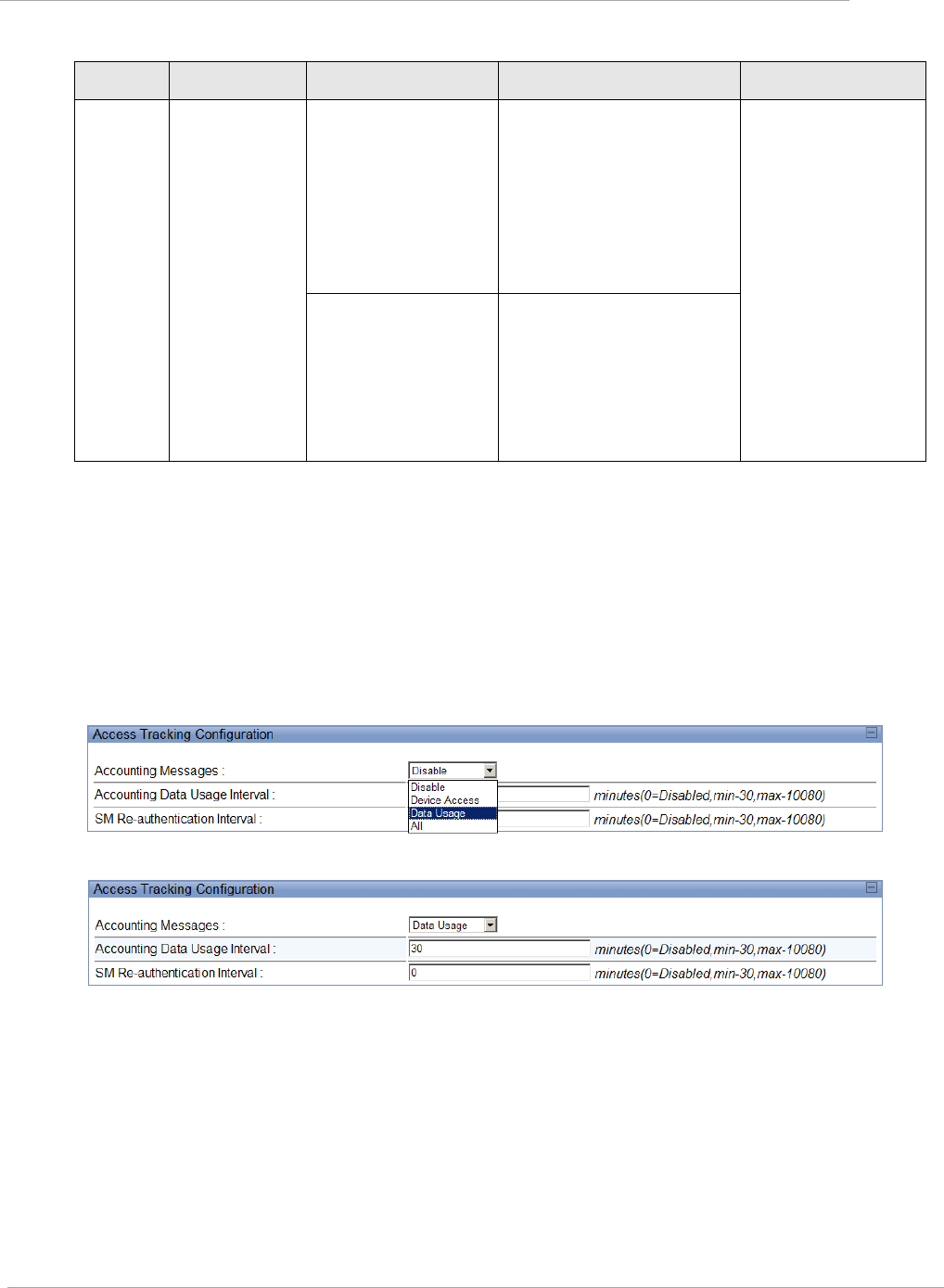
PMP 450 Configuration and User Guide
Task 12: Configuring a RADIUS server
pmp-0050 (May 2012)
2-137
Sender
Message
Attribute
Value
Description
Acct-Input-Packets
Sum of unicast and
multicast packets that are
sent to a particular SM over
the regular data VC and the
high priority data VC (if
enabled). It will not include
broadcast.
Acct-Output-Packets
Sum of unicast and
multicast packets that are
sent from a particular SM
over the regular data VC
and the high priority data
VC (if enabled).
The data accounting configuration is located on the AP‘s Accounts > User Authentication and Access Tracking
GUI menu, and the AP‘s Authentication Mode must be set to Radius AAA for the menu to appear. The
accounting may be configured via the AP GUI as shown in the figures below. By default accounting messages
are not sent and the operator has the choice of configuring to send only Device Access accounting messages
(when a user logs in or out of the radio), only Data Usage messages, or both. When Data Accounting is
enabled, the operator must specify the interval of when the data accounting messages are sent (0 – disabled, or
in the range of 30-10080 minutes). The default interval is 30 minutes.
Table 59 RADIUS accounting messages configuration
Table 60 RADIUS data accounting message interval
The data accounting message data is based on the SM statistics that the AP maintains, and these statistics may
be cleared on the AP by an operator. If an operator clears these messages and data accounting is enabled, an
accounting stop message is sent followed by an accounting start message to notify the AAA of the change.
If an operator clears the VC statistics on the device through the management GUI, a RADIUS stop message
and data start message will be issued for each device affected. The start and stop messages will only be sent
once every 5 minutes, so if an operator clears these statistics multiple times within 5 minutes, only one set of
data stop/start messages will be sent. This may result in inaccurate data accumulation results.
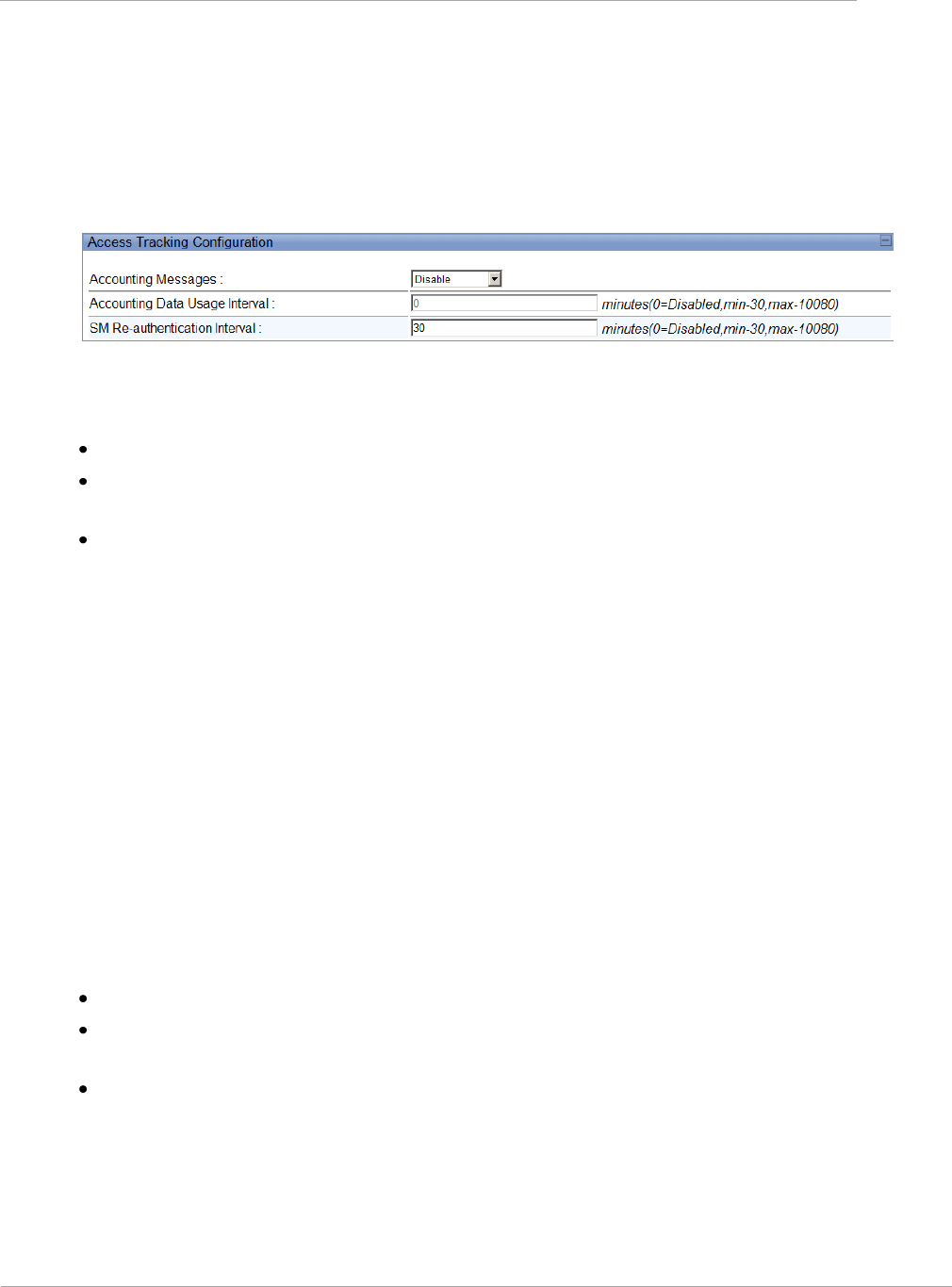
Task 12: Configuring a RADIUS
server
Chapter 2: Configuration and alignment
2-138
pmp-0050 (May 2012)
RADIUS Device Re-Authentication
PMP 450 systems include support for periodic SM re-authentication in a network without requiring the SM to
re-register (and drop the session). The re-authentication may be configured to occur in the range of every 30
minutes to weekly.
Table 61 Device re-authentication configuration
The re-authentication interval is only configurable on the AP. When this feature is enabled, each SM that
enters the network will re-authenticate each the interval time has expired without dropping the session. The
response that the SM receives from the AAA server upon re-authentication is one of the following:
Success: The SM will continue normal operation
Reject: The SM will de-register and will attempt network entry again after 1 minute and then if rejected
will attempt re-entry every 15 minutes
Timeout or other error: The SM will remain in session and attempt 5 times to re-authenticate with the
RADIUS-REQUEST message. If these attempts fail, then the SM will go out of session and proceed to re-
authenticate after 5 minutes, then every 15 minutes.
Although re-authentication is an independent feature, it was designed to work alongside with the RADIUS
data usage accounting messages. If a user is over their data usage limit the network operator can reject the
user from staying in the network. Operators may configure the RADIUS ‗Reply-Message‘ attribute with an
applicable message (i.e. ―Data Usage Limit Reached‖) that will be sent to the subscriber module and displayed
on the general page.
RADIUS Attribute Framed-IP-Address
Operators may now use a RADIUS AAA server to assign management IP addressing to SM modules (framed
IP address). SMs now interpret attributes Framed-IP-Address, Framed-IP-Netmask, and Motorola-Canopy-
Gateway from RADIUS. The RADIUS dictionary file has been updated to include the Motorola-Canopy-
Gateway attribute and is available on the Motorola Software Support website.
In order for these attributes to be assigned and used by the SM, the following must be true:
The Canopy system is configured for AAA authentication
The SM is not configured for DHCP on its management interface. If DHCP is enabled and these attributes
are configured in the RADIUS server, the attributes will be ignored by the SM.
The SM management interface must be configured to be publically accessible. If the SM is configured to
have local accessibility, the management interface will still be assigned the framed addressing, and the SM
will become publicly accessible via the assigned framed IP addressing.

PMP 450 Configuration and User Guide
Task 12: Configuring a RADIUS server
pmp-0050 (May 2012)
2-139
When using these attributes, for the addressing to be implemented by the SM operators must configure
Framed-IP-Address in RADIUS. If Framed-IP-Address is not configured but Framed-IP-Netmask and/or
Motorola-Canopy-Gateway is configured, the attributes will be ignored. In the case where only the
Framed-IP-Address is configured, Framed-IP-Netmask defaults to 255.255.0.0 (NAT disabled) /
255.255.255.0 (NAT enabled) and Motorola-Canopy-Gateway defaults to 0.0.0.0.

PMP 450 Configuration and User Guide
pmp-0050 (May 2012)
3-1
Chapter 3: Reference information

FCC and ICC Information
Chapter 3: Reference information
3-2
pmp-0050 (May 2012)
FCC and ICC Information
Table 62 US FCC IDs and Industry Canada Certification Numbers and Covered Configurations
FCC ID
Industry
Canada
Cert
Number
Frequencies
Module
Families
Antenna
(OFDM)
Maximum
Tx Output
Power
ABZ89FT7634
109W-5780
5 MHz channels,
centered on 5727.5-5845
in 5 MHz increments
(within the 5725-5850
MHz ISM band)
5780APC
17 dBi
Connectorized
19 dBm
10 MHz channels,
centered on 5730-5845 in
5 MHz increments
(within the 5725-5850
MHz ISM band)
20 MHz channels,
centered on 5735-5840 in
5 MHz increments
(within the 5725-5850
MHz ISM band)
ABZ89FT7635
109W-5790
5 MHz channels,
centered on 5727.5-5845
in 5 MHz increments
(within the 5725-5850
MHz ISM band)
5790SM
9 dBi Integrated
19 dBm
10 MHz channels,
centered on 5730-5845 in
5 MHz increments
(within the 5725-5850
MHz ISM band)
20 MHz channels,
centered on 5735-5840 in
5 MHz increments
(within the 5725-5850
MHz ISM band)

PMP 450 Configuration and User Guide
FCC and ICC Information
pmp-0050 (May 2012)
3-3
ABZ89FT7635
109W-5790
5 MHz channels,
centered on 5727.5-5845
in 5 MHz increments
(within the 5725-5850
MHz ISM band)
5790SM
9 dBi Integrated with
18 dBi Reflector Dish
19 dBm
10 MHz channels,
centered on 5730-5845 in
5 MHz increments
(within the 5725-5850
MHz ISM band)
20 MHz channels,
centered on 5735-5840 in
5 MHz increments
(within the 5725-5850
MHz ISM band)
ABZ89FT7635
109W-5790
5 MHz channels,
centered on 5727.5-5845
in 5 MHz increments
(within the 5725-5850
MHz ISM band)
5790SM
9 dBi Integrated with 9
dBi Cassegrain LENS
19 dBm
10 MHz channels,
centered on 5730-5845 in
5 MHz increments
(within the 5725-5850
MHz ISM band)

FCC and ICC Information
Chapter 3: Reference information
3-4
pmp-0050 (May 2012)
20 MHz channels,
centered on 5735-5840 in
5 MHz increments
(within the 5725-5850
MHz ISM band)

PMP 450 Configuration and User Guide
Transmitter Output Power
pmp-0050 (May 2012)
3-5
Transmitter Output Power
Table 63 PMP 450 AP transmitter output power
Radio/
Frequency
Channel
Size
Region(s)
Transmit
Output
Power
Range
TX
Default
Setting
Antenna
Gain
(18 dBi –
1dB cable
loss)
Max
EIRP
(Tx +
Antenna
Gain)
PMP 450 AP
5.8 GHz
OFDM/FSK
5 MHz
United States
and Canada
-30 to +19
dBm
19 dBm
17 dBi
36 dBm
Europe and
India
-30 to +13
dBm
13 dBm
17 dBi
30 dBm
10 MHz
United States
and Canada
-30 to +19
dBm
19 dBm
17 dBi
36 dBm
Europe and
India
-30 to +16
dBm
16 dBm
17 dBi
33 dBm
20 MHz
United States,
Canada, Europe
and India
-30 to +19
dBm
19 dBm
17 dBi
36 dBm

PMP 450 Configuration and User Guide
pmp-0050 (May 2012)
3-1
Exposure Separation Distances
To protect from overexposure to RF energy, install PMP 450 radios so as to provide and maintain the
minimum separation distances from all persons shown in Table 64.
Table 64 Exposure Separation Distances
Module Type
Separation Distance from Persons
PMP 450 AP or SM
At least 20 cm (approx 8 in)
Details of Exposure Separation Distances Calculations and Power
Compliance Margins
Limits and guidelines for RF exposure come from:
US FCC limits for the general population. See the FCC web site at http://www.fcc.gov, and the policies,
guidelines, and requirements in Part 1 of Title 47 of the Code of Federal Regulations, as well as the
guidelines and suggestions for evaluating compliance in FCC OET Bulletin 65.
Health Canada limits for the general population. See Safety Code 6 on the Health Canada web site at
http://www.hc-sc.gc.ca/.
ICNIRP (International Commission on Non-Ionizing Radiation Protection) guidelines for the general
public. See the ICNIRP web site at http://www.icnirp.de/ and Guidelines for Limiting Exposure to Time-
Varying Electric, Magnetic, and Electromagnetic Fields.
The applicable power density exposure limits from the documents referenced above are
10 W/m2 for RF energy in the 5.7-GHz frequency band.
Peak power density in the far field of a radio frequency point source is calculated as follows:
SP G
4d2
where
S = power density in W/m2
P = RMS transmit power capability of the radio, in W
G = total Tx gain as a factor, converted from dB
d = distance from point source, in m
Rearranging terms to solve for distance yields
dP G
4S
Table 65 shows calculated minimum separation distances d, recommended distances and resulting power
compliance margins for each frequency band and antenna combination.

Exposure Separation Distances
Chapter 1:
3-2
pmp-0050 (May 2012)
Table 65 Calculated Exposure Distances and Power Compliance Margins
Freq.
Band
Antenna
Variable
d
(calc
u-
lated)
Recom-
mended
Separati
on
Distance
Power
Compliance
Margin
P
G
S
5.4 / 5.8
GHz
OFDM
Integrated,
9 dBi
patch
0.079 W
(19
dBm)
.08 W
(9 dBi)
10
W/m2
or 1
mW/c
m2
8 cm
20 cm
(8 in)
8
Integrated,
9 dBi
patch with
9 dBi
Cassegrain
LENS
0.079 W
(19
dBm)
.05 W
(18
dBi)
10
W/m2
or 1
mW/c
m2
18 cm
50 cm (20
in)
8
Integrated,
9 dBi
patch with
18 dBi
Reflector
Dish
0.079 W
(19
dBm)
.5 W
(27
dBi)
10
W/m2
or 1
mW/c
m2
56 cm
150 cm
(60 in)
7
The ―Recommended Distances‖ are chosen to give significant compliance margin in all cases. They are also
chosen so that an OFDM module has the same exposure distance as a Canopy module, to simplify
communicating and heeding exposure distances in the field.
These are conservative distances:
They are along the beam direction (the direction of greatest energy). Exposure to the sides and back of the
module will be significantly less.
They meet sustained exposure limits for the general population (not just short term occupational exposure
limits), with considerable margin.
The calculated compliance distance d is overestimated because the far-field equation models the antenna as
a point source and neglects the physical dimension of the antenna.

PMP 450 Configuration and User Guide User Guide
pmp-0050 (May 2012)
A-1
Appendix A: Glossary
Term
Definition
~.
The command that terminates an SSH Secure Shell session to another server. Used on the
Bandwidth and Authentication Manager (BAM) master server in the database replication
setup.
10Base-T
Technology in Ethernet communications that can deliver 10 Mb of data across 328 feet
(100 meters) of CAT 5 cable.
100Base-TX
Technology in Ethernet communications that can deliver 100 Mb of data across 328 feet
(100 meters) of CAT 5 cable.
169.254.0.0
Gateway IP address default in Motorola fixed wireless broadband IP network modules.
169.254.1.1
IP address default in Motorola fixed wireless broadband IP network modules.
169.254.x.x
IP address default in Microsoft and Apple operating systems without a DHCP (Dynamic
Host Configuration Protocol) server.
255.255.0.0
Subnet mask default in Motorola fixed wireless broadband IP network modules and in
Microsoft and Apple operating systems.
802.3
An IEEE standard that defines the contents of frames that are transferred through
Ethernet connections. Each of these frames contains a preamble, the address to which
the frame is sent, the address that sends the frame, the length of the data to expect, the
data, and a checksum to validate that no contents were lost.
802.11
The IEEE standard for wireless local area networks.
802.15
The IEEE standard for wireless personal area networks.
Access Point
Cluster
Two to six Access Point Modules that together distribute network or Internet services to
a community of 1,200 or fewer subscribers. Each Access Point Module covers a 60° sector.
This cluster covers as much as 360°. Also known as AP cluster.
Access Point
Module
Also known as AP. One module that distributes network or Internet services in a 60°
sector to 200 subscribers or fewer.
ACT/4
Second-from-left LED in the module. In the operating mode, this LED is lit when data
activity is present on the Ethernet link. In the aiming mode for a Subscriber Module or a
Backhaul timing slave, this LED is part of a bar graph that indicates the quality of the
RF link.
Activate
To provide feature capability to a module, but not to enable (turn on) the feature in the
module. See also Enable.

Exposure Separation Distances
Chapter 1:
A-2
pmp-0050 (May 2012)
Address
Resolution
Protocol
Protocol defined in RFC 826 to allow a network element to correlate a host IP address to
the Ethernet address of the host. See http://www.faqs.org/rfcs/rfc826.html.
Advanced
Encryption
Standard (AES)
Over-the-air link option that provides extremely secure wireless connections. Advanced
Encryption Standard (AES) uses 128-bit secret keys as directed by the government of the
U.S.A. AES is not exportable and requires a special AP to process the large keys.
AES
See Advanced Encryption Standard.
Aggregate
Throughput
The sum of the throughputs in the uplink and the downlink.
AP
Access Point Module. One module that distributes network or Internet services in a 60°
sector to 200 subscribers or fewer.
APA
Access Point module address.
Apache
A trademark of Apache Software Foundation, used with permission.
APAS
Access Point Authentication Server. Licensed to authenticate SMs that attempt to
register to it. The AP licensed as APAS may or may not have authentication enabled
(turned on). See also Activate and Enable.
API
Application programming interface for web services that supports Prizm integration with
an operations support systems (OSS) such as a customer relationship management
(CRM), billing, or provisioning system.
APs MIB
Management Information Base file that defines objects that are specific to the Access
Point Module or Backhaul timing master. See also Management Information Base.
ARP
Address Resolution Protocol. A protocol defined in RFC 826 to allow a network element
to correlate a host IP address to the Ethernet address of the host. See
http://www.faqs.org/rfcs/rfc826.html.
ASN.1
Abstract Syntax Notation One language. The format of the text files that compose the
Management Information Base.
Attenuation
Reduction of signal strength caused by the travel from the transmitter to the receiver,
and caused by any object between. In the absence of objects between, a signal that has a
short wavelength experiences a high degree of attenuation nevertheless.
Authentication
Key
Software key that correlates to the random number that the Bandwidth and
Authentication Manager (BAM) server generates and sends in a challenge through the
AP to the SM. The network operator can create and, at some security risk, send this key
over the air to the SM. The SQL database in the BAM server correlates this key to QoS
information about the SM. The format of this key is 32 hexadecimal characters of 0 to 9
and a to f, padded with leading zeroes in Release 4.2.3 and later. This key must be unique
to the individual SM.
Backhaul Module
Also known as BH. A module that provides point-to-point connectivity as either a
standalone link or a link to an Access Point cluster through a selected Access Point
Module. See also Backhaul Timing Master and Backhaul Timing Slave.

PMP 450 Configuration and User Guide
Exposure Separation Distances
pmp-0050 (May 2012)
A-3
Backhaul Timing
Master
Backhaul Module that sends network timing (synchronization) to another Backhaul
Module, which serves as the Backhaul timing slave.
Backhaul Timing
Slave
Backhaul Module that receives network timing (synchronization) from another Backhaul
Module, which serves as the Backhaul timing master.
BER
Bit Error Rate. The ratio of incorrect data received to correct data received.
BH
Backhaul Module. A module that provides point-to-point connectivity as either a
standalone link or a link to an Access Point cluster through a selected Access Point
Module.
Bit Error Rate
Ratio of incorrect data received to correct data received.
Box MIB
Management Information Base file that defines module-level objects. See also
Management Information Base.
Bridge
Network element that uses the physical address (not the logical address) of another to
pass data. The bridge passes the data to either the destination address, if found in the
simple routing table, or to all network segments other than the one that transmitted the
data. Modules are Layer 2 bridges except that, where NAT is enabled for an SM, the SM
is a Layer 3 switch. Compare to Switch and Router, and see also NAT.
Bridge Entry
Timeout Field
Value that the operator sets as the maximum interval for no activity with another
module, whose MAC address is the Bridge Entry. This interval should be longer than the
ARP (Address Resolution Protocol) cache timeout of the router that feeds the network.
Buckets
Theoretical data repositories that can be filled at preset rates or emptied when preset
conditions are experienced, such as when data is transferred.
Burst
Preset amount limit of data that may be continuously transferred.
C/I Ratio
Ratio of intended signal (carrier) to unintended signal (interference) received.
Canopy
A trademark of Motorola, Inc.
Carrier-to-
interference
Ratio
Ratio of intended reception to unintended reception.
CarSenseLost
Field
This field displays how many carrier sense lost errors occurred on the Ethernet controller.
CAT 5 Cable
Cable that delivers Ethernet communications from module to module. Later modules
auto-sense whether this cable is wired in a straight-through or crossover scheme.
chkconfig
A command that the Linux® operating system accepts to enable MySQL® and
Apache™ Server software for various run levels of the mysqld and httpd utilities.
CIR
See Committed Information Rate.
Cluster
Management
Module
Module that provides power, GPS timing, and networking connections for an AP cluster.
Also known as CMM. If this CMM is connected to a Backhaul Module, then this CMM is
the central point of connectivity for the entire site.

Exposure Separation Distances
Chapter 1:
A-4
pmp-0050 (May 2012)
CMM
Cluster Management Module. A module that provides power, GPS timing, and
networking connections for an Access Point cluster. If this CMM is connected to a
Backhaul Module (BH), then this CMM is the central point of connectivity for the entire
site.
CodePoint
See DiffServ.
Color Code Field
Module parameter that identifies the other modules with which communication is
allowed. The range of values is 0 to 255. When set at 0, the Color Code does not restrict
communications with any other module.
Committed
Information Rate
(CIR)
For an SM or specified group of SMs, a level of bandwidth that can be guaranteed to
never fall below a specified minimum. In the Motorola implementation, this is controlled
by the Low Priority Uplink CIR, Low Priority Downlink CIR, High Priority Uplink
CIR, and High Priority Downlink CIR parameters.
Community
String Field
Control string that allows a network management station to access MIB information
about the module.
CPE
Customer premises equipment.
CRCError Field
This field displays how many CRC errors occurred on the Ethernet controller.
CRM
Customer relationship management system.
Data Encryption
Standard
Over-the-air link option that uses secret 56-bit keys and 8 parity bits. Data Encryption
Standard (DES) performs a series of bit permutations, substitutions, and recombination
operations on blocks of data.
Date of Last
Transaction
A field in the data that the cmd show esn command generates from data in the SQL
database in the Bandwidth and Authentication Manager (BAM) server. This field
identifies the date of the most recent authentication attempt by the SM. Expressed in the
database output as DLT.
Dell
A trademark of Dell, Inc.
Demilitarized
Zone
Internet Protocol area outside of a firewall. Defined in RFC 2647. See
http://www.faqs.org/rfcs/rfc2647.html.
DES
Data Encryption Standard. An over-the-air link option that uses secret 56-bit keys and 8
parity bits. DES performs a series of bit permutations, substitutions, and recombination
operations on blocks of data.
Desensed
Received an undesired signal that was strong enough to make the module insensitive to
the desired signal.
DFS
See Dynamic Frequency Selection.
DHCP
Dynamic Host Configuration Protocol, defined in RFC 2131. Protocol that enables a
device to be assigned a new IP address and TCP/IP parameters, including a default
gateway, whenever the device reboots. Thus DHCP reduces configuration time, conserves
IP addresses, and allows modules to be moved to a different network within the system.
See http://www.faqs.org/rfcs/rfc2131.html. See also Static IP Address Assignment.

PMP 450 Configuration and User Guide
Exposure Separation Distances
pmp-0050 (May 2012)
A-5
Diffraction
Partial obstruction of a signal. Typically diffraction attenuates a signal so much that the
link is unacceptable. However, in some instances where the obstruction is very close to
the receiver, the link may be acceptable.
DiffServ
Differentiated Services, consistent with RFC 2474. A byte in the type of service (TOS)
field of packets whose values correlates to the channel on which the packet should be
sent. The value is a numeric code point. Motorola modules map each of 64 code points to
values of 0 through 7. Three of these code points have fixed values, and the remaining 61
are settable. Values of 0 through 3 map to the low-priority channel; 4 through 7 to the
high-priority channel. The mappings are the same as 802.1p VLAN priorities. (However,
configuring DiffServ does not automatically enable the VLAN feature.) Among the
settable parameters, the values are set in the AP for all downlinks within the sector and
in the SM for each uplink.
Disable
To turn off a feature in the module after both the feature activation file has activated the
module to use the feature and the operator has enabled the feature in the module. See
also Activate and Enable.
DLT
Date of last transaction. A field in the data that the cmd show esn command generates
from data in the SQL database in the Bandwidth and Authentication Manager (BAM)
server. This field identifies the date of the most recent authentication attempt by the SM.
DMZ
Demilitarized Zone as defined in RFC 2647. An Internet Protocol area outside of a
firewall. See http://www.faqs.org/rfcs/rfc2647.html.
Dynamic
Frequency
Selection (DFS)
A requirement in certain countries and regions for systems to detect interference from
other systems, notably radar systems, and to avoid co-channel operation with these
systems. See also Region Code.
Dynamic Host
Configuration
Protocol
See DHCP.
Electronic Serial
Number
Hardware address that the factory assigns to the module for identification in the Data
Link layer interface of the Open Systems Interconnection system. This address serves as
an electronic serial number. Same as MAC Address.
Element Pack
A license for Prizm management of a multi-point sector and covers the AP and up to 200
SMs or a backhaul link.
Enable
To turn on a feature in the module after the feature activation file has activated the
module to use the feature. See also Activate.
Engine
Bandwidth and Authentication Manager (BAM) interface to the AP and SMs. Unique
sets of commands are available on this interface to manage parameters and user access.
Distinguished from SSE. See also SSE.
ESN
Electronic Serial Number. The hardware address that the factory assigns to the module
for identification in the Data Link layer interface of the Open Systems Interconnection
system. This address serves as an electronic serial number. Same as MAC Address.

Exposure Separation Distances
Chapter 1:
A-6
pmp-0050 (May 2012)
ESN Data Table
Table in which each row identifies data about a single SM. In tab-separated fields, each
row stores the ESN, authentication key, and QoS information that apply to the SM. The
operator can create and modify this table. This table is both an input to and an output
from the Bandwidth and Authentication Manager (BAM) SQL database, and should be
identically input to redundant BAM servers.
/etc/services
File that stores telnet ports on the Bandwidth and Authentication Manager (BAM)
server.
EthBusErr Field
This field displays how many Ethernet bus errors occurred on the Ethernet controller.
Ethernet
Protocol
Any of several IEEE standards that define the contents of frames that are transferred
from one network element to another through Ethernet connections.
Fade Margin
The difference between strength of the received signal and the strength that the receiver
requires for maintaining a reliable link. A higher fade margin is characteristic of a more
reliable link. Standard operating margin.
FCC
Federal Communications Commission of the U.S.A.
Feature
Activation Key
Software key file whose file name includes the ESN of the target module. When installed
on the module, this file activates the module to have the feature enabled or disabled in a
separate operator action.
Field-
programmable
Gate Array
Array of logic, relational data, and wiring data that is factory programmed and can be
reprogrammed.
File Transfer
Protocol
Utility that transfers of files through TCP (Transport Control Protocol) between
computing devices that do not operate on the same platform. Defined in RFC 959. See
http://www.faqs.org/rfcs/rfc959.html.
FPGA
Field-programmable Gate Array. An array of logic, relational data, and wiring data that
is factory programmed and can be reprogrammed.
Frame Spreading
Transmission of a beacon in only frames where the receiver expects a beacon (rather than
in every frame). This avoids interference from transmissions that are not intended for the
receiver.
Frame Timing
Pulse Gated Field
Toggle parameter that prevents or allows the module to continue to propagate GPS sync
timing when the module no longer receives the timing.
Free Space Path
Loss
Signal attenuation that is naturally caused by atmospheric conditions and by the
distance between the antenna and the receiver.
Fresnel Zone
Space in which no object should exist that can attenuate, diffract, or reflect a
transmitted signal before the signal reaches the target receiver.
FSK
Frequency Shift Keying, a variation of frequency modulation to transmit data, in which
two or more frequencies are used.

PMP 450 Configuration and User Guide
Exposure Separation Distances
pmp-0050 (May 2012)
A-7
FTP
File Transfer Protocol, defined in RFC 959. Utility that transfers of files through TCP
(Transport Control Protocol) between computing devices that do not operate on the same
platform. See http://www.faqs.org/rfcs/rfc959.html.
Global
Positioning
System
Network of satellites that provides absolute time to networks on earth, which use the
time signal to synchronize transmission and reception cycles (to avoid interference) and
to provide reference for troubleshooting activities.
GPS
Global Positioning System. A network of satellites that provides absolute time to
networks on earth, which use the time signal to synchronize transmission and reception
cycles (to avoid interference) and to provide reference for troubleshooting activities.
GPS/3
Third-from-left LED in the module. In the operating mode for an Access Point Module or
Backhaul timing master, this LED is continuously lit as the module receives sync pulse.
In the operating mode for a Subscriber Module or a Backhaul timing slave, this LED
flashes on and off to indicate that the module is not registered. In the aiming mode for a
Subscriber Module or a Backhaul timing slave, this LED is part of a bar graph that
indicates the quality of the RF link.
GUI
Graphical user interface.
High-priority
Channel
Channel that supports low-latency traffic (such as Voice over IP) over low-latency traffic
(such as standard web traffic and file downloads). To recognize the latency tolerance of
traffic, this channel reads the IPv4 Type of Service DiffServ Control Point (DSCP) bits.
Enabling the high-priority channel reduces the maximum number of SMs that can be
served in the sector.
HTTP
Hypertext Transfer Protocol, used to make the Internet resources available on the World
Wide Web. Defined in RFC 2068. See http://www.faqs.org/rfcs/rfc2068.html.
ICMP
Internet Control Message Protocols defined in RFC 792, used to identify Internet
Protocol (IP)-level problems and to allow IP links to be tested. See
http://www.faqs.org/rfcs/rfc792.html.
indiscards count
Field
How many inbound packets were discarded without errors that would have prevented
their delivery to a higher-layer protocol. (Some of these packets may have been discarded
to increase buffer space.)
inerrors count
Field
How many inbound packets contained errors that prevented their delivery to a higher-
layer protocol.
innucastpkts
count Field
How many inbound non-unicast (subnetwork-broadcast or subnetwork-multicast)
packets were delivered to a higher-layer protocol.
inoctets count
Field
How many octets were received on the interface, including those that deliver framing
information.
Intel
A registered trademark of Intel Corporation.
inucastpkts count
Field
How many inbound subnetwork-unicast packets were delivered to a higher-layer
protocol.

Exposure Separation Distances
Chapter 1:
A-8
pmp-0050 (May 2012)
inunknownprotos
count Field
How many inbound packets were discarded because of an unknown or unsupported
protocol.
IP
Internet Protocol defined in RFC 791. The Network Layer in the TCP/IP protocol stack.
This protocol is applied to addressing, routing, and delivering, and re-assembling data
packets into the Data Link layer of the protocol stack. See
http://www.faqs.org/rfcs/rfc791.html.
IP Address
32-bit binary number that identifies a network element by both network and host. See
also Subnet Mask.
IPv4
Traditional version of Internet Protocol, which defines 32-bit fields for data transmission.
ISM
Industrial, Scientific, and Medical Equipment radio frequency band, in the 900-MHz,
2.4-GHz, and 5.8-GHz ranges.
Jitter
Timing-based measure of the reception quality of a link. An acceptable link displays a
jitter value between 0 and 4 for a 10-Mbps Backhaul timing slave in Release 4.0 and
later, between 0 and 9 for a 20-Mbps Backhaul timing slave, or between 5 and 9 for any
Subscriber Module or for a Backhaul timing slave in any earlier release. OFDM modules
do not have this parameter.
L2TP over IPSec
Level 2 Tunneling Protocol over IP Security. One of several virtual private network
(VPN) implementation schemes. Regardless of whether Subscriber Modules have the
Network Address Translation feature (NAT) enabled, they support VPNs that are based
on this protocol.
Late Collision
Field
This field displays how many late collisions occurred on the Ethernet controller. A
normal collision occurs during the first 512 bits of the frame transmission. A collision that
occurs after the first 512 bits is considered a late collision. A late collision is a serious
network problem because the frame being transmitted is discarded. A late collision is
most commonly caused by a mismatch between duplex configurations at the ends of a
link segment.
Latency
Tolerance
Acceptable tolerance for delay in the transfer of data to and from a module.
Line of Sight
Wireless path (not simply visual path) direct from module to module. The path that
results provides both ideal aim and an ideal Fresnel zone.
Linux
A registered trademark of Linus Torvalds.
LNK/5
Furthest left LED in the module. In the operating mode, this LED is continuously lit
when the Ethernet link is present. In the aiming mode for a Subscriber Module or a
Backhaul timing slave, this LED is part of a bar graph that indicates the quality of the
RF link.
Logical Unit ID
Final octet of the 4-octet IP address of the module.
LOS
Line of sight. The wireless path (not simply visual path) direct from module to module.
The path that results provides both ideal aim and an ideal Fresnel zone.
LUID
Logical Unit ID. The final octet of the 4-octet IP address of the module.

PMP 450 Configuration and User Guide
Exposure Separation Distances
pmp-0050 (May 2012)
A-9
MAC Address
Media Access Control address. The hardware address that the factory assigns to the
module for identification in the Data Link layer interface of the Open Systems
Interconnection system. This address serves as an electronic serial number.
Management
Information Base
Space that allows a program (agent) in the network to relay information to a network
monitor about the status of defined variables (objects).
Master
Designation that defines the role of a component relative to the role of another. This
designation both applies to a Backhaul module that provides synchronization over the
air to another Backhaul module
(a Backhaul timing slave) and applies to a Bandwidth and Authentication Manager
(BAM) server whose SQL database is automatically copied onto a redundant BAM server
(BAM slave). In each case, the master is not a product. Rather, the master is the role that
results from deliberate configuration steps.
Maximum
Information Rate
(MIR)
The cap applied to the bandwidth of an SM or specified group of SMs. In the Motorola
implementation, this is controlled by the Sustained Uplink Data Rate, Uplink Burst
Allocation, Sustained Downlink Data Rate, and Downlink Burst Allocation parameters.
Media Access
Control Address
Hardware address that the factory assigns to the module for identification in the Data
Link layer interface of the Open Systems Interconnection system. This address serves as
an electronic serial number.
MIB
Management Information Base. Space that allows a program (agent) in the network to
relay information to a network monitor about the status of defined variables (objects).
MIR
See Maximum Information Rate.
MySQL
A registered trademark of MySQL AB Company in the United States, the European
Union, and other countries.
mysqladmin
A command to set the administrator and associated password on the Bandwidth and
Authentication Manager (BAM) server.
mysql-server
Package group that enables the SQL Database Server application in the Red Hat®
Linux® 9 operating system to provide SQL data for Bandwidth and Authentication
Manager (BAM) operations.
NAT
Network Address Translation defined in RFC 1631. A scheme that isolates Subscriber
Modules from the Internet. See http://www.faqs.org/rfcs/rfc1631.html.
NBI
See Northbound Interface.
NEC
National Electrical Code. The set of national wiring standards that are enforced in the
U.S.A.
NetBIOS
Protocol defined in RFC 1001 and RFC 1002 to support an applications programming
interface in TCP/IP. This interface allows a computer to transmit and receive data with
another host computer on the network. RFC 1001 defines the concepts and methods.
RFC 1002 defines the detailed specifications. See http://www.faqs.org/rfcs/rfc1001.html
and http://www.faqs.org/rfcs/rfc1002.html.

Exposure Separation Distances
Chapter 1:
A-10
pmp-0050 (May 2012)
Network Address
Translation
Scheme that defines the Access Point Module as a proxy server to isolate registered
Subscriber Modules from the Internet. Defined in RFC 1631. See
http://www.faqs.org/rfcs/rfc1631.html.
Network
Management
Station
See NMS.
NMS
Network Management Station. A monitor device that uses Simple Network Management
Protocol (SNMP) to control, gather, and report information about predefined network
variables (objects). See also Simple Network Management Protocol.
Northbound
Interface (NBI)
The interface within Prizm to higher-level systems. This interface consists of a Simple
Network Management Protocol (SNMP) agent for integration with a network
management system (NMS); a Simple Object Access Protocol (SOAP) XML-based
application programming interface (API) for web services that supports integration with
an operations support systems (OSS) such as a customer relationship management
(CRM), billing, or provisioning system; and console automation that allows such higher-
level systems to launch and appropriately display the PrizmEMS management console in
a custom-developed GUI.
Object
Network variable that is defined in the Management Information Base.
OptiPlex
A trademark of Dell, Inc.
OSS
Operations support system, such as a customer relationship management (CRM), billing,
or provisioning system. The application programming interface (API) for Prizm supports
integrating Prizm with an OSS.
outdiscards count
Field
How many outbound packets were discarded without errors that would have prevented
their transmission. (Some of these packets may have been discarded to increase buffer
space.)
outerrrors count
Field
How many outbound packets contained errors that prevented their transmission.
outnucastpkts
count Field
How many packets for which the higher-level protocols requested transmission to a non-
unicast (subnetwork-broadcast or subnetwork-multicast) address. The number includes
those that were discarded or not sent.
outoctets count
Field
How many octets were transmitted out of the interface, including those that deliver
framing information.
outucastpkts
count Field
How many packets for which the higher-level protocols requested transmission to a
subnetwork-unicast address. The number includes those that were discarded or not sent.
Override Plug
Device that enables the operator to regain control of a module that has been locked by
the No Remote Access feature, the 802.3 Link Disable feature, or a password or IP
address that cannot be recalled. This device can be either fabricated on site or ordered.
Pentium
A registered trademark of Intel Corporation.

PMP 450 Configuration and User Guide
Exposure Separation Distances
pmp-0050 (May 2012)
A-11
php-mysql
Package group that enables the Web Server application in the
Red Hat® Linux® 9 operating system to provide data from the SQL Database Server
application as PHP in the Bandwidth and Authentication Manager (BAM) GUI.
PMP
See Point-to-Multipoint Protocol.
Point-to-
Multipoint
Protocol
Defined in RFC 2178, which specifies that data that originates from a central network
element can be received by all other network elements, but data that originates from a
non-central network element can be received by only the central network element. See
http://www.faqs.org/rfcs/rfc2178.html. Also referenced as PMP.
Point-to-Point
Protocol
Standards that RFC 1661 defines for data transmittal on the Internet. Also known as
PPP or PTP. See http://www.faqs.org/rfcs/rfc1661.html.
Power Control
Feature in Release 4.1 and later that allows the module to operate at less than 18 dB less
than full power to reduce self-interference.
PPPoE
Point to Point Protocol over Ethernet. Supported on SMs for
operators who use PPPoE in other parts of their network
operators who want to deploy PPPoE to realize per-subscriber authentication, metrics,
and usage control.
PPTP
Point to Point Tunneling Protocol. One of several virtual private network
implementations. Regardless of whether the Network Address Translation (NAT) feature
enabled, Subscriber Modules support VPNs that are based on this protocol.
Prizm
The software product that allows users to partition their entire networks into criteria-
based subsets and independently monitor and manage those subsets. Prizm Release 1.0
and later includes a Northbound Interface to higher-level systems. Prizm integrates
Bandwidth and Authentication Manager (BAM) functionality.
Protective Earth
Connection to earth (which has a charge of 0 volts). Also known as ground.
Proxy Server
Network computer that isolates another from the Internet. The proxy server
communicates for the other computer, and sends replies to only the appropriate
computer, which has an IP address that is not unique or not registered.
PTMP
See Point-to-Multipoint Protocol.
PTP
See Point-to-Point Protocol.
QoS
Quality of Service. A frame field that Bandwidth and Authentication Manager (BAM)
provides to the AP and SM about the sustained data rates and burst data limits of the
SM. The format of this field is 64 hexadecimal characters of 0 to 9 and a to f. The BAM
SQL database expresses this field as five contiguous subfields.
Quality of
Service
A frame bit that Bandwidth and Authentication Manager (BAM) provides to the AP and
SM the sustained data rates and burst data limits of the SM. The format of this field is 64
hexadecimal characters of 0 to 9 and a to f. The BAM SQL database expresses this field
as five contiguous subfields. Also known as QoS.
Quick Start
Interface page that requires minimal configuration for initial module operation.

Exposure Separation Distances
Chapter 1:
A-12
pmp-0050 (May 2012)
Radio Signal
Strength
Indicator
Relative measure of the strength of a received signal. An acceptable link displays an
Radio Signal Strength Indicator (RSSI) value of greater than 700.
Random Number
Number that the Bandwidth and Authentication Manager (BAM) generates, invisible to
both the SM and the network operator, to send to the SM as a challenge against an
authentication attempt.
Reader
A registered trademark of Adobe Systems, Incorporated.
Recharging
Resumed accumulation of data in available data space (buckets). See Buckets.
Red Hat
A registered trademark of Red Hat, Inc.
Reflection
Change of direction and reduction of amplitude of a signal that encounters an object
larger than the wavelength. Reflection may cause an additional copy of the wavelength
to arrive after the original, unobstructed wavelength arrives. This causes partial
cancellation of the signal and may render the link unacceptable. However, in some
instances where the direct signal cannot be received, the reflected copy may be received
and render an otherwise unacceptable link acceptable.
Region Code
A parameter that offers multiple fixed selections, each of which automatically
implements either the Dynamic Frequency Selection (DFS) standard that is required by
law or regulatory to apply or no DFS, based on the frequency band range and the
selected region.
Registrations
MIB
Management Information Base file that defines registrations for global items such as
product identities and product components. See also Management Information Base.
repl-m
A command that sets up the database replication process on a Bandwidth and
Authentication Manager (BAM) master server, uses SFTP to copy both the database and
the repl-s script to a BAM slave server, and remotely executes the repl-s script on the
BAM slave server. See Master, Slave, repl-s, Secure Shell, and SFTP.
repl-s
A command that sets up the database replication process on a Bandwidth and
Authentication Manager (BAM) slave server. See Master, Slave, and repl-m.
RES
Result. A field in the data that the cmd show esn command generates from the SQL
database in the Bandwidth and Authentication Manager (BAM) server.
RetransLimitExp
Field
This field displays how many times the retransmit limit has expired.
RF
Radio frequency. How many times each second a cycle in the antenna occurs, from
positive to negative and back to positive amplitude.
RJ-11
Standard cable that is typically used for telephone line or modem connection.
RJ-45
Standard cable that is typically used for Ethernet connection. This cable may be wired as
straight-through or as crossover. Later modules auto-sense whether the cable is straight-
through or crossover.

PMP 450 Configuration and User Guide
Exposure Separation Distances
pmp-0050 (May 2012)
A-13
Router
Network element that uses the logical (IP) address of another to pass data to only the
intended recipient. Compare to Switch and Bridge.
RPM
Red Hat® Package Manager.
rpm
A command that the Linux® operating system accepts to identify the version of Linux®
software that operates on the Bandwidth and Authentication Manager (BAM) server.
RSSI
Radio Signal Strength Indicator. A relative measure of the strength of a received signal.
An acceptable link displays an RSSI value of greater than 700.
RxBabErr Field
This field displays how many receiver babble errors occurred.
RxOverrun Field
This field displays how many receiver overrun errors occurred on the Ethernet controller.
SDK
PrizmEMS™ Software Development Kit (SDK)—the document that provides server
administrator tasks, GUI developer information for console automation that allows
higher-level systems to launch and appropriately display the Prizm management console.
The SDK also describes the how to define new element types and customize the Details
views.
Secure Shell
A trademark of SSH Communications Security.
Self-interference
Interference with a module from another module in the same network.
SES/2
Third-from-right LED in the module. In the Access Point Module and Backhaul timing
master, this LED is unused. In the operating mode for a Subscriber Module or a
Backhaul timing slave, this LED flashes on and off to indicate that the module is not
registered. In the aiming mode for a Subscriber Module or a Backhaul timing slave, this
LED is part of a bar graph that indicates the quality of the RF link.
Session Key
Software key that the SM and Bandwidth and Authentication Manager (BAM)
separately calculate based on that both the authentication key (or the factory-set default
key) and the random number. BAM sends the session key to the AP. Neither the
subscriber nor the network operator can view this key. See also Random Number.
SFTP
Secure File Transfer Protocol.
Simple Network
Management
Protocol
Standard that is used for communications between a program (agent) in the network and
a network management station (monitor). Defined in RFC 1157. See
http://www.faqs.org/rfcs/rfc1157.html.
skey
Software key that correlates to the random number that the Bandwidth and
Authentication Manager (BAM) server generates and sends in a challenge through the
AP to the SM. The network operator can create and, at some security risk, send this key
over the air to the SM. The SQL database in the BAM server correlates this key to QoS
information about the SM. The format of this key is 32 hexadecimal characters of 0 to 9
and a to f. This key must be unique to the individual SM. Also known as authentication
key.

Exposure Separation Distances
Chapter 1:
A-14
pmp-0050 (May 2012)
Slave
Designation that defines the role of a component relative to the role of another. This
designation both applies to a Backhaul slave that receives synchronization over the air
from another Backhaul module
(a Backhaul timing master) and applies to a redundant Bandwidth and Authentication
Manager (BAM) server whose SQL database is automatically overwritten by a copy from
the primary BAM server (BAM master). In each case, the slave is not a product. Rather,
the slave is the role that results from deliberate configuration steps.
SM
Customer premises equipment (CPE) device that extends network or Internet services by
communication with an Access Point Module or an Access Point cluster.
SM MIB
Management Information Base file that defines objects that are specific to the Subscriber
Module or Backhaul timing slave. See also Management Information Base.
SNMP
See Simple Network Management Protocol, defined in RFC 1157.
SNMP Trap
Capture of information that informs the network monitor through Simple Network
Management Protocol of a monitored occurrence in the module.
SOAP
Simple Object Access Protocol (SOAP). The protocol that the Northbound Interface in
Prizm uses to support integration of Prizm with an operations support systems (OSS)
such as a customer relationship management (CRM), billing, or provisioning system
SSE
Bandwidth and Authentication Manager (BAM) interface to the SQL server. Unique sets
of commands are available on this interface to manage the BAM SQL database and user
access. Distinguished from Engine. See also Engine.
Standard
Operating Margin
See Fade Margin.
Static IP Address
Assignment
Assignment of Internet Protocol address that can be changed only manually. Thus static
IP address assignment requires more configuration time and consumes more of the
available IP addresses than DHCP address assignment does. RFC 2050 provides
guidelines for the static allocation of IP addresses. See
http://www.faqs.org/rfcs/rfc2050.html. See also DHCP.
su -
A command that opens a Linux® operating system session for the user root.
Subnet Mask
32-bit binary number that filters an IP address to reveal what part identifies the network
and what part identifies the host. The number of subnet mask bits that are set to 1
indicates how many leading bits of the IP address identify the network. The number of
subnet mask bits that are set 0 indicate how many trailing bits of the IP address identify
the host.
Subscriber
Module
Customer premises equipment (CPE) device that extends network or Internet services by
communication with an Access Point Module or an Access Point cluster.
Sustained Data
Rate
Preset rate limit of data transfer.
Switch
Network element that uses the port that is associated with the physical address of
another to pass data to only the intended recipient. Compare to Bridge and Router.

PMP 450 Configuration and User Guide
Exposure Separation Distances
pmp-0050 (May 2012)
A-15
SYN/1
Second-from-right LED in the module. In the Access Point Module or Backhaul timing
master, as in a registered Subscriber Module or Backhaul timing slave, this LED is
continuously lit to indicate the presence of sync. In the operating mode for a Subscriber
Module or Backhaul timing slave, this LED flashes on and to indicate that the module is
not registered. In the aiming mode for a Subscriber Module or a Backhaul timing slave,
this LED is part of a bar graph that indicates the quality of the RF link.
Sync
GPS (Global Positioning System) absolute time, which is passed from one module to
another. Sync enables timing that prevents modules from transmitting or receiving
interference. Sync also provides correlative time stamps for troubleshooting efforts.
TCP
Alternatively known as Transmission Control Protocol or Transport Control Protocol.
The Transport Layer in the TCP/IP protocol stack. This protocol is applied to assure that
data packets arrive at the target network element and to control the flow of data through
the Internet. Defined in RFC 793. See http://www.faqs.org/rfcs/rfc793.html.
tcp
Transport Control type of port. The system uses Port 3306:tcp for MySQL® database
communications, Port 9080:tcp for SSE telnet communications, and Port 9090:tcp for
Engine telnet communications.
TDD
Time Division Duplexing. Synchronized data transmission with some time slots allocated
to devices transmitting on the uplink and some to the device transmitting on the
downlink.
telnet
Utility that allows a client computer to update a server. A firewall can prevent the use of
the telnet utility to breach the security of the server. See
http://www.faqs.org/rfcs/rfc818.html, http://www.faqs.org/rfcs/rfc854.html and
http://www.faqs.org/rfcs/rfc855.html.
Textual
Conventions MIB
Management Information Base file that defines system-specific textual conventions. See
also Management Information Base.
Time of Last
Transaction
A field in the data that the cmd show esn command generates from data in the SQL
database in the Bandwidth and Authentication Manager (BAM) server. This field
identifies the time of day of the most recent authentication attempt by the SM.
Expressed in the database output as TLT.
TLT
Time of last transaction. A field in the data that the cmd show esn command generates
from data in the SQL database in the Bandwidth and Authentication Manager (BAM)
server. This field identifies the time of day of the most recent authentication attempt by
the SM.
TNAF
Total number of authentication requests failed. A field in the data that the cmd show esn
command generates from the SQL database in the Bandwidth and Authentication
Manager (BAM) server. This field indicates how many times the SM (identified by ESN
in the related data) attempted to authenticate but was denied by BAM.

Exposure Separation Distances
Chapter 1:
A-16
pmp-0050 (May 2012)
TNAR
Total number of authentication requests. A field in the data that the cmd show esn
command generates from the SQL database in the Bandwidth and Authentication
Manager (BAM) server. This field indicates how many times the SM (identified by ESN
in the related data) attempted to authenticate, regardless of whether the attempt
succeeded.
Tokens
Theoretical amounts of data. See also Buckets.
TOS
8-bit field in that prioritizes data in a IP transmission. See
http://www.faqs.org/rfcs/rfc1349.html.
TxUnderrun
Field
This field displays how many transmission-underrun errors occurred on the Ethernet
controller.
UDP
User Datagram Protocol. A set of Network, Transport, and Session Layer protocols that
RFC 768 defines. These protocols include checksum and address information but does not
retransmit data or process any errors. See http://www.faqs.org/rfcs/rfc768.html.
UDP
User-defined type of port.
U-NII
Unlicensed National Information Infrastructure radio frequency band, in the 5.1-GHz
through 5.8-GHz ranges.
VID
VLAN identifier. See also VLAN.
VLAN
Virtual local area network. An association of devices through software that contains
broadcast traffic, as routers would, but in the switch-level protocol.
VPN
Virtual private network for communication over a public network. One typical use is to
connect remote employees, who are at home or in a different city, to their corporate
network over the Internet. Any of several VPN implementation schemes is possible. SMs
support L2TP over IPSec (Level 2 Tunneling Protocol over IP Security) VPNs and
PPTP (Point to Point Tunneling Protocol) VPNs, regardless of whether the Network
Address Translation (NAT) feature enabled.
